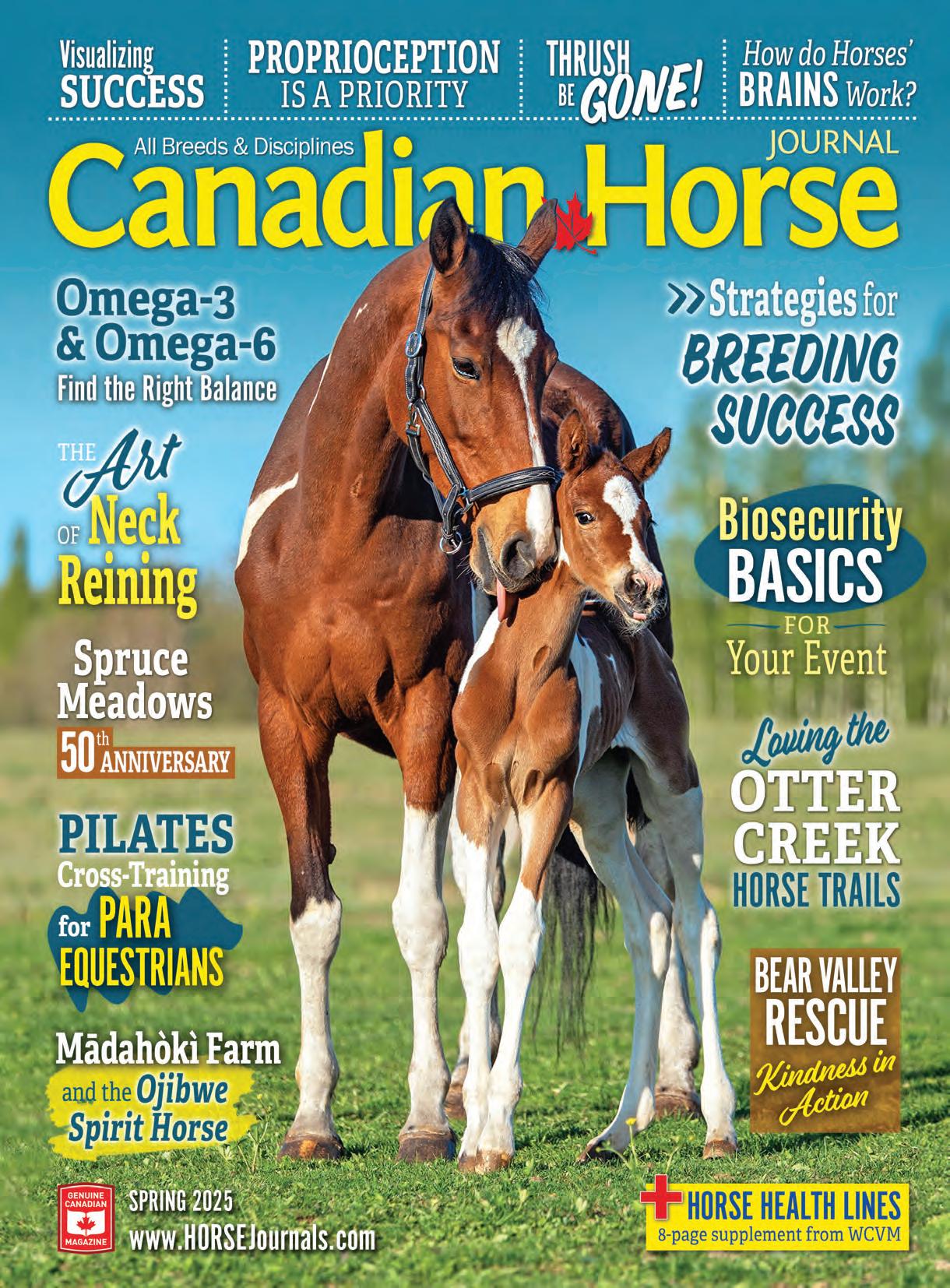
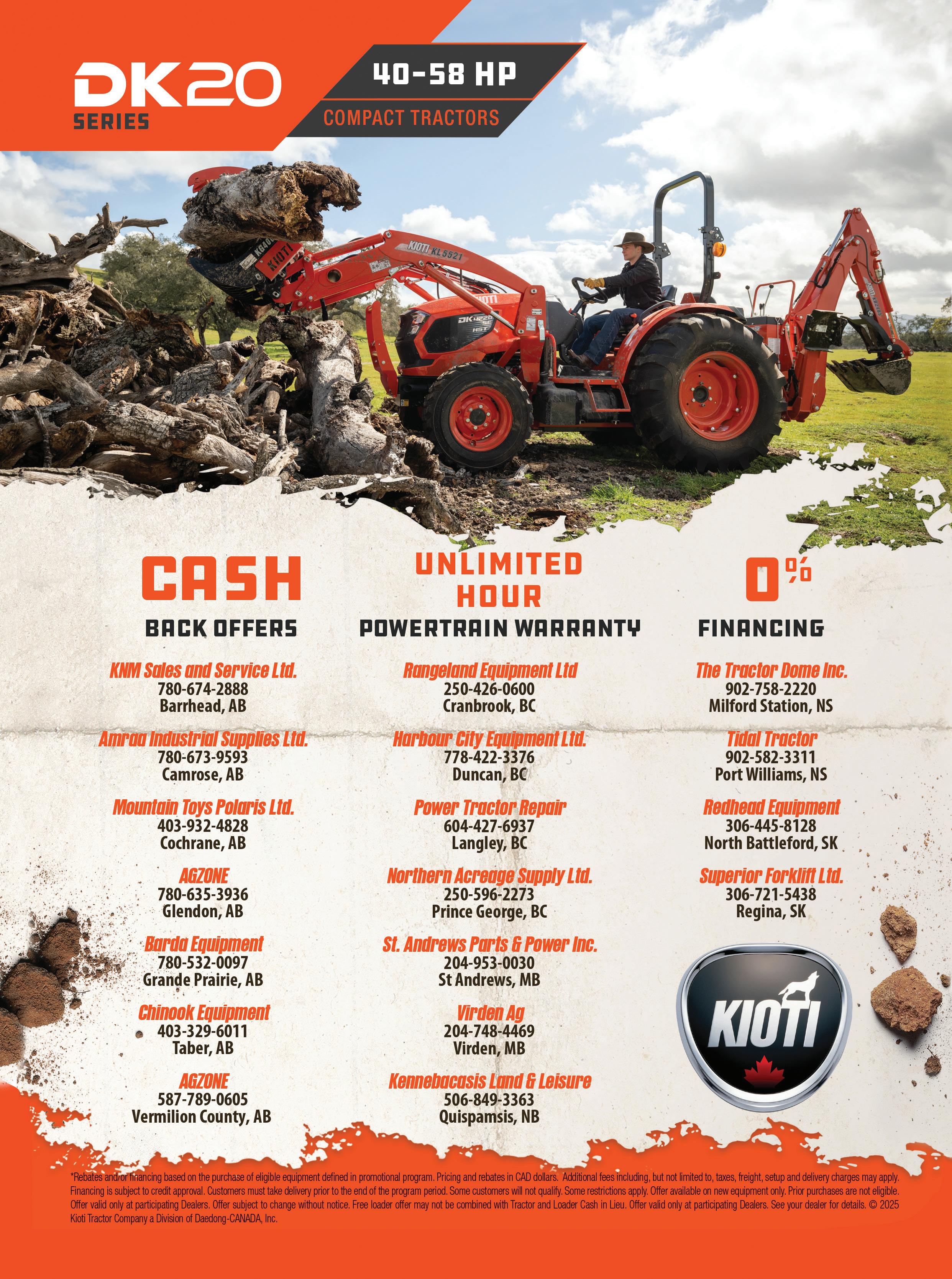
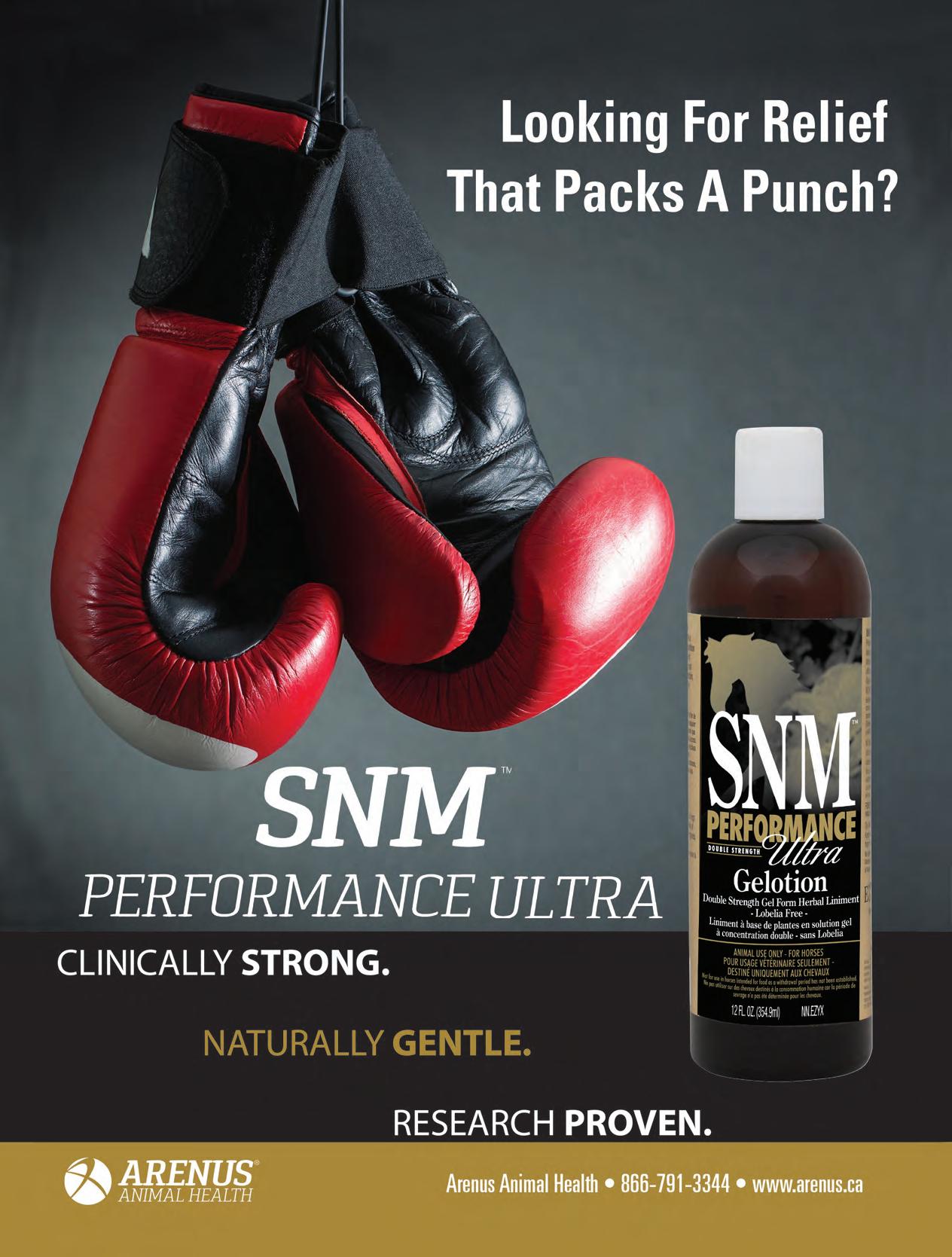




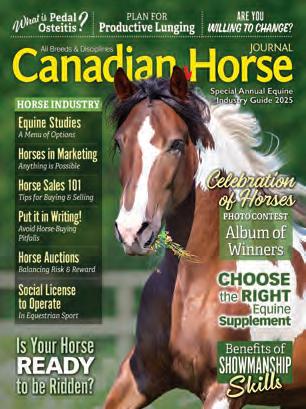
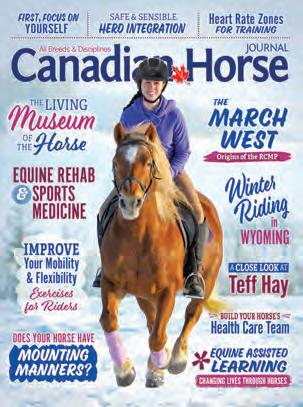

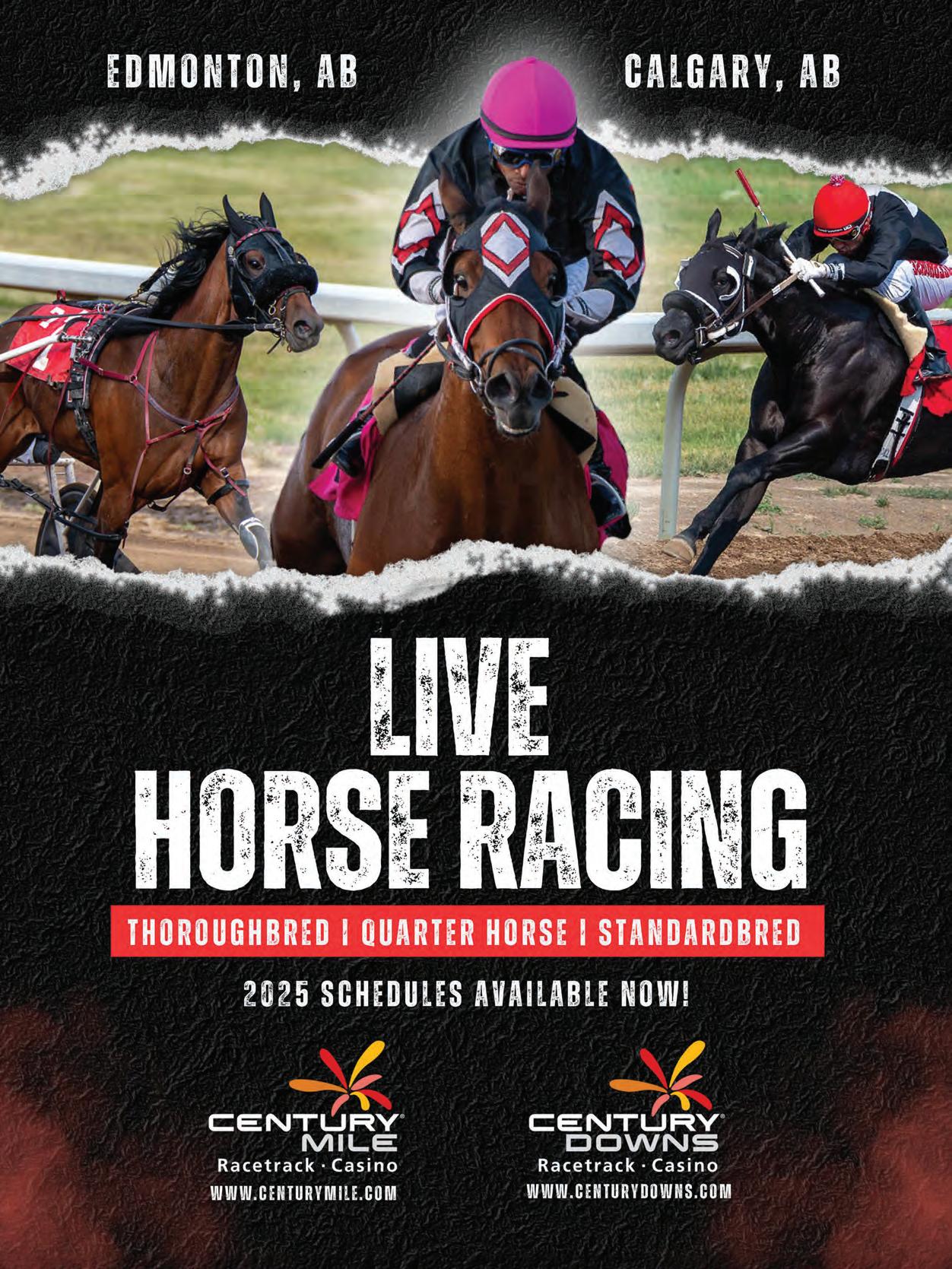












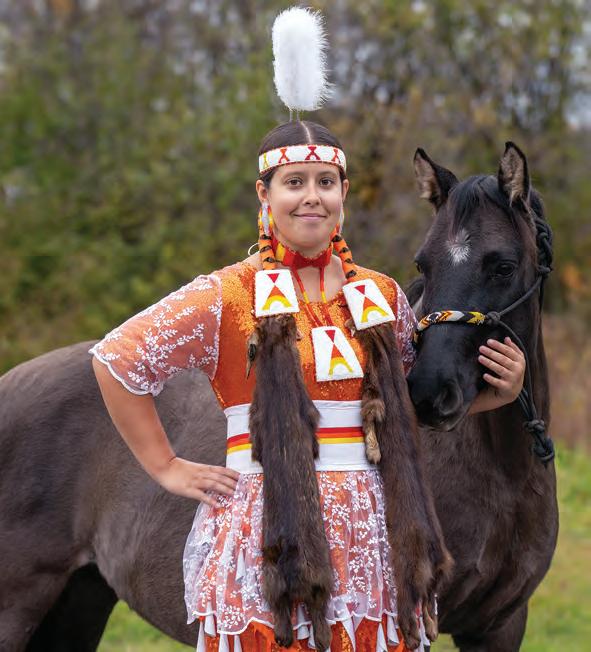
10 Horse Community Heroes: Barbara Jackson
A volunteer extraordinaire celebrating 50 years of service to the CSHA.
60 Spruce Meadows
50th Anniversary
Ron and Marg Southern dared to dream about building a facility that would bring the best show jumpers in the world to their doorstep.
72 Mādahòkì Farm
Home to a growing herd of endangered Ojibwe Spirit Horses, Canada’s only Indigenous horse breed.
82 Loving the Otter Creek Horse Trails Horse camping and trail riding at the western edge of the Adirondack Mountains.
90 Bear Valley Rescue: Kindness in Action
A registered charity helping horses that have nowhere else to go and giving them a chance at a better life.
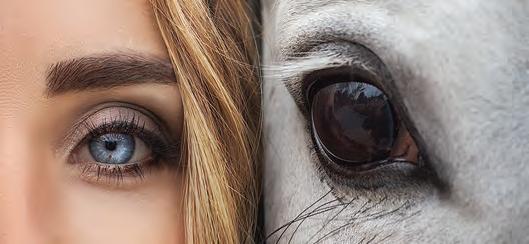
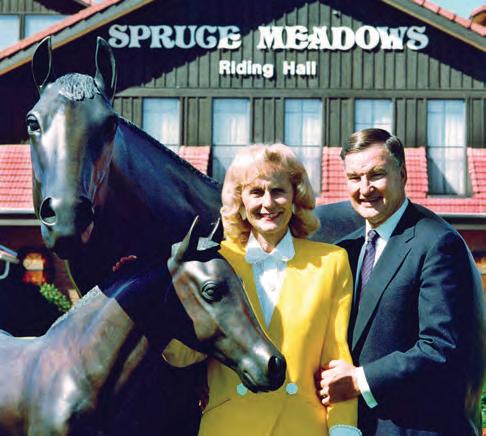
14 Omega-3 and Omega-6
What every horse owner should know about balancing these essential fatty acids in the equine diet.
20 Biosecurity Basics for Your Event
Strategies to protect your event from the threat of cancellation and quarantine.
22 Thrush Be Gone!
How to prevent and treat this opportunistic infection.
24 Bird Flu in Horses?
Horses in Asia have been infected with avian influenza, raising concerns about viral spillover and cross-species transmission.
26 Broodmares Under Lights
Stimulating mares to cycle early using artificial lighting, and why it works.
30 Improving the Odds of Breeding Success
A close look at conception challenges and potential solutions.
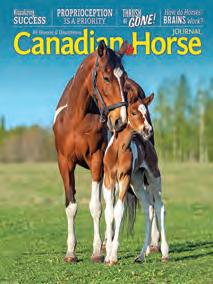
I hope you will grow up gentle and good, and never learn bad ways; do your work with a good will, lift your feet up well when you trot, and never bite or kick even in play.
― ANNA SEWELL, BLACK BEAUTY
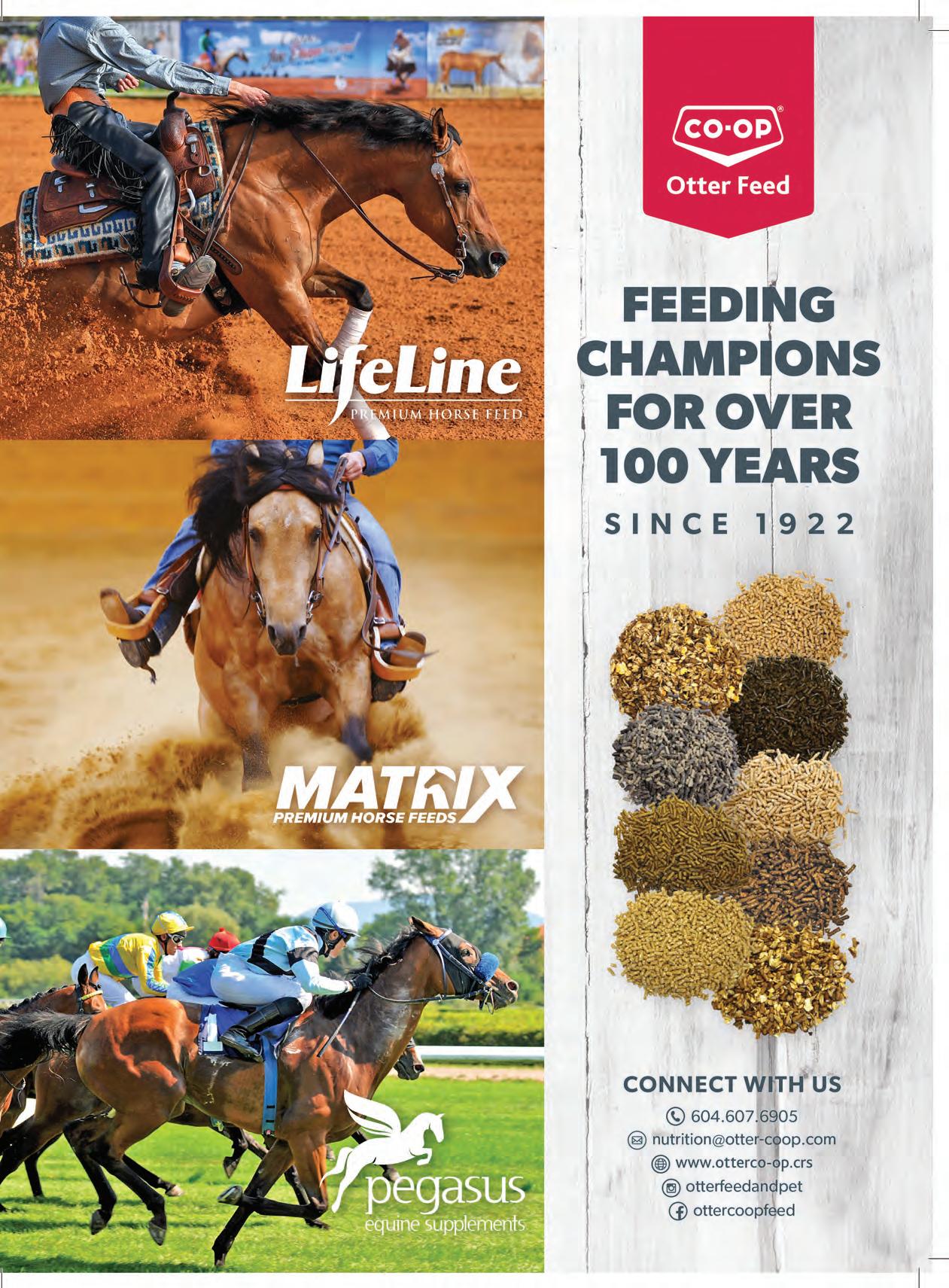

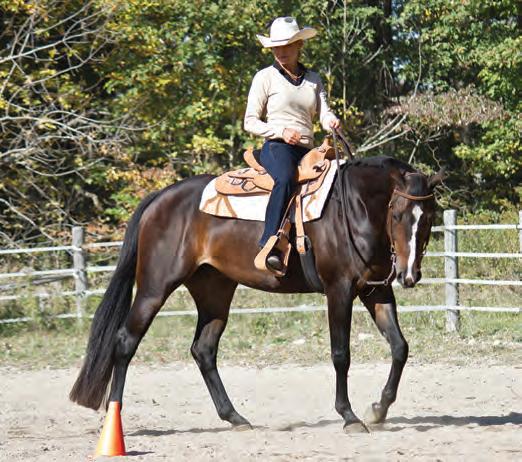
36 Leverage Bits 101 and the Art of Neck Reining

Exploring why and how to make the switch from snaffle to leverage bit, and the language of neck reining.
42 Picture Your Success in Equestrian Sport
Harness the power of mental tools to build strong skills such as confidence, focus, and emotional regulation.
44 Pilates Cross-Training for Para Equestrians
Enhance core strength, posture, flexibility, balance, and muscle tone, while improving coordination and fine motor skills.
54 How Horses’ Brains Work
As our horses’ teachers, understanding how a prey animal lives in a human world can help us to make their job easier.
56 How to Make Proprioception a Priority
Supporting this often-overlooked aspect of function can be a game-changer for our horses.
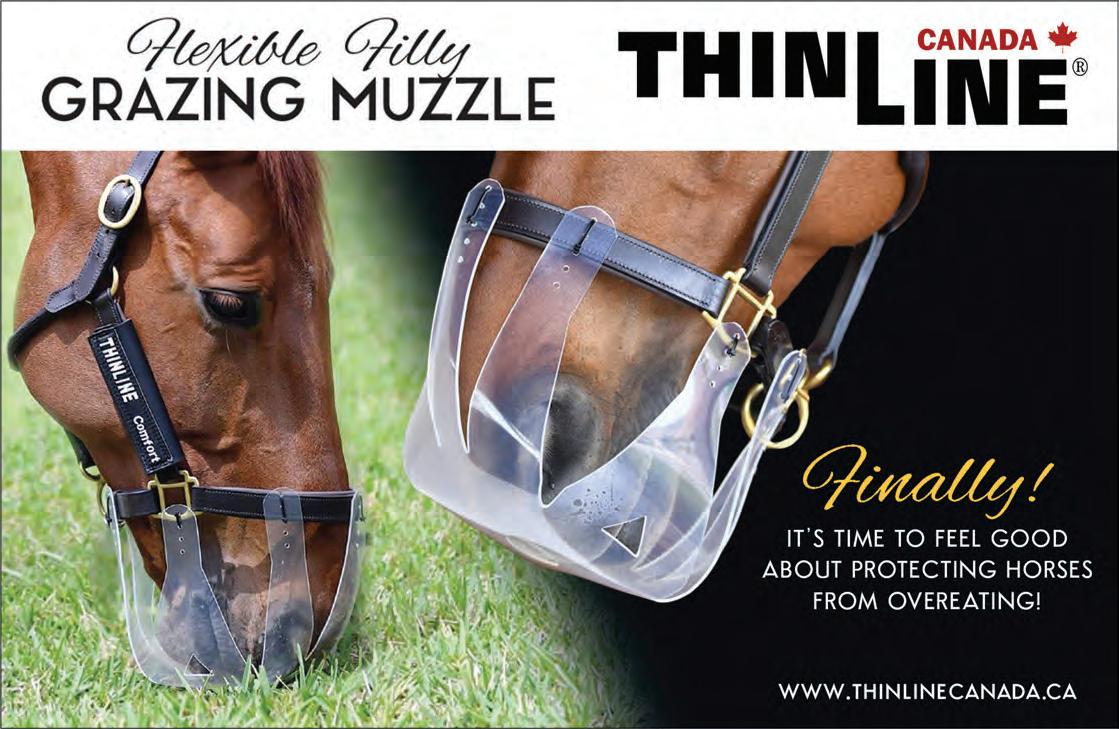
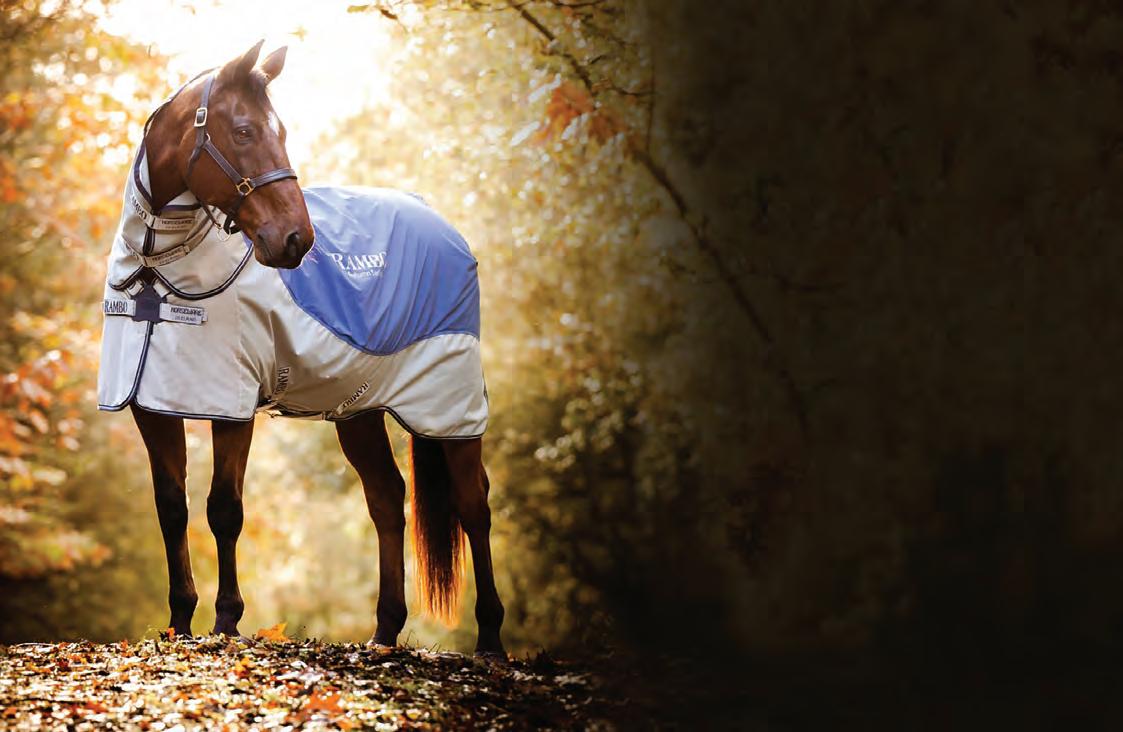




We
can judge the heart
of a man by his treatment of animals.
— IMMANUEL KANT
I remember reading a book years ago after reporting on the story in this magazine. This book, The Rescue of Belle and Sundance — A Miracle on Mount Renshaw by Birgit Stutz and Lawrence Scanlan, recounts the true story of a heroic community effort to save two abandoned packhorses trapped in deep snow on Mount Renshaw, BC. In December 2008, McBride residents braved freezing temperatures and backbreaking labour, digging a kilometer-long trench by hand to free the starving horses. The heartfelt narration captures the emotional and inspiring rescue, serving as a powerful testament to compassion and perseverance.
But the book is more than just a rescue story. It describes the implicit “contract” between humans and horses — an unspoken agreement in which people, having domesticated these animals for work, sport, and companionship, are responsible for their care, well-being, and protection. This ethical duty is central to the book’s message, underscoring the responsibility to provide food, water, shelter, and veterinary care. The story of Belle and Sundance is a poignant reminder of this moral obligation, as their survival depended on the kindness and dedication of those who refused to abandon them.
In the first weeks of this new year, much of Canada experienced extreme winter weather with frigid temperatures, strong winds, and heavy snowfall. Canadians take a certain pride in enduring our harsh winters, and we’re fortunate to have well-stocked pantries and warm homes to shelter in while the snow piles up outside. So, I’ve always found it impossible to understand why some horse owners still turn their domestic horses out to “pasture” over winter without providing adequate forage or fresh water, rationalizing that wild horses survive this way or that feeding them isn’t necessary when they’re not working. These horses are left to paw through deep snow for food and rely on snow for hydration, a practice that is far from sustainable. As temperatures drop, horses expend more energy warming frozen forage and snow to body temperature, depleting fat reserves and making it harder to stay warm. Without fresh water, a horse must
consume 190–380 litres of snow daily to stay hydrated, further lowering body temperature and increasing the risk of colic, hypothermia, and starvation. Underweight, elderly, or ill horses are not likely to survive such conditions.
Most horses thrive outdoors yearround when properly cared for, growing thick winter coats and adapting well to the cold. However, they require consistent access to shelter, high-quality forage to meet energy needs, fresh water at all times, and free access to salt. It’s time to end the cruel and outdated practice of turning domestic horses out to fend for themselves in Canada’s brutal winters. If you think this practice is a thing of the past, think again — 12 percent of respondents to our recent website poll question, Do you turn your horses out over the winter to fend for themselves?, reported that they do not provide water, forage, or both to their horses during the winter months.
The central theme behind the work of Bear Valley Rescue in Alberta is their unwavering belief that all horses deserve compassion, proper care, and a second chance at life. Their mission is rooted in the belief that horses, whether abandoned, abused, neglected, or at risk of slaughter, should be treated with dignity and respect. They advocate for responsible horse ownership, emphasizing that when humans domesticate these animals for work, sport, or companionship, they take on an ethical duty to provide food, shelter, medical care, and a safe environment.
The need for their rescue and welfare efforts is great due to several pressing issues. Economic hardship, overbreeding, and the high cost of horse care often lead to abandonment, neglect, or horses being sold at auction, where many face slaughter. Bear Valley Rescue steps in to save these at-risk horses, rehabilitating them and working to find them loving, permanent homes. Their efforts not only provide direct aid to horses in need but also raise awareness about humane treatment and responsible ownership, striving to create a future where no horse suffers from neglect or cruelty. Read about Bear Valley Rescue starting on page 90.
Kathy Smith
Your Horse b Your Passion b Your Magazine Volume 25 • Issue 3 Spring 2025 Issue of Canadian Horse Journal
Published by Horse Community Journals Inc.
EDITOR / PUBLISHER
Kathy Smith
ACCOUNTS
accounts@horsejournals.com
ADVERTISING
Terry Andrucko • Janna Reimer
SOCIAL MEDIA
Prismatic Creative
SUBSCRIPTIONS
Steve Smith
MARKETING & DISTRIBUTION
Janna Reimer
ART DIRECTION, PRODUCTION
Elisa Crees
CONTRIBUTORS
Tania Millen • Lindsay Grice • Annika McGivern
Jec Ballou • Shawn Hamilton • Alexa Linton
Sandra Verda-Zanatta • Jacqueline Louie
Li Robbins • Madeline Boast • Monique Noble
Equine Guelph • WCFA • CQHA • CanTRA
Horse Council BC • Manitoba Horse Council
ADVERTISING, SUBSCRIPTIONS & GENERAL INQUIRIES 1-800-299-3799 • 250-655-8883 or email: sales@horsejournals.com
ADVERTISING DEADLINE 4 weeks prior to issue date
WEBSITE www.horsejournals.com
MAIN OFFICE EMAIL editor@horsejournals.com
PRODUCTION DEPARTMENT EMAIL design@horsejournals.com
Publishing 4 issues per year
SUBSCRIPTIONS – REGULAR RATES
1 year: $27+tax 2 years: $42+tax US 1 year: $35 US 2 years: $59
ORDERS FOR SUBSCRIPTIONS, CHANGE OF ADDRESS NOTICES, & UNDELIVERABLE COPIES ARE TO BE SENT TO: THE CANADIAN HORSE JOURNAL 10148 Bowerbank Road, Sidney, BC, V8L 3T9 (250) 655-8883 • 1-800-299-3799
PUBLICATIONS MAIL REG. NO. 40009439 GST REG. NO. 829298140 ISSN. NO. 1496-1733

We acknowledge the financial support of the Government of Canada.
REPRODUCTION IN WHOLE OR IN PART OF ANY MATERIAL CONTAINED IN THIS PUBLICATION WITHOUT THE WRITTEN PERMISSION OF THE PUBLISHER IS STRICTLY PROHIBITED.
The information and services listed herein are intended to facilitate accessibility to the professionals, products and services that play a part in the horse industry. While readers are encouraged to use the products and services of the merchants listed in this publication, Horse Community Journals Inc. does not recommend or guarantee the products and services of advertisers or associates listed. Manuscripts and photographs will be returned only if SASE is provided. The return of unsolicited material is not guaranteed. Contributors and advertisers warrant all materials supplied are free of copyright and they have the legal right to use the same. All material accepted for publication is subject to such revisions as are deemed appropriate by Canadian Horse Journal (CHJ). The opinions expressed in CHJ are not necessarily those of the publisher. CHJ reserves the right to refuse any advertising or submission. Contributors consent to have their submissions published in CHJ and on www.HorseJournals.com and elsewhere as determined by the publisher. Printed in Canada. Please recycle.
Have you ever had to round up your horse’s records when you changed barns, entered a horse show, or crossed the Canada/US border — vaccinations, Coggins, proof of ownership, breed registration, and more? Some of those records were likely electronic while others were probably hard copies in a file folder somewhere. It can be painful having to dig everything out.
Well, now there’s an app for that. But not just an electronic file folder. Equine Register Canada (ERC) maintains your horse’s private records while screening them to send you alerts if there’s a recordable disease that may affect horses located in your area. It’s a system that’s been in use for ten years in the United Kingdom, but the Canadian version is tailored specifically for Canadian horse owners.
In 2024, Ontario Equestrian and Horse Council British Columbia signed agreements with ERC to provide horse registration services to members at a reduced rate. Three other Provincial and Territorial Sport Organizations (PTSOs) are in discussions with ERC. Equestrian Canada (EC) is also working on a horse registry system but has selected a different route — a microchip system that will be compatible with ERC.
What are the benefits of ERC? Essentially, they bring traceability and horse identification together to create biosecurity. Here’s what that means.
1 Centralized passport
“Part of the problem in Canada is that many groups issue identification documents to the same horse,” says Kristy Laroche, National Strategic Partner Manager for ERC. “For example, if a horse is breed registered, they get a breed registry certificate which has a number. Horses that compete in EC shows have a horse recording number. If a horse competes in national snaffle bit or Quarter Horse competitions, they get another number.”
ERC is different. They issue the horse a “social insurance number” and create one central passport that covers all the identifiers that a horse may be issued throughout its life.
“That way, the horse’s history doesn’t get lost every time they change hands or sanctioning bodies or even countries,” says Laroche.
2 Biosecurity and emergency management
During a disease outbreak, managers need to know how many horses are involved, where they’re located, and their vaccination status. Having a sole piece of identification for each horse really helps in an emergency.
“The ERC program sends out targeted disease notifications based on where the horse is located,” says Laroche.
3 Document management
ERC also stores all your horse’s documents digitally.
“If you transfer ownership, everything goes with the horse,” says Laroche. “You don’t have to go through a binder or filing cabinet to find your proof of sale, breed registry documents, and passport numbers. It’s all online and when the horse goes, it goes with them.”
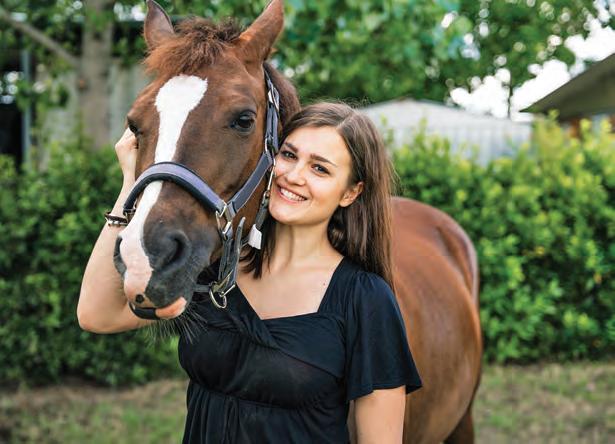
4 Better welfare
If you acquire a horse with an ERC passport, you know how old they are and don’t have to rely on a vet check or the seller’s guesstimate. That means you can treat them appropriately for their age.
5 Scannable QR code
ERC provides a QR tag that can be attached to the horse’s halter or bridle. In the event of a fire or other emergency, you can braid it into their mane or tail. If someone finds the horse, they can scan the QR tag, and the horse owner will get a notification that someone scanned the code. The person who found the horse can provide their phone number and email address, and the owner will receive a push notification, email, and SMS right away to say that the horse has been located.
6 Read any microchip
Ultimately, a microchip is the best way to identify a horse. But the problem with microchips is that a microchip reader is required to read the chip. Plus, microchip providers in Canada all have different registries. If you don’t know which type of chip is in the horse that you found (or lost), you probably won’t know which microchip database to search to identify them.
However, ERC accepts any microchip number from any company. If the owner of a lost horse has registered their horse’s microchip in ERC, the horse will be “findable.”
Acera Insurance has been a proponent of the ERC system, understanding that an overarching horse registration service will substantially assist horse owners across the country.
“ERC is offering a level of secure data for our Canadian herd that has never been seen before,” says Mike King, Director of Equine Insurance at Acera Insurance . “We strongly urge all individuals and herd managers to utilize this economical and proven technology to their advantage.”
Free and subscription levels of the ERC system are available at www.equineregister.ca and PTSO members in Ontario and British Columbia are eligible for reduced subscription rates. b




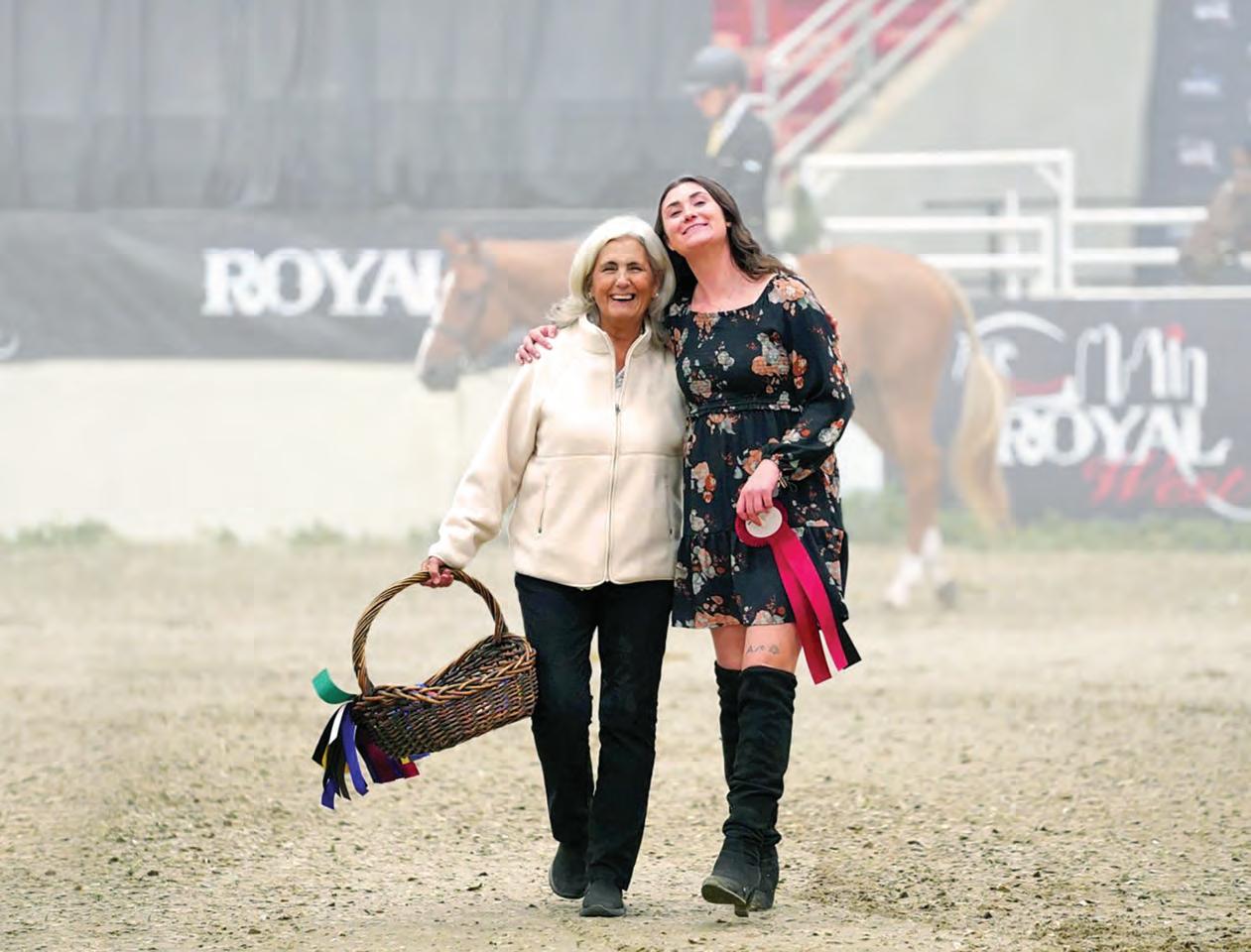
By Monique Noble
It’s easy to get caught up in the excitement of a horse show — the impeccably groomed horses, the polished riders, the vibrant atmosphere, the thrill of victory. A ribbon passed from one hand to another becomes a shining testament to hours of dedication, passion, and commitment. Amidst the buzz, it might also be easy to overlook the lady holding the basket of ribbons, who is smiling ear to ear as she celebrates your victory. You might not realize that it is her victory, too. The ribbon she hands you represents over 50 years of dedication to equestrian sport and the Canadian Sport Horse Association (CSHA). That smiling “Ribbon Lady” at Rocky Mountain Show Jumping (RMSJ) in Alberta is Barbara Jackson — a longtime volunteer and passionate horse enthusiast.
In 2024, she celebrated an incredible milestone: 50 years of volunteer service to the CSHA.
Originally from British Columbia (BC), Jackson began riding horses at age 11 when her family bought a farm close to Ladner. Quickly hooked by horses, she knew by age 14 that she was a hunter at heart. The classic, stylish sport spoke to Barb’s meticulous nature and attention to
detail, and sang to her desire for a challenge and the pursuit of perfection.
A serious competitor by her 20s, Barb was looking to breed her lovely Thoroughbred mare and develop her next hunter prospect. Her quest led her to the CSHA where she quickly became a valued
member and an invaluable volunteer. Since joining the CSHA in 1974, Jackson has devoted herself to the everevolving needs of the club, holding a variety of voluntary roles both provincially in BC and Alberta, and at the national level. Her contributions include serving as national president, vice-president, provincial board member, treasurer, and provincial vice-president. Additionally, she is a mare inspector, supports stallion inspections, and has demonstrated a strong commitment to the constitution and bylaws at the national level, ensuring they remain current and relevant to the sport.
As fellow CSHA member, volunteer, and close friend Lisa Murphy attests, Jackson’s unwavering commitment to the CSHA shines through in her dedication and interest. “The really dry stuff of constitution and that sort of detail-work really kept her busy,” says Murphy. “She would work very closely with the national
board on our constitution and make sure that it’s up-to-date and reflects how things are sitting in the industry… not everybody is interested in the constitution. It can be a bit dry, but she’s been very, very involved in that governance part of the association, which is so important.”
Since its inception in 1926, the CSHA has been registering and identifying sport horses. As market demands have changed, so too have the practices of the Association. The oldest sport horse association in Canada, it was the first open a studbook in North America to include European warmbloods in its pedigrees. The CSHA has always evolved as quickly and gracefully as the horses that grace its bloodlines. Jackson has been instrumental in ensuring that the standards of governance, the intricacies of bloodline management, and the calibre of excellence required of registered equine individuals within the CSHA are equal to those of any other warmblood association throughout the world.
Upholding the CSHA mandate to promote the awareness of Canadian sport horses, keep records, organize inspections, provide information, and assist breeders with trustworthy registration in keeping with respected international standards, all while incorporating horses of different breeds that meet those standards, is no small task. Jackson, a respected CSHA breeder herself, has travelled many miles to inspect prospective CSHA horses. Her keen eye has helped develop, improve upon, and progress the quality of CSHA horses. Talented new bloodlines are always welcome, as are new technologies. With the introduction of artificial insemination and recipient mares, the options to have future generations and hopeful champions shipped across the world have become common practice. With parentage not always easily ascertained, DNA testing is now an essential part of breeding and registering CSHA equines. Shepherding the rules of order for scientific advances alone in the last 50 years would be intimidating, mix in social media alongside a growing global presence, and Jackson’s ability to navigate the hurdles of progress and learn new ways of doing things to keep pace with emerging resources is astonishing. Balancing these responsibilities while relocating to Calgary, Alberta to raise a family and
competing with her own horses is a testament to her tireless dedication.
In 2023, Jackson’s extraordinary contributions were recognized with the Dick Day Award, presented after a hunter derby at Royal West — a prestigious jumper and hunter show hosted by RMSJ. The recognition was especially meaningful given her deep-rooted history in the sport. Established in 1983 by Mr. and Mrs. Douglas Lobsinger in memory of professional horseman and breeder Dick Day, the award celebrates exceptional contributions to the CSHA.
Jackson only recently retired her 17-yearold mare Glaydene, the horse she competed with since purchasing her as a five-year-
old. Jackson’s voice lilts with joy as she recalls her competition days with Glaydene, almost as if she is astride her trusted mare sailing over jumps as she reminisces.
“I bought her when she was five… I had a small budget and got lucky and found her. And oh, we had just the best years, just the best. She’s a horse with a huge amount of heart. And just oh-so-willing [as if saying]… ‘okay, we will do that now, sure yeah, we can do this. Sure.’”
Glaydene’s retirement ceremony was hosted by RMSJ where Glaydene and Jackson were celebrated by their fans, fellow equestrians, and the young riders who were lucky enough to have “Glaydene the Queen” as their derby mount. Now
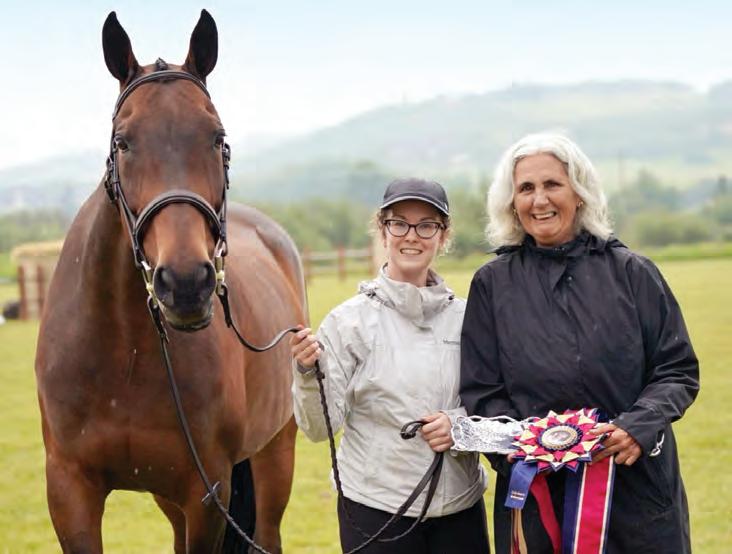
Glaydene, Ashton Weibe, and Barbara Jackson at Glaydene’s retirement at Rocky Mountain Show Jumping in 2024. Check out that ribbon!


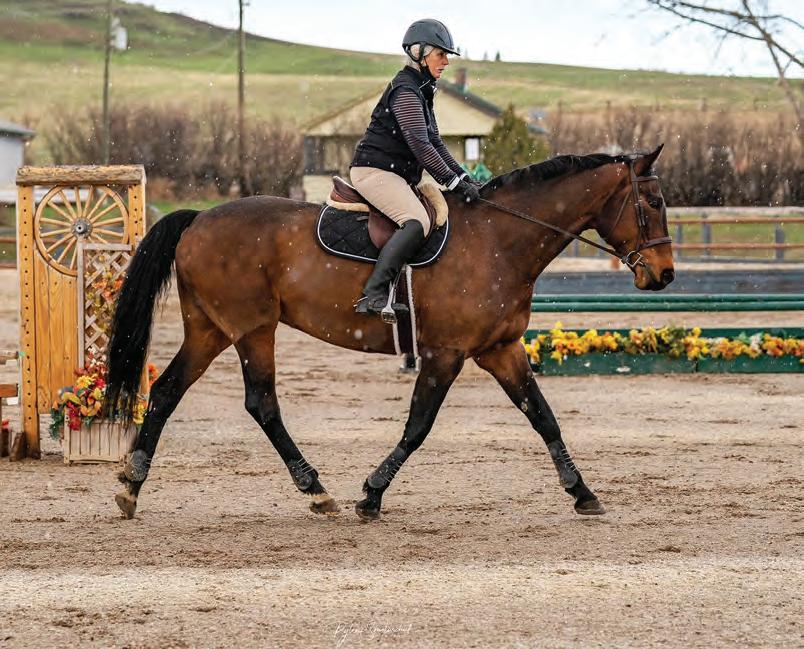
semi-retired, Jackson loves her revered position of “Ribbon Lady” at RMSJ and admits, “I asked if we could hold a retirement ceremony for her (Glaydene), but you know, that was just me wanting to order the fanciest ribbon in the world.”
Jackson’s taste in ribbons is as discerning as her taste in horses, and
everyone is excited when she enters the ring with her bright and colourful basket of treasures.
“It’s a thing, isn’t it?” she laughs. “Recently at one of our meetings, we talked about that, when we do an inspection or give an award. And all of them …wanted something, you know, like they want a ribbon or a plaque or both. It has a special meaning. I don’t understand people who don’t want them. It’s like
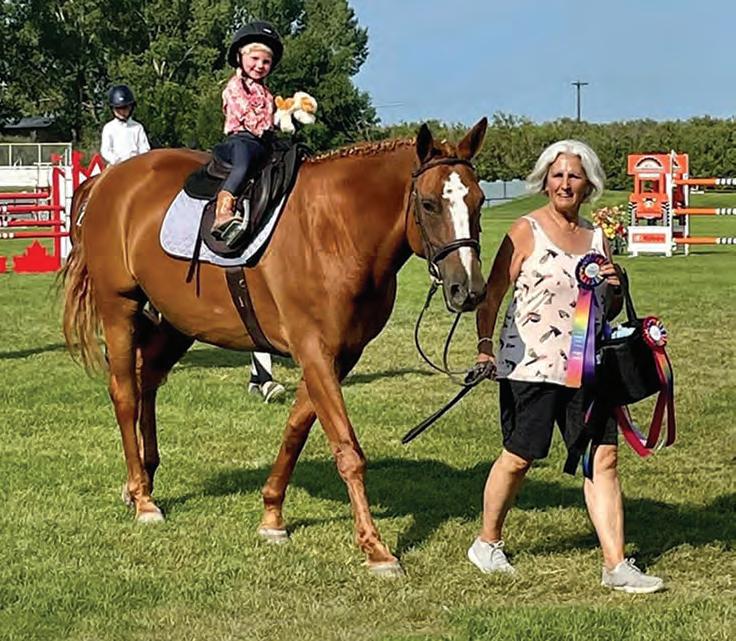
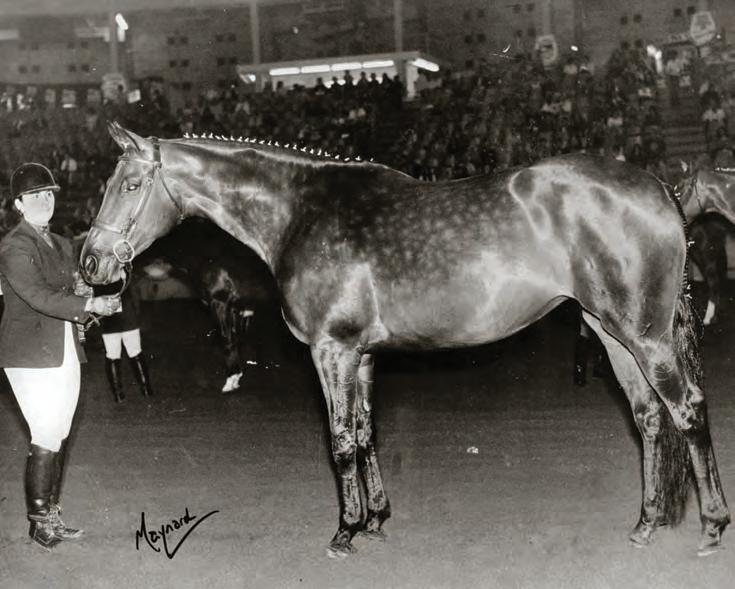
getting a gold medal… oh, you don’t want your gold medal? What the hell is wrong with you?” It’s a tangible thing that you can hold, and something that says you’ve accomplished a goal.
Jackson says she is slowing down a little, but she still rides a 17.2-hand gelding regularly, so her “slowing down” still runs laps around most of us. Her goal now as she steps back a little is to find ways to encourage and engage new volunteers. She is always amazed at their talent and the innovative ideas they bring to the table. Barb encourages them to be creative and use their skills to continue the club’s evolution. “You have to bring in the new technologies and the new ways of thinking and the best way to do that is to have younger volunteers coming in, showing you these new ways of doing [the] things they do, because they have a life experience that I probably don’t have,” she says. “I only wish that I can effect change and find people out there as passionate as I am about the sport, the breeding, everything. And who want to step up just like I have.”
The CSHA board has launched learning symposiums and other initiatives to engage and support volunteers. Jackson encourages anyone interested in volunteering to reach out, as talented new blood is always welcome. The foundations that Jackson has spent a half a century engineering with passionate dedication have ensured that she has achieved her goal of effecting change while simultaneously setting the association and future volunteers up for success.
Reflecting on her 50 years of contributions to equestrian sport that Jackson says “went by in a flash,” she is thankful for the many adventures she has had, and devoted colleagues, friends, and fans she has made throughout the horse world across Canada and around the globe as a CSHA member and volunteer.
Barbara Jackson is a CSHA icon, a lifelong volunteer, an accomplished horsewoman, and without a doubt a horse community hero. Her legacy is one of unwavering dedication, progress, and a love for equestrian sport. We thank her for everything she has done for the CSHA and the Canadian horse industry. We know she really does deserve the fanciest ribbon in the world! b
> Monique Noble is a frequent contributor to this magazine — read her bio on page 102.
Our Miniature horse, Winston, likes to please us all the time, including in the winter when he likes to pull us for a ride. Winston is my wife Lyne’s horse. She has had horses throughout her adult life and likes a multi-discipline horse that will do dressage, tricks, jump, go for long free-walks in the morning, and also pull a little sleigh in the winter. Winston does all that with willingness and is always happy to work with her and his coach.
We bought Winston when he was seven years old and very green. His previous owners are very nice people but were unable to take care of him anymore. The driver in the sleigh is his coach, also named Lyne, and she specializes in working with Miniature horses and ponies. My wife has mobility issues, so Winston’s coach plays a big role in what he learns. Winston is deeply loved by both Lyne and his previous owners. He is a lucky Mini with a good life.
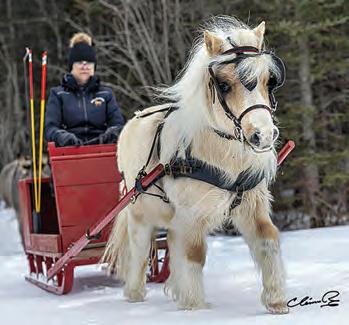
Clément Roy, SaintAimé-des-Lacs, QC
We are so incredibly grateful for your generous support of the Teen Ranch H/J Shows once again this past season! It’s such an awesome bonus for all our guests to receive a copy of your magazine upon arrival. We love that together we can help educate horse lovers of all levels! Your prize donation support made it possible to run these quality shows for our grassroots riders and offer amazing gifts to them. They enjoyed five awesome shows in the series, as well as a topnotch year-end banquet hosted at the Best Western in Orangeville. Ribbons and amazing prizes went to the top six in each division, and to many additional prize winners like Sportsman of the Year, Tenacity winner, Thoroughbred Incentive Program awards, Welsh awards, High Point Horse, Professional Turnout award and more. We also had games, activities, and lots of laughs! 2025 will be our 40th year running these shows and your support has helped make that milestone happen, so THANK YOU!
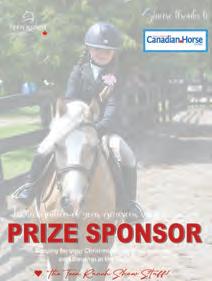
Teen Ranch, Caledon, ON
Thank you very much for your support of the 2024 Westar Farms Horse Shows. Fifteen events spanned the season from the beginning of May to the end of September in our introductory level Development Series, Trillium, and Bronze Hunter Jumper shows, topped off with the OVPSC Bronze Championships and Derby Day, as well as the Dressage Series with classes for
Equestrian Skills Development (ESD), and Silver and Gold level competitors.
We endeavour to provide unique or special prizes, and you have helped us do that to the delight of competitors. We always get comments on the beautiful ribbons and great prizes at Westar shows!
Your sponsorship has helped us continue to develop the horse show infrastructure. After show season wound up, we expanded the graveled area of the parking lot, built up the floors of the show stalls, and regraded the surrounding area to better drain away rainwater.
We already have plans and dates set for next year and hope you’ll join us again.
Jeff & Bridget, Westar Farms, Ashton, ON
Thank you for your continued support of our show series. This has allowed us to offer a wonderful experience to our competitors.
Christy Chamney, Silver Fox Equine, Mono, ON
Got feedback, news, or shoutouts? We’d love to hear from you! Please include your name, address, and email.
Send to Kathy Smith, Editor: editor@horsejournals.com
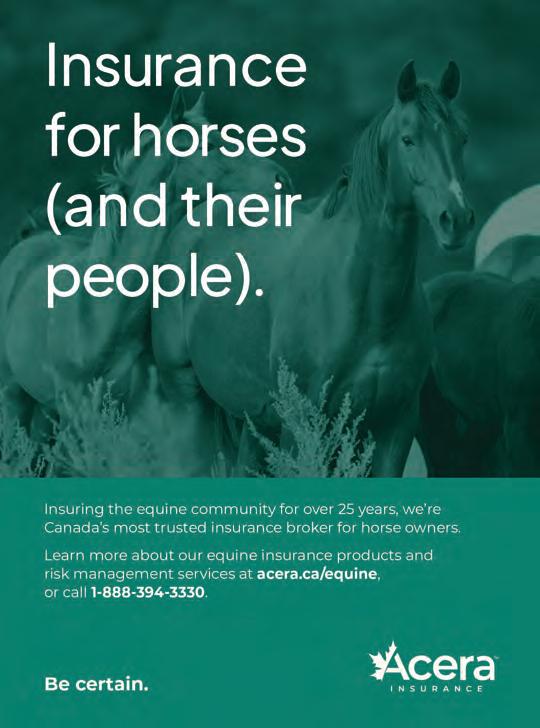

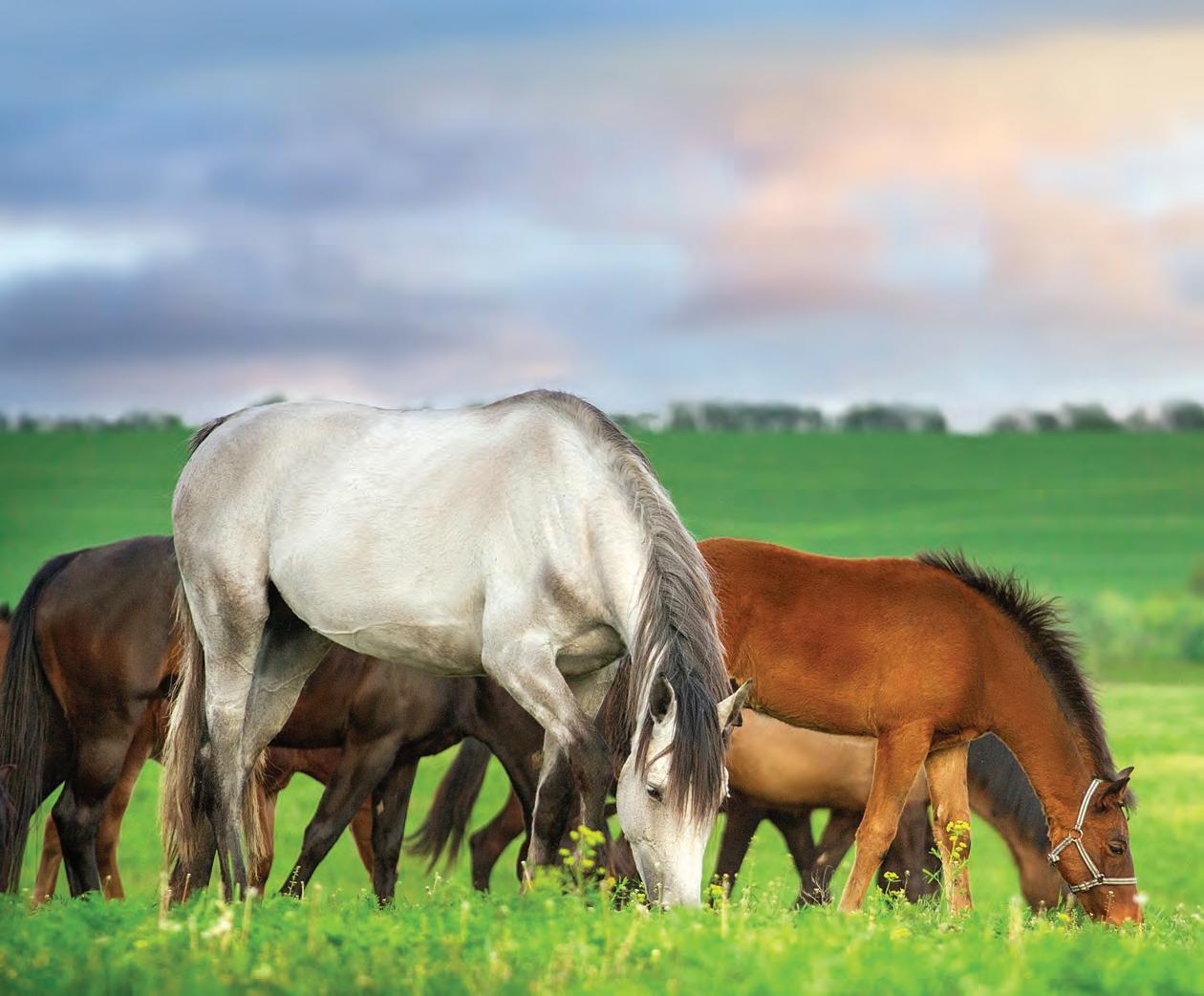

By Madeline Boast, MSc. Equine Nutrition
As a horse owner, you may be curious about the potential benefits of adding omega-3s to your horse’s diet. Do all horses need them? Should you be adding them to your horse’s diet? Are there well-reported benefits?
Understanding the requirement for fatty acids in the equine diet, like omega3s (O3s) and omega-6s (O6s), and the well-reported health benefits of them is important when considering supplementation.
The horse is not able to synthesize omega-3 fatty acids on their own. Therefore, these nutrients are essential to the horse and must be provided in the diet. They play important roles in cell membrane function as well as structure, and are important for inflammatory responses, immune function, muscle
contraction, and blood clot formation.
Omega-6s are another type of essential fatty acid and play an important role in inflammation and swelling. They are also essential for health; however, when oversupplied in relation to omega-3s, they can result in increased inflammation in the body.
When beginning to explore omega-3 supplementation, it is critical to understand that there are multiple omega-3 and omega-6 fatty acids originating from different feedstuffs and having differing biological activity in the body. The plant-derived fatty acids that are present in the equine diet must go through an elongation metabolic process prior to being available for the horse to use. Hence the biological activity differs depending on where that omega fatty acid is in the elongation process.
Alpha-linolenic acid (ALA) is typically the most prevalent omega-3 in equine diets as it is plant-derived and present in
forages. However, research generally focuses on the omega-3s eicosapentaenoic acid (EPA) and docosahexaenoic acid (DHA) which is at the end of the metabolic pathway. These omega-3 fatty acids are more bioavailable than ALA.
The omega-3 at the start of the metabolic pathway is ALA. The omega-6 at the start of that metabolic pathway is linoleic acid (LA). These starting fatty acids must be elongated prior to being of use to the animal. Delta-6-desaturase (D6D) is the enzyme that begins this elongation process for both ALA and LA.
As both omega-3 and omega-6 fatty acids rely on the same enzyme in their metabolic pathways, and because there is a finite amount of this enzyme available to use, it becomes rate-limiting. Therefore, to maximize potential health benefit, it is recommended to provide omega-3 fatty acids that are further along in the elongation process and skip this limiting step.
This reduces the issue of ALA and LA having to compete for the same enzyme. Due to the competition for the enzyme that facilitates elongation it is important to be aware of the balance of these nutrients in the diet.
When deciding on a product, understand what the omega-3 to omega-6 ratio is as well as the type of omega-3 in the product. Choose a fat source that has a balanced ratio for your horse considering his entire diet and health status.
Alphalinoleic Acid (ALA)
Horses must use the liver enzyme delta-6desaturase to elongate ALA into SDA.
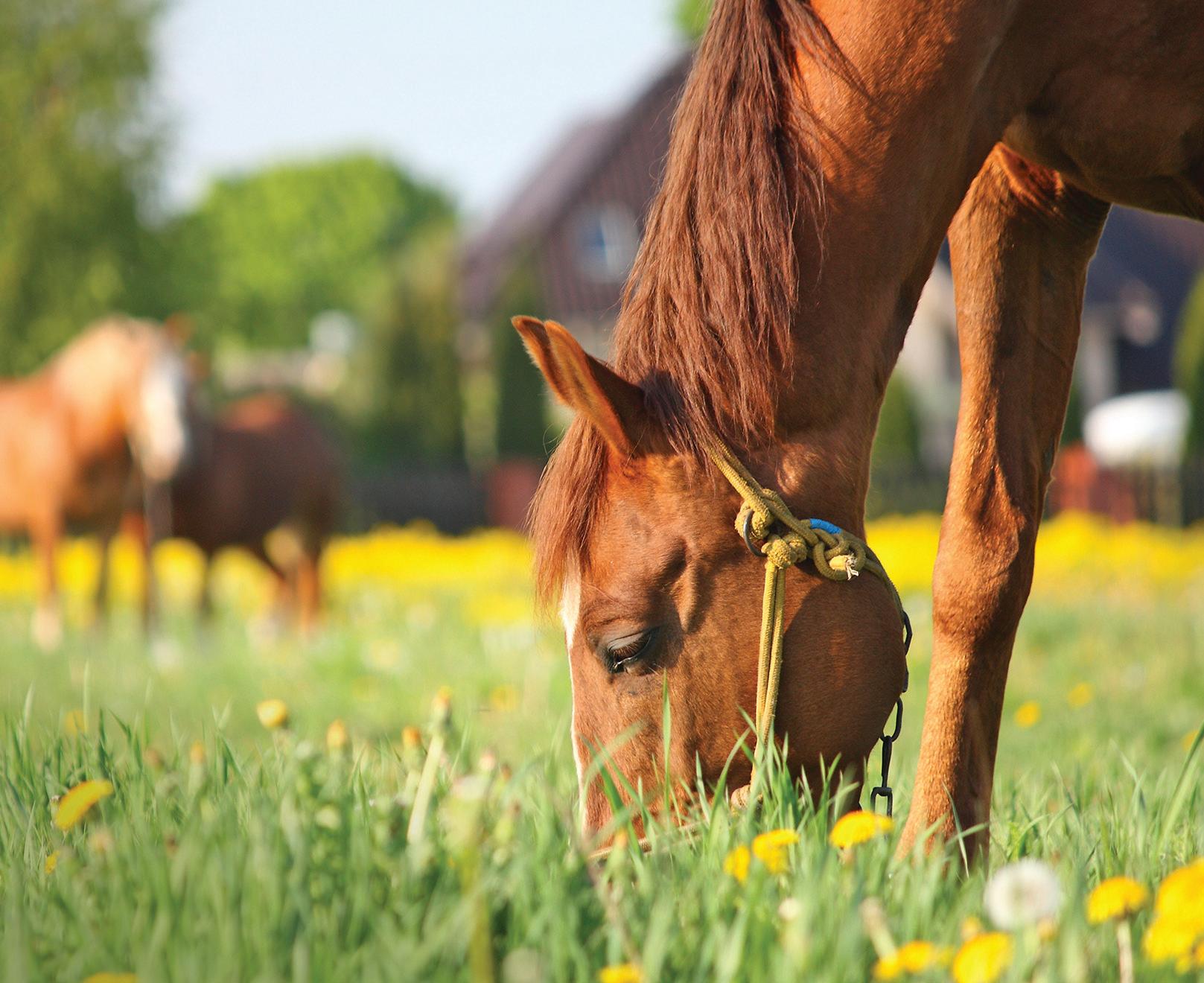
Horses naturally evolved to consume large amounts of forage, which contain more omega-3 than omega-6. In contrast, grains have a higher omega-6 content.
Docohexaenoic Acid (DHA)
Stearidonic Acid (SDA) The first step in the metabolic pathway. SDA is readily converted into DHA as it is past the ratelimiting step.
DHA plays a key role in the resolution of inflammation.
Full Metabolic Pathway Diagram
As both ALA and LA require the use of DGD to elongate and convert into the more beneficial fatty acids, it can limit the conversion rate due to competition for use.

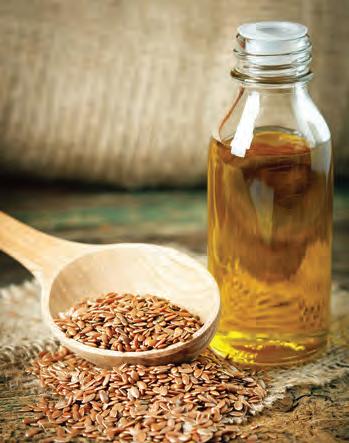
Research has not yet established an optimal ratio for omega-3 to omega-6 content in the equine diet, but it is hypothesized that about 1:1 is ideal. Horses evolved to consume large
amounts of forage, and forages contain more omega-3 than omega-6 content. Grains are the opposite, containing more omega-6s.
Horses that are maintained on foragefirst diets will generally have more omega-3 than omega-6 content in their diet. Forages provide low levels of fat with
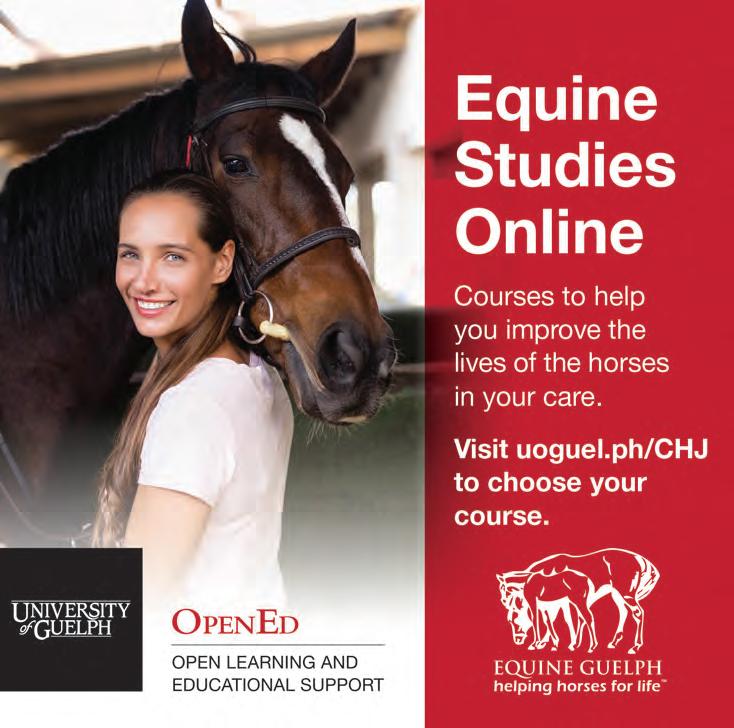
the typical range being about two to three percent. Even though the overall percentage of fat in hay is low, the horse consumes a large volume of hay daily, and generally a much larger volume than supplemental feeds or concentrates. Even when omega-3 supplements are added, the forage often remains the most vital source of plant-derived omega-3s as the volume consumed is so great.
When grain-based concentrates are added to the diet, the omega-6 content of the diet increases. Omega-6 fatty acids are often presented in a negative light, and despite what marketing may lead you to believe, they are not bad for your horse. In fact, both omega-3s and omega6s are required to support optimal health in horses.
Most horses that are maintained on a forage-based diet with adequate vitamin and mineral supplementation do not require an omega-3 supplement, as their forage will be an adequate source. However, there are a multitude of studies illustrating health benefits of omega-3 supplementation, specifically in regard to reducing systemic inflammation in the body.
Inflammation is a healthy and important process in the body. For example, when a horse is exercised, inflammation plays a key role in the body returning to homeostasis afterwards. When discussing dietary modifications to reduce inflammation, the focus is on systemic inflammation, which persists over time and can become a concern. To optimally supplement your horse and successfully reduce systemic inflammation, both the omega-3 to
omega-6 ratio as well as the type of omega-3 are important factors to consider.
As previously mentioned, not all omega-3s are equivalent in their biological activity. The sought-after omega-3s are EPA and DHA, which result from elongation of plant-derived omega-3s, or can be fed directly to skip the elongation when derived from marine-based sources such as fish oil. The primary challenge when feeding marine-based omega-3 sources is that horses are herbivores and do not find them palatable. As with any feed or supplement, if the horse is unwilling to eat it, there will be no health benefit.
The first consideration when choosing a fat source to add to your horse’s diet is the omega-3 to omega-6 ratio of the product. Fat supplements are commonly added to equine diets for calorie content and to improve coat health. Now understanding the omega-3 to omega-6 ratio, identifying which fatty acids are present in the product is important to make the best choice.
For example, sunflower seeds and oil may be fed as a source of fat in the diet; however, the omega-6 content far exceeds the omega-3 content with a ratio of about 200:1, omega-6 to omega-3. This may not be an issue for a horse that is on a forage-based diet without a large amount of grains; however, if you are trying to reduce systemic inflammation, or have a horse that is on supplemental grain-based products, it is recommended to opt for a fat source that provides a more balanced ratio, or is higher in omega-3 than omega-6 content.
Linseed oil, also known as flax oil, is one of the most popular omega-3 sources fed to horses. It has an omega-6 to omega-3 ratio of about 1:4. Research published in 2002 by O’Neill et al. illustrated that horses fed one pound of flaxseed per 1000 pounds of body weight for a duration of 42 days had reduced inflammation and a significant reduction in skin response to an allergen.
As flax oil is a plant-based omega-3 source, it would be providing ALA, which as previously discussed is at the start of the metabolic pathway and must compete with omega-6s for the elongation enzyme D6D. This is why many products will market their EPA and DHA content to skip that rate-limiting step and improve the bioavailability. A 2010 study from the University of Florida, by Vineyard et al., 2010, was unable to illustrate a modification in the EPA or DHA levels in the blood when ALA was supplemented to the horses.
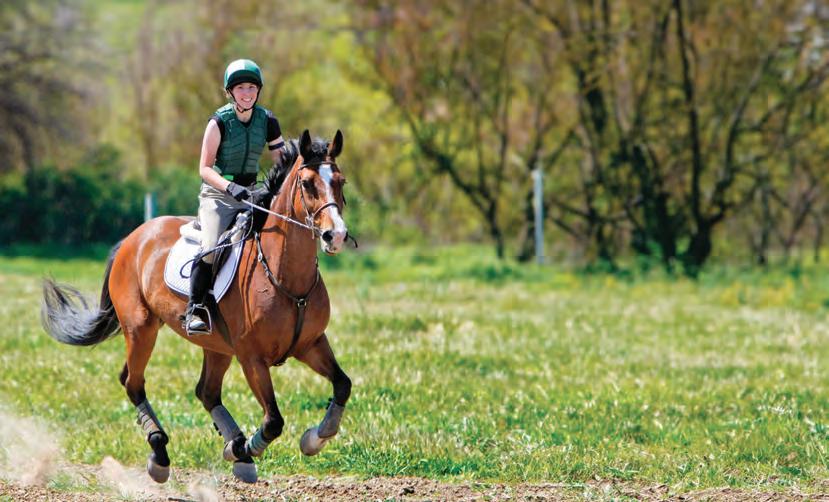
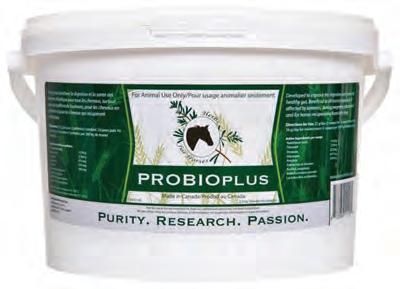
We humans are a peculiar bunch. As creatures of habit (and not always good habits), we frequently engage in behaviours that we think are good for us. For instance, I take a daily multivitamin without really knowing if or how they actually work.
In the horse world, probiotic supplements are vibrant examples of this. Horse owners enthusiastically spend around $250 per year per horse on probiotics, blindly faithful to the concept with almost no definitive evidence that they do anything useful at all.
Herbs for Horses is about to change all that. Their combination probiotic/ prebiotic supplement, ProbioPLUS™ , has undergone more than two years of extensive study at the University of Guelph to better understand its effect on the equine digestive tract. And now the results are in!
In a separate study, MSc student Maria Lagounova fed ProbioPLUS for 28 days to a group of actively racing Standardbreds, some of which were receiving 10 days of antiobiotic treatment, and evaluated the fecal microbial population over the 28-day duration. While there were limited effects of ProbioPLUS on the fecal microbiome, ProbioPLUS supplementation increased the diversity of microbial populations over the 28-day period, while promoting
a softening of feces during the latter part of the supplementation period. Taken together these two studies provide evidence that ProbioPLUS supports the equine gastrointestinal tract primarily in a prebiotic manner (i.e., supports the microbiome that is already there, rather than influencing its composition). The increase in short-chain fatty acids following probiotic supplementation has been reported previously in horses* and may offer significant benefit to athletic horses by providing an energetic alternative to glycogen, reducing lactate accumulation (which causes tying-up) in muscles following exercise. This means your horse may be able to exercise longer and at higher intensity prior to the onset of fatigue.
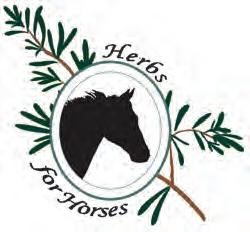
There is still much to be learned about how probiotic supplementation can help support overall health and wellness in your horse. But this extensive research into ProbioPLUS can help us make supplement choices based more on objective evidence and less on blind faith. b Contact Ralph at Herbs for Horses for reading list or product samples (text: 519-837-7898) or email ralph@horseherbs.com. > www.HorseHerbs.com
*Lagounova M, MacNicol JL, Weese JS, Pearson W. The Effect of Dietary Synbiotics in Actively Racing Standardbred Horses Receiving Trimethoprim/Sulfadiazine. Animals (Basel). 2023 Jul 18;13(14):2344. doi: 10.3390/ani13142344. PMID: 37508120; PMCID: PMC10376248. *MacNicol JL, Renwick S, Ganobis CM, Allen-Vercoe E, Weese JS, Pearson W. The influence of a probiotic/prebiotic supplement on microbial and metabolic parameters of equine cecal fluid or fecal slurry in vitro. J Anim Sci. 2023 Jan 3;101:skad034. doi: 10.1093/jas/skad034. PMID: 36715114; PMCID: PMC9994591.

For horses that need more calories to maintain desired body weight, or those at risk of developing ulcers, fat sources with greater omega-3 than omega-6 content can be a good option.
Therefore, the source you choose when adding omega-3s to your horse’s diet will impact the health benefits you see. A study completed at the University of Guelph by Burron et al., 2023 compared camelina, flax, and canola oil. The horses were provided with 370 mg of oil/kg body weight daily. Both camelina and flax have greater omega-3 content than omega-6, and canola oil has a greater omega-6 content. The fatty acid profiles in the plasma reflected the differing fatty acid profile of the oils provided. For example, plasma ALA was greater for horses supplemented with flax oil than canola oil and the omega-6 to omega-3 ratio decreased over time for both camelina and flax oil groups.
There are many well-reported benefits to omega-3 supplementation for horses, and new research expanding our knowledge on this topic continues to be published. From improved respiratory function, improved skin health, and decreased joint inflammation, the health benefits are numerous and backed up by science.
A 2009 study by Manhart et al. reported that horses supplemented with EPA and DHA had lower prostaglandin E2 levels in their plasma, which is an omega6-derived pro-inflammatory pain producer. This research suggests that supplementing EPA and DHA could be beneficial in horses that have osteoarthritis. Additionally, DHA-rich microalgae have been shown to decrease
the inflammatory response in joints and in turn improve lameness scores.
In addition to positive research on reducing inflammatory responses related to osteoarthritis, a 2014 study by Nogardi et al. demonstrated that daily PUFA (polyunsaturated fatty acids) supplementation for two months improved the clinical signs of chronic lower airway inflammatory disease by about 60 percent. The DHA amount supplemented to these horses ranged from 1.5-3 g daily.
In addition to the research showing benefits to certain health issues, adding fat to the diet for calorie supplementation is a popular practice. For horses that tend to be excitable on supplemental grains and concentrates, but require more calories to maintain a healthy weight, fat sources can be a good option. This is also recommended for horses that are at a greater risk of developing gastric ulcers as you can add calories to the diet without increasing the starch content. In these cases, a fat source that is providing EPA and DHA is not necessary but opting for a fat source that has a greater omega-3 than omega-6 content is recommended.
If your horse is on a forage-based diet that does not have a large inclusion of grains or omega-6 rich ingredients, you do not need to add an omega-3 supplement. However, if your horse struggles with any health issues that involve increased inflammation, such as osteoarthritis, heaves, or allergies, the current research
Both omega-3s and omega-6s are required to support optimal health in horses.
supports supplementation. If your horse experiences any of the previously mentioned health issues, it is recommended to discuss optimal omega-3 supplementation with your qualified nutritionist.
First and foremost, when deciding on a product, understand what the omega-3 to omega-6 ratio is. As previously stated, many fat sources provide more omega-6s than omega-3s, which would not be effective at lowering the overall dietary ratio. The exact ratio of the product may not be publicly available, so in these cases, read the ingredient list to evaluate where the omega-3 and omega-6 fatty acids are coming from. For example, is the product a flax oil base (more omega3s) or a soy oil base (more omega-6s).
Secondly, in addition to the ratio of omega-3s to omega-6s, the type of omega-3 is critical to consider. Adding a product that is providing EPA and DHA, and therefore skipping the rate-limiting elongation step, is beneficial. These products have marine-derived omega-3s, so note that palatability may be an issue.
Both omega-3 and omega-6 fatty acids are essential to equine nutrition. When deciding whether to supplement your horse beyond what their hay provides, it is important to take a comprehensive approach by evaluating their entire diet and health status.
Choosing a source that has a greater omega-3 than omega-6 content, and prioritizing EPA and DHA content when trying to reduce systemic inflammation resulting from chronic health issues, is recommended. If you have specific questions about omega-3 supplementation for your horse, please consult a qualified equine nutritionist. b > Madeline Boast is a frequent contributor to this magazine — read her bio on page 102.





By Maxwell H. Gluck, Equine Research Center
“Event Cancelled. Quarantine in Effect.”
No equine event manager or exhibitor wants to hear these words. However, the growing number of equestrian events, increased interprovincial and international equine movement, and the rising concentration of horses at individual events have all heightened the risk of infectious disease outbreaks and transmission.
Biosecurity, the measures taken to prevent pathogen entry and spread on a premises, is the key to protecting both equids and event venues from devastating disease outbreaks. There is no one-size-fits-all biosecurity plan for equine events as each venue event is unique. Thus, identifying and assessing biosecurity risks for the population of equids at the event and on event grounds are essential to developing the most effective biosecurity plan. The first step is performing a biosecurity risk assessment to identify the disease risk factors for the venue, event, and horse population. Although the venue typically
maintains a consistent footprint, weather can influence the entry and spread of disease agents. For example, strong winds in Canada, such as the Chinook winds in the west or powerful storm systems in the east, can carry pathogens or infected vectors (insects) onto or around a venue, increasing the risk of disease transmission.
Additionally, droughts almost certainly impact the availability of hay, resulting in the sourcing of hay for an event from further away. This sourcing of hay can potentially lead to the transmission of unfamiliar pathogens, toxins or insects, such as blister beetle, to a venue. Lastly, hot, humid days increase the likelihood of horses clustering under shade and/or utilizing communal water sources, which results in a higher risk of respiratory pathogen spread.
When looking at equestrian events, there is no cookie-cutter event biosecurity plan for the venue. Each event is unique with regards to stabling and competition plans for the venue grounds. Events involving multiple disciplines may designate a day or consecutive days for each discipline, while others may have all
disciplines on the venue grounds at the same time. Thus, a disease outbreak occurring in one discipline would more significantly impact a show that includes many disciplines on the grounds, especially if horses of various disciplines are housed together.
Another aspect to consider is that each discipline has different horse management and competition practices that could impact disease risk. For example, at some Western events it is more common to see horses tied along the fence outside the competition arenas. At another event, a single nose rag might be used to wipe several muzzles outside a show ring. During an event, the amount of horse-to-horse contact on the grounds can also impact these outcomes.
Once a risk assessment has identified potential points of disease entry and transmission, the appropriate biosecurity measures can be determined to mitigate the risk. The event manager, in consultation with the event veterinarian, should compile these biosecurity measures into a written biosecurity plan for the event. Some basic concepts to consider in a
biosecurity plan include healthy equine entry requirements; limiting horse-to-horse contact; limiting human contact to essential personnel; avoiding the sharing of equipment unless it has been cleaned and disinfected between uses; and monitoring the health of all equines on the premises. Entry to the venue should be restricted to horses accompanied by an owner-signed health declaration, which attests that the horse has been monitored for a minimum of three days prior to arrival with twice-daily temperature readings below 38.5° C (101.5° F) and no observable clinical signs of disease. Furthermore, the plan should require and verify proof of vaccination for equine influenza and equine herpesvirus-1 within the prior six months.
Unfortunately, even with these measures implemented, horses may still develop an infectious disease at an equine event. Therefore, prompt identification and isolation of the sick horse limits disease spread beyond the first case. Identification of the sick horse requires protocols that call for all horses on the grounds to be monitored for any signs of illness or fever, and if present, be reported to a veterinarian. If the veterinarian suspects an infectious disease case, that
There is no one-size-fits-all biosecurity plan for equine events as each venue event is unique.
horse must be immediately isolated in appropriate isolation stabling. Oftentimes, space is limited on event grounds and appropriate isolation is not possible at the venue. These event grounds must identify a place to isolate off-site in advance, as finding a place at the time of identification of a sick horse delays the isolation and increases exposure risks to all horses on the grounds. Some options for off-site isolation include empty fairgrounds, stables, or fields with run-in sheds.
Once an infectious disease has been confirmed, identifying any exposed horses to monitor can be a significant challenge, especially if the facility or event has many potential avenues for horse-to-horse or human-to-horse contact or sharing of equipment. Horses that can touch over the tops of stalls or through the bars, or that are loped in an arena for an extended time close to another horse, have increased potential for the spread of respiratory pathogens. However, it is often difficult to identify all horses, people, and equipment
that have touched the affected horse. Thus, it becomes important to have protocols in place for all those handling multiple horses to prevent fomite (inanimate objects, such as buckets, rags, tack, etc.) transmission of pathogens. Proper cleaning and disinfecting protocols are essential to decrease the risk of infectious disease agent spread. Stalls and common areas should be regularly cleaned and disinfected with a disinfectant appropriate for the surface. For example, bleach is inactivated by organic material, thus it is ineffective in a stall that has manure stains covering the surface. Metallic surfaces, like bars in a stall, require a noncorrosive disinfectant to prevent degradation of the surface. Venue management should consult a veterinarian to determine the most effective disinfectant(s) for the various surfaces on their grounds.
Ultimately, identifying the disease risk factors for the specific event, developing a written biosecurity plan, and implementing a few key biosecurity measures can protect the horses on the event grounds as well as protect the show from potential cancellation and quarantine due to an infectious disease agent. b
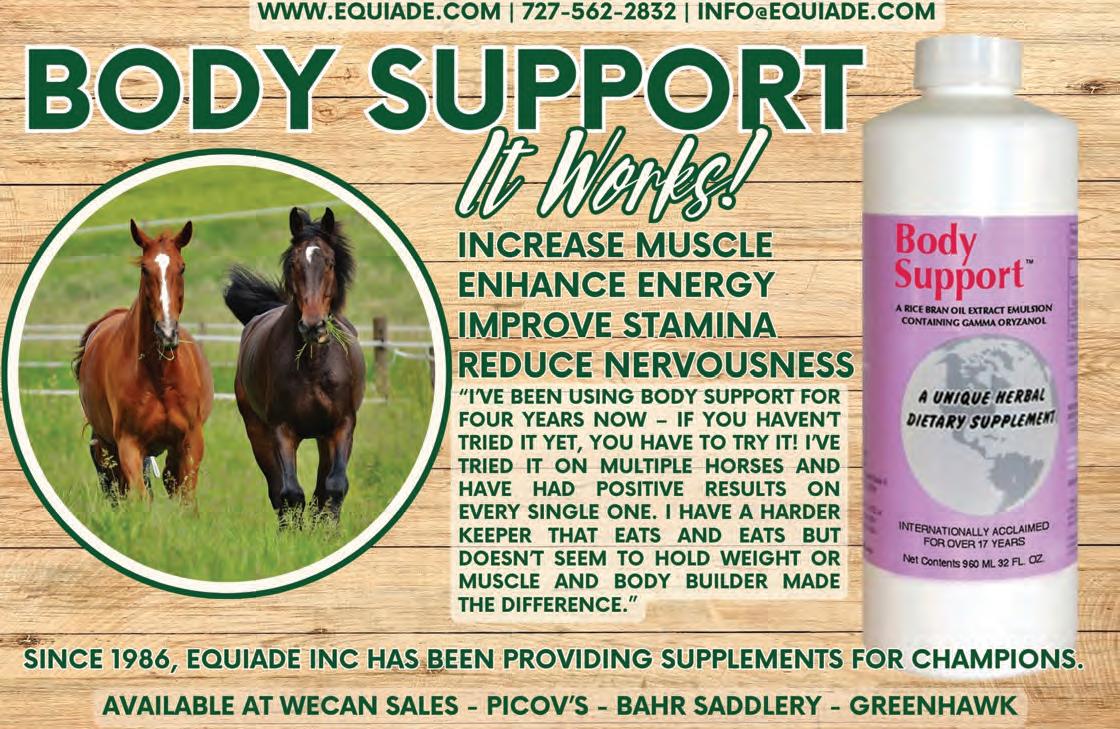

By Dean Sinclair, CJF, Fe, DipWCF
With spring approaching, horse owners are eager to get back in the saddle! However, as winter transitions to spring — or during any time of year with wet and muddy conditions — hoof health can be challenged, as these environments create the ideal conditions for thrush to develop.
Thrush is an anaerobic infection (it thrives where oxygen is not present) involving the frog. It tends to proliferate in the central and collateral sulci (the grooves on either side of the frog), but can involve the whole frog as well as the area between the bulbs of the heel. The infection can lead to inflammation and low-grade lameness. The organism can also inhabit cracks and separations in the hoof wall and white line, especially if the horse is kept in a moist environment and poorly kept paddocks and box stalls.
Thrush is characterized by a foulsmelling black discharge that is related to the breakdown of the horny frog. This
paste-like material is black because it is made up of dead keratin tissue. A variety of organisms can be involved with these anaerobic bacteria, with Fusobacterium necrophorum being the main culprit.
Thrush can affect all breeds and ages of horses, but draft horses are more prone to developing thrush due to the deeper clefts in their hooves, which can trap moisture and bacteria. It may also be because some owners neglect proper cleaning and regular maintenance of their draft horses’ hooves due to their size and the weight involved in lifting them.
The hind limbs of the horse are more frequently involved with thrush than the
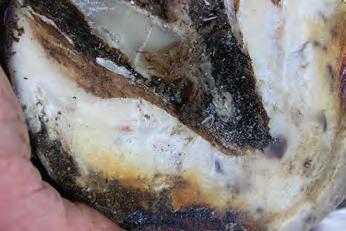
front since the organism is part of the normal fecal flora of several large animals including cattle and horses and can survive in the soil for several months. Fusobacterium necrophorum is classified as an opportunistic pathogen. This classification suggests that the environment must be right for the infection to establish itself. Most dark and poorly oxygenated environments, such as badly kept stalls and wet, muddy pastures, along with lack of regular cleaning of the horse’s feet, can lead to the development of thrush.
In advanced cases, the bacteria can invade the sensitive structures of the frog, digital cushion, and heel bulb region, leading to inflammation and lameness.
Removal of any necrotic tissue from the frog is done by a veterinarian or
qualified farrier with a hoof knife. This will ensure that the affected area is clean and exposed to whatever solution you have chosen to treat the bacteria.
There are several antifungal and antibacterial products available for the treatment of thrush. These products, along with regular cleaning of the feet with a hoof pick and wire brush (which provides oxygen to the affected area), are the best form of treatment.
Although bleach can be used to treat thrush in horses, it can damage the hoof’s protein and kill healthy tissue, so it is not recommended. Alternatives to bleach are iodine, betadine, hydrogen peroxide, or copper sulfate, which will all easily kill the thrush organism.
A product that is safe to use and can usually be found in the household kitchen is apple cider vinegar. Because of its antifungal properties, apple cider vinegar can be used quite effectively to treat thrush. A solution of one-quarter cup (60 ml) of vinegar to one gallon (3.785 l) of warm water can be used in a small bucket to soak the hoof for approximately 15 minutes.
Some remedies for thrush in horses can be dangerous to humans. These include bleach and copper sulfate. Rubber gloves along with eye-protection should be used when handling these products to protect your eyes and skin. Bleach can cause skin irritation and copper sulfate can be absorbed into the body and move throughout the bloodstream.
To prevent thrush follow these management practices:
• Clean hooves daily.
• Keep the horse in a clean paddock or box stall.
• Provide regular farrier care. Regularly scheduled trims will keep your horse’s hooves from growing too long and trapping dirt and manure in the hoof, which can lead to the development of thrush. A healthy frog shares in the loadbearing function of the horse’s hoof and absorbs concussion each time the hoof contacts the ground. The frog also aids in traction. Regular trimming and balancing of the hoof capsule enable the triangular-shaped frog to expand and contract with each stride, pushing dirt and manure out of the grooves of the frog.
As is the case with many lameness
Due to neglect, the thrush organisms invaded the sensitive frog resulting in bleeding when cleaning the frog with a hoof pick. In this case the horse was owned by an elderly couple who were not physically able to pick up the horse’s feet to clean them out.
issues, a team approach of veterinarian, farrier, and owner is crucial for success in most cases. When the horse develops thrush, the rehabilitation process will require more work from the horse owner with daily cleaning and treatment to ultimately achieve a full recovery. b
> Read Dean Sinclair’s bio on page 102.
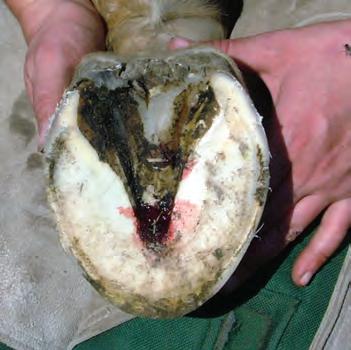
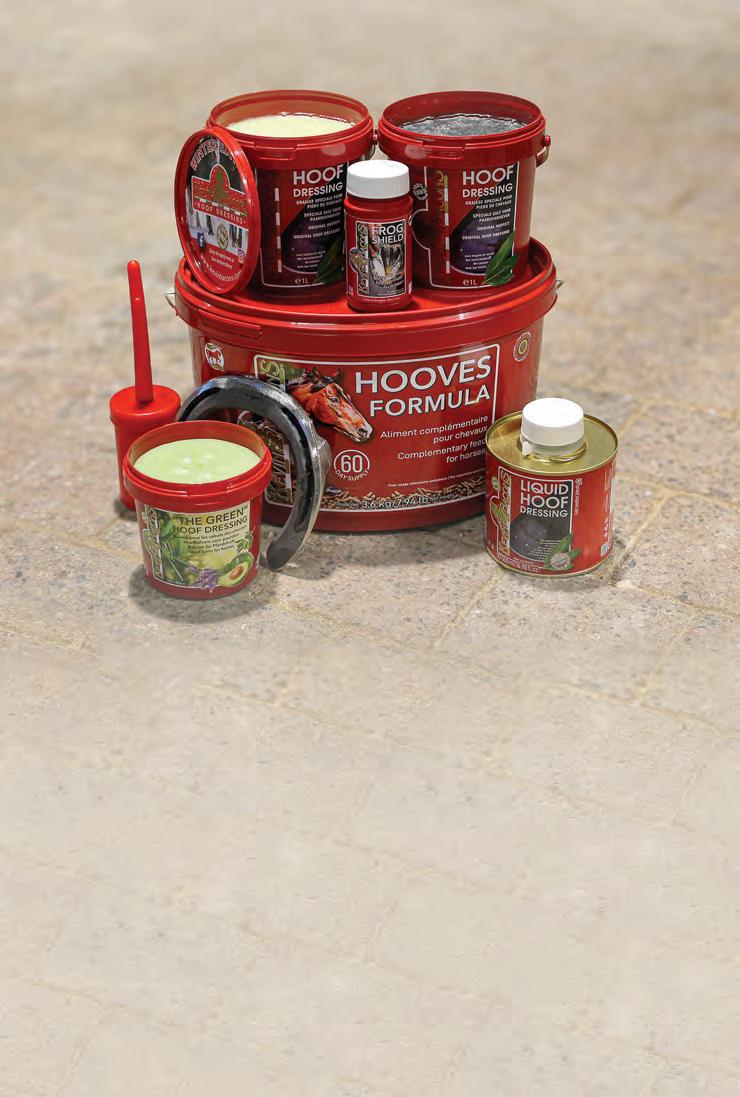
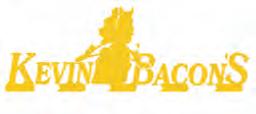
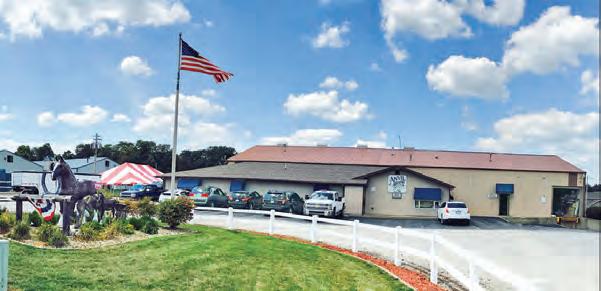
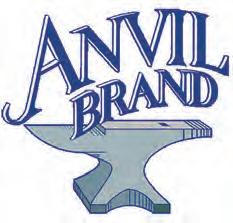
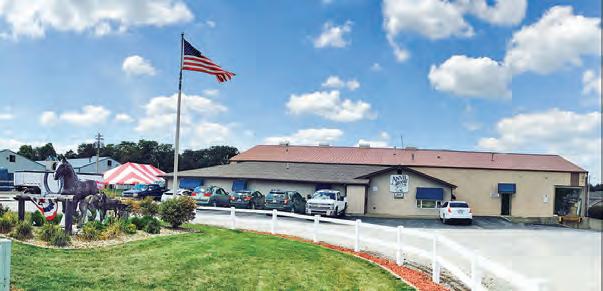
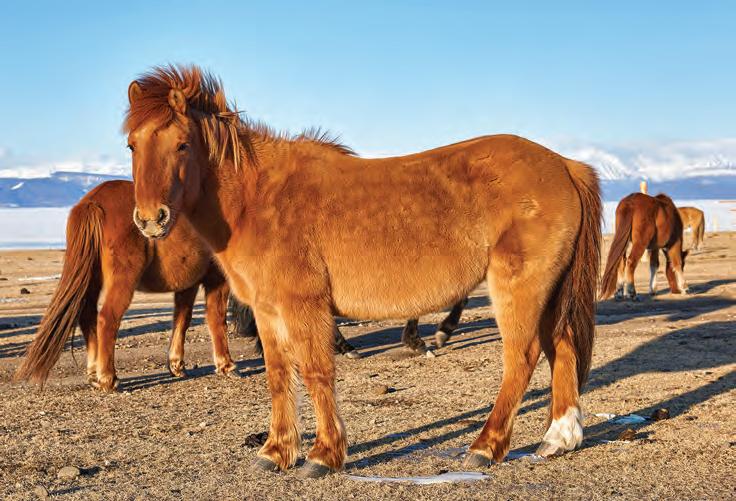
The detection of asymptomatic bird flu infections in horses marks a new frontier in viral spillover risks, highlighting the urgent need for monitoring and measures to prevent cross-species transmission.
A new study has revealed that horses in Asia have been infected with H5N1 avian influenza, commonly known as bird flu, with these infections occurring undetected. This discovery raises concerns about the potential for viral reassortment if horses, which already carry their own influenza virus, become coinfected with avian flu.
The research, led by Professor Pablo Murcia from the MRC-University of Glasgow Centre for Virus Research, was conducted in collaboration with an
international team of scientists from the US and Mongolia. The team carried out antibody testing on horse herds in Mongolia, focusing on two distinct regions: a wetland area with a high population of wild birds and a dry area with low bird density. The results, published in Emerging Infectious Diseases, indicate that horses had been infected with avian influenza in multiple areas of Mongolia over several years. Importantly, there were no prior reports of respiratory disease outbreaks among the horses, suggesting that the
Bird flu (H5N1 avian influenza) primarily spreads among wild birds, such as ducks and gulls, but can also infect farmed and domestic poultry. It has been known to spill over into other species, including mammals, and in rare cases, humans. While rare, H5N1 infections in humans have the potential to be extremely serious. Researchers recommend reducing transmission between species in agricultural settings.
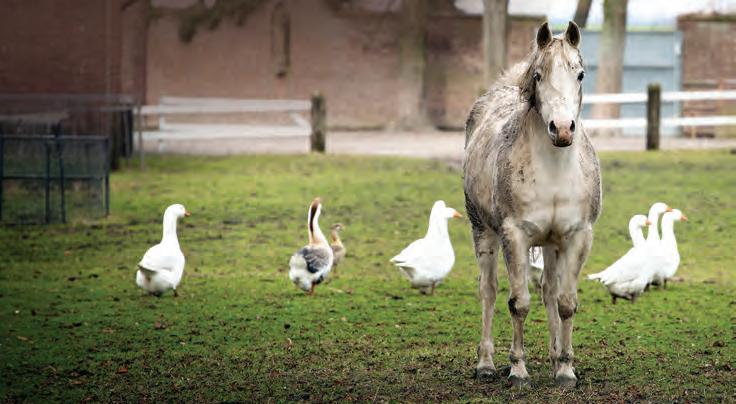
infections were asymptomatic.
These findings confirm that avian influenza can spread to other species, including horses. While equine influenza is typically caused by the H3N8 subtype, the detection of H5N1 highlights the potential for cross-species transmission, particularly in agricultural environments where horses may be exposed to infected livestock. The study raises concerns about the possibility of genetic reassortment if horses become coinfected with both avian and equine influenza viruses, potentially creating new influenza strains with unpredictable consequences for animals and humans.
Since March 2023, H5N1 influenza has been spreading rapidly in dairy cattle across several US states, amplifying the risk of horses coming into contact with infected livestock. North America is home to 30 percent of the global equine population, and many horses may be exposed to H5N1-infected animals in agricultural settings. The likelihood of horses becoming coinfected with both avian and equine influenza viruses could increase, raising the risk of novel virus emergence with unknown pathogenicity.
Professor Murcia noted that influenza emergence is a rare but significant event, with past pandemics resulting from the reassortment of viruses from different species. He drew parallels to the 2009 swine-origin influenza pandemic, which was triggered by a virus containing genetic material from avian, human, and swine influenza strains. He emphasized that similar reassortment events in horses could have serious implications not only for equine health but also for other mammals, including humans.
To mitigate the risks associated with avian influenza in horses, the researchers recommend:
q Enhanced surveillance of influenza infections in horses, particularly in regions with high wild bird densities or significant interaction with infected livestock.
q Strengthened biosecurity measures to reduce interspecies transmission in agricultural settings.
q Further research into the mechanisms of avian influenza spillover and the potential for new virus emergence.
The study, Evidence of Influenza A(H5N1) Spillover Infections in Horses, Mongolia, underscores the need for continuous monitoring and preventive strategies to limit the spread of avian influenza and safeguard both animal and human health. b
With files from the University of Glasgow
We all look forward to good riding weather — but not the fly season that comes with it! Have you noticed that flies prefer some horses more than others, and wondered why?
Equiwinner ™ patches can give your horse relief this fly season.
Electrolytes conduct electricity and manage all bodily fluids, among other things. This conductivity of fluids in and around cells in the skin can affect whether or not flies are attracted to the horse’s skin. Improperly balanced fluids in skin moisture or bodily secretions, particularly the fluid exuding from the eyes, actually attract flies. Optimum electrolyte balance, achieved when electrolytes work properly as nature intended, has a signal that repels flying insects.
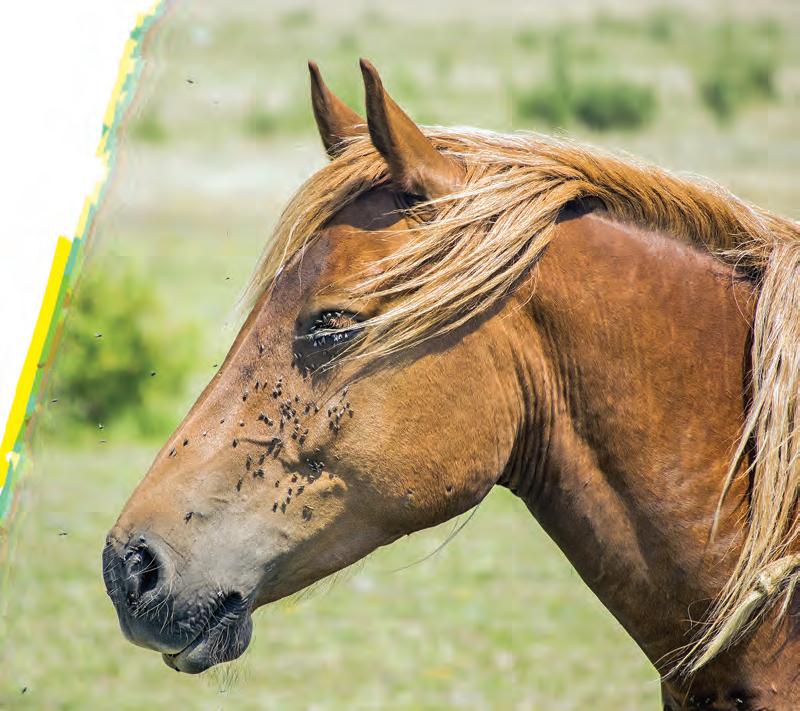
It’s not about feeding more electrolytes — it’s about
making

WPRA World Champion barrel racer Mary Burger has been using Equiwinner™ for seven years. At first it was to treat for bleeding and tying-up, but now she is using it on her healthy threeyear-old. Scan this QR code (left) to see what happened.
“Last summer I had a horse that really attracted black flies,” says Baylee Moore of Trossachs, Saskatchewan. “I did a round of Equiwinner™ patches on him and before I even completed the 10-day cycle it was easy to tell there were significantly fewer flies attracted to him.”
them work properly.
Equiwinner™ patches contain only natural balanced electrolytes. Nothing goes into the horse’s body — it simply recognizes the electrolytes in the patches and responds to them with no side effects. And Equiwinner™ electrolyte balancing patches will never test positive in any competition, race, event, or sport.
Since electrolytes are involved in every physiological process in the body, when they work properly, many conditions improve and/or fully resolve, including:
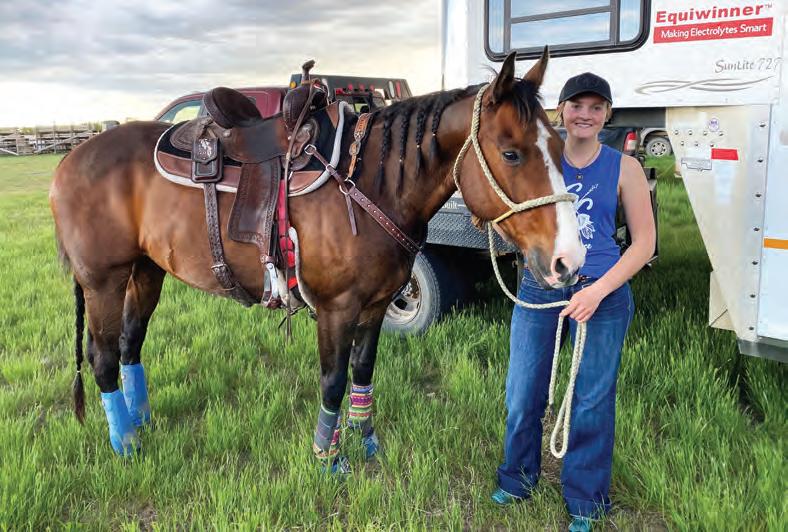
• Exercise-induced pulmonary hemorrhage
• Tying-up
• Non-sweating
• Headshaking
• Hydration
• Skin and coat
• Freedom from flies
• Performance
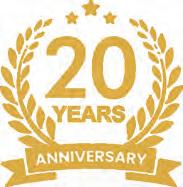
If you have a fly magnet in the barn or a horse that always wants to be rescued from flies in the paddock, try Equiwinner™ now and enjoy a healthier and happier summer with your horse. Or, if your competition horse no longer pays attention to you when trying to get rid of troublesome and annoying flies, Equiwinner™ can give him freedom from flies and restore his focus to perform. b
To learn more about electrolytes and their effect on horse health and performance, visit > www.signal-health.com or call toll-free > 1-877-378-4946.

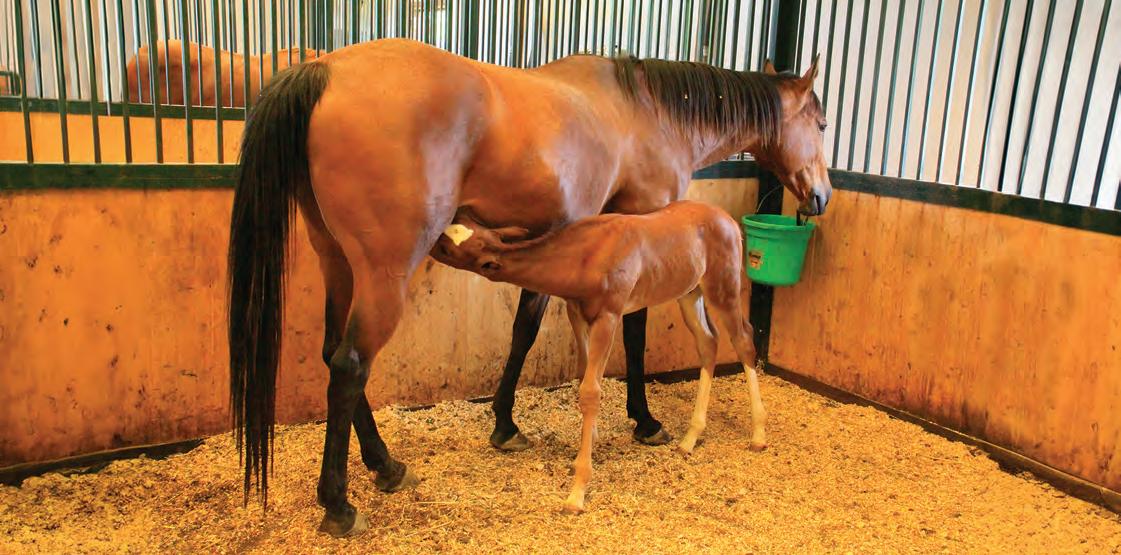
When it comes to stimulating broodmares to cycle early using artificial lighting, which is more effective — overhead lights or light masks? And why do they work?
In many breeds, all horses are assigned a birthdate of January 1, regardless of when they were born. This means late-born foals can be at a disadvantage in competitions and yearling sales. To counter this, many breeders aim to have their mares foal as early in the year as possible.
Horses are long-day breeders, meaning they naturally begin cycling when daylight hours increase. Left to natural conditions in the northern hemisphere, mares typically start cycling between late March and early April, with those farther north

beginning later than those closer to the equator. Research has shown that artificially extending a mare’s exposure to light can induce earlier cycling. However, mares do not begin cycling immediately — there is a delay of 60 to 75 days after light exposure begins. For a breeding season that starts on February 15, lights should be introduced no later than December 1.
Light exposure alone, however, is not the only factor affecting when mares begin cycling. Temperature and body condition also play significant roles. Mares in colder climates tend to start cycling later than those in warmer areas, and mares in poor body condition will cycle later than those in good condition. Research indicates that mares need 14.5 to 16 hours of light per day, with the additional light provided in the evening. Typically, this means keeping mares under lights in a barn until about 11 pm. Alternative lighting protocols exist but require more precise adjustments based on sunset timing or shorter periods of light exposure nine hours after nightfall.
So, which is better — overhead lights or light masks? The answer depends on your setup and needs.
Mares generally start cycling 60 to 75 days after receiving sufficient light exposure, though factors such as temperature and body condition can influence this timing.
• Mares must be kept in stalls or a designated pen for extended periods.
• Additional labour is required for turnout, stall cleaning, and feeding.
• Increased bedding usage and waste disposal costs.
• Higher electricity costs.
• Outdoor catch pens with lights require sufficient light intensity and must account for temperature extremes that could delay cycling.
)
• Higher initial cost and annual replacement costs.
• Mares remain on turnout, reducing labour and stall maintenance.
• Weather conditions can impact effectiveness and mask durability. Both methods are effective. Choosing the best option depends on factors such as the number of mares you need to cycle early, your facilities, labour availability, and local climate conditions. Evaluating costs and logistics will help determine which system suits your breeding program best.
Thanks to Dr. Peter Sheerin, reproductive expert at Rood and Riddle Equine Hospital, and The Paulick Report, for this information.
A British study examining the effects of different feeding strategies on pregnant mares and their foals suggests that a ration balancer may enhance colostrum quality and improve passive immunity transfer.
Colostrum, a mare’s first milk, is essential for a newborn foal’s health, providing both vital nutrients and immune system support. Broodmare managers and veterinarians strive to ensure foals receive the highest quality colostrum possible. Previous research in livestock species has shown that supplementing specific vitamins and minerals can improve colostrum composition. Could the same hold true for horses?
A study by scientists in the United Kingdom and published in the Journal of Equine Veterinary Science explored this question. Researchers from the University of Cambridge and the University of Liverpool analyzed two groups of pregnant mares on a single breeding farm. Before foaling, all mares followed a forage-based diet. In late pregnancy, one group received a custom grain mix formulated on the farm based on body condition, while the other group was supplemented with a commercial ration balancer.
Ration balancers are designed for horses that maintain body condition well on forage and do not require the extra calories of a commercial grain mix. These balancers provide essential vitamins, minerals, and amino acids, ensuring horses receive balanced nutrition even when consuming less than the recommended amount of a commercial grain mix.
The peer-reviewed study found that mares receiving the ration balancer produced colostrum of higher quality, as measured using an optical sugar refractometer, compared to those fed the grain mix. Additionally, foals born to mares supplemented with the ration balancer had a significantly lower incidence of failure of passive transfer (FPT) a condition where foals do not absorb enough immunoglobulin G (IgG) antibodies from colostrum, which is crucial for immune protection in early life.
While the findings are promising, researchers acknowledged several limitations:
• Mares were fed free choice from shared feeders, making individual intake difficult to measure.
• Group assignments were based on field placement rather than random selection, as entire fields were fed together.
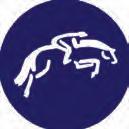
• Because the grain mix was custom-made in batches on the farm, nutrient levels could not be precisely compared to those in the ration balancer.
Despite these challenges, the study provides valuable insights into the potential benefits of ration balancers for broodmares. For more details, read the full study in the Journal of Equine Veterinary Science. b
Thanks to The Paulick Report for this information.
LEETO Z was an exceptional stallion: beautiful, correct conformation, powerful and elegant movement, combined with incredible scope made him an all-around exceptional athlete. Intelligent, engaging personality, brave and willing partner, and a quick learner. His foals all seem to have his temperament. Leeto Z’s elegant, modern type, tremendous work ethic and even temperament are passed on to his progeny.
FROZEN SEMEN FEE: $1500 (includes $250 booking fee) LFG
NIGHT’S WATCH is an exciting, fully-approved Canadian Warmblood stallion. His pedigree is filled with top level show jumpers like Voltaire, Furioso, Nimmerdor, Gotthard, Farn, and Le Mexico, who are all great progenitors of modern jumper breeding. Sire Kannan was noted for his style, balance, temperament and good mouth. On his dam’s side is Cantos, a reknowned Contender son, and Indorado, well-known for producing big, long lined horses with an unlimited amount of scope.
STUD FEE: $1500 (includes $250 booking fee) LFG
DARCONIDO Z is a big, fancy, young stallion with incredible suspension and tremendous power. Brave and scopey through the chute, with an incredible working attitude. His pedigree boasts Darco, the stallion who has the most offspring in the world to have competed to Grand Prix level, and Contender who has dominated German breeding values for many years now and continues to produce exciting young jumpers.
STUD FEE: $1250
(includes $250 booking fee) LFG
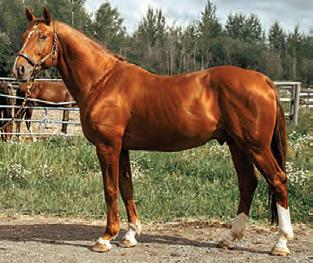

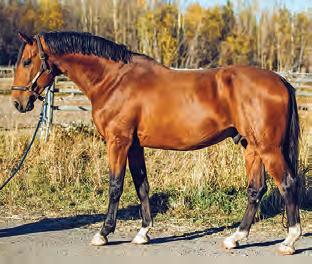


While equine herpesvirus (EHV) is typically associated with respiratory illness in young equine athletes, it can also have devastating consequences for breeding operations. As foaling season approaches, it’s important for horse owners to understand the risks EHV poses to broodmares. Dr. Tracey Chenier, an associate professor of theriogenology at the Ontario Veterinary College, provides insights on the prevalence of the virus and strategies breeders can use to protect their mares.
According to Dr. Chenier, research indicates that 50 to 80 percent or more of horses carry antibodies to EHV, meaning they’ve been exposed to the virus at some point, even if they didn’t show symptoms. While
many people associate EHV with respiratory illness, which can easily spread through showgrounds or racing barns, the virus can also lead to abortions in pregnant mares. Initially, EHV infects the respiratory system but can then move to the lymphatic system, spreading throughout the body and posing a serious risk to a pregnancy.
The virus is often discussed in the context of respiratory illness spread through nasal secretions. However, Dr. Chenier emphasizes that if EHV causes an abortion, the tissues and fluids from the mare and aborted fetus are “absolutely full of the virus,” and must be treated as biohazards, especially if there are other pregnant mares on the farm.
The last major analysis of reproductive performance in South African Thoroughbreds was published in 1999, reporting a live foaling rate of 62 percent. To update these figures, researchers in South Africa recently reviewed the age and foaling rates of barren and maiden mares from 2018 and 2019. These mares were part of Southern Africa’s Stud Health Scheme (SHS), which conducts annual testing for bacterial venereal diseases in mares prior to breeding.
In total, 990 mares were tested in 2018, and another 1,130 mares were tested in 2019. The majority of maiden mares were young, aged five years or younger, while most barren mares were older, with 79 percent falling between the ages of six and 15. “Failure to conceive” was the most common reason for mares being classified as barren. The foaling rates for both maiden and barren mares were 68.1 percent in 2018 and 63 percent in 2019, aligning closely with the 1999 figures.
The study’s key findings emphasized mare age over the number of previous live foals as the primary factor in foaling success. Mares aged
Because many horses infected with EHV don’t show symptoms while shedding the virus, it’s impossible to know for sure if a mare is a carrier, posing a threat to others. Silent carriers of the virus may shed it intermittently, triggered by various stressors including physical, environmental, mental, or social factors.
“Remember that in the case of herpesvirus, the infection’s taking place weeks or even months before the abortion,” Dr. Chenier explains. “The abortion’s just the later result of that infection. Other than good biosecurity following an abortion to reduce the risk for other mares on the farm, there’s not really a treatment, per se.”
Dr. Chenier also notes that vaccinating for EHV during an outbreak is a controversial topic. However, in some cases, it may be advisable depending on the mare’s most recent vaccination history. Information provided by Paulick Report.
10 years or younger had the highest foaling rates, ranging from 68.9 percent to 71.9 percent. However, as mares aged, their foaling rates dropped significantly, with mares aged 16 years or older showing a 54.7 percent rate in 2018 and just 45.7 percent in 2019.
Mares aged 10 years or younger were nearly three times more likely to produce a live foal than mares aged 16 years or older, explained Kathleen Crandell, Ph.D., of Kentucky Equine Research. “Advancing age is a wellknown predictor of reproductive performance, and studies show that advancing age negatively influences the condition of the endometrium, the lining of the uterus.”
Although age cannot be reversed, there are ways to help support the reproductive health of older mares. “Supplementing mares with long-chain polyunsaturated omega-3 fatty acids DHA and EPA has reproductive benefits such as improved fertility, particularly in older mares,” Crandell added.
Reported in Journal of the South African Veterinary Association
Information provided by Kentucky Equine Research.
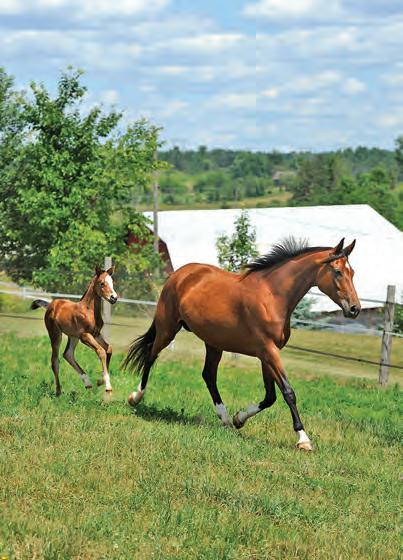
By Mark Andrews
The overreliance on plastic materials in all areas of modern life, including veterinary practice, poses a significant environmental challenge due to the pollution it generates.
Artificial insemination, a common technique in equine breeding programs, is a good example of the widespread nature of plastics in veterinary work. The procedure typically relies on disposable plastic items, such as insemination catheters and semen straws, which are essential for the collection, storage, and transfer of genetic material. However, their single-use nature contributes heavily to plastic waste.
As part of the search for sustainable solutions, Noelia González and colleagues conducted a study to explore sustainable alternatives to conventional plastic semen straws. The study evaluated various biodegradable materials, including bamboo, avocado, grass, paper, Kraft paper, wheat, and rice, focusing on their suitability for preserving refrigerated, extended equine semen.
Among the materials tested, bamboo and avocado emerged as the most promising options. Bamboo displayed strong structural integrity, making it a durable and reliable container. However, avocado-based straws were particularly effective in maintaining sperm quality parameters, such as motility and movement kinetics, without introducing contaminants.
The research team conducted detailed assessments of the straws’ structural integrity and their ability to preserve semen quality after 24 and 96 hours of refrigeration. Both bamboo and avocado straws performed within acceptable ranges, but avocado straws yielded superior results. Additionally, microbiological control tests confirmed the absence of bacterial growth in both straw types, further supporting their potential as safe alternatives to plastic.
The findings suggest that avocadobased straws could serve as a viable alternative to plastic straws in artificial insemination procedures, offering an environmentally friendly solution without compromising the success of reproductive practices.
Reported in Animals. Printed with the kind permission of Equine Science Update.
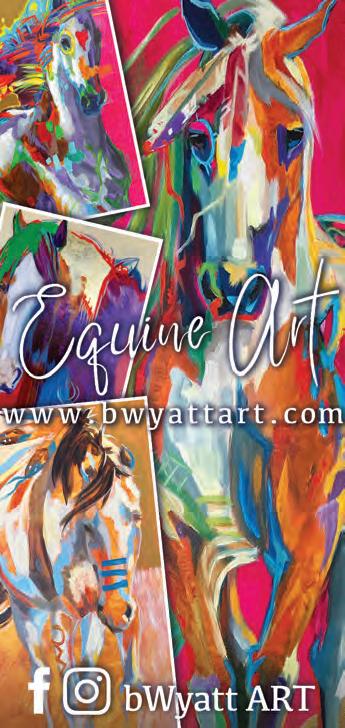
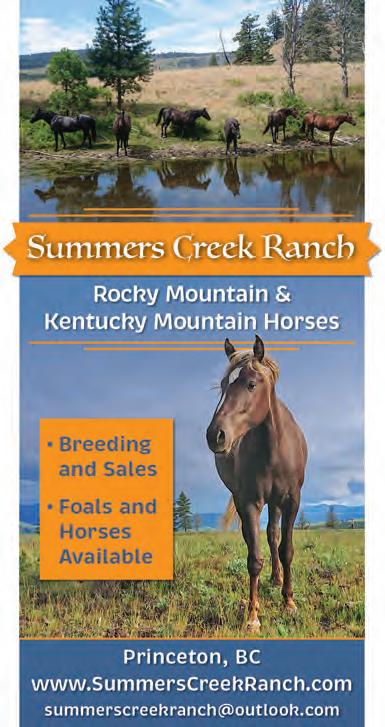
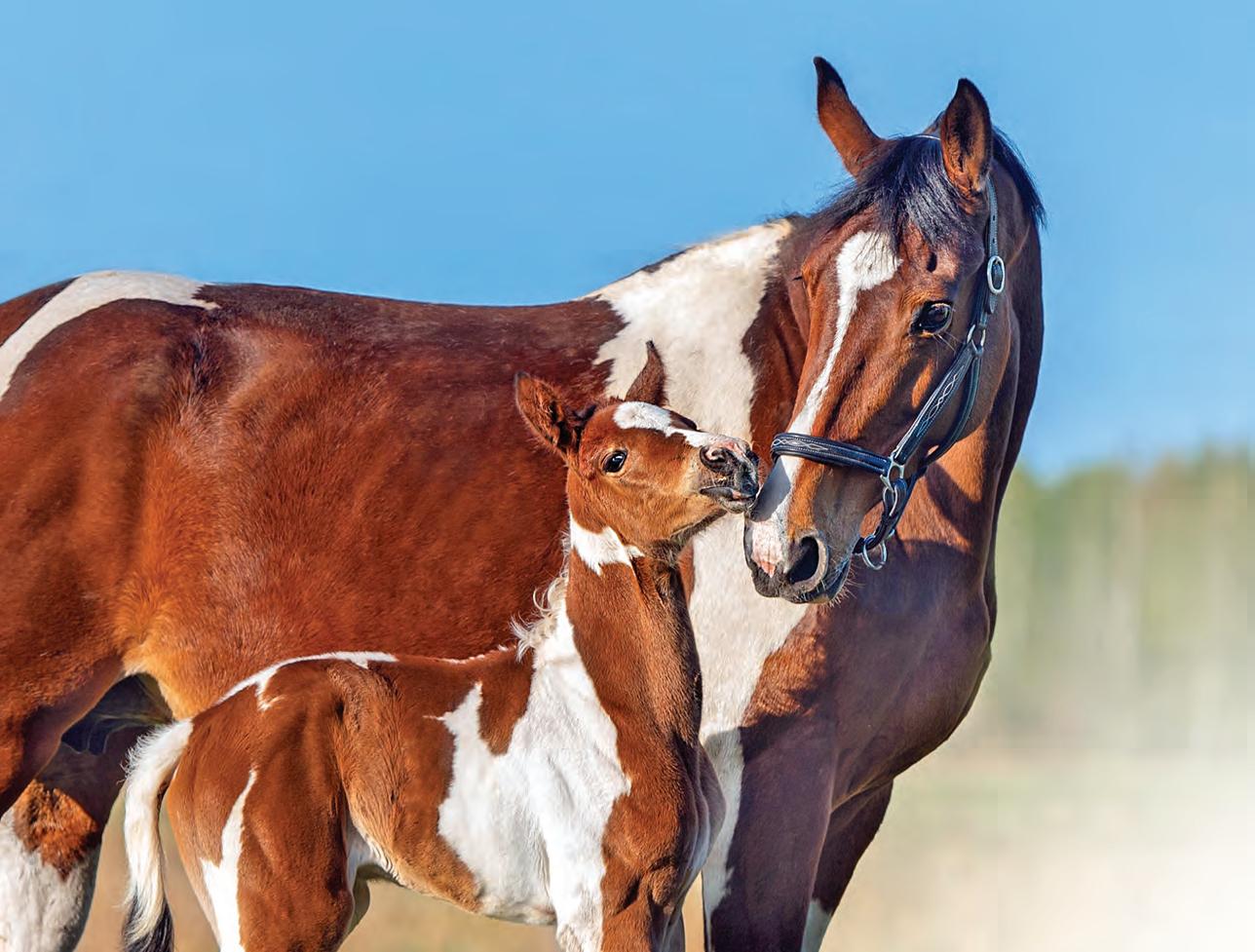



Equine Guelph Research
If your breeding prospect remains empty heading into fall, there are key factors to evaluate and steps you can take to improve the chances of success the following year.
“Don’t let those mares sit all fall and winter, with untreated conditions such as a uterine infection,” says Dr. Tracey Chenier, theriogenologist and researcher from the Ontario Veterinary College at the University of Guelph. “Have a thorough veterinary evaluation to help ensure her uterus is clean and she is healthy and cycling early next year, for the best chance of a positive outcome.”
“The number one reason your mare didn’t get pregnant in any given year may be due to uterine infection,” says Chenier. “The term we use is endometritis.” Most often caused by a bacterial infection, it is frequently associated with poor perineal conformation. In other words, your mare has a tilt to her vulva causing the vagina and uterus to become contaminated with bacteria every time she defecates. It is also common for these mares to wind-suck, which can lead to infection and inflammation that results in a hostile environment
the embryo cannot survive in. A minor surgical procedure known as a Caslick’s suture reduces the chance of contamination in most affected mares. Severely affected mares may require additional procedures to reconstruct the perineal body.
Another common form of endometritis is persistent breeding-induced endometritis (PBIE). In these cases, there is a prolonged inflammatory response to semen and contamination that occurs at breeding; the mare has a hostile uterine environment in which the embryo cannot survive. To improve the chance of conception, this condition can be managed by ultrasound within six to twelve hours after breeding. She is checked for fluid retention and inflammation and if present, the uterus is lavaged (washed) to remove the fluid and calm the inflammation. The veterinarian may also recommend administration of oxytocin to increase uterine contractions and help remove the fluid.
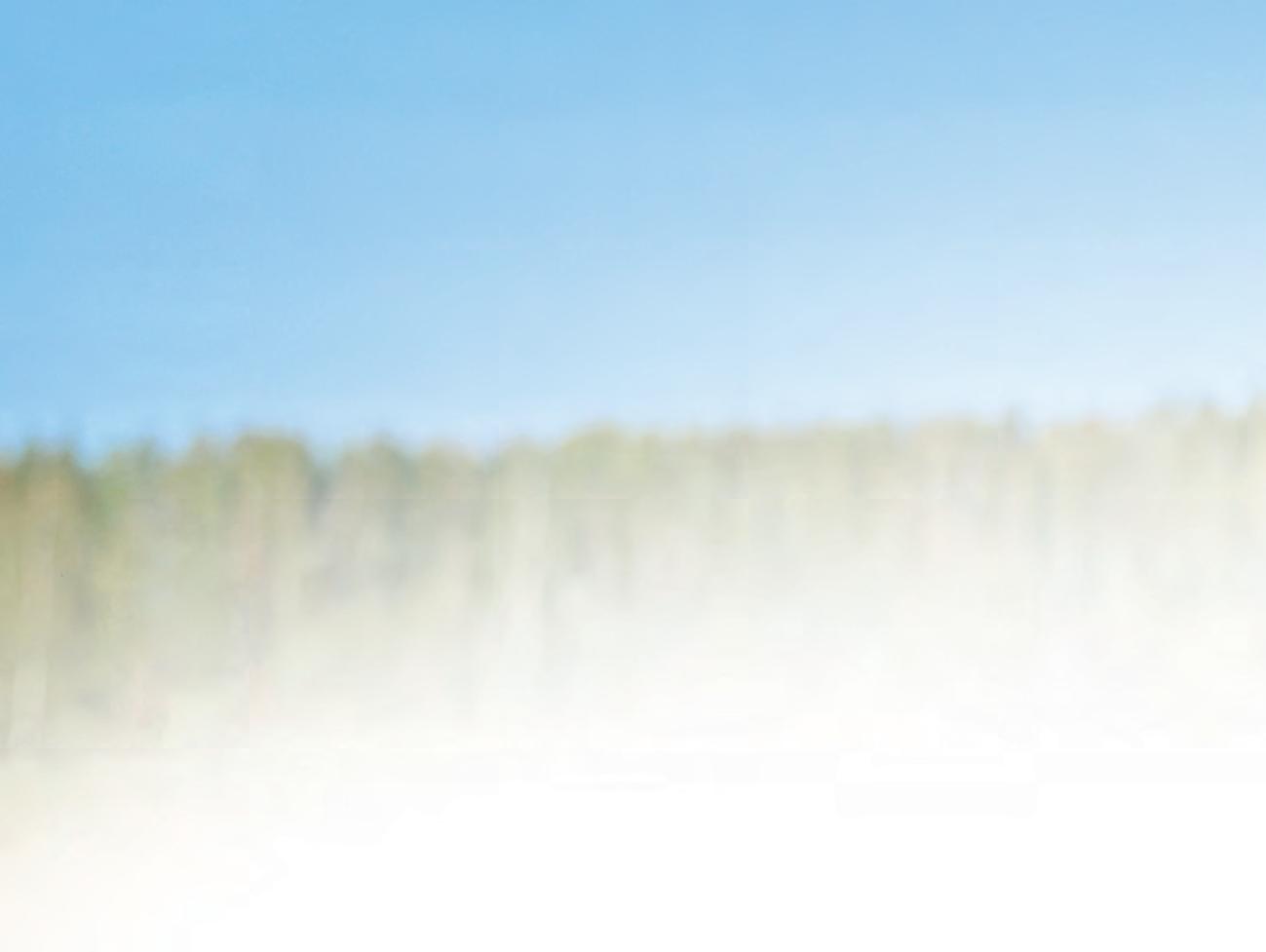
Another very common reason for the mare not becoming pregnant is her age.
“We actually consider mares’ fertility to decline as early as 12 years of age,” says Chenier. It surprises people that mares’ fertility can decline significantly by age 12, she says. An older mare can have poorer oocyte (egg) quality, which reduces her chances of getting pregnant and can result in higher rates of midgestational losses.
Older mares are more susceptible to many circumstances including uterine conditions, metabolic disease, changes to the uterus, fibrosis, and cysts. Fibrosis of the uterus will reduce the chances of carrying a pregnancy to term.
Endometrial cysts or fluid-filled sacs in the lymphatics of the uterus can block the ability of the embryo to move around and interfere with formation of the placenta.
“Stress, nutritional issues, and hormone deficiencies can make it difficult for an embryo to survive,” explains Chenier, “but these issues are generally less common.”
The corpus luteum is the structure that forms on the ovary after the mare ovulates and its progesterone production maintains the pregnancy early on. This structure may be susceptible to effects of severe stress, illness, or inflammation in


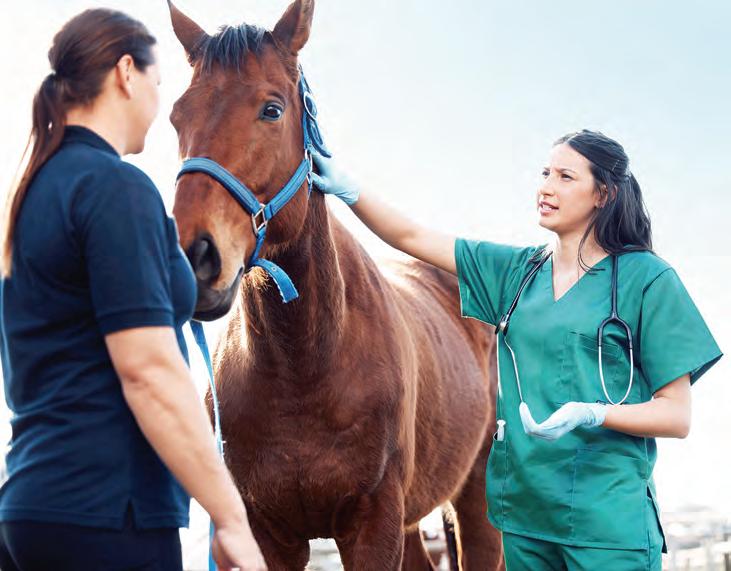

> Consult your veterinarian or equine nutritionist to ensure your mare’s nutritional needs are met during pregnancy.
A thorough veterinary evaluation can identify health issues and untreated conditions so they can be resolved before breeding season begins.


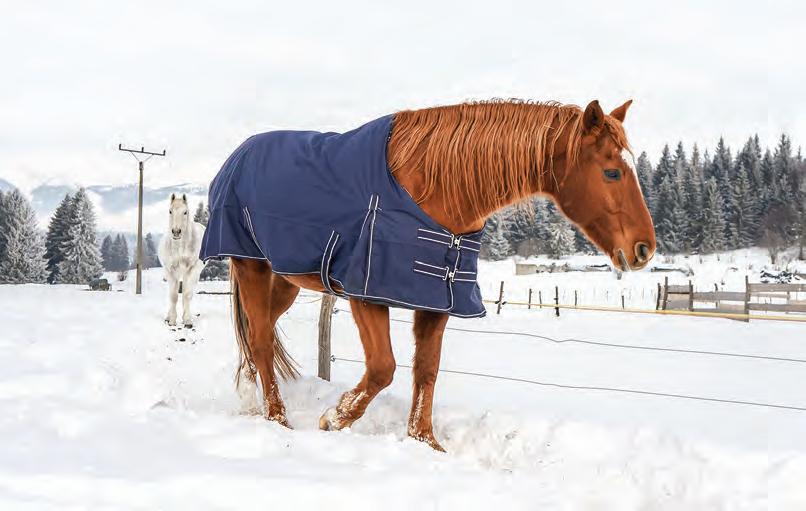
Mares do not cycle during winter. Dr. Chenier believes it’s helpful to expose the mare to the cold and darkness of fall to reset her system before starting her under lights for earlier breeding the following year.
In the Thoroughbred industry where all horses share one official birth date of January 1, foals born earlier in the year have an advantage. Starting these mares under lights at the start of December helps them begin cycling earlier in the breeding season for a foal to be born January to March of the following year.
PHOTO: ISTOCK/LUBO IVANKO
the uterus. Progesterone/altrenogest supplementation can often save these early pregnancies but the mare will have to stay on the supplements until the fetoplacental unit takes over pregnancy maintenance by 120 days. The fetoplacental unit is a crucial interface between maternal and fetal circulatory systems, providing essential nutrients and oxygen to support fetal growth and development.
Early pregnancy loss can happen from day zero to day 60 of gestation. To help avoid risk factors like excessive stress, ask your vet before changing or adding anything to your mare’s routine. Consult your vet before administering any vaccines or deworming products.
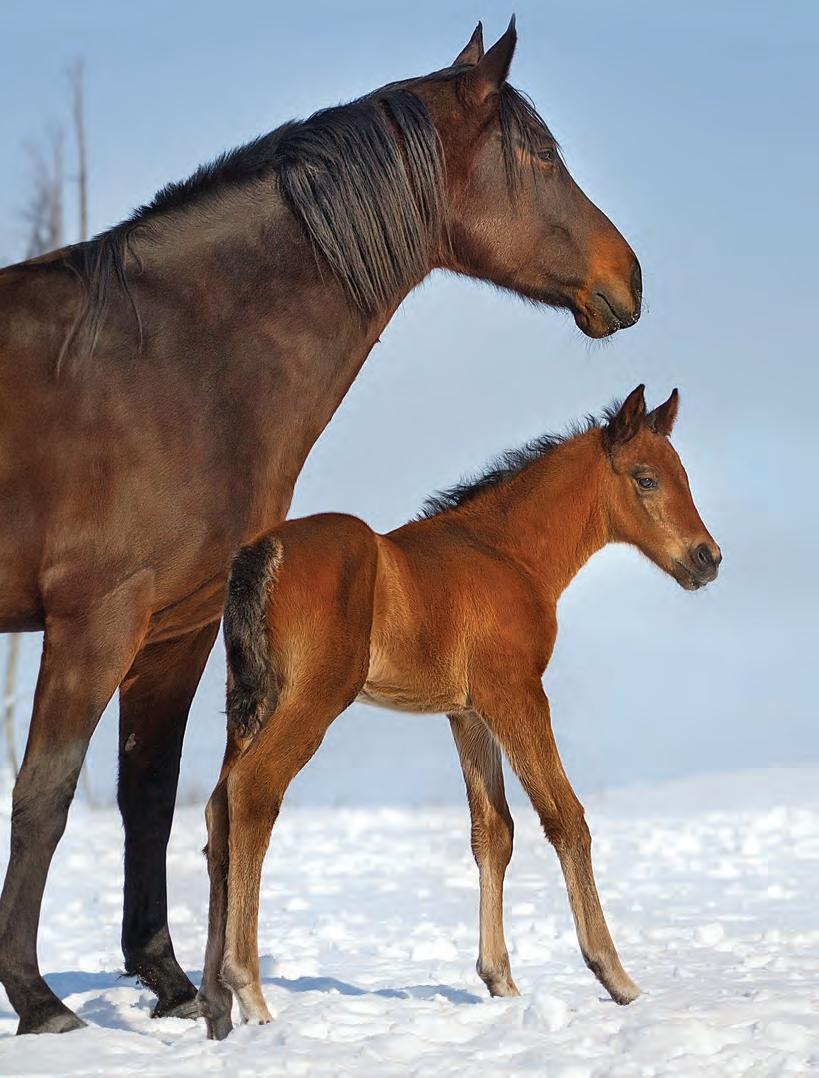

PHOTO: ISTOCK/CALLIPSO
“Oviductal blockage is another uncommon condition,” says Chenier, “but in mares that are not conceiving and everything else is normal (e.g., no uterine infection, good stallion fertility) it should be considered.” An effective treatment the veterinarian may suggest involves applying the hormone prostaglandin E to the oviductal papillae, which opens the oviduct and allows that blockage to be cleared out.
“A good reproductive evaluation is really important to find out the reasons why a mare either didn’t get pregnant or lost a pregnancy,” says Chenier.
Veterinarians use rectal palpation, especially with ultrasound, to help detect fluid and infection. Palpation with ultrasound can detect the presence of endometrial cysts and conditions on the ovary such as failure to ovulate and ovulatory follicles.
Cultures, gained from swabs of the uterus, are performed to detect inflammation and infection. This is helpful in cases where antibiotic use is required to determine what type of antibiotic to use.
Uterine biopsy is indicated in certain cases. “I recommend a biopsy in any mare that fails to get pregnant after three attempts, especially if we are not getting good answers on a swab culture and ultrasound,” says Chenier. As well as providing a prognosis, it provides a lot of information on treatment options to improve the mare’s fertility.
A biopsy can help provide better information about what’s going on in the uterus and in the case of inflammation, identify the type of inflammation present. Chronic infections are more likely to be caused by something like a dormant strep infection, and biopsy may be the only way to diagnose the fibrosis of the


uterus that would be directly related to prognosis. If you learn your mare’s uterine biopsy was a Grade 3, meaning she has a lot of permanent severe changes in her uterus, her likelihood of carrying a foal to term is between zero and 10 percent. This is really important information to help the breeder decide whether to invest the time and money to attempt to breed a mare with a prognosis revealing these challenges.
Ultrasound is useful in identifying conditions such as endometrial cysts. Cysts can be removed by putting an endoscope in the uterus and then using either laser or electrocautery to a blade to improve a mare’s chances of pregnancy. Electrocautery involves using a heated electrode to cut or coagulate tissue during surgery. When applied to a blade, it allows for precise cutting with minimal bleeding. “In really rare cases where all else has been ruled out, a karyotype might be considered,” says Chenier. Karyotyping involves staining chromosomes and examining them to identify structural changes or numerical abnormalities.
“If it’s a young maiden and everything else seems to be working, there may be a genetic reason that she’s not able to get pregnant, but that would be the exception.”
The all-important veterinary evaluation will check the mare’s general health, body condition, and uterine health as well as rule out metabolic diseases like insulin resistance and pars pituitary intermedia dysfunction (PPID), also known as Cushing’s disease.
One must ensure the broodmare’s nutritional needs are met. Calories, protein, vitamins, and minerals are all passed on to the foal while in utero. Consult your veterinarian or an equine nutritionist to ensure your mare gets a balanced diet and to learn how her nutritional needs increase during pregnancy.
Use of light to manipulate the season is a consideration if you want to breed your mare early in the season for a foal to be born January to March.
Mares stop cycling during the winter. “I think it’s helpful to expose the mare to the cold and the darkness of the fall to reset her system before you start her under lights,” says Chenier. She recommends lighting programs begin around December 1st with what amounts to 10-foot candles, which is equivalent to 100 lux intensity of light. In old style lighting with incandescent bulbs that was the 100-watt bulb, and the old saying was you needed to be able to read a newspaper in every corner of the stall. Sixteen hours of total light per day is recommended, and this includes natural light. From a practical point of view, that means if you turn your mare out at 8:00 a.m., bring her in at 4 p.m., and have the lights on in the stall until 12:00 a.m. (midnight), you will be providing an adequate amount of light. Chenier also describes the use of a commercially available equine light mask that is worn 24/7, like a fly mask. It is battery powered and delivers blue light to one eye on a timed basis.
“Good breeding management is always key,” emphasizes Chenier. “Negative uterine swabs before breeding
ensure the mare is free of infection. Limit to one cover in mares prone to infection or inflammation, correct poor perineal conformation, and then practice optimal timing.”
Not breeding at the right time is much less likely in the Thoroughbred industry, where mares are bred by natural cover. If the mare is not in heat and not ready to ovulate, she is not likely to stand for the stallion. If a mare is bred too early, the sperm will not live long enough. Mares can stay in heat a day or two after they have ovulated. If breeding happens too late (after ovulation), the oocytes will no longer be viable.
If the chosen stallion has fertility issues, the breeder may need to closely monitor their mare’s ovulation for the most optimal timing of breeding to improve odds of success. Chenier says, “If the sperm doesn’t live very long inside the mare, we have to manage those cases differently and make sure we’re breeding those mares really close to ovulation to get good fertility for those stallions.”
Stallion fertility should always be considered a possibility when mares are not conceiving. If breeding early in the season, one needs to make sure the mare is cycling properly and not just in spring transition. A vet check will confirm the mare is experiencing a true heat and ovulating for early breeding (February to April). b
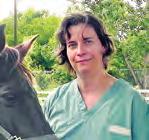
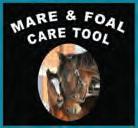
Equine Guelph’s Mare and Foal Healthcare tool provides many resources such as free broodmare and foal nutrition information sheets, handy checklists, and a pregnancy wheel to see how the foal develops in real time. It also offers a selection of videos featuring Dr. Chenier on predicting and monitoring foaling.
Visit > www.thehorseportal.ca HealthCare Tools > Mare & Foal Care Dr. Tracey Chenier is an Associate Professor of Theriogenology at the Ontario Veterinary College, University of Guelph. Her research interests are in the field of equine reproduction. Current research areas include causes of abortion in mares and persistent-breeding induced endometritis.
Published with the kind permission of Equine Guelph.














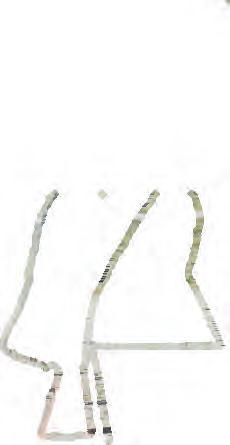
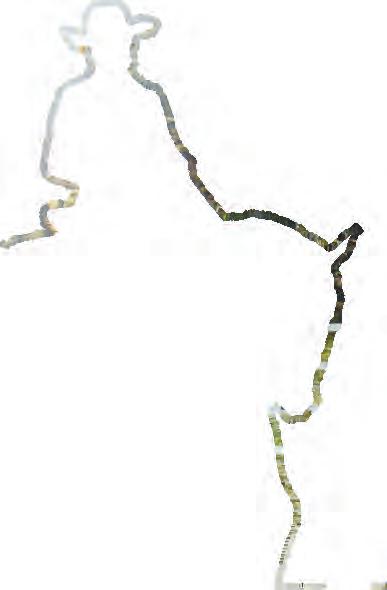
Exploring why and how to make the switch from snaffle to leverage bit, and the language of neck reining.
By Lindsay Grice, Equestrian Canada coach and judge
Do you think I should I try a different bit? This question is familiar to me as a coach, launching me and the rider I’m working with into a bigger conversation. My answer will be shaped by the reasons why the rider is considering another bit option.
Simply put, a bit is a tool to communicate a message from a rider’s hand to a
horse’s mouth. When a rider hits a training impasse she may wonder: Could more bit get my message across more clearly?
Another bit option might involve staying within the snaffle family of bits or transitioning to the curb class of bits.
The difference? Snaffle bits communicate with direct pressure, applied by the rider’s hands through the rein to the bit. The
rein is attached to the bit’s mouthpiece, so the horse feels an equal amount of the contact taken by his rider.
A curb bit uses the leverage principle to magnify the rider’s contact. More on basic curb bit function later.
Variations within both classes of bits are endless, with new varieties making their debut even now at a tack store near you. While technicalities of bit mechanics are a topic for another article, you can refine your choice by understanding the general principles of bitting or how the parts of the bit affect the individual structures of your horse’s mouth and head.
Within the general categories of snaffles and curbs, the answer to the question: Should I switch from a nonleverage to a leverage bit? depends on the
reason. Answers may include:
1 A search for more effective communication. To motivate your horse to respond more promptly to your rein aids; curb bits literally leverage your rein signals.
2 As the next step in your horse’s education. Training in a curb bit is like learning to use a new tool; neck reining is learning a second language.
Let’s unpack each of these reasons why you may opt to switch to a new tool, and then some tips on how to transition smoothly. Finally, I’ll share advice for speaking fluently using that tool.
Dialing up their horse’s motivation prompts many riders to try the leverage route. The action of a curb bit enables a rider to use more subtle rein aids and lighter contact than a snaffle. Because leverage action magnifies a rider’s hand, it takes less movement to achieve a lighter response. English leverage bits include pelhams, kimberwicks, and double bridles. The range of curb bit options for Western riders is infinite.
Is “more bit” the answer to a dull or resistant horse? Amplifying your signal to a horse with a missing link in their understanding is like a local shouting to get their message across to a tourist who doesn’t know their language. Louder isn’t clearer; it’s just scarier. Regardless of the bit, our ultimate goal is to use our inside voice — the lightest of pressures.
Riding effectively can be distilled to a system of signals and responses — pressures and releases. Your hands telegraph signals to your horse, such as slow, turn, or flex, using several rein techniques. I regularly ask the riders I coach to describe what type of rein aid they’re using — direct, opening, or indirect.
As your horse responds correctly, you respond with release. If he offers the wrong answer, you keep the pressure steady or even increase it. It’s like a conversation with your horse. By trial and error, he learns that a certain response yields a consistent release. It’s worth considering that the “dull” or “busy-mouthed” horse has quite likely tried a few options to find relief from the bit pressure, yet none seem to shut it off. Before heading to the tack store for a different bit, ask yourself:
Before transitioning to a curb bit, does your horse understand bend, flex and leg-yield using the snaffle?

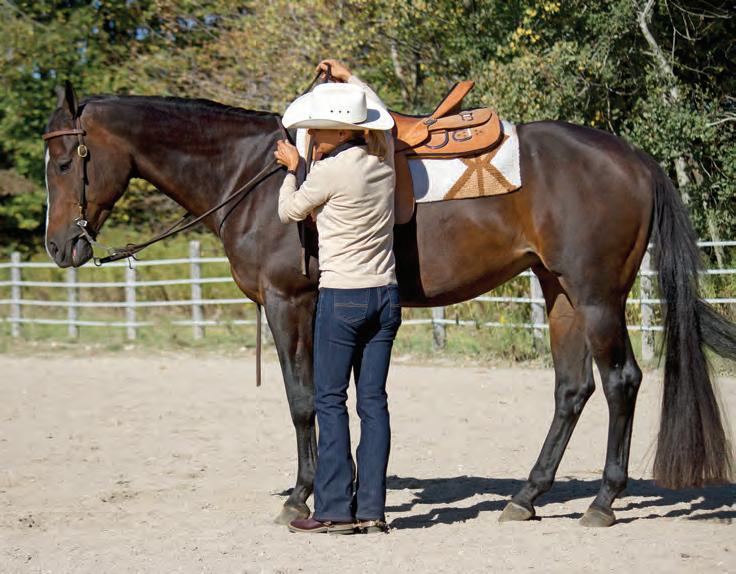
Introducing a curb bit’s action from the ground — flexing laterally.

• Does my horse completely grasp my system of rein signals?
• Am I delivering my message skillfully?
• Do I understand the mechanics of how this new bit works and on which parts of the horse’s mouth?
If the answer to these questions is yes, only then explore a different choice of bit.
Curb Bits as Next-Level Education
Most breed associations require Western
horses to be exhibited single-handed in a curb bit, starting in their sixth year. In novice level classes, riding with two hands and a snaffle bit remains optional.
Most Western horses and riders I work with make the transition from snaffle to curb when they’re ready to compete in pattern classes such as horsemanship, ranch riding, or trail patterns, in which they’ll need more “handle” — extra steering finesse for advanced maneuvres.
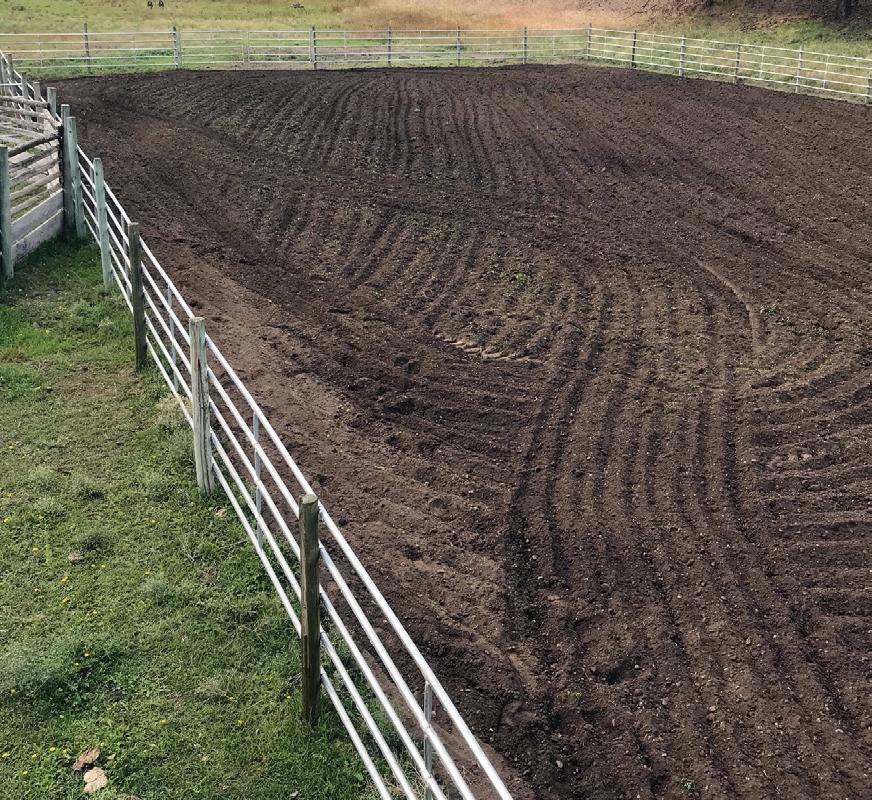
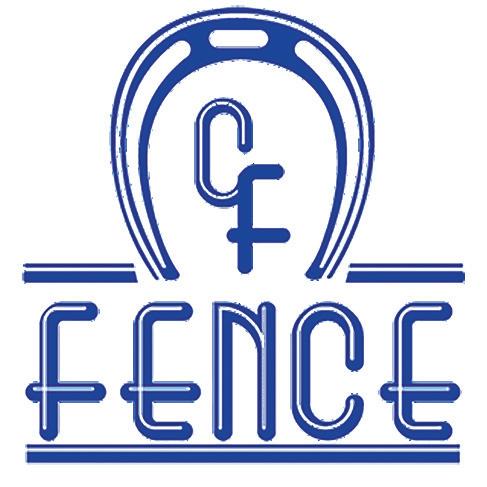
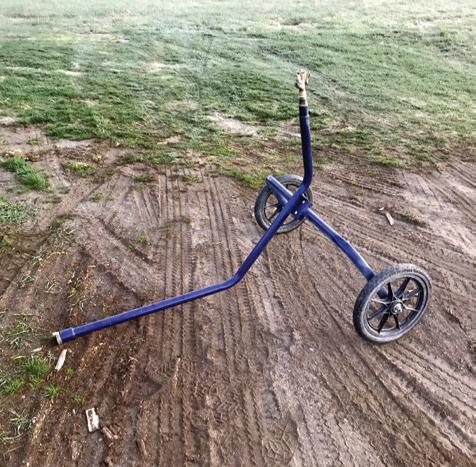
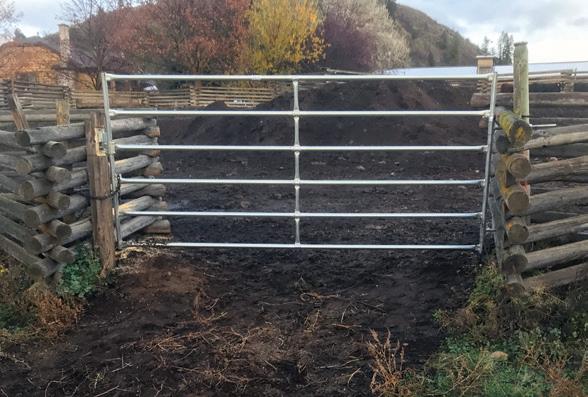
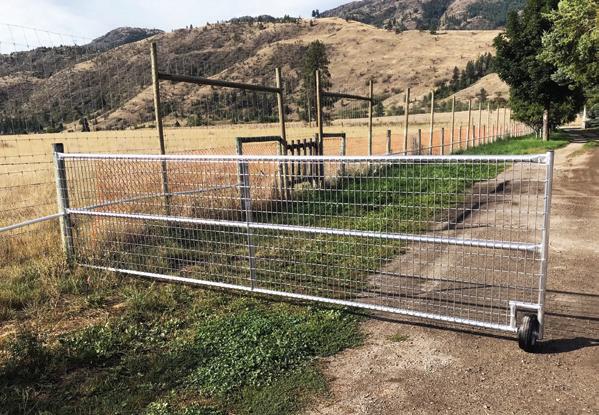
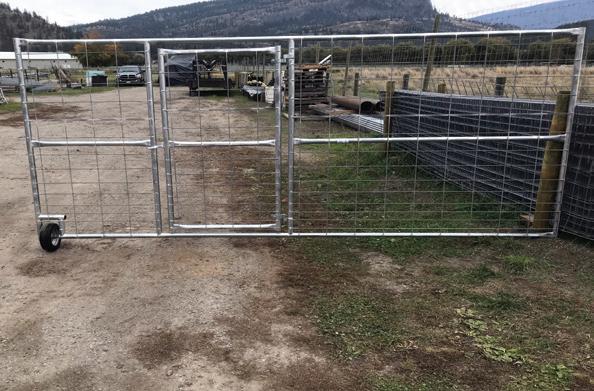
Using both reins I test the rein-back, softening the contact with her first step back. I’m patient if the horse is initially confused.
The class of leverage bits divides into categories and subcategories, each containing a host of patented variations. All are designed to apply pressure to the following regions of the horse’s mouth and head:
• Lips
• Bars
• Tongue
• Roof/palate
• Chin groove
• Poll
How does a curb bit function? A signal from your hand rotates the lower shank rearward and the upper shank forward, as far as the curb strap will allow. The more the upper shank shifts forward, the more pressure is directed to your horse’s poll.
The amount of leverage employed depends on where the mouthpiece is situated on the bit’s shank. If the ratio of shank below the mouthpiece is greater than above, there’s greater leverage.
The style and alignment of a bit’s shanks will also affect the leverage. The amount of tongue and bar pressure your horse experiences when the shanks rotate will vary with the design of the bit’s mouthpiece. A straighter mouthpiece provides less tongue release than a jointed or ported mouthpiece.
I introduce any new bit to a horse from the ground before climbing aboard. By asking my horse to flex his head from one side to the other and take some backward steps, I let him discover the answers to questions I’m asking with an unfamiliar bit action. Once he gets the hang of the new equipment, I follow the same routine from the saddle. I typically introduce the language of leverage with a flexible, double-jointed mouthpiece and short, swivel shanks. Because the oral cavity of each horse varies in size and shape, try a new bit for several days to observe how your horse responds. Admittedly, this can become an expensive process — most horse people I know accrue a fine collection of “experiments” at the bottom of their tack boxes.
Mastering the language neck reining is a high school credit in the education of a
Western horse, and a prerequisite for disciplines in which the rider uses their free hand to open a gate, drag a log, or rope a cow. However, many riders confess that teaching their horse to neck rein is a bit of a mystery.
As an English rider, when entering the Western world years ago I felt awkward riding with one hand. Like many, I’d train at home with two hands and hope that the stars would align when I entered the
Misinterpreting my neck rein signal, the horse turns toward the rein pressure instead of away from it.
show ring with one hand — a very bad plan. No surprise, to become fluent in a second language you’ve got to practice. French immersion students rise above their French-in-class-only friends by using the language every day, in every class. I advise the riders I coach to use one hand, however awkward they feel, whenever they ride with a curb bit. That’s what I did years ago and now I ride as well with one hand as with two.
With direct reining, your horse figured out that he could release bit pressure delivered to the corner of his mouth by turning towards it. Now he’ll learn to turn away from pressure on the side of his neck.
It takes MANY repetitions for a horse to make the connection — turn my neck away from the rein pressing on my neck and… the rein goes slack. At first, expect a communication gap. He’ll misinterpret that pressure on the side of his neck as an “indirect rein.” Counter-bending, he’ll likely tip his nose toward the pressure. What to do: Without interrupting that

SMALL: 6 1/2” x 5 7/8” x 1/16” LARGE: 8” x 7 1/2” x 1/8” TWO DEGREE: 6 1/2” x 5 7/8” x 5/16” TWO DEGREE LARGE: 8” x 8” x 5/16”




While maintaining neck rein pressure I correct the horse’s counter-bend using the familiar direct rein.
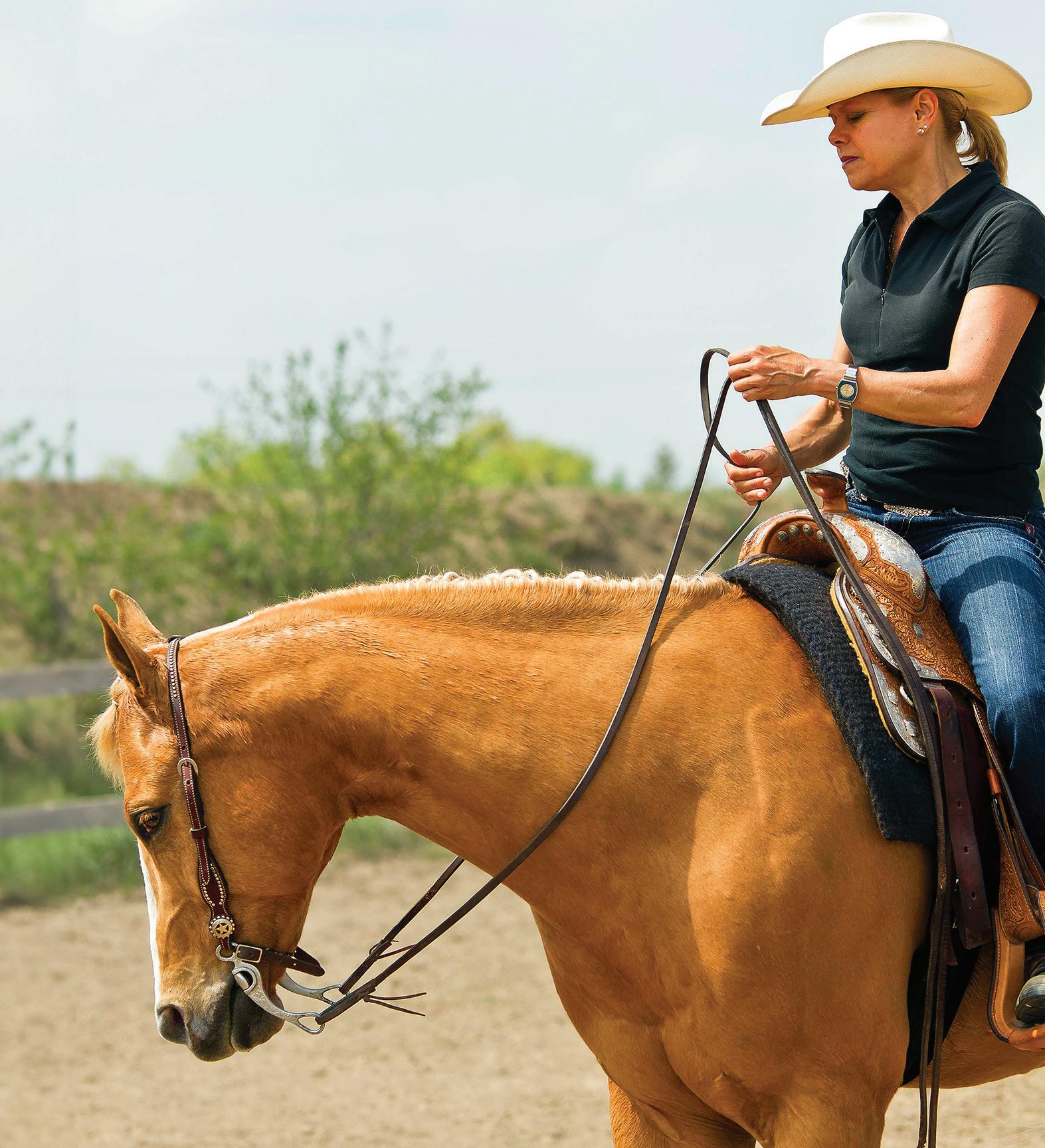
SMALL: 6” x 6 1/2” x 1/8” LARGE: 7 3/8” x 7 7/8” x 1/8” TWO DEGREE: 6” x 6 1/2” x 5/16”
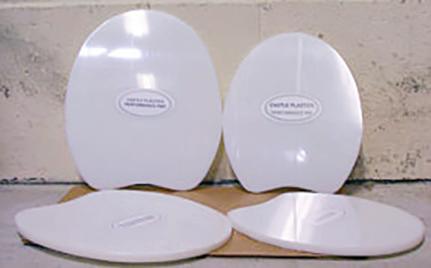
#4: 6 3/8” x 5 3/4” x 3/16” #5: 7 1/4” x 6 5/8” x 3/16” #4: 6 3/8” x 5 3/4” x 1/4” #5: 7 1/4” x 6 5/8” x 1/4”
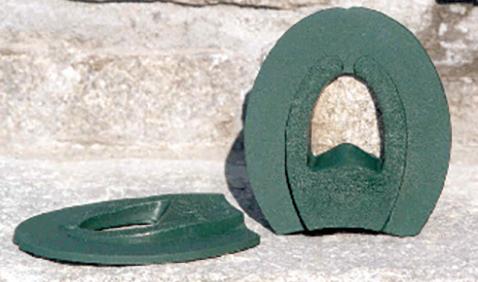

#8 IMPAK ABSORBER: 5 1/8”

An English leverage bit, the pelham bit can have a solid or a jointed mouthpiece and is used with four reins. It has elements of both a snaffle and a curb bit and can function as either depending on how it is used by a knowledgeable rider.
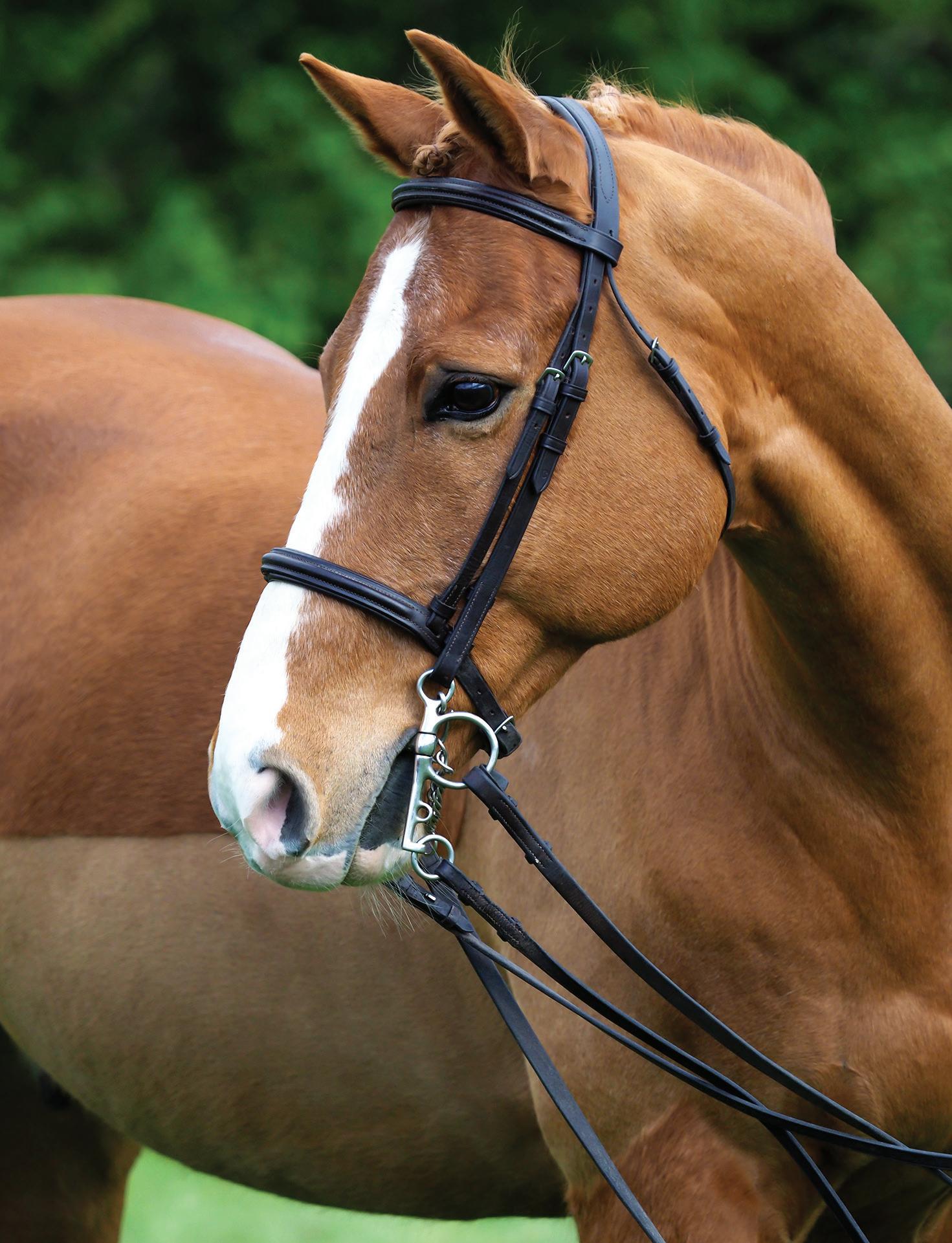
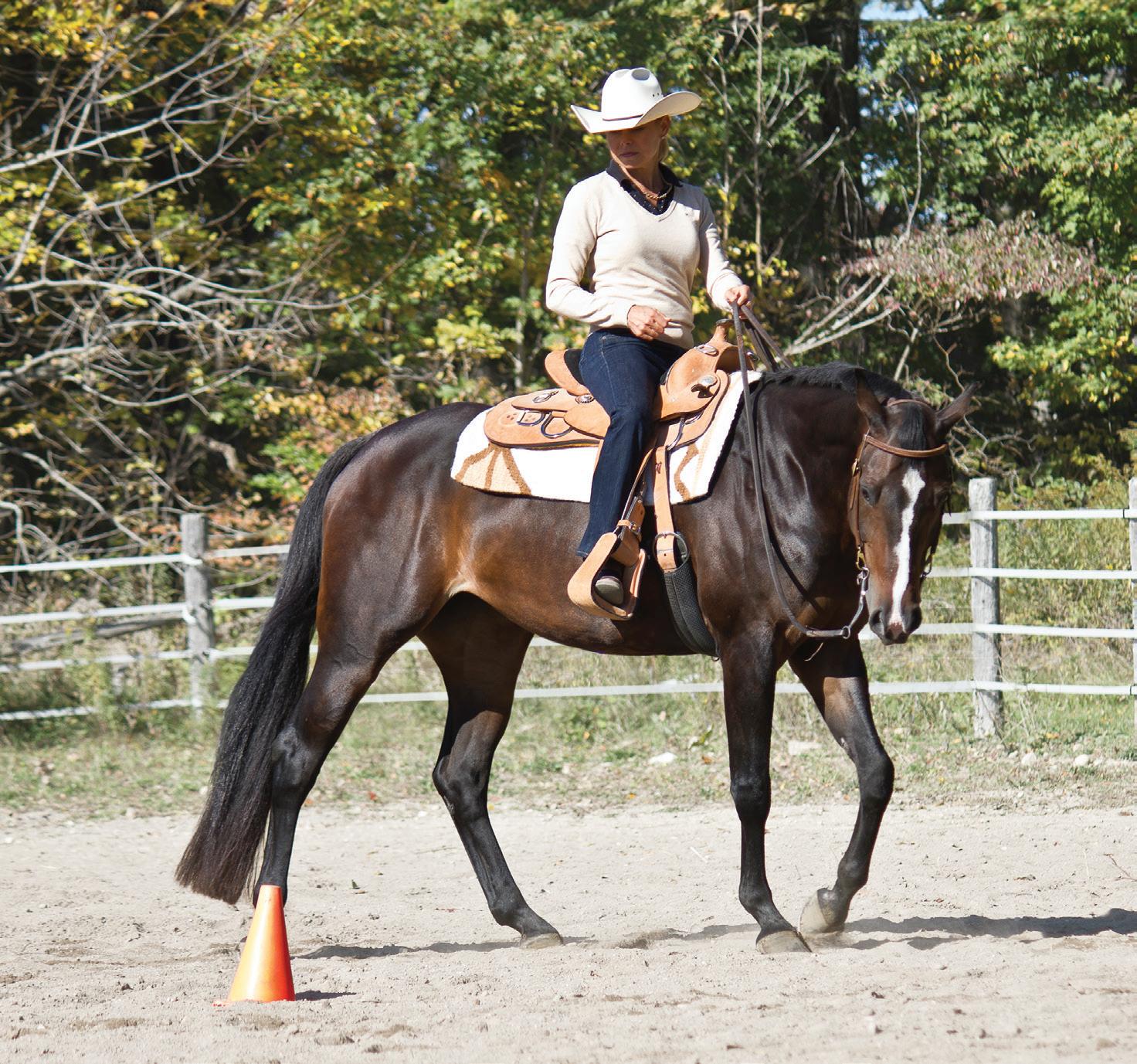
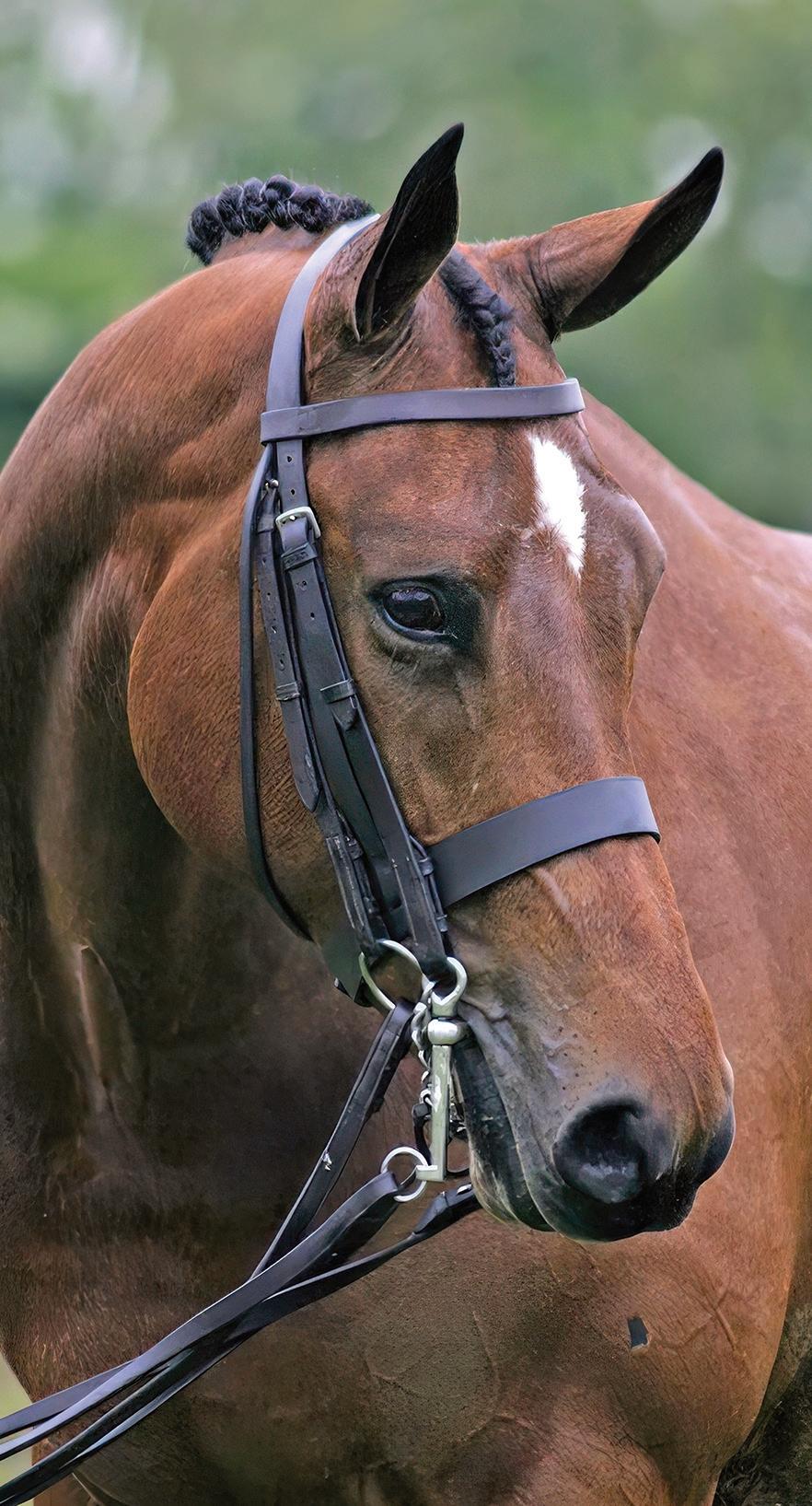
A common sight at higher levels of dressage and in certain show classes, the double bridle has two bits and four reins. One bit is a modified snaffle bit called a bradoon, which is smaller in diameter with smaller bit rings than a traditional snaffle and sits above and in front of the other bit, which is a curb bit called a Weymouth.
neck rein pressure, follow up with your free hand, using a direct rein correction to steer his head away from the neck rein. As soon as his nose tips into the helperrein and away from the neck rein, let both reins go slack.
STEP 1: Neck pressure.
STEP 2: Opposite direct helper-rein.
STEP 3: Slack.
If the three steps aren’t used independently, the lesson won’t click. Sooner or later, after methodical repetitions, your horse will connect the dots and Step 2 will be eliminated.
I do a lot of walking …and turning … and walking …and turning — utilizing breaks for neck reining in between other
Soft contact is the standard set in most equine association rule books. As a judge, I’m required to penalize lack of connection in equitation and some Western classes. For example, AQHA horsemanship rules specify: “Reins are adjusted for light contact with the horse’s mouth. At no time shall reins require more than slight hand movement to control the horse.”
Of course, rein contact varies across riding disciplines. Western riders operating with leverage bits will have more pronounced rein relaxation to allow shanks to return to neutral.
Neutral rein contact is an amount your horse doesn’t recognize as a signal. With a curb bit, it’s when the shanks hang in a neutral, balanced position and the curb strap is slack.
Overly firm contact is relentlessly holding the horse in place or in pace. Horses held with tight reins don’t develop self-carriage. When a horse’s correct response isn’t rewarded with release, he feels trapped with no option to escape the pressure. We owe it to our horses to provide a clear answer to the question: What behaviour will turn off the pressure?
work. Resist shortcutting the process by slipping your index finger down between the reins to tip your horse’s nose into the turn. Alas, like never removing training wheels, these horses never truly learn to neck rein if they’re aided by sneaky direct reining. Like any skill, master it at a walk and jog before stepping up to lope.
The hands at the other end of the bit play a crucial role in its effectiveness. An honest self-assessment is in order before transitioning to a leverage bit: How clearly can you communicate your signals with the snaffle? As confusing as language lessons taught by a teacher with a heavy accent, so are steering lessons communicated via noisy reins. If your arm is out of sync with the stride of your horse, or if your hand tends to be tense or acts abruptly when you’re distracted, hold off on introducing a leverage bit. b
> Lindsay Grice is a regular contributor to this magazine — read her bio on page 102.

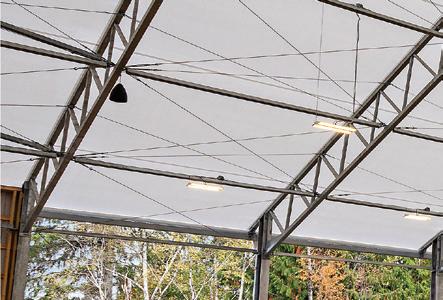

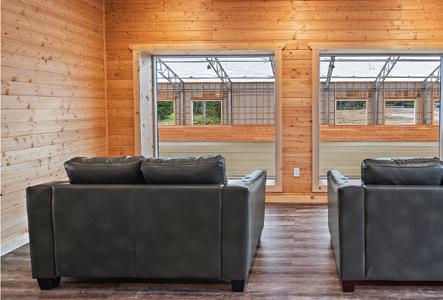






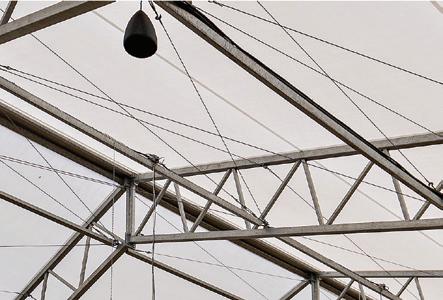
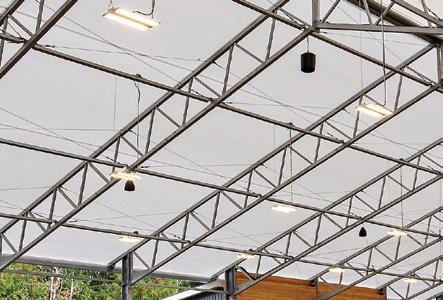
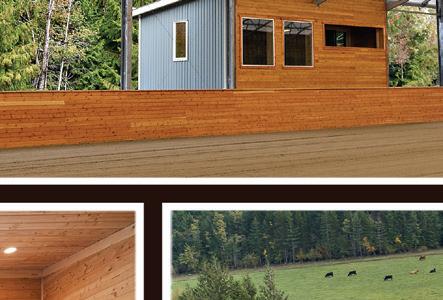
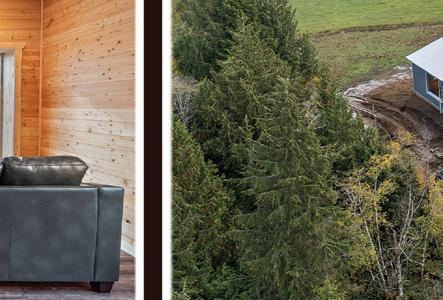




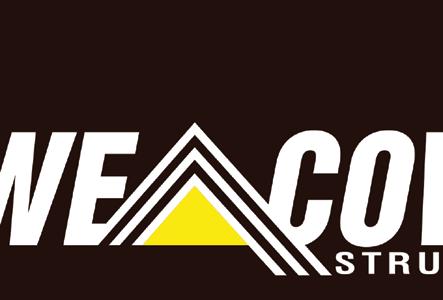



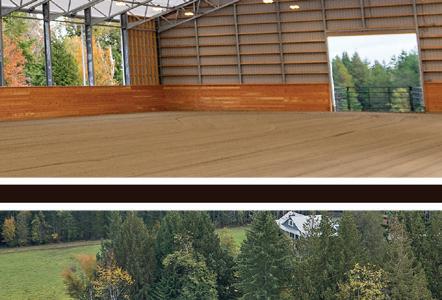










By Annika McGivern, MSc, Sport and Exercise Psychology
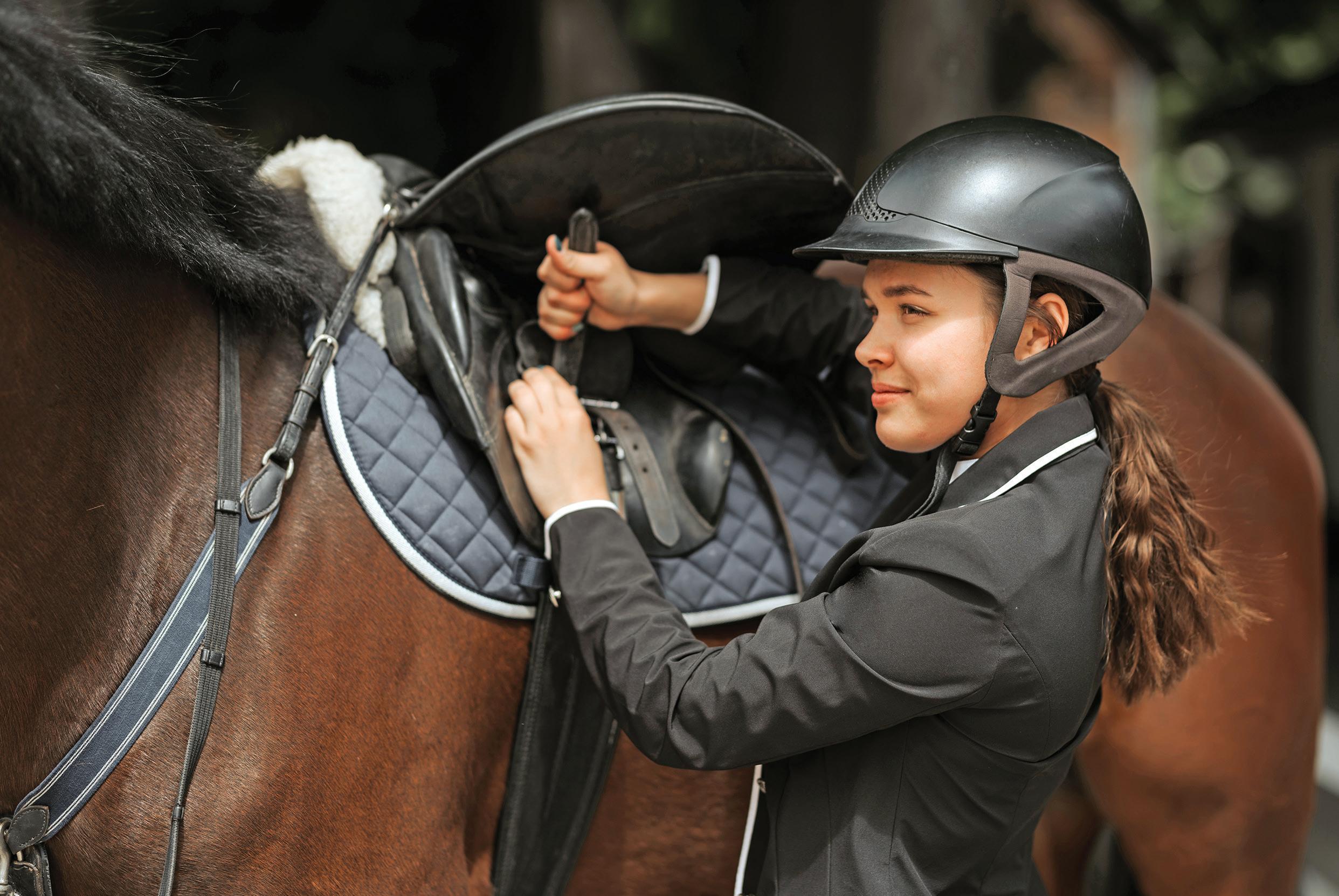
Have you ever felt stuck in your riding, unsure how to bridge the gap between what you want to achieve and what you’re actually achieving? You’re not alone. Equestrian sport is often one of slow progress, long learning curves, and many setbacks. Success and progress come easier when equestrians harness the power of mental tools to build strong skills, such as confidence, focus, and emotional regulation.
Visualization is one such mental tool that is often misunderstood and underutilized by equestrians. By imagining specific scenarios and actions in vivid detail, riders can improve their skills, build confidence, and even connect more deeply with their horses. This is not just a tool for competitive riders. Whether you’re a competitive athlete or a pleasure rider, visualization is a practical tool to reach your goals and enhance your experience. In this article, we’ll explore
visualization as a mental tool, why it works, and how to use it effectively. From preparing for competition, to enhancing learning, to strengthening your bond with your horse, visualization can unlock new levels of focus, confidence, and joy in your riding journey.
Visualization is the mental art of using our imagination to rehearse actions, scenarios, or outcomes in vivid detail, all
without physically performing them. You are already visualising all the time in both positive and negative ways. Positive visualisation happens when you imagine the outcome you want, such as seeing yourself clearing a jump or executing a perfect halt. Negative visualization happens when you imagine an outcome you don’t want, such as a refusal, a fall, or a mistake. When we imagine the outcome we want, it makes us more confident in our ability to produce that outcome in real life. When we imagine the outcome we don’t want, it makes us feel things are more likely to go wrong, which usually increases fear and decreases confidence. We all have active imaginations that interact with our thoughts and beliefs. The problem is that for most riders, their imaginations are spending far more time picturing bad outcomes than good. Learning visualization as a mental tool teaches us to train our imaginations to picture what we ask it to. Even if you are unconsciously picturing positive outcomes, deliberate, focused visualization takes this practice to the
next level, and turns it into a powerful tool for improvement.
The magic of visualization lies in its connection to how our brains work. Research shows that when we vividly imagine an activity, our brain activates many of the same neural pathways as during the actual physical movement. In other words, your brain doesn’t clearly differentiate between what you visualize and what you do. This activation strengthens those pathways, improving your muscle memory and making physical execution feel more natural.
Beyond refining technical skills, visualization helps riders manage their mental state. Imagining successful rides reduces anxiety by replacing worst-case scenarios with positive outcomes and strengthening our belief in the likelihood of those outcomes. It also sharpens focus, enabling riders to stay present and prepared under pressure. Whether you’re working on nailing a flying change or building confidence for the show ring, visualization is a proven way to train your mind and body for success. Let’s make sure you know how to harness its power.
In my work developing mental tools and skills with riders, I find that before a rider can visualize effectively, they must first recognize the wonderful level of control they can exert over their imagination. To experience this, set yourself a small, simple task. One by one, ask yourself to imagine — in as much detail as possible — the following things.
1 A beautiful, tropical beach.
2 A snowy village in the mountains.
3 A delightfully balanced transition from canter to sitting trot. By doing this, you’ll realize that your imagination was quite happy to produce those inner “movies” with ease. Your ability to control your imagination is directly related to how clearly you give it instructions. When you tell yourself to imagine something specific, your imagination is always happy to oblige. The secret to effective visualization lies in actively guiding your own imagination rather than passively waiting for random images to appear. For example, a rider is waiting to attempt a jumping exercise in a lesson. If the rider is nervous, their imagination may produce images of things going wrong (negative visualisation). This could increase the rider’s fear and interfere with them performing the exercise correctly. If
instead the rider firmly and clearly asks their imagination to ride the exercise successfully, they have intentionally used positive visualization. This is likely to help them feel calmer and more confident. Once they have pictured themselves doing the exercise successfully, it will feel more achievable. They will also have had an opportunity to “rehearse” the exercise mentally which will give them an advantage.
If you’re new to visualization, start small. Practice imagining simple actions, such as mounting your horse smoothly or asking for a balanced halt. Once you’re comfortable with short scenarios, build up to visualizing more complex tasks like riding an entire course or executing a dressage test. Just like physical riding skills, visualization improves with consistency. Make it part of your regular routine, even if it’s just for a few minutes a day. By practicing often, you’ll train your mind to access this tool effortlessly when you need it most.
PREPARING FOR COMPETITION:
Visualization is essential for competition readiness. By mentally rehearsing your course, dressage test, or riding pattern, you can memorize the pattern, create your plan for the ride, and even anticipate challenges. Picture every detail, such as where you’ll turn, the rhythm of your canter, or the transition into a perfect halt at X. More importantly, visualize a calm, confident performance. See yourself handling any hiccups with poise and quickly refocusing. This mental rehearsal boosts your sense of readiness and helps you enter the competition arena feeling prepared and self-assured.
OVERCOMING FEAR OR ANXIETY: Fear is a natural part of riding, but visualization can help you manage it. If you’re worried about a spooky horse or a challenging jump, imagine yourself handling the situation calmly and effectively. Picture the outcome you want: You and your horse remaining relaxed and connected or clearing the jump with ease. By visualizing success in situations that usually trigger anxiety, you build belief in your ability to manage them and replace fear-based thinking with a sense of control and possibility.
IMPROVING TECHNICAL SKILLS: Visualization isn’t just about mental preparation; it’s also a practical way to
refine riding skills. Rehearse specific movements, such as flying changes, smooth transitions, or your position over fences. Imagine every part of the process, from the feel of your aids to the response of your horse. This mental rehearsal complements your lessons, reinforcing the skills you’re learning and helping you progress faster.
STRENGTHENING THE RIDER-HORSE CONNECTION: The relationship between rider and horse is the heart of equestrian sport. Visualization can deepen this bond by setting a positive tone in every ride. Imagine a harmonious ride where your aids are clear, and your communication is seamless. Imagine responding to frustrating moments with calmness and compassion for yourself and your horse. This practice helps you approach rides with intention and manage emotions, improving your connection with your horse.
COPING WITH SETBACKS: Setbacks are inevitable, but how you respond matters. Use visualization to replay challenging moments and imagine alternative solutions. For example, if a misstep rattled you and stuck with you longer than it should have, visualize yourself reacting calmly, letting go of the mistake, and quickly regaining focus. This approach reduces frustration and helps you find the learning opportunities that are always present with mistakes and setbacks.
As I often tell my clients: Your imagination is always active, so harness that power and get it working to your advantage. With practice, visualization will be a deliberate and powerful practice that every equestrian can use to improve their riding. Whether preparing for competition, overcoming fear, refining technical skills, or strengthening your bond with your horse, visualization offers a way to boost progress and success. If you can consistently direct your imagination to create images of positive outcomes, you can replace doubt with a clear plan of action, use setbacks as opportunities to clarify what you want, and ride with greater intention, compassion, and focus. With practice, visualization can be the tool that helps you close the gap between your dreams and the experience you live every day with your horse. b > Annika McGivern is a frequent contributor to this magazine — read her bio on page 102.
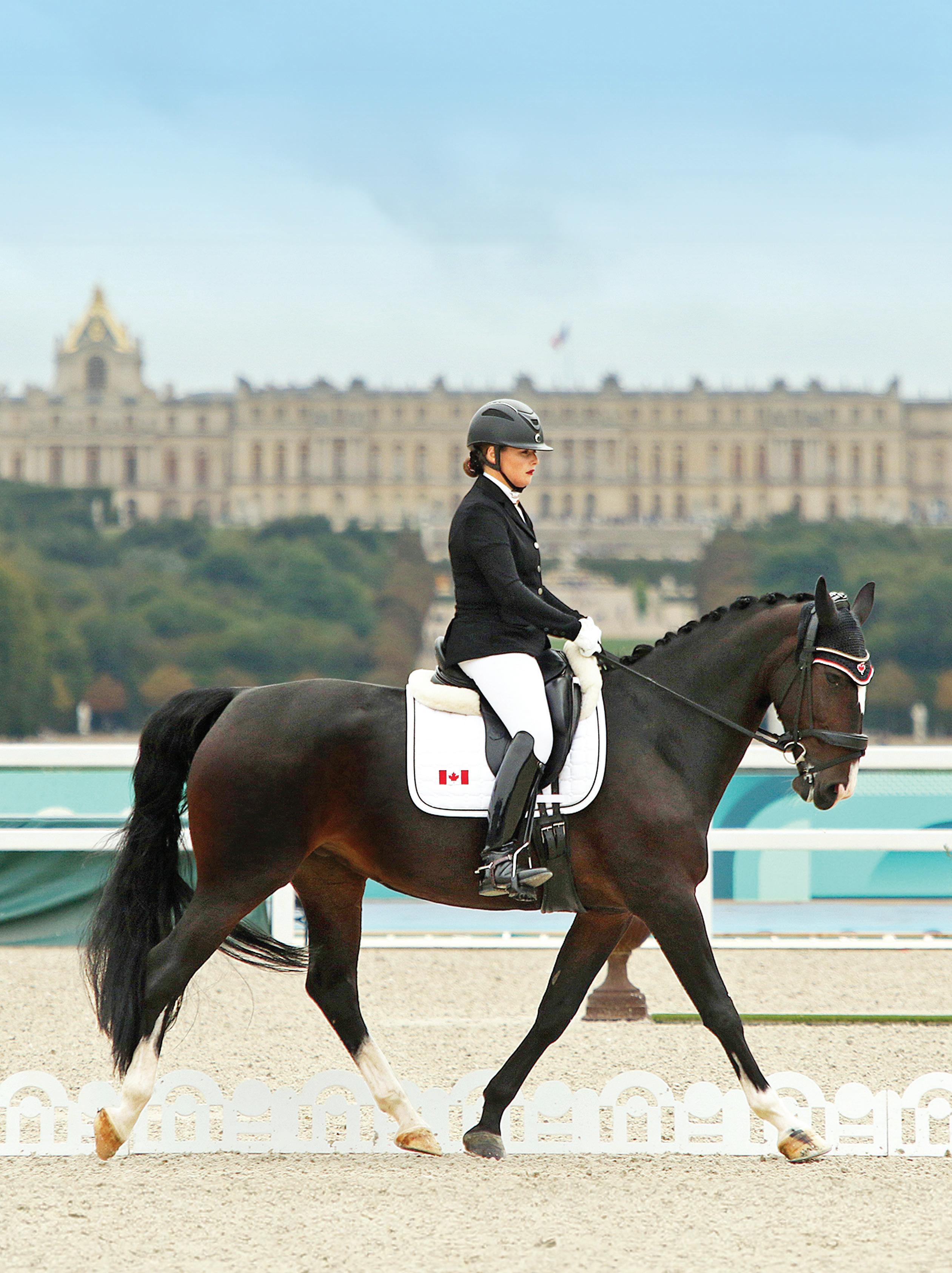
Roberta Sheffield of Canada riding Fairuza in the Grade II Para Equestrian Individual Event at the 2024 Paralympic Games in Versailles, Paris.
Although organized therapeutic riding programs emerged in the 1950s, the benefits of horseback riding for people’s physical and mental health were recognized as early as ancient Greece. The rhythmic motion of the horse’s walk replicates the human walk and promotes core strength, postural alignment, flexibility, balance, and normalized muscle tone. Learning to guide the horse with seat, arms, hands, and legs fosters fine motor skills and improves coordination. Along with the positive physical effects, the human-horse bond promotes mental and emotional well-being by reducing anxiety, encouraging independence, and building self-confidence.
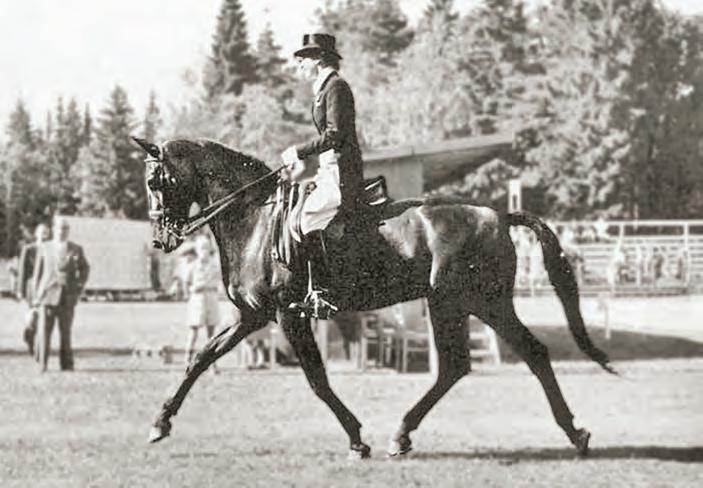
Lis Hartel (1921–2009) was a Danish Olympic equestrian and the first woman to win a medal in individual dressage. At the 1952 Helsinki Olympics, she was one of the first women to compete in modern equestrian sports, earning a silver medal despite being paralyzed below the knees due to polio. She also won silver at the 1956 Olympics and multiple Danish dressage championships.
Born in Hellerup, Denmark, Hartel began riding young, coached by her mother and later by Olympic trainer Gunnar Andersen. Despite contracting polio in 1944 while pregnant with her second child, she resumed competing, achieving remarkable success. After retiring, Hartel promoted therapeutic riding and supported polio patients. Honoured in Denmark’s Hall of Fame in 1992, she remains a symbol of perseverance in sports history.
By Sandra Verda-Zanatta, SVZ Dressage & F2R Fit To Ride Pilates for Equestrians
In 1952, Lis Hartel, a Danish equestrian partially paralysed by polio, rehabilitated her body and reactivated her muscles through riding. Although still paralysed below the knees, she went on to win a silver medal at Helsinki Olympics. This accomplishment brought more awareness to the value and therapeutic benefits of horseback riding, and to the competitive aspect of equestrian sport for people with disabilities. Today, many competitive para equestrians start in therapeutic riding programs and eventually progress to become elite athletes competing internationally. Another interesting fact that attests to the uniqueness of equestrian sports is that male and female athletes compete against each other on an even playing field. Additionally, dressage para equestrian athletes are eligible to compete in mainstream competitions with adaptive equipment if they are officially classified through their national organization and have a dispensation card authorizing adaptations.
Pilates cross-training is an effective modality for para equestrian athletes to improve physical and mental health, technical skills, and competitive performance. The total body strength, balance, flexibility, and coordination gained from focused exercises are key fitness factors required to excel in all levels of sport. This is especially true in equestrian sports as the rider’s body has a direct influence on the horse’s body.
A rider’s position while mounted has a significant effect on the horse’s balance and ability to move with maximum ease and efficiency. Therefore, all riders should strive to develop their own best position. It is unrealistic to think that every rider is able to attain the often-referenced “ideal balanced position” of the plumb line: ear-shoulderhip-heel. The true goal should be to develop the most balanced, symmetrical, and secure position possible to support positive training sessions and quality competitive performances. It’s about being creative, adapting equipment, and finding ways to promote effectiveness, comfort, and security.
In addition to the distinctive relationship between horses and riders that requires cooperation and synchronization of two sentient beings, there are unique challenges faced by para equestrians that require an innovative approach to adapt exercises and accommodate specific needs and abilities. Knowledge and understanding of the characteristics of different disabilities is imperative to adapt training techniques both on and off the horse, helping riders improve mobility, body strength, limb control, and balance.
Riders of all levels, disciplines, and ages can benefit from a personal cross-training plan. In general, rider fitness significantly contributes to performance, safety, and injury prevention. If we expect our horses to be athletes, we owe it to them to be accountable and committed to improving our own fitness. The reality is, we all have imbalances and asymmetries, weaknesses continues on page 49
Excercises illustrated on pages 46 - 52
Sit on wobble-disc, feet on floor or with small ball under each foot, with flex band around lower back, hold flex bands like reins with elbows slightly bent and tension on the band.
Sit tall and try to maintain an upright posture with neutral pelvis and even feeling on both seat bones.
a Inhale, concentrate on deep breaths keeping shoulders down and relaxed, exhale, draw belly button towards spine, feel a connection in core. Repeat five times;
b Elbows forward and back — both arms simultaneously, then progress to alternating arms.
Same position as above — flex band attached to a stationary object, hold like reins, try to isolate movement to arms only, keeping upper body and legs still.
a External rotation — rotate your forearms outward simultaneously, then progress to alternating arms; b Diagonal arms.
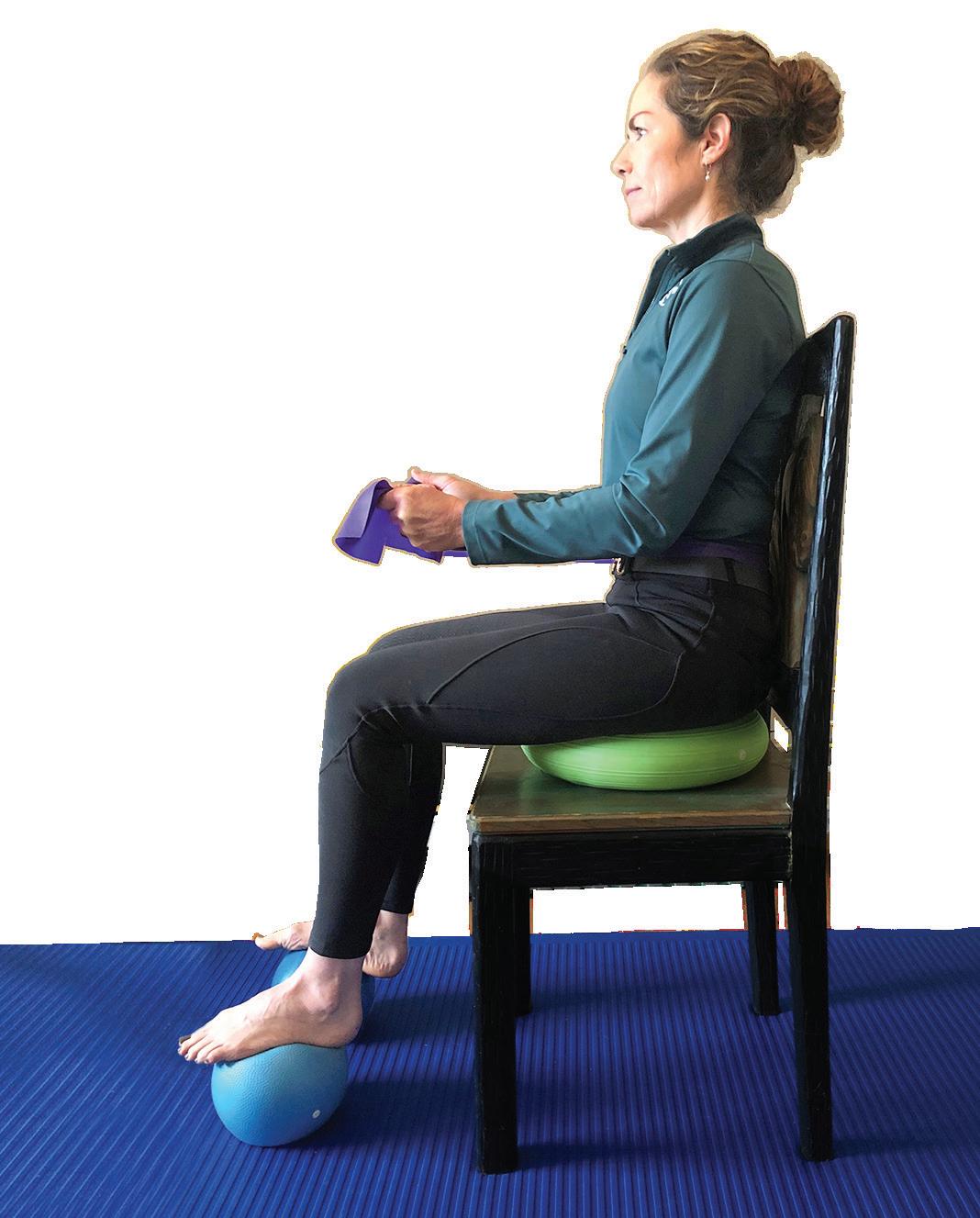
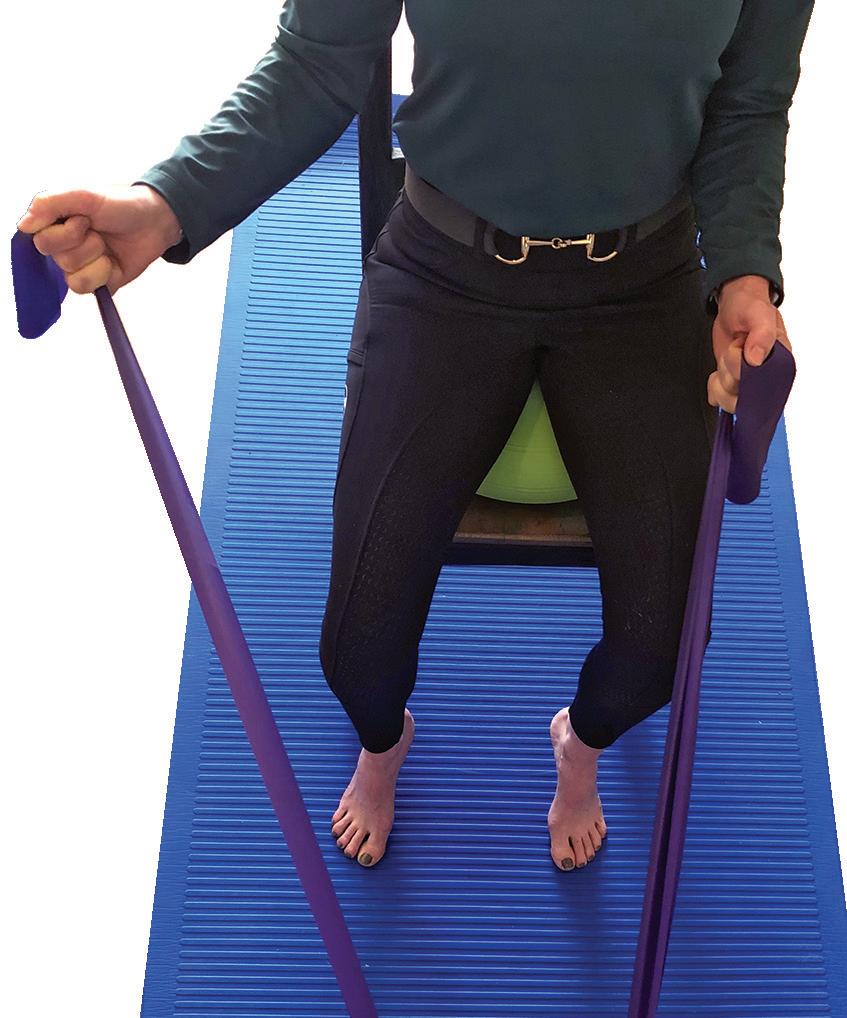
(inside leg-outside rein)
Same position as above with flex band around one leg, hold another flex band (attached to stationary object) with opposite hand.
a Simultaneously move leg towards midline to activate adductors (inner thigh muscles), bend elbow and draw shoulder blades towards spine to pull flex band. Keep core engaged. Hold for three breaths and repeat five times, then switch sides;
b Progress to adding external rotation of opposite arm.
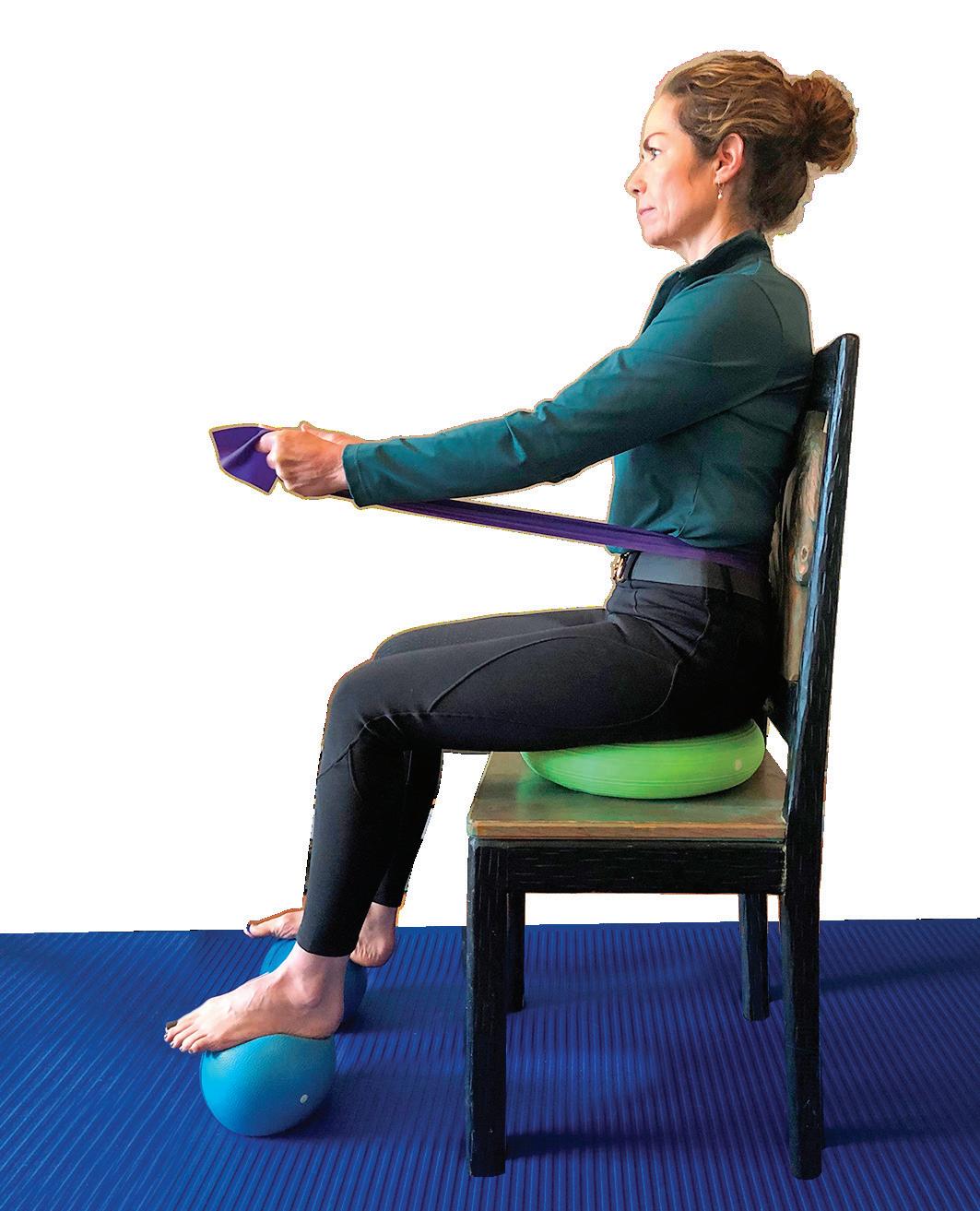

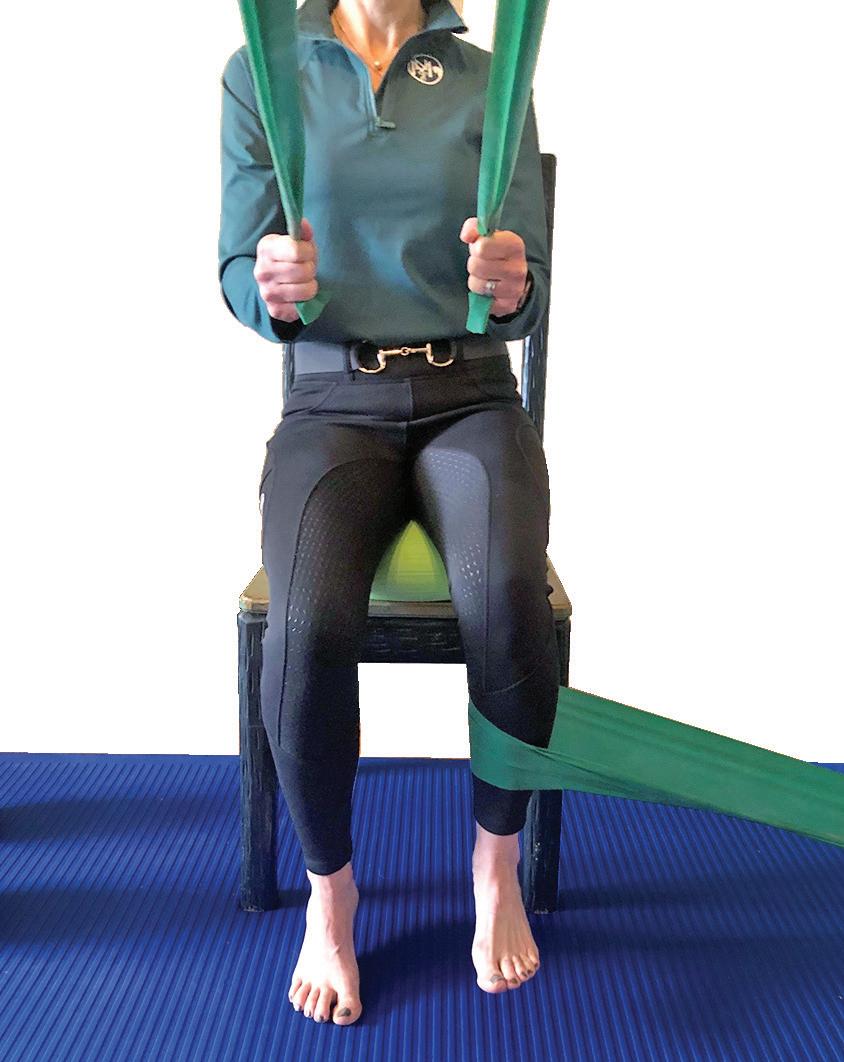

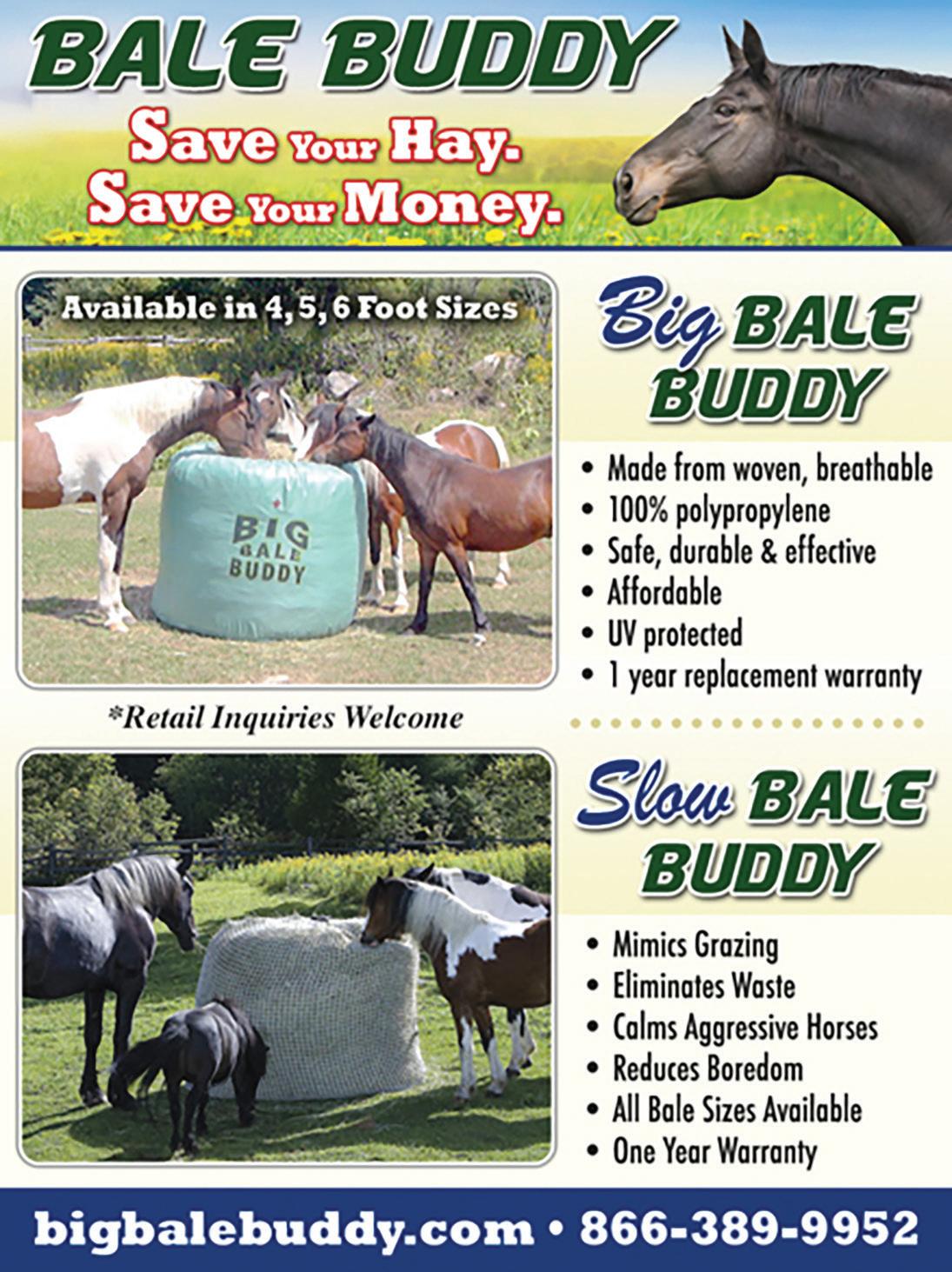


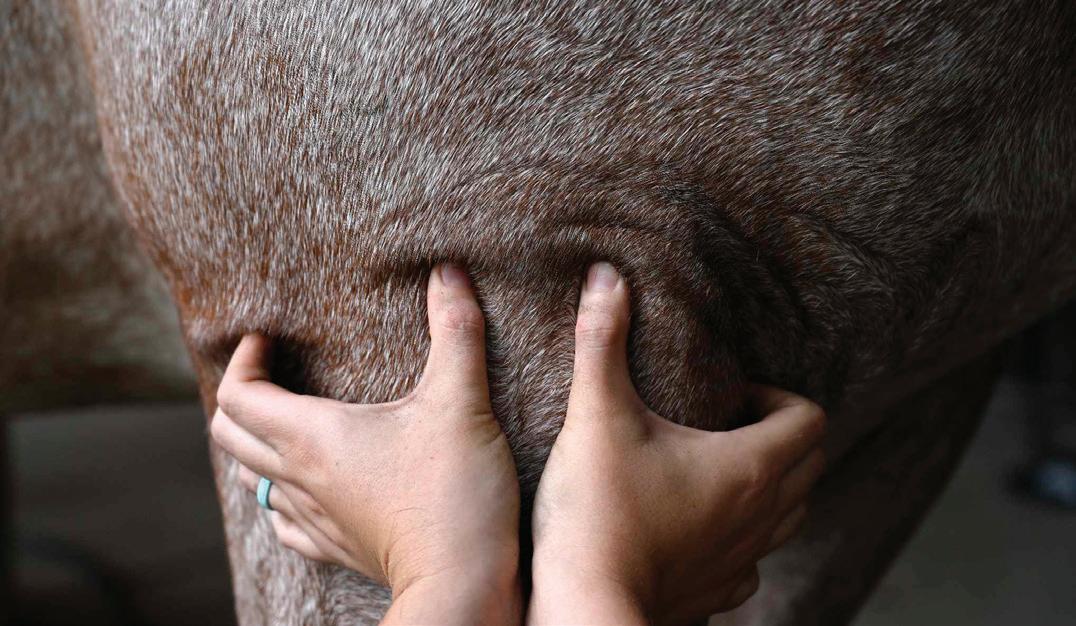
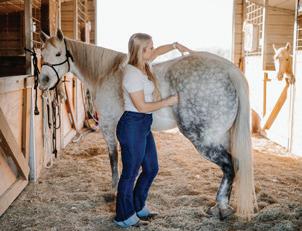
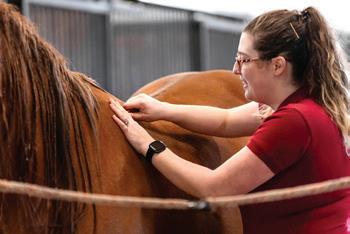
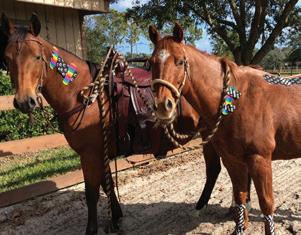










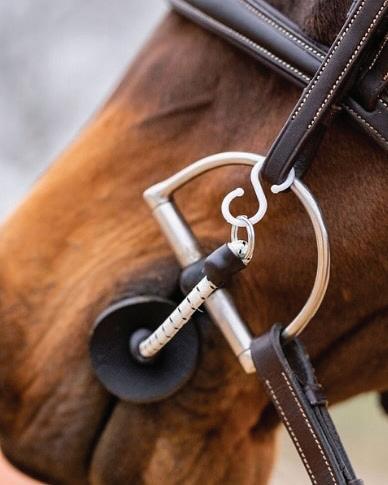
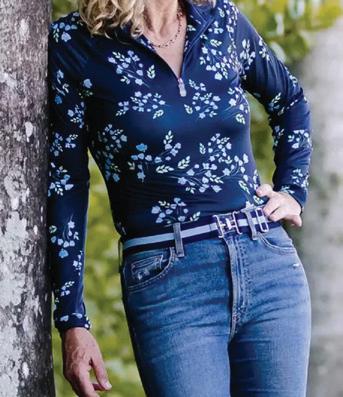



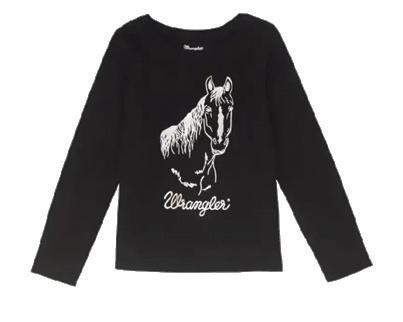


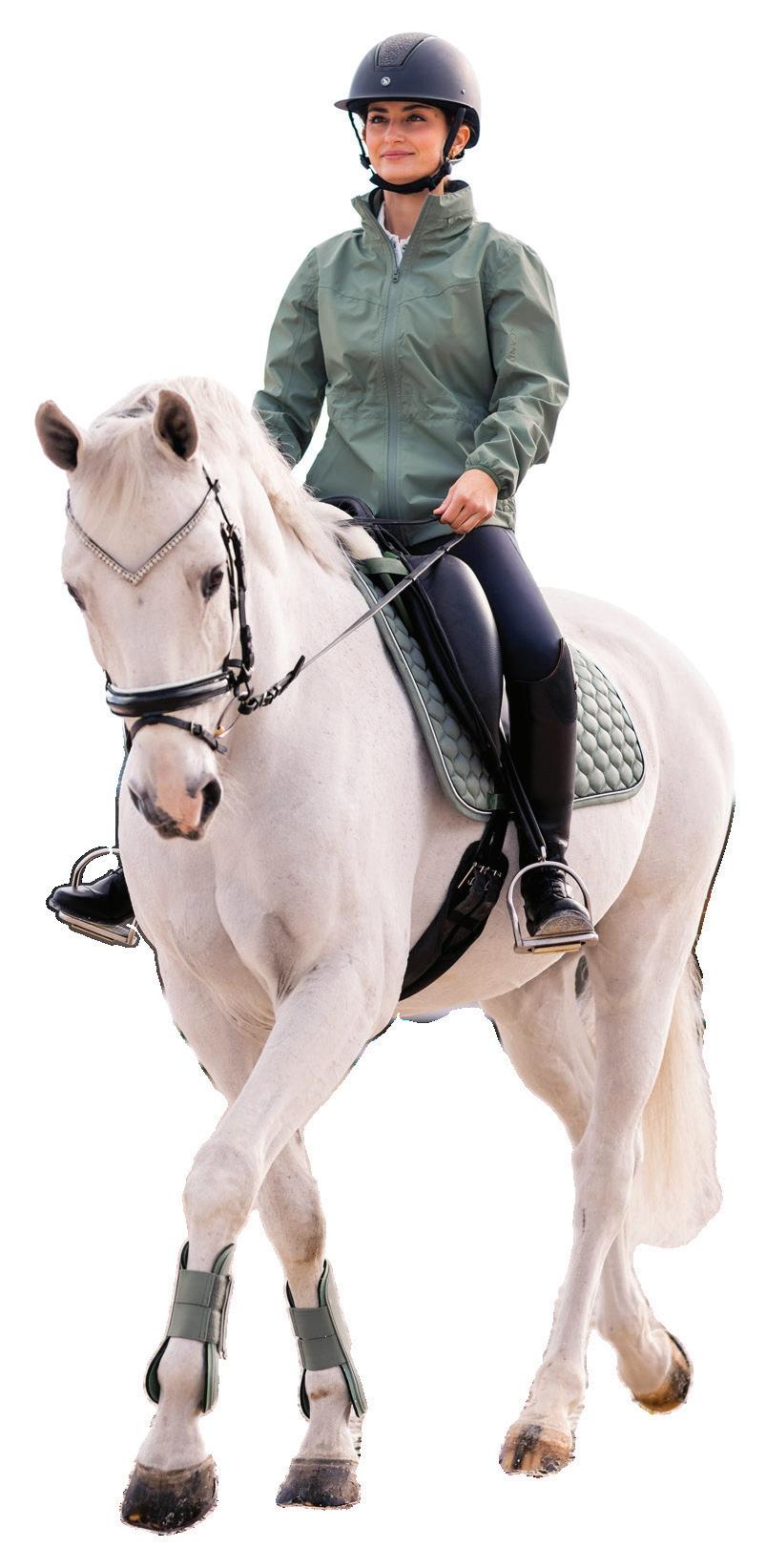


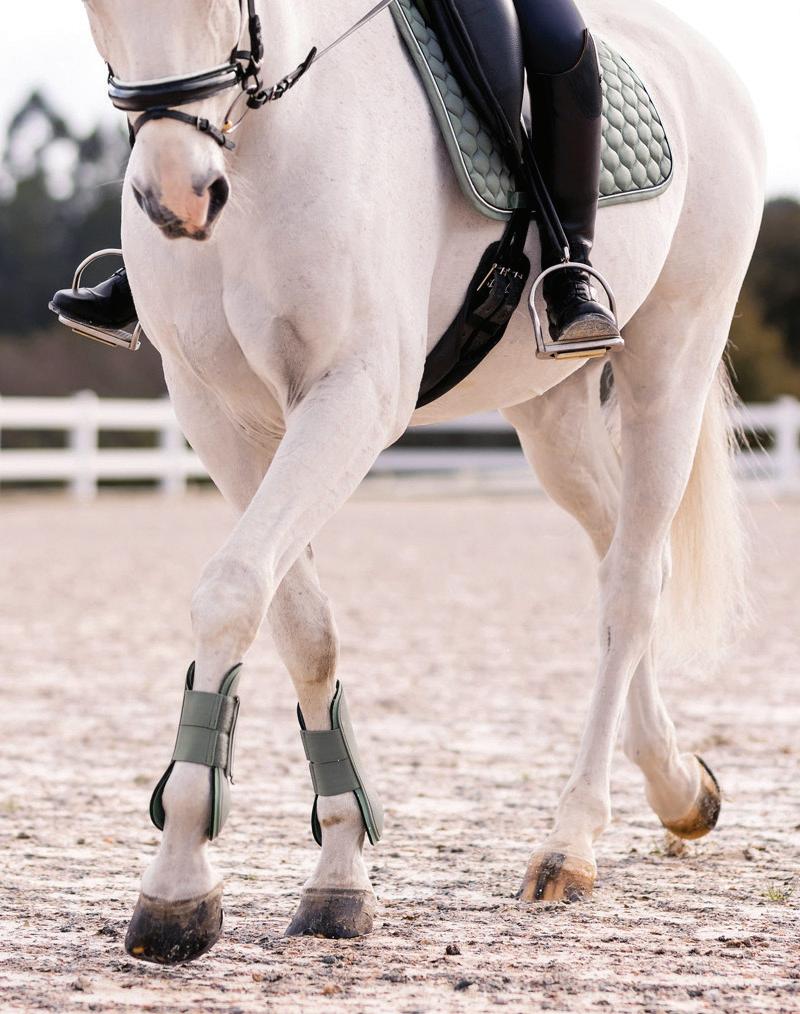



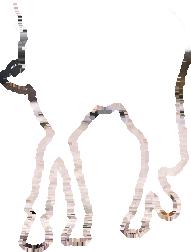
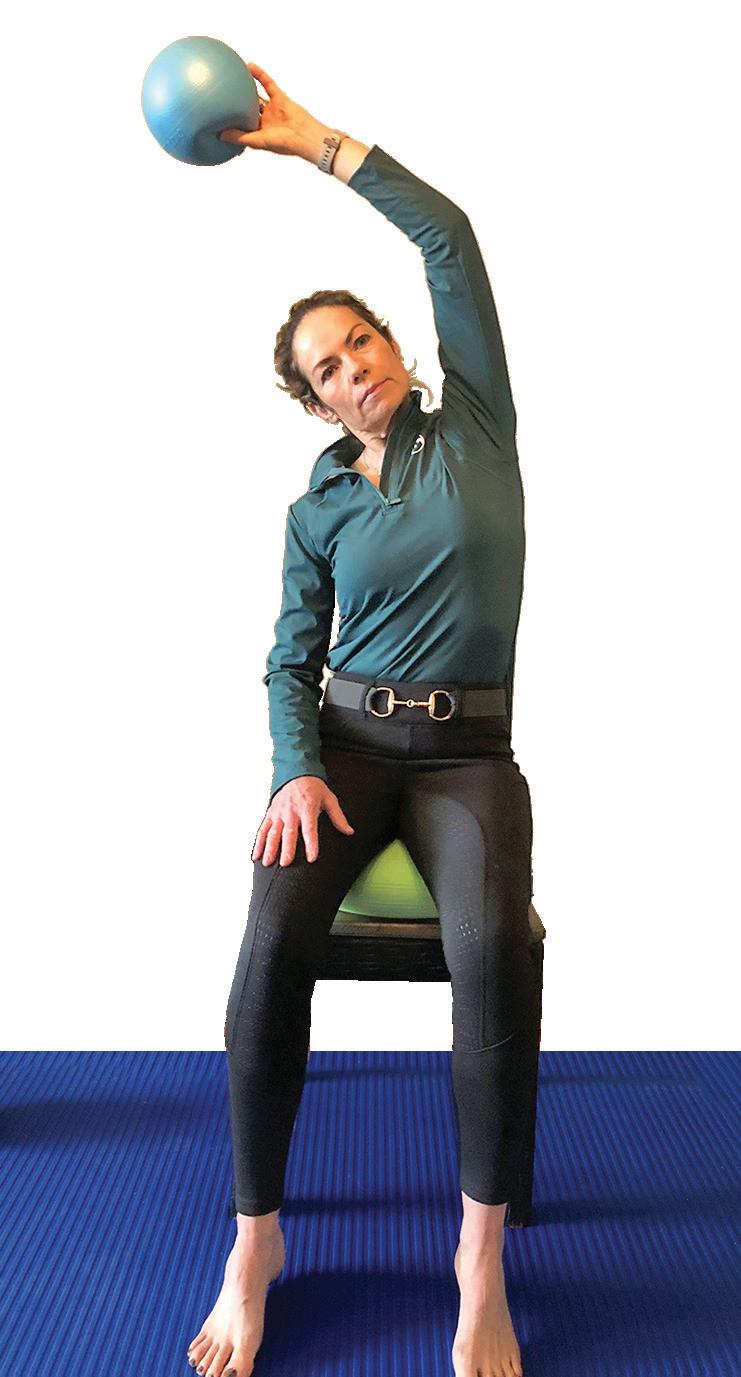
Same position as previous exercises with or without wobble cushion. Hold light weight in reaching hand. No flex band required.
Raise one arm and side bend over, keep seat bones even — focus on keeping the seat bone on same side as raised arm, down. Hold for three breaths, then relax and repeat five times and switch sides. This exercise can be done with or without weight.

• For additional balance challenge when seated, put a small ball under each foot;
• If appropriate sit on a stability ball rather than a chair;
• Exercises can be done from a wheelchair;
• Use support pads to help posture and assist as necessary;
• Do not force joints to increase range of motion;
• Use light resistance bands to start and increase strength as appropriate;
• Additional modifications may be necessary;
• It is important to work with trained professionals and consult a doctor, physiotherapist, or other health professionals prior to starting any fitness program;
• All exercises and repetitions are guidelines only, each individual needs to gauge exercise appropriateness and adjust as necessary.

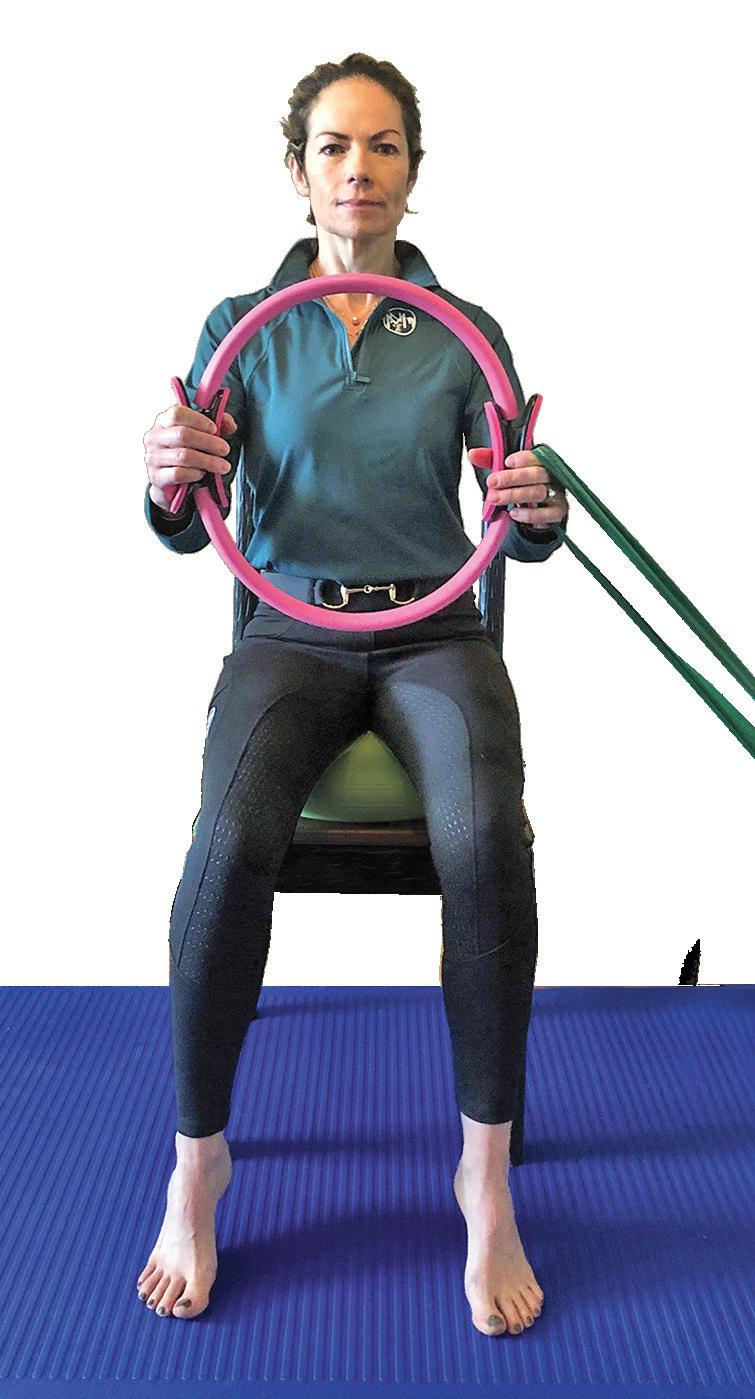

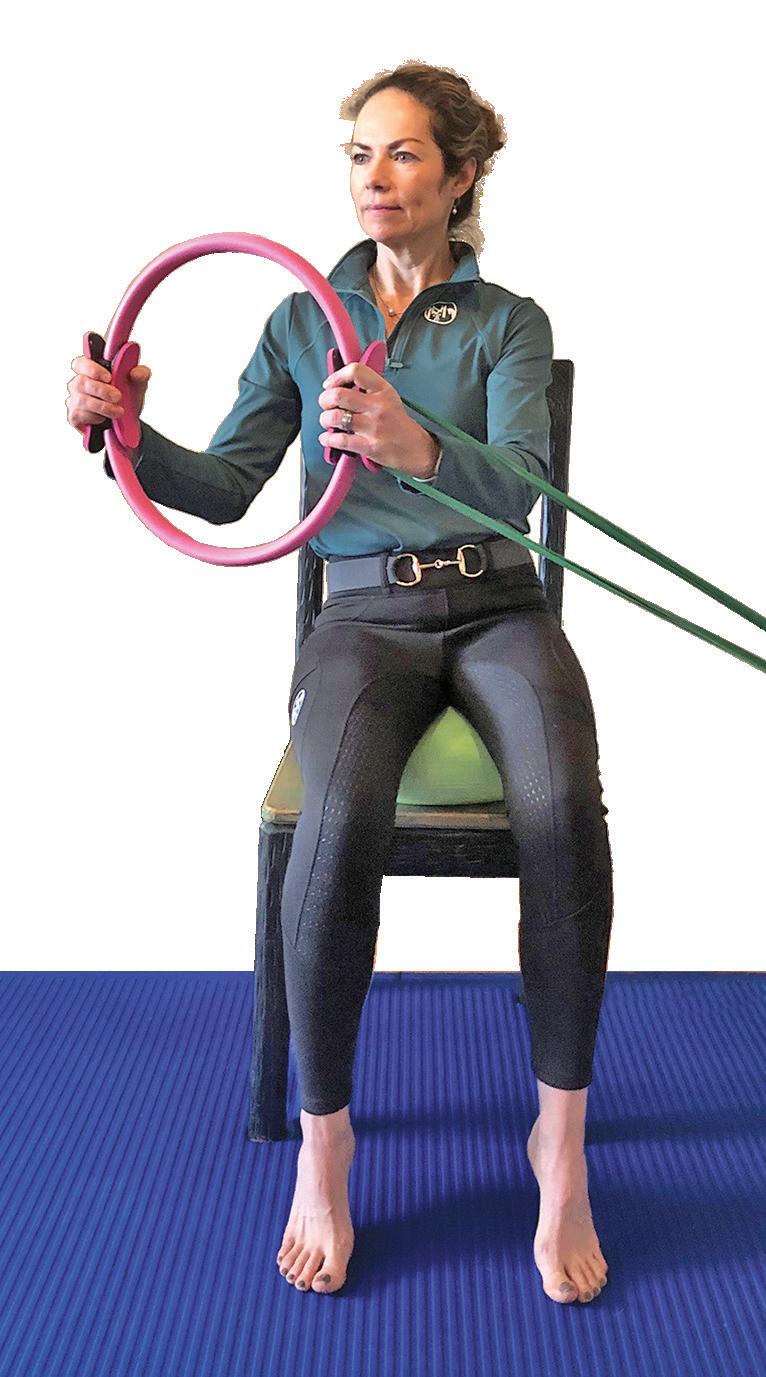
Same position as above with or without wobble cushion.
Hold flex band (attached to stationary object) with fitness circle and rotate upper body, keeping seat bones even and pelvis neutral with hip bones pointing straight ahead. Hold for three breaths, repeat five times, then switch sides.
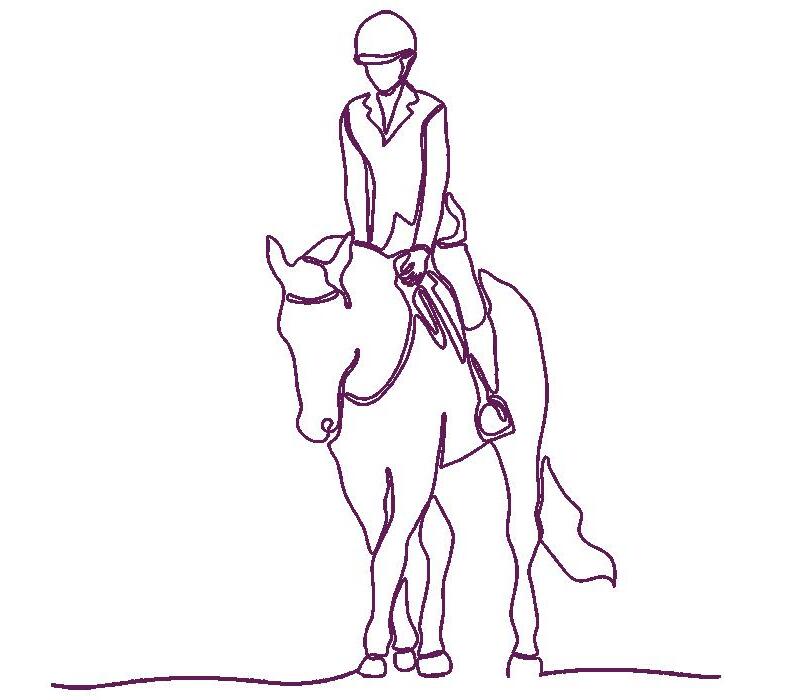
and strengths. The goal is to be subtle, yet effective, and in harmonious communication with our equine partners.
Effective communication, postural alignment, and balance while mounted can all be improved through specific exercises. Abdominal and upper back strength, along with shoulder girdle stability, help riders maintain posture and stay centered in the saddle. Flexibility and coordination enable clear, precise aids and fluid responses to the horse’s movements. Along with strength and flexibility training, cardiovascular fitness is also important for endurance during longer rides and multi-day competitions. These factors increase overall comfort for both athletes and contribute to the development of cohesive partnerships.
Specific disabilities can impact a rider’s ability in diverse ways, making it imperative to develop individualized programs and adapt exercises to each rider’s needs. Physical limitations and mobility impairments such as paralysis (loss of ability to move, and in some cases, feel part or all of the body); partial paresis (weakness of muscle groups caused by nerve damage); spastic or flaccid muscle tone; hypermobility or limited range of motion in joints; and vision or hearing loss can affect a rider’s ability to maintain balance, give clear cues, and move limbs fluidly.
Pilates exercises can be adapted by a knowledgeable professional and tailored to accommodate individual rider needs with a focus on comfort, safety, and efficiency. Seated exercises using resistance flex bands are effective to improve range of motion and limb strength while promoting fluid movement and elasticity. Pelvic tilts, side bends, and torso rotations improve mobility and encourage engagement of core muscles. Stability balls, balance boards, and wobble discs are useful to improve the dynamic balance needed while riding. Tack and equipment such as adapted saddles with pommel handles, oversized thigh blocks, deeper seats with higher cantles, adapted safety stirrups, and Velcro® straps are helpful to stabilize leg positions. Modified reins with loops and varied thicknesses help grip strength and promote consistent rein control and improved contact. These are just a sample of the vast number of inventive adaptations utilized by para equestrians to improve effectiveness and performance while ensuring comfort and safety.
The exercises in this article can be helpful for a wide variety of equestrians who are striving to improve total body strength, focusing on core engagement, coordination, balance, and the feeling of elasticity in the arms.
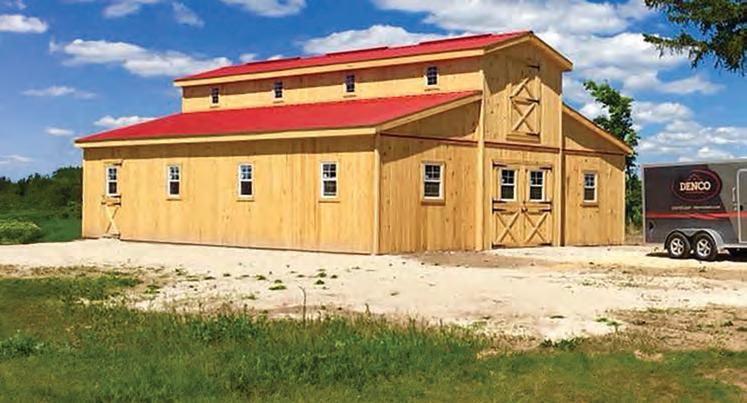
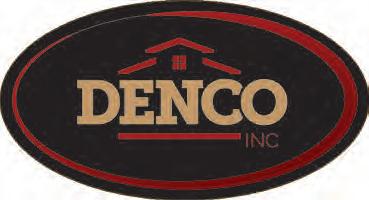
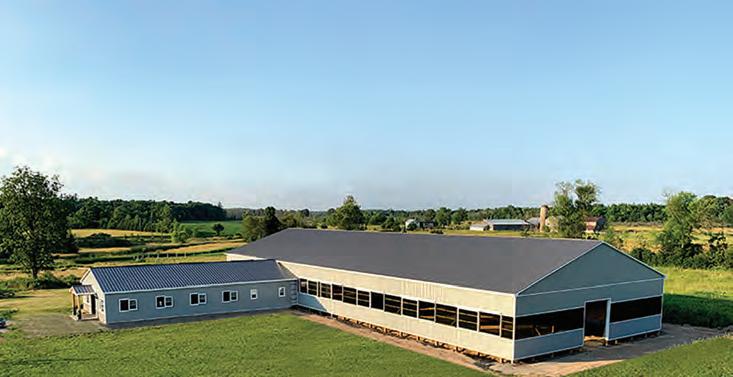

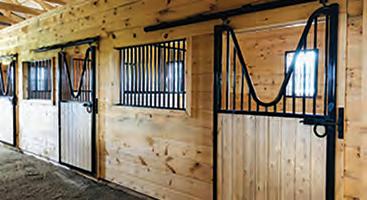






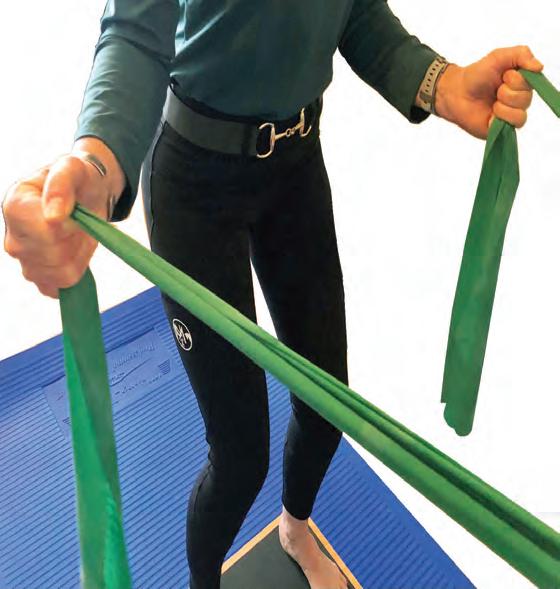
Stand on balance board with knees slightly bent. Draw belly button in towards spine to engage core. Hold flex bands like reins with elbows slightly bent, shoulders down and relaxed.
a Elbows forward and back — both arms together, progress to alternating arms;
b External rotation — both arms together, progress to alternating arms.
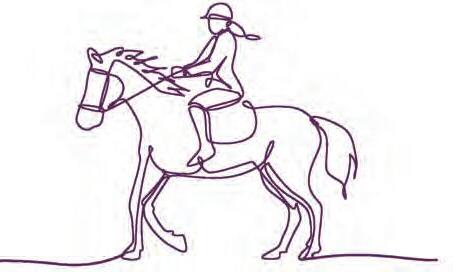



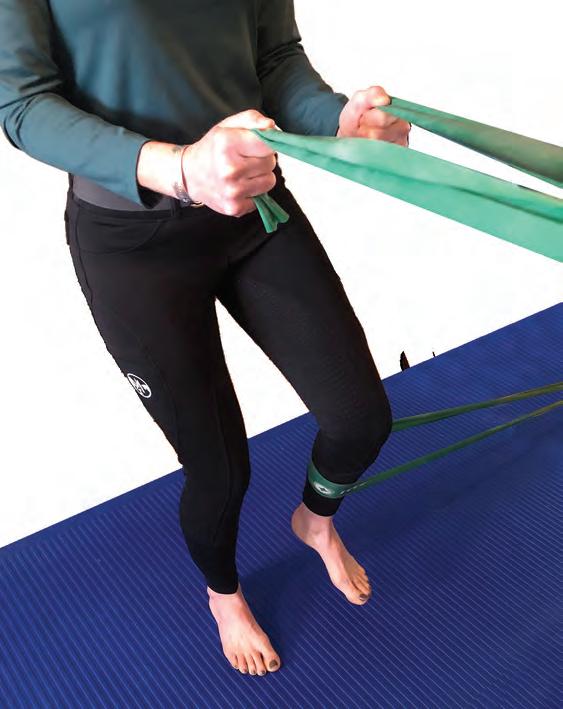
Stand with flex band around one leg, holding another flex band (attached to stationary object) like reins.
a Simultaneously move leg towards midline to activate adductors (inner thigh muscles), bend elbow and draw shoulder blades towards spine to pull flex band. Keep core engaged. Hold for three breaths and repeat five times, then switch sides;
b Simultaneously move leg backwards to activate glutes and hamstrings, bend elbow and draw shoulder blades towards spine to pull flex band. Keep core engaged. Hold for three breaths and repeat five times then switch sides;
c Simultaneously move leg backwards while reaching opposite arm forward.
RESOURCES
Professional Association of Therapeutic Horsemanship International > pathintl.org
Fit To Ride > www.fit2ride.ca
Equestrian Canada Para Dressage
> equestrian.ca/sport/para-dressage
Canadian Therapeutic Riding Association > cantra.ca
> Sandra Verda-Zanatta is a frequent contributor to this magazine — read her bio on page 102.

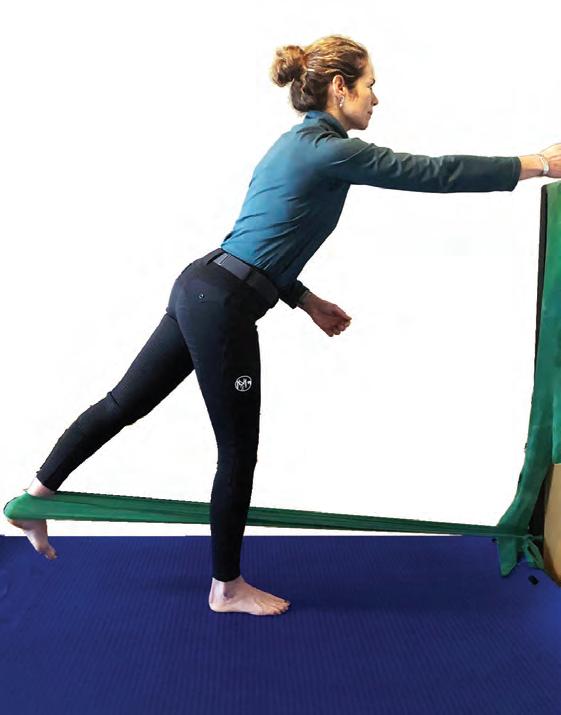
Cartwright with one of the WCVM’s new equine nasogastric models.
By Rigel Smith


A recent pair of grants from Merck Animal Health Canada has helped the Western College of Veterinary Medicine (WCVM) take strides to enhance its equine health teaching tools.
Merck’s grants, valued at more than $50,000, highlight a longstanding partnership between the company and the WCVM. While Merck’s contributions have supported various initiatives over the years, the company’s most recent investment has made a significant impact on veterinary education.
Thanks to Merck, the BJ Hughes Centre for Clinical Learning — the college’s simulation centre — was able to purchase several additional high-tech models, including three equine nasogastric tubing systems. Manufactured by Veterinary Simulator Industries (VSI) in Calgary, Alta., each life-sized model consists of a horse head and neck along with a portable stand. The devices also function as venipuncture models, allowing students to practise blood draws, intravenous injections and catheter insertions.
“Having these models, like any simulation model, enhances the learning experience,” says Carolyn Cartwright, a registered veterinary technologist and manager of the BJ Hughes Centre. While the models will be used to teach all levels of veterinary students, interns and residents, they will also be an integral part of the equine gastrointestinal tubing lab. This skills-focused session is for second-year veterinary students in the college’s Doctor of Veterinary Medicine (DVM) program.
Nasogastric intubation is a critical, often life-saving procedure used in equine colic cases to relieve stomach pressure and administer treatment. Veterinarians must be able to perform this procedure quickly and safely in a wide range of environments.
Traditionally, instructors relied on live horses to help introduce students to the “ins and outs” of the challenging procedure. But access to these new models now helps to minimize the use of the college’s teaching horses.
“The equine nasogastric tubing model will not only decrease, but potentially even eliminate the live horse use for that GI tubing lab,” says Cartwright, noting the procedure often causes discomfort for the horses.
“We’re protective of making sure that our animal use is necessary,” says Cartwright. “When the opportunity is there, we will utilize other methods of teaching for students to get those skills.”
The new models let students safely and repeatedly practise the procedure in a controlled environment — without the added stress of handling a horse.
“You might have that beginner learner who has never been around a horse, and then all of a sudden, you put a thousand-pound animal in front of them and they’re supposed to try to learn a new skill,” says Cartwright. “That’s very stressful.”
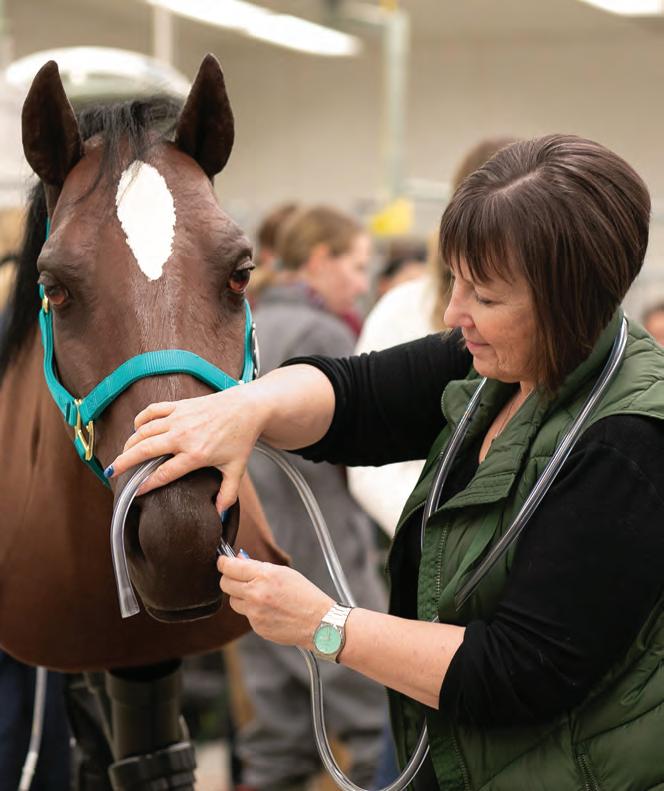
The simulation models offer logistical advantages for the simulation team. With numerous models, more students can practise their skills simultaneously. Since the models are mounted on portable stands, they’re easier to transport around the college’s facilities.
Horse Health Lines is the news publication for the Western College of Veterinary Medicine’s Townsend Equine Health Research Fund (TEHRF). Visit tehrf.ca for more information, Send comments and article reprint requests to:
Myrna MacDonald, Editor Horse Health Lines WCVM, University of Saskatchewan 52 Campus Drive, Saskatoon, SK S7N 5B4 horse.health@usask.ca
Horse Health Lines design and layout: Priddy Design
The equine models will be a welcome addition to the objective structured clinical examinations (OSCEs). Instructors use these practical, hands-on tests to evaluate veterinary students’ clinical skills.
“Because it’s a standardized model and not a live animal, there’s less complexity for testing,” says Cartwright. “It’s not, ‘Oh, this horse was doing this and so it affected the students’ ability to complete the station.’”
In addition to the equine nasogastric models, Cartwright says Merck’s financial support has allowed the WCVM to purchase a variety of other simulation models. The list includes a bovine tail epidural model, a replacement gastrointestinal tract for its full-sized equine colic model, a bovine uterus model, a
piglet model, and an equine reproductive tract model.
Cartwright explains that grants like the ones offered by Merck not only support the BJ Hughes Centre for Clinical Learning and its teaching labs but also help to support the overall college.
“We have an extensive list of supplies we need to expand the teaching program,” says Cartwright. “Grants like these free up funds that the college can put toward other opportunities.”
The benefits extend beyond the WCVM’s veterinary program. These models also play a role in extension and outreach programs, including student-led education events and community outreach.
While the new models have yet to be used in a lab setting, the ripple effects of this investment are already being felt.
“There is a buzz — everybody’s very excited,” says Cartwright. “These models will be a huge benefit.”
The purchase of three equine nasogastric models was made possible through financial support from Merck Animal Health Canada.
By Rigel Smith
For veterinarians who are passionate about equine care, the Western College of Veterinary Medicine (WCVM) internship and residency programs offer a gateway to specialization.
Dr. Eveline Juce, a clinical associate with the Equine Field Service team at the WCVM Veterinary Medical Centre (VMC), knows firsthand the benefit of these programs. She accepted her current job after completing a one-year internship with the same team in 2024.
Originally from Hamiota, Man., Juce grew up surrounded by horses. Caring for and showing horses throughout her childhood set the stage for her career in equine medicine.
“Horses were kind of born in my blood,” reflects Juce. “Being a horse vet just made sense.”
After earning her Doctor of Veterinary Medicine (DVM) degree from the WCVM in 2023, she pursued an ambulatoryfocused internship — a decision rooted in her passion for working directly with clients and their horses on farm.
The WCVM’s one-year internship program is designed for recent DVM graduates, providing them with training in several areas of equine health: field service, medicine, surgery or theriogenology (reproduction). This program prepares them for private practice or further specialization through residency programs.
Juce’s path to the internship wasn’t always certain, but the WCVM program’s focus on mentorship drew her in.
“I knew there would be someone who would mentor me — someone that I could call at 2 a.m. and would happily answer my question,” she says. For Juce, a key mentor was Dr. Nora Chavarria, a clinical associate in equine field service at the WCVM.
“I owe a lot of what I learned — whether that be veterinary medicine, work-life balance, or just how to be a good person — I owe a lot of that to Nora,” says Juce.
Dr. Valentina Ragno, an equine internal medicine specialist and program supervisor at the WCVM, believes these equinefocused programs are critical.
“When you graduate from vet school, you’ve only scratched the surface of something you’re passionate about,” explains Ragno. “If you want to specialize a bit more, you really need that mentorship, and that’s what these programs provide.”
The WCVM offers three- to four-year residency opportu-
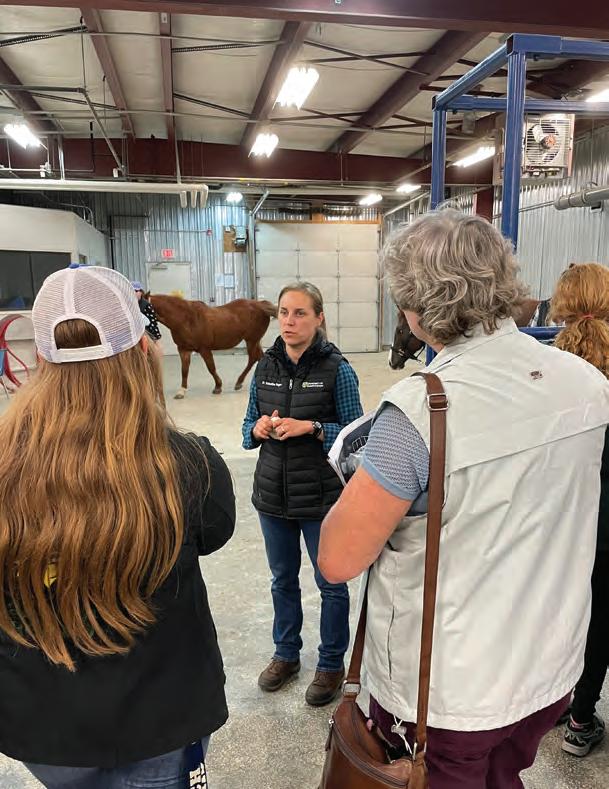
nities in large animal internal medicine, surgery, theriogenology and equine field service.
The residency is combined with a Master of Science (MSc) program during which residents complete a research project.
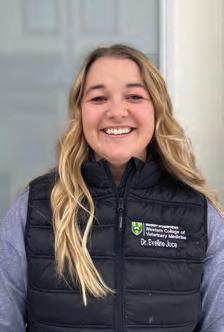
The WCVM receives applications through the North American Veterinary Internship and Residency Matching Program (VIRMP). Applicants and institutions alike rank their preferences, with matches announced sometime in February or March each year.
Originally from Italy, Ragno trained in Europe and the U.S. before matching into the WCVM’s MSc-residency program in 2016. Now, as part of the college’s specialist team, Ragno continues to foster the collaborative approach that drew her to the program.
“It’s a pyramid of knowledge — the residents can teach both interns and undergrad students. And then we as specialists can train everybody,” she says.
The value of these programs extends beyond the participants themselves, ensuring clients and patients have access to the best possible care.
“You are working with a massive community of specialists and everyone has their special areas,” says Juce. “You have access to these incredible specialists literally at your fingertips. It’s pretty special.”
By Rigel Smith

Imagine you’ve been battling a relentless respiratory infection for days. Exhausted and desperate for relief, you head to the doctor, expecting a quick fix from a course of antibiotics. Instead, you discover that the bacteria causing your illness are resistant to every available drug, leaving you with no effective treatment options.
This frightening scenario could become a reality due to antimicrobial resistance (AMR), an issue deemed a major global threat by the World Health Organization. AMR happens when microorganisms — such as bacteria or parasites — evolve to survive treatments that once worked. The issue is driven largely by the misuse and overuse of antimicrobial drugs in both humans and animals.
While AMR is well studied in human medicine and food animals, there are few peer-reviewed studies focused on companion animals such as horses. Two new equine research projects at the Western College of Veterinary Medicine (WCVM) aim to address this gap.
Probing antibiotic prescribing practices
Dr. Lorena Santos, a Master of Science (MSc) student and resident in large animal medicine at the WCVM, is conducting a retrospective study that looks back on antimicrobial prescribing habits involving horses that were patients at the college’s Veterinary Medical Centre (VMC) between 2019 and 2023. Her research team includes her supervisor, Dr. Fabienne Uehlinger, a board-
certified specialist in large animal medicine, and Dr. Joe Rubin, a WCVM veterinary microbiologist.
“The main goal of the project is to try to collect data from medical records of all the antimicrobials that were used in those equine patients and try to see the patterns of these prescribing practices among the clinicians,” says Santos.
While Santos is looking into all cases of antimicrobial use during the five-year period, she’s paying special attention to cases involving prescriptions for ceftiofur. The antibiotic drug is widely used in veterinary medicine and is valued for its broad-spectrum effectiveness and versatility.
Ceftiofur belongs to a class of antimicrobials called cephalosporins. These

semisynthetic antibiotics are grouped into generations based on their spectrum of activity (what microorganisms they kill) and defence against antibiotic resistant enzymes. As a third-generation cephalosporin, ceftiofur should not be used as a first line of defence for treating common infections. Instead, it should be reserved for more serious or resistant infections in animals, making resistance to this drug particularly concerning.
“We might be using it [ceftiofur], I would say a little bit more maybe than we would need to sometimes,” says Santos. “We want to see when we are using those third-generation cephalosporins: which type of cases they are [used for] and if there are justifications for using them.”
The WCVM study encompasses medical records from various large animal clinical services at its teaching hospital, including internal medicine, surgery, field service and ophthalmology. But Santos says incomplete or inaccurate medical records is making it difficult to track the use and justification of ceftiofur and other microbials.
“One of the biggest issues that we have found … is that in ceftiofur prescriptions, it’s usually not accompanied by a bacterial culture to justify its use. Sometimes I just find the prescription in the system, but there’s no other information,” says Santos.
Despite the challenges, Santos is determined to build a foundation of knowledge for future research.
“At least in Western Canada, there are no studies looking at this [prescription practices in equine medicine] at the moment,” says Santos. “There’s a lot of information in small animals, and of course in human medicine, but we don’t know statistics in equine populations, which has a direct impact on human health.”
One of the projects complementing Santos’ work focuses on antimicrobialresistant Escherichia coli (E. coli) isolated from horses treated with ceftiofur.
Dr. Mónica Arévalo Naranjo, a MSc student and large animal medicine resident, is undertaking the study alongside her WCVM supervisor, Dr. Valentina Ragno, a board-certified specialist in large animal internal medicine. The college’s Townsend Equine Health Research Fund is providing financial support for the study.
“Whenever we use an antibiotic, we want to kill the bacteria causing the infection,” says Arévalo. “But sometimes we forget that within our bodies — and an animal’s body — there are bacteria living harmlessly, without causing problems. These antibiotics can also affect those bacteria, which may then develop resistance.”
Arévalo explains that some bacteria — harmful pathogens or harmless commensal bacteria — have evolved to produce enzymes called extended-spectrum beta-lactamases (ESBLs). These enzymes are what resist the antibiotic by breaking them down and rendering them ineffective. While this resistance poses immediate challenges for treatment, it also has broader implications.
If commensal bacteria survive antibiotic exposure, they may develop resistance
and multiply. These resistant bacteria can then share their resistance genes with other bacteria, including harmful pathogens. Over time, this process can turn the animal’s entire microbiome (the community of bacteria in its body) into a reservoir of antibiotic-resistant bacteria.
“This is very concerning,” says Arévalo. “This genetic information can jump between different bacteria and also between animals and humans. Since we share the same environment and have constant contact, I have the potential to transmit my resistance to these animals and they can also spread to me.”
Arévalo’s research involves collecting fecal samples from horses treated by the VMC Equine Field Service team and testing samples for antibiotic resistance.
Her team will study three groups of horses: those directly treated with ceftiofur, those exposed to treated horses in the same environment, and those with with no exposure to the drug. In total, the study will include 120 equine patients.
The team will take two fecal samples from each horse in the study: one sample before treatment begins and another three weeks following the initial dose of ceftiofur — allowing the researchers to observe any changes in the presence of resistant E. coli. Samples will then be tested in Rubin’s lab to first confirm the presence of E. coli and then to test for antibiotic resistance. If a sample does show antibiotic resistance, further tests will be conducted to identify the resistant genes.
“Through the DNA material, we hope to have a better understanding of what gave the power to the bacteria to have this resistance against this drug,” says Arévalo. She adds that few published studies focus on the subject of E. coli producing these ESBLs specifically in horses.
“Our hypothesis is that resistant E. coli will be more prevalent in horses treated with ceftiofur compared to those that are not,” says Arévalo. “This information can help veterinarians make more informed decisions about antimicrobial use.”
Both researchers agree that studies like these are key to understanding the delicate balance between effectively treating infections and inadvertently fueling antimicrobial resistance.
“If we are not using these drugs adequately, there’s a direct impact in how useful they will be when we decide to use them ourselves,” says Santos.
By Rigel Smith
From the show jumping arenas to the labs of the Western College of Veterinary Medicine (WCVM), Dr. Madison Ricard’s passion for horses has driven her every step of the way in her academic career.
Ricard received her PhD in anatomic pathology at the University of Saskatchewan (USask) Fall Convocation in November 2024. Her doctoral research focused on chlamydial infections leading to equine abortions, offering valuable insights that could help veterinarians better understand and address equine reproductive health issues.
Ricard earned her Doctor of Veterinary Medicine (DVM) degree from the University of Calgary in 2020. Her next move was to Saskatoon where she began residency training in anatomic pathology and working on her PhD program. A comment from Dr. Bruce Wobeser, her WCVM graduate supervisor, sparked her curiosity and led to her research focus.
“He said, ‘I don’t think we know anything about equine abortion in Canada.’ And that struck me — not only because it is pathology related but also because it has that equine reproduction piece to it that I’ve always really enjoyed,” says Ricard.
She reviewed previous studies on equine abortions, which led her to an eye-opening paper from Australia. The study revealed cases of Chlamydia psittaci (C. psittaci) — a bacterial pathogen typically associated with birds — causing equine abortions.
Ricard examined Canadian equine abortion cases to see if a similar link between Chlamydia and equine abortion existed. Ricard and her team submitted 99 samples from equine abortions that occurred between 2009 and 2020 to Prairie Diagnostic Services, Saskatchewan’s veterinary diagnostic laboratory. Of those samples, 26 tested positive for Chlamydia.
However, unlike the Australian findings, the samples her team submitted

Dr. Madison Ricard with two of her horses. Teaching anatomy and histology is part of her new role as a WCVM lecturer. Supplied
were identified as Chlamydia abortus (C. abortus) — another bacterial species more commonly linked with sheep and cattle.
“Chlamydia abortus is a rarely reported pathogen causing abortion in horses in Europe — we’re talking maybe one in 100 abortion cases,” said Ricard. “We found it at a much higher level. I maybe thought we would find one case and we ended up finding 26.”
Ricard’s next step was to analyze endometrial biopsies to see if the infection was present in those tissues.
“We actually found [Chlamydia] in those tissues as well,” said Ricard. “That suggests that there is some sort of uterine infection with this pathogen, meaning it could be potentially treatable.”
C. abortus is zoonotic (can be transmitted between animals and humans) and poses a risk to those handling infected tissues, including veterinarians and horse breeders.
“There is a risk if you’re handling aborted tissues from a mare that you could potentially acquire that pathogen yourself and become quite ill,” says
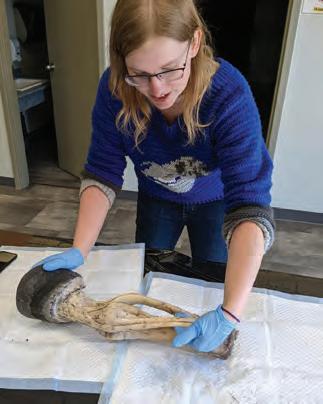
Ricard, emphasizing the importance of personal protective equipment for anyone handling aborted equine tissues.
Ricard joined the WCVM faculty as a lecturer in the college’s Department of Veterinary Biomedical Sciences in August 2024, and her new role includes teaching anatomy and histology to veterinary students.
“I think deep down somewhere in my soul I have always been a teacher,” says Ricard.
Read full story at tehrf.ca.
Dr. Claire Card, a professor and specialist in equine theriogenology at the WCVM, received the J.J. Murison Distinguished Veterinarian Award in fall 2024. The award is the highest level of recognition for a member of the Saskatchewan Veterinary Medical Association (SVMA).

JAN. 11-12: the WCVM was one of the industry supporters for the second annual Spotlight: Equine Veterinary Practice in Canada, which took place in Cochrane, Alta. During the twoday event, 60 students from Canadian veterinary colleges and veterinary technology programs explored careers in equinefocused practice and gained hands-on experience during equinefocused wet labs. A half-dozen WCVM students participated in the event’s activities. Dr. Steve Manning, WCVM’s associate dean of clinical programs, was also on hand to talk about the college’s equine internship and residency programs.
FEB. 1: members of the WCVM Equine Club hosted more than 200 young equine riders and their chaperones during the 2025 WCVM Equine Education Day at the veterinary college. Youth ranging in age from six to 18 years participated in short talks, tours and demonstrations that were organized by WCVM veterinary students. The annual event provides local equine clubs and stables with the ideal chance to spread greater awareness of horse health, management and disease prevention.
Dr. Conrad Wilgenbusch, a board-certified equine surgeon at Momentum Equine in Sherwood Park, Alta., passed away on Jan. 20. Originally from a ranch in southeastern Saskatchewan, Wilgenbusch spent time training reined cow horses and cutting horses before being accepted to veterinary school. After graduating from the WCVM in 2010, Wilgenbusch completed an equine internship in Texas and then began an equine surgery residency program at Iowa State University. He became a board-certified equine surgeon in 2015, and three years later, he joined Momentum Equine where he provided clients with surgical and sports medicine services. Wilgenbusch is survived by his wife Erica and their three children.
A round up of WCVM-related equine research articles that were recently published in peer-reviewed journals.
Koziy RV, Katselis GS, Yoshimura S, Simko E, Bracamonte J. “Temporal kinetics of serum amyloid A (SAA) concentration and identification of SAA isoforms in blood and synovial fluid of horses with experimentally induced septic arthritis, non-septic synovitis, and systemic inflammation.” Journal of Veterinary Diagnostic Investigation. Dec. 2024. doi: 10.1177/1040638724129987
Tucker M, Wilson D, Bergstrom D, Carmalt J. “Evaluation of procedures used to treat equine laryngeal hemiplegia using computational fluid dynamic analysis of an equine head model.” Frontiers of Veterinary Science (Sec. Veterinary Surgery). Nov. 2024. doi: 10.3389/fvets.2024.1478511
Woodman MJ, MacKenzie J, Osinchuk S, Husulak M. “Severe orbital hematoma with third eyelid swelling and prolapse following a blind maxillary nerve block in a horse.” Canadian Veterinary Journal. April 2024. 65(4): 359-362.
Viviani P, Lavado RA, Chavarria NH, Ragno VM, Montgomery JB. “Spring and fall blood concentrations of adrenocorticotropic hormone, insulin and thyroxine in healthy horses in Saskatchewan.” Canadian Veterinary Journal. April 2024. 65(4): 335-342.
Kim CS, Reisbig NA, Carmalt JL. “Contrast arthrography of the equine temporomandibular joint.” Frontiers in Veterinary Science. Feb. 2024. doi: 10.3389/fvets.2024.1368131
Visit tehrf.ca for more news updates.
“Our practice (Paton & Martin Veterinary Services) began to make contributions to the fund on behalf of clients when their horses passed away. We have found this to be a gratifying contribution and have been humbled by the responses that we have received from many of our clients. I think that it is very helpful for them to know that their horses have been honoured in such a fashion. The fund gives horse owners the additional opportunity to contribute to this very wor thwhile cause: supporting vital research in the areas of equine health.”
Dr. David Paton (DVM’78)
WCVM alumnus and TEHRF donor
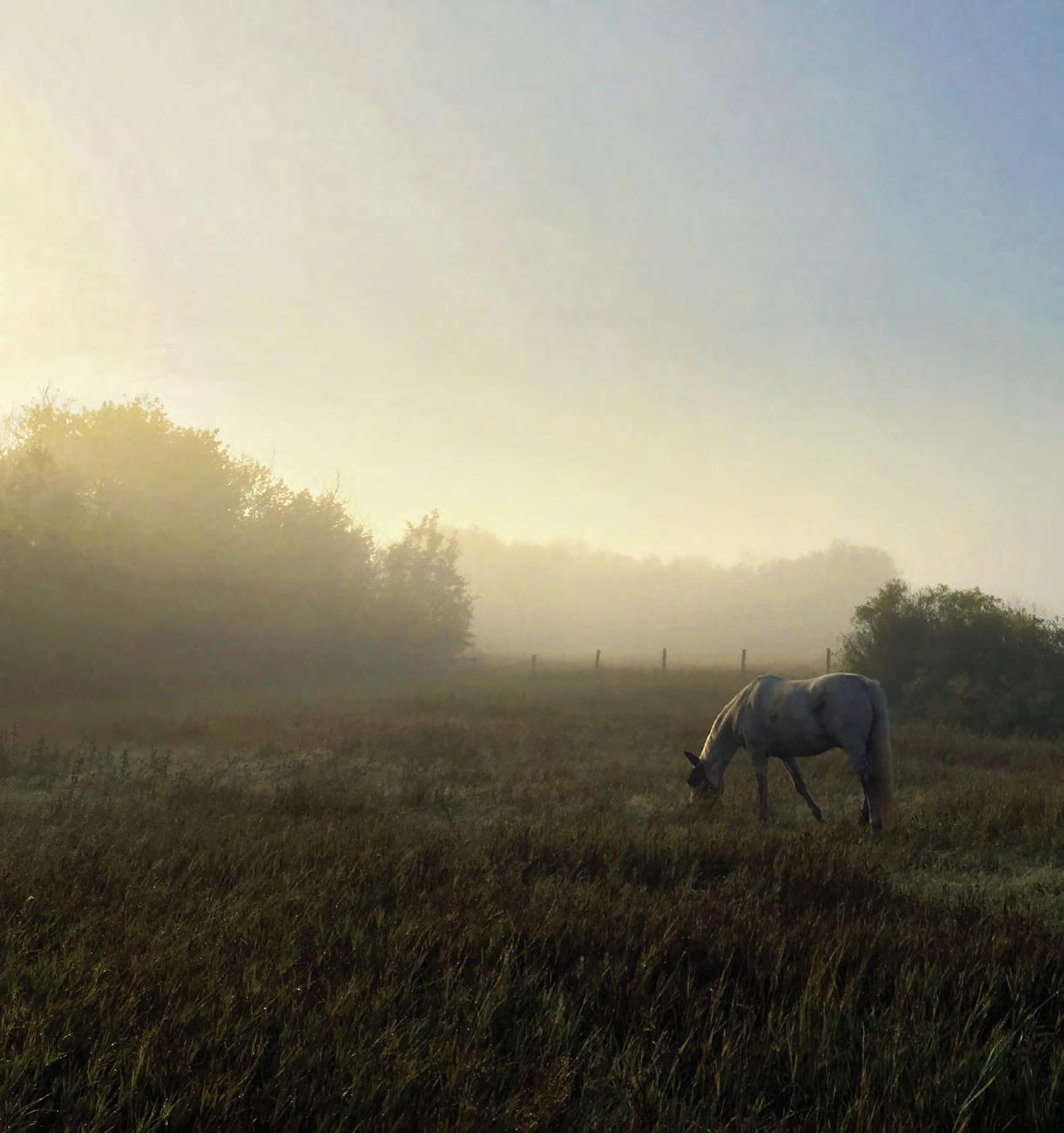
Pay tribute to the lives of your patients, clients and loved ones by making a donation to the Townsend Equine Health Research Fund (TEHRF) through its memorial program. Each time you give to the fund, we will send a letter to the client or loved one’s family acknowledging your gift to the equine health fund.
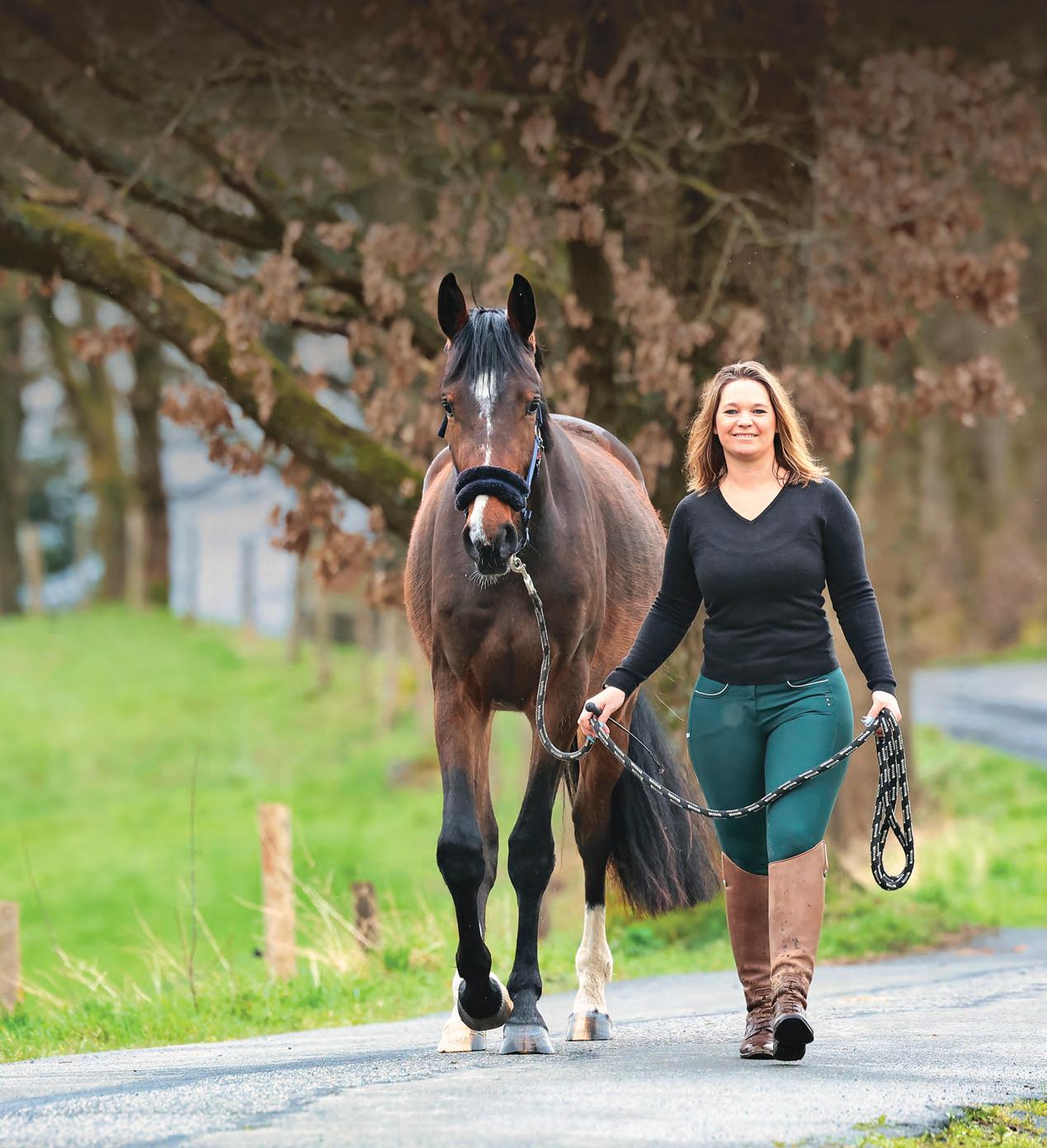





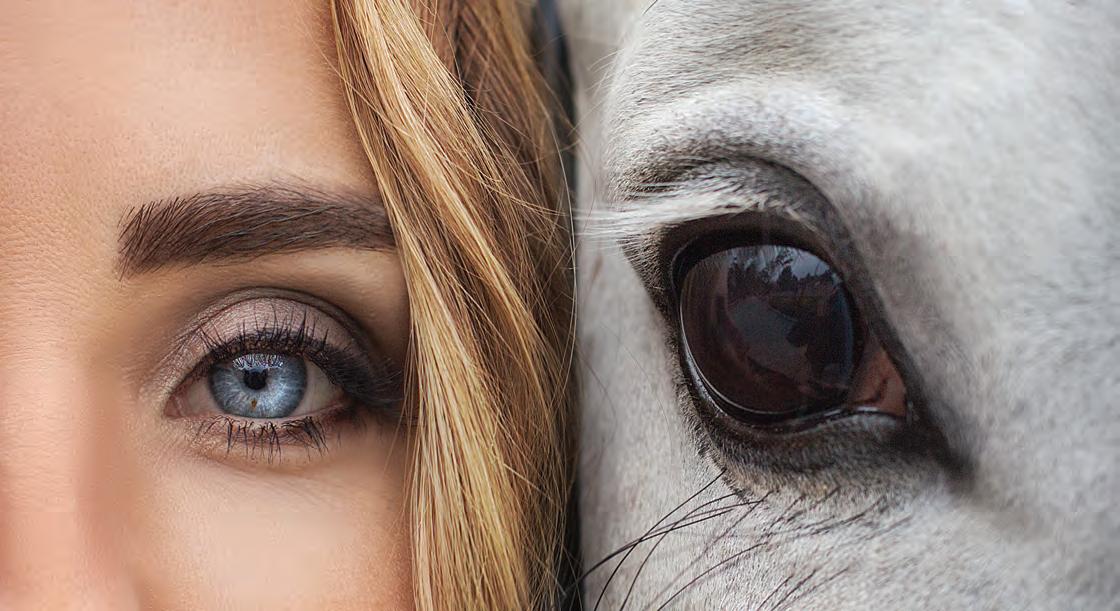
By Li Robbins
Humans have been known to have a superiority complex: a belief that we deserve dominion over the fish in the sea, the birds in the sky and, well, everything everywhere. Given our capacity for rational thought, not to mention our linguistic and creative abilities, we tend to see ourselves as the big cheese in the universe.
Non-human animals, on the other hand, have historically been viewed as lesser. A bird may sing, or a horse may whinny, but such things have often been dismissed as merely instinctual. So, back in the 1970s, when noted scientist Donald Griffin suggested animals could both think and reason, (acknowledging the ways in which they do so might be vastly different from ours), he opened the door to scientific inquiry into animal minds. Intentionally or not, he also opened the door to an important question: are human smarts always the best kind? After all, anyone working with horses knows that horse smarts can help you out, whether it’s the horse who reminds you to put her fly mask on, or the horse who refuses to enter a forest where a bear is lurking.
In 2024, a horse-brain related study
made mainstream news (a rare thing indeed), with headlines stating, “Horses Are Smarter Than Previously Thought.”
The study, published in the journal Applied Animal Behaviour Science, was based on an experiment demonstrating that horses are more cognitively advanced than previously believed. Whether or not that conclusion is correct remains to be seen, but certainly the way in which the study was reported indicates just how excited we get at any hint that horses are smart like us.
Perhaps part of that excitement is because these days domesticated animals are less likely to be viewed as pets and more as family members, and when we feel close to a member of another species, we feel literally akin. Still, when it comes to horses, Janet L. Jones, author of Horse Brain Human
Brain, The Neuroscience of Horsemanship, suggests that riders might be better off focusing on our differences instead.
“Emphasizing similarities between horses and humans encourages us to imagine that horses have human attributes,” says Jones. “Like the ability to reason, judge, assess risk, understand consequences and so on. When the horse makes a mistake, too many people are quick to blame, assuming that [it was] on purpose, with intent to harm us somehow. And that can cause punishment, or worse, to rain down on an innocent animal who was just being a horse.”
Gaining an understanding of how horses view their world can have numerous benefits, including the potential to improve safety in the saddle. As Jones points out, riding is a high-risk activity in which the sport’s “equipment” is a living and breathing creature “governed by a skittish prey brain.” As well, understanding the differences between human and horse perception and cognition inevitably matters when it comes to performance.
“For example, if your horse can’t even see an approaching jump very well, she can’t possibly do her best in clearing it with good form,” says Jones. “[Or] if you train strictly by applying pressure and releasing it, you’re limiting your horse’s ability to learn in all the other ways that do not demand pressure and are therefore more effective. And so on for attention, memory, coordination, emotion, communication, and all forms of sensory detection.”
Horses experience much of life through their senses, notably the famous five: sight, smell, touch, taste, and hearing. While understanding how each equine sense works can be valuable (e.g., knowing that a horse’s whiskers may help detect a bit coming his way should make you think twice about shaving them off), arguably the sense that creates the most obvious human-horse misunderstandings is vision and we’re not just talking about the famous blind spot behind the tail.
Horses have eyes that are eight times bigger than those of humans, so you might assume they’d be able to make out a great deal of detail — but if you did, you’d be wrong. That jump in front of you that’s crystal clear: not to a horse. The innocent puddle of pee at the other end of the arena: scary stuff since a horse can’t see much below eye level and nothing below her nose (at least not without a major head shift). Take the transition from light to dark: horses’ eyes adjust to changes in lighting slower than ours, creating problems when going from a bright, sunny day into a dimly lit arena.
Then there’s the obvious. Our eyes are in front of our heads; horses’ eyes are on the sides. Their panoramic range of view means that ill-defined objects may loiter mysteriously to one side or the other, or — even worse! — approach from behind as if to give chase. Spooks become more comprehensible (and your strategies to deal with them may improve) once you’ve viewed the world through a horse’s eyes. That’s something you can experience, virtually at least, via the 2024 documentary, Horses & The Science of Harmony, available on YouTube.
The documentary provides detailed analysis of the differences between horse and human vision. In fact, the analysis is based on Jones’ Horse Brain, Human Brain. Her work also underlies the film’s stunning digital illustration demonstrating true cross-species communication — the science behind why, when riding, you may feel as though the horse is reading your mind.
Achieving this sense of attunement requires a rider to have fine-tuned body awareness (i.e., proprioception), the horse ditto, creating a cross-species neural communication loop, one where horse and human activate each other’s neurons in their brains. If that wasn’t remarkable enough, viewed in light of the vastly differing natures of humans (predators) and horses (prey), this meeting of minds — or at least brains — is nothing short of extraordinary.
Naturally, anyone who’s experienced that magic with a horse will crave it again and again. A rider seeking to create the best circumstances to achieve that sense of harmony on a consistent basis would do well, says Jones, to focus on “less rather than more,” by taking into consideration horses’ “exquisite sense for touch.”
She says, “Instead of working to become stronger, heavier, more assertive with a horse, do the opposite. Teach your muscles and nerves to supply and control very light gentle touches. If your horse doesn’t pay attention to them, that’s because she’s had a lifetime of overriding and needs to be retrained for subtlety.”
Another recommendation is to pay more attention to a horse’s feedback, modifying your responses rather than constantly sending the horse new messages.
“Shut up for a while, consider carefully what the horse is conveying to you, and try different techniques of meeting his needs,” says Jones. “We think too much about horses meeting our needs and not enough about how we can meet theirs.”
Equine brain science is complex stuff, and a relatively new field given that the first precise magnetic resonance imaging of a horse’s brain was only published in 2019. For riders just beginning to take an interest in how their horses’
brains work, start by acknowledging that we do not experience the world in the same way a horse does.
“A horse’s brain is designed for vigilance, ours for concentration,” says Jones. “She communicates with her body, conversing with us all the time. Most of us barely notice her body language, ignoring almost every message she conveys. Her memory is fantastic while ours is riddled with overconfidence and engineered forgetfulness. Tasks that we have to strategize or reason out, she can remember. And so on.”
No doubt future research will uncover much more about equine brains, but any rider can use today’s knowledge to avoid common mistakes, such as asking for too much too quickly. Horses learn one task at a time, and a green horse in particular needs everything explained, from how to step over a pole in the arena to being shown that a hose is not a strange and dangerous snake.
Positive reinforcement can also play a significant role, but it doesn’t necessarily have to be food-based, as those with horses who love scratches (to name just one example) well know. If you are using edible rewards, Jones recommends saving them for special performance and giving them at “the perfect moment to achieve neurochemical action in the horse’s brain.” The reward must follow the noteworthy behaviour within a couple of seconds for it to be reinforced in the brain.
The moral of the story: As riders it’s our job to be a horse’s teacher. Or, as Jones puts it, “It’s our responsibility to understand how difficult it is for a prey animal to live in a human world, then to try to make their job easier.” b
> Li Robbins is a frequent contributor to this magazine — read her bio on page 102.



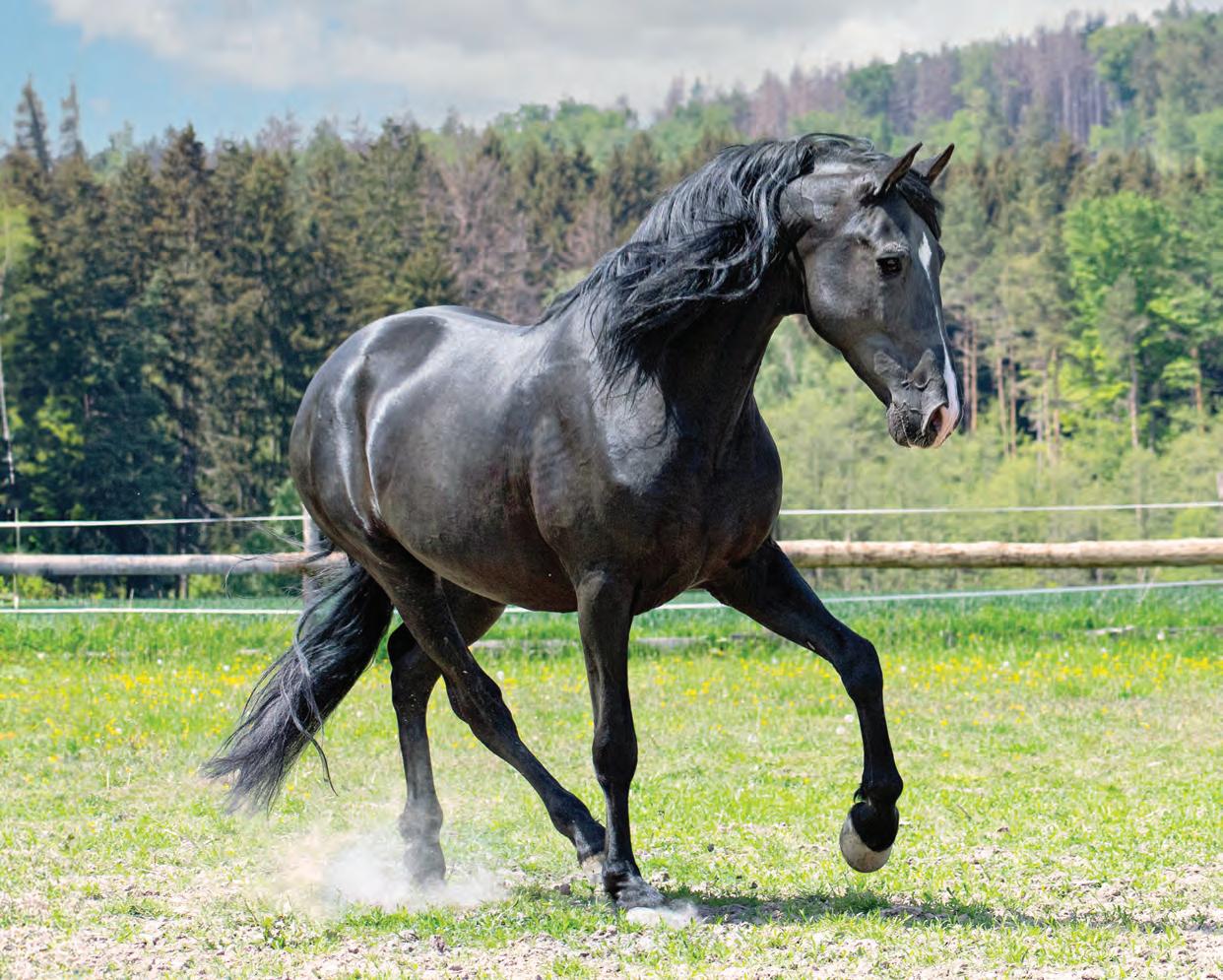
By Alexa Linton, Equine Sports Therapist
When you think about injury prevention, tendon strengthening, joint lubricating, and health supporting interventions for your horses, do you also consider improving their proprioception? Supporting this often-overlooked aspect of function can be a gamechanger for our horses.
All of us have firsthand experiences with the power of proprioception in our own bodies, whether we realize it or not — when we walk into a room without running into a wall, move through an uneven forest without tripping, walk over a narrow bridge or log without falling, or walk under a low hanging branch or roof without hitting our head. Proprioception is defined as: The awareness of the body in space. It is the use of joint position sense and joint motion sense to respond to stresses placed upon the body by alteration of posture and movement.
When proprioception is not working well in ourselves or in our horses, it may
be perceived as clumsy, accident-prone, or distracted. If you’ve ever met a horse that tends to trip, injure himself, hit his head, feel “out of body” or unaware of his surroundings or footing, or has issues with balance, this is likely at least part of the issue. Thankfully, proprioception is something we can support, improve, and build on because it is based in our neural networks and nervous system, and therefore can shift and change for the better. And that’s exactly what we’ll be talking about in this article.
First, let’s zoom in on the geeky side of proprioception to understand what is
When horses are kept on flat surfaces without variation in footing, they can be prone to slipping or stumbling and resulting injury.
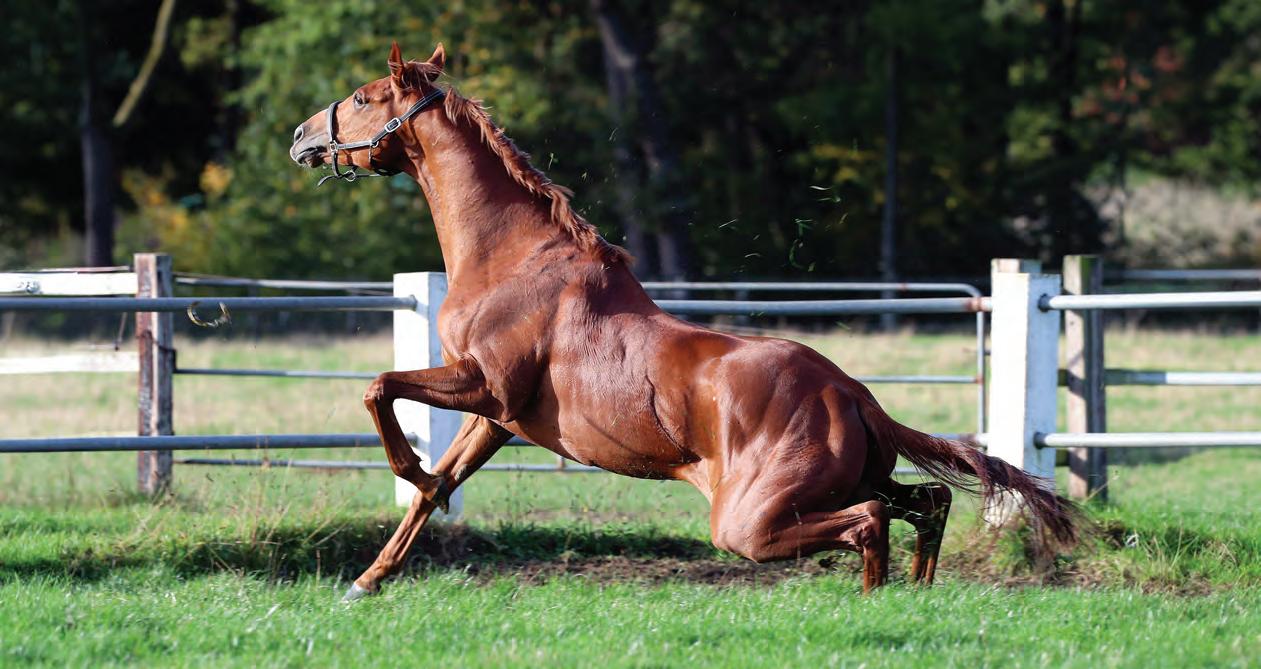
really happening at a more microscopic level. Proprioceptive senses in ourselves and our horses include the sense of position and movement of the limbs and trunk, the sense of effort, the sense of force, and the sense of heaviness. The receptors involved are located at the level of the skin, the muscles, the tendons, the joints, and in horses, at the hooves and the vestibular system. These receptors transmit information about limb movement and position to the related centres in the brain. This is a group effort, with many receptors working together to provide accurate information and produce signals during a movement, giving the brain and body as much information as possible about the endpoint position of a limb. This input from multiple receptors then goes to the central body neural map to accurately (hopefully) determine the location of our limbs in space.
What is the purpose of proprioception? It is the body’s strategy for preventing injury by improving awareness and balance while adapting to changing external conditions. What can reduce proprioception? Injury, aging, physical, emotional or mental stress, poor hoof care or balance, isolation, and neurological disorders. Another factor is sterile, flat, unvaried environments with no challenge to this essential
system, reducing demand on receptors leading to a patchy neural map. What we want is a robust neural map supported by many well-functioning receptors that are attuned and adaptable to changing landscapes and situations.
Now that the geeky stuff is out of the way, it’s time to look at what we can do to
support our horses and ourselves to improve proprioception capacity. We know that movement over varied surfaces, footing, and terrain can positively challenge the receptors and build proprioception. Many horses, like many humans, live on and move over flat, unvarying surfaces. A human living in the city,

Moving over different types of terrain allows the horse to improve awareness and balance and adapt to changing conditions.
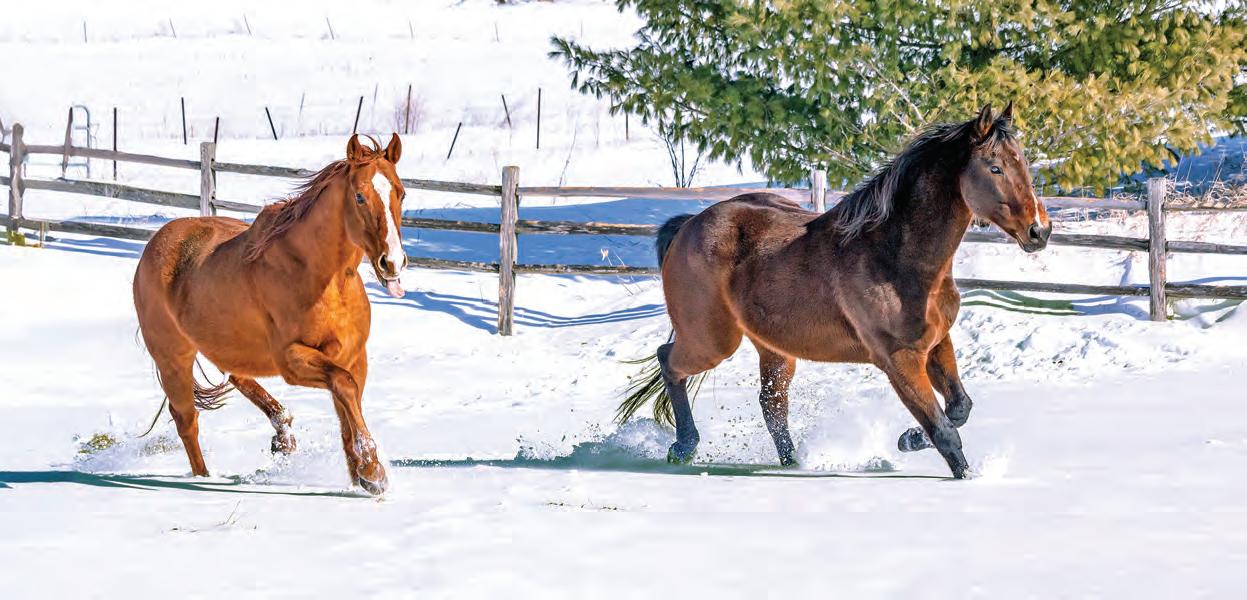

for example, may rarely encounter varied or uneven terrain, or surfaces like sand, mud, or gravel. With fewer receptors in the joints, muscles, and tendons prepared for navigating such surfaces, this person might be more prone to injury, tripping, and loss of balance when they encounter changes. Their nervous system has not had the opportunity to acclimatize and adjust by building new neural networks and updating neural maps. The very same is true of our horses. Many horses live on just a few types of footing and often on flat surfaces. They also tend to live alone. Ironically, this is often done to prevent injury, when in fact their lowered proprioceptive capacity from these exact measures makes them more prone to injury.
Recently, a participant in one of my programs shared that her horses, living in the Arizona desert on hard-packed earth, were prone to slipping when it rained or when walking over mud, as their systems were not used to this footing. On the other
hand, my mares freely canter over mud daily at tight corners with no issue; their bodies have adjusted to the increased demand via a proprioceptive update to their neurological networks, connecting their brain to their hooves, muscles, tendons, joints, and vestibular centres.
To increase proprioceptive capacity, we need to increase the demand in ways that are safe, supportive, and allow choices for our horses. We also need to reduce harmful and unnecessary stress in the nervous system. The easiest way to implement this is through horse-keeping that is constantly improving their proprioception, balance, and tissue and joint adaptability, as well as providing enrichment and reducing stress.
Look around your paddock or field and see it through the eyes of your horse. Does it enhance their proprioception by encouraging movement across diverse surfaces (sand, grass, soil, mud, pea gravel) and terrain (roots, hills, ditches,
branches, logs, poles)? Does it incorporate enriching elements that promote choice in movement such additional hay nets, enrichment stations, and natural obstacles? Does it include interaction and relationships with other horses (which is one of the best ways to develop proprioception)? If not, is it possible to add some of these aspects to your horse’s living spaces? It doesn’t cost much — basically the cost of footing — to make a big difference. If you are in a boarding situation, could you work with your barn owner/manager to add some of these elements to your horse’s space?
The May/June 2022 issue of this magazine included my article on horse track systems (Get Your Horse on a Track System: Create a Paddock Paradise), and now I’m putting the finishing touches on a new online course called How to Build a Horse Track System (on the West Coast) because I love them! I haven’t found anything better that mimics a horse’s natural environment while promoting movement, creating enrichment, and improving proprioception and balance. Horses naturally thrive in a herd environment, roaming over varied terrain for hours every day in search of forage. If you seek more understanding of proprioception, watch videos of herds of Icelandic horses moving at top speed over very challenging terrain. Their bodies and nervous systems have adapted to their environment, allowing them to be balanced, strong, and surefooted. I hope this encourages you to add varied terrain and obstacles, with enriching elements that promote movement across it all.
Another excellent way to help develop proprioception in horses is hand-walking, as it is great for your relationship and allows navigation of new or challenging terrain in a controlled way. On your walk, find small hills, branches, root systems, and changes in footing like puddles, mud, sand, gravel, and grass. You can also do inhand work with obstacles like pedestals, bridges, poles, barrels. A good exercise is to ask your horse to walk over a pole that is lined up with their body, so that their left front and hind are on one side and their right front and hind are on the other. This is tricky but great for connecting the brain to the feet — just what we want! Another excellent exercise is a narrow bridge obstacle, promoting both balance and awareness of all limbs.
More easy ways of working with different destabilizing surfaces include incorporating a gym mat (it’s easy to find a used one), foam mats, or other “strange” footing into your groundwork routine. These types of unstable surfaces activate the receptors to work on balance. Surefoot equine pads are also a great tool to help a horse recalibrate their nervous system. These pads come in various firmness levels and angles and are a valuable addition to your equine wellness toolkit.
Lastly, doing bodywork with your horse including cranial work, nerve release, myofascial release, acupressure, and more can promote a healthier connection to the receptors in the tissues, while also improving communication between the tissues, the brain, and the body’s neural maps. For many horses, being more connected to their limbs and more aware of where they are in space is deeply supportive on many levels, as it can reduce the chance of injury and improve health and quality of life. And always remember the importance of balanced hooves, which are essential for supporting proprioception.
Improving proprioception benefits both you and your horse by enhancing balance, reducing injury risk, and supporting overall function. By prioritizing proprioception through environmental adjustments and targeted exercises, you can help your horse become more surefooted, balanced, and confident.
Wishing you happy trails until next time! b
Resources: Regarding movement science and proprioception in horses, one of my favourite resources is Kathy Sierra of Pantherflow
> Alexa Linton is a regular contributor to this magazine. Read her bio on page 102.

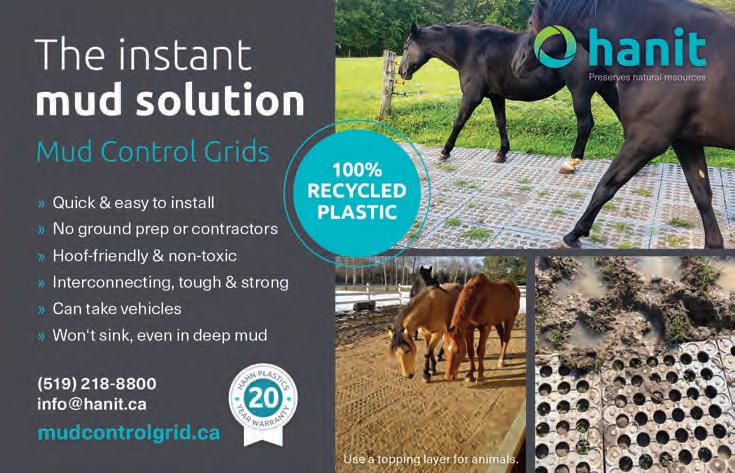










“Going far beyond the call of duty. Doing more than others expect. This is what excellence is all about.

By Tania Millen, BSc, MJ
In 1971, Ron and Margaret Southern stood in an old cattle feedlot adjacent to rolling, grassy meadows, considering whether the property might fulfill their dreams. The meadows were part of a chunk of land located approximately 20 km southwest of burgeoning downtown Calgary, Alberta, population 430,000. Daughters Nancy and Linda, aged 15 and 8, were involved in the local riding scene, but the older Southerns had noted a lack
It comes from striving for and maintaining the highest standards, looking after the smallest detail and going the extra mile.
Excellence means caring. It means making a special effort to do more.”
R.D. Southern
of opportunities for grassroots show jumpers to grow into international competitors. Never a couple that let business opportunities slide by, the Southerns thought: What if we built a facility that brought the best show jumpers in the world right to our doorstep?
“The goal of developing Spruce Meadows was to create a show jumping venue to allow a springboard for Canadian athletes, so they could excel
and compete on an international stage,” says Linda Southern-Heathcott, President and CEO of Spruce Meadows.
And the Southerns did just that. On April 13, 1975, Spruce Meadows opened to the world.
Fifty years later, the venue colloquially known as “Spruce” covers more than 500 acres, welcomes over half a million visitors every year, and offers stabling for 1,000 horses. In 2025, Spruce Meadows will offer
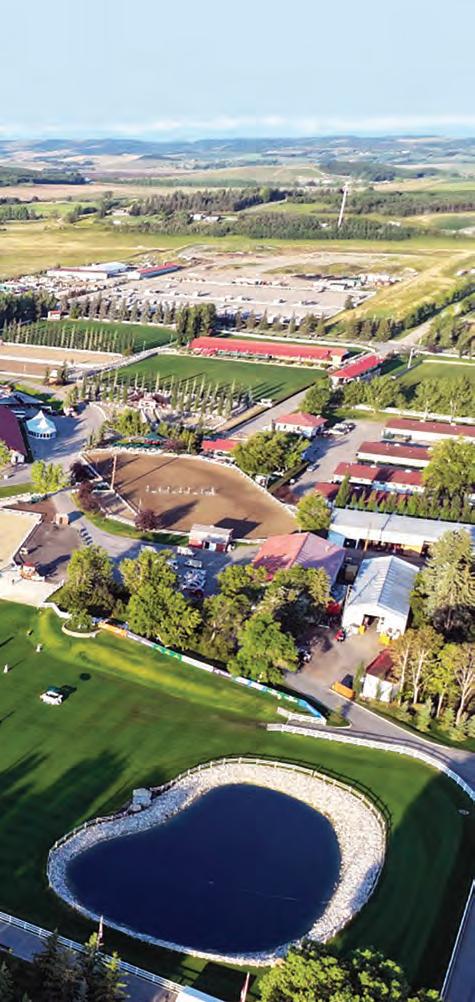
$11.4 million in prize money during five major tournaments — the Continental, National, Pan American, North American, and Masters. During the Masters in September 2025, a $5 million prize purse will be offered for one class — the biggest show jumping prize in the world. Those 50 years, from undeveloped meadows to internationally renowned show jumping facility, is a business success story that has dramatically altered the fate of show jumpers around the world.
Spruce Meadows has shone a bright light on show jumping in Canada and lifted Canadian riders to the upper echelons of the sport. The best show jumpers of the last 50 years have competed at Spruce Meadows, allowing up-and-coming Canadians to watch and
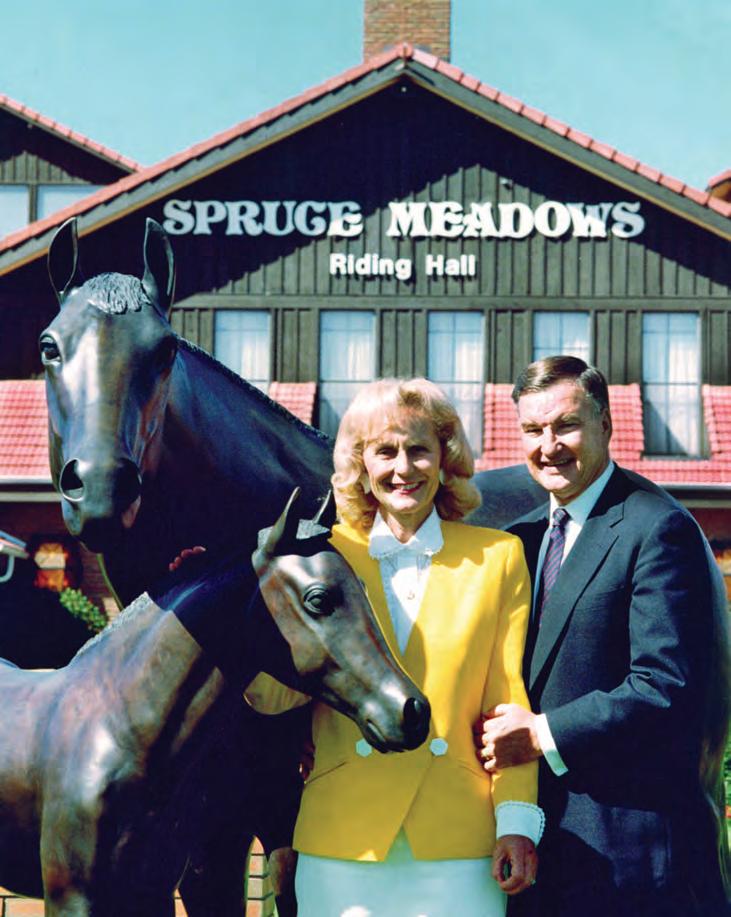
ride with the best.
“The successes of our international riders on the international stage, I believe, is partly due to Spruce Meadows,” says Southern–Heathcott. “We’ve brought international athletes to Spruce Meadows, provided great prize money, and have been a leading venue in the world. That has provided an opportunity for Canadians to imagine what they can be.”
Riders from 65 countries have competed at the venue. Lesser-known riders from Libya, Pakistan, Uruguay, and other countries not particularly recognized for their show jumping prowess have competed against wellknown riders from France, Ireland, and Sweden. One and all, riders come to “Spruce” to challenge the courses, their horses, their skills, feel the unique atmosphere, and try to win some cash.
By flying in competitors and hosting a Nations’ Cup competition every year since
1977, Spruce Meadows has insured that big-money classes are attended by the world’s top show jumpers and allowed Canadians to compete against riders they’d rarely meet beyond Europe. As such, Spruce Meadows has helped develop the careers of Canada’s best show jumpers: Gail Greenough (1986 World Show Jumping Championships); Ian Millar (ten Olympic Games, Olympic silver medal, two Pan-American Games gold medals); Linda Southern (1996 Canadian Olympic show jumping team, CEO and president of Spruce Meadows); Eric Lamaze (2008 Olympic Games gold medal); Erynn Ballard (part of Canada’s 2006 winning Nations’ Cup team at Spruce Meadows and still a Canadian team regular); Tiffany Foster (three Olympics Games, numerous Nations’ Cup teams); and others.
“I think that Spruce Meadows has been a huge contributor to Canadian show

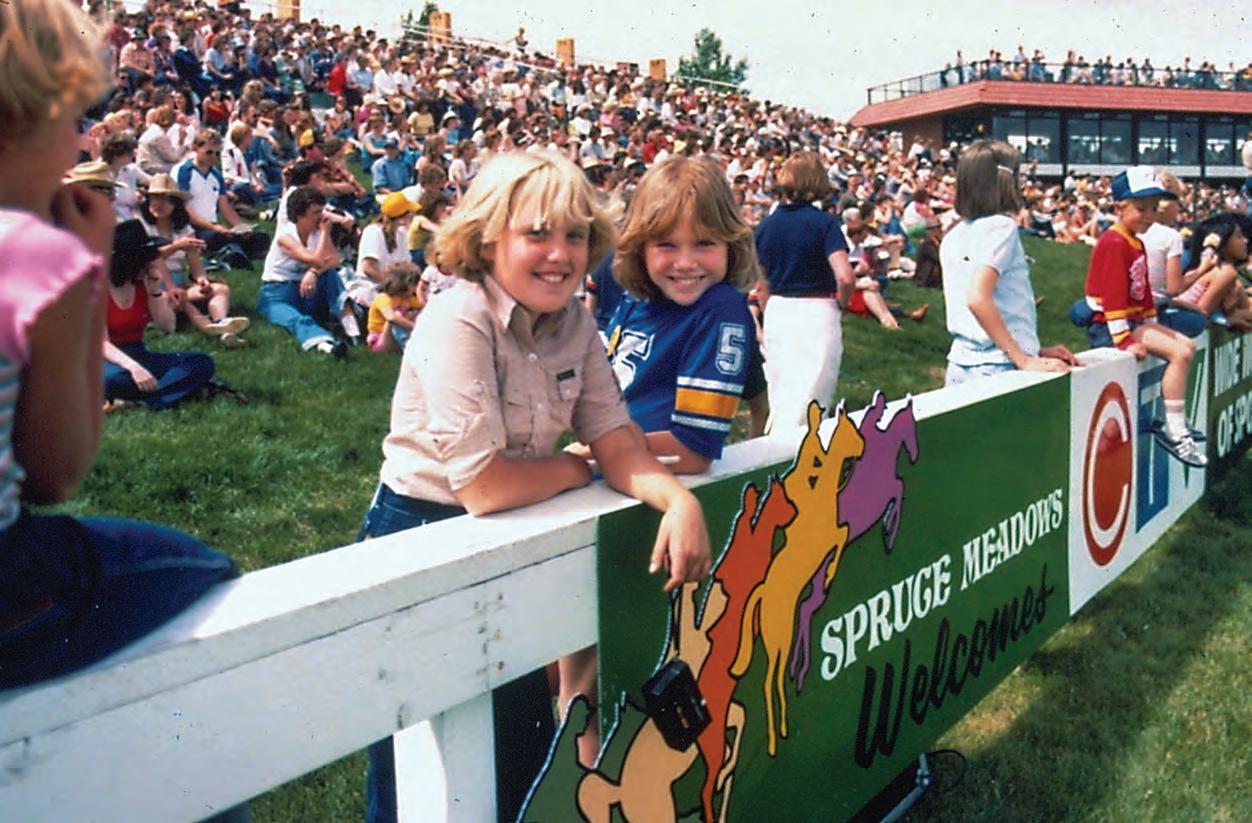

jumping success, together with our course designers, sponsors, and the fans,” says Southern-Heathcott.
Right from the start, Spruce Meadows partnered with local, regional, and international businesses to offer substantial prize money. Those funds encouraged riders from far and wide to attend.
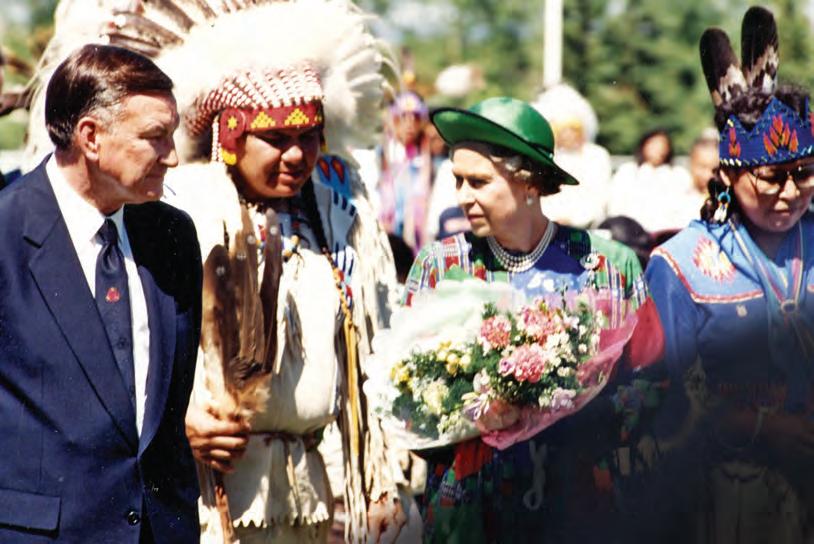
“It was difficult in the beginning to have athletes recognize Spruce Meadows,” says Southern-Heathcott. “We did that by bringing sponsorships to the table. We also had a good fan base and strong media reporting. Then the athletes came for the competition and the whole experience.”
The first grand prix was held in 1976, sponsored by Fleischmann’s, offered $10,000 in prize money, and was
challenged by top riders of the day: Bo Mearns, Frank Salinger, Graeme Thomas, Jim Day, John Simpson, Linda Allen, and others. It was won by Canadian show jumping team veteran Michel Vaillancourt.
“Over 20 sponsors have been with Spruce Meadows for 49 years,” says Southern-Heathcott. “It’s rare for any sport to have partnerships and relationships that have gone on that long.”

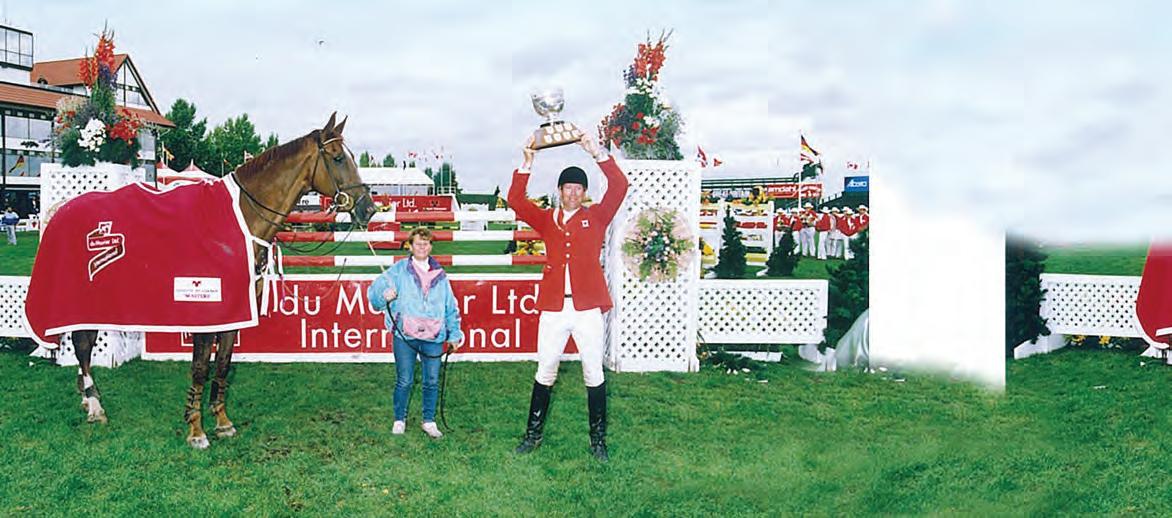

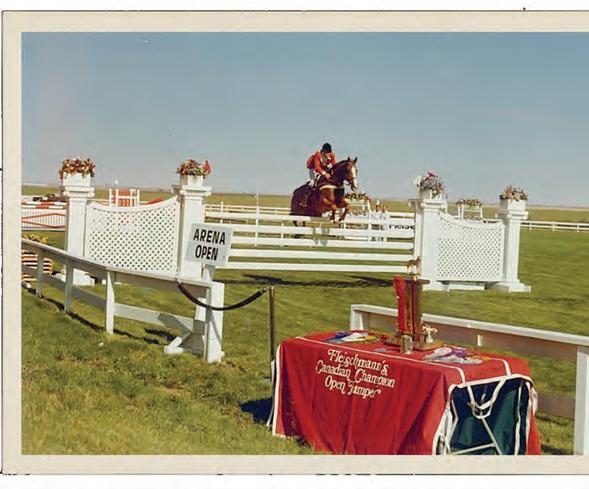

Champion of the very first grand prix at Spruce Meadows, the 1976 Fleischmann’s Grand Prix, was Michel Vaillancourt, silver medalist at the 1976 Olympic Games in Montreal, riding Branch County.
To date, over $200 million in sponsorfunded prize money has been distributed to athletes.
Bank of Montreal (BMO) sponsored the first Fédération Equestre Internationale (FEI) Nations’ Cup in 1977, and team riders and horses came from across the globe to compete. West Germany won the cup and all the international riders went home raving about the venue. Fifty years later, BMO still sponsors the BMO Financial Group Nations’ Cup at Spruce Meadows — historically the richest nations’ cup offered in the world. Germany has won the cup 11 times, Great Britain 10 times, United States nine, and the Canadian team has won three times in 2006, 2014, and 2021.
The top 20 prize-winning riders at Spruce Meadows have earned over $1 million each with Eric Lamaze topping the list at over $6.7 million. The other Canadians on the top 20 list include: Ian Millar (over $3.7 million), Mario Deslauriers (over $2.8 million), and Tiffany Foster (over $2 million).
The year 2000 marked the first $1 million grand prix, which was won by Rodrigo Pessoa. The 2025 CPKC (Canadian Pacific Kansas City) International, presented by Rolex, will offer a $5 million purse.
But Spruce Meadows wasn’t just envisioned as a competition venue. The larger mission was rider development. Right at the start, German riding master Albert Kley was hired to develop a junior riding
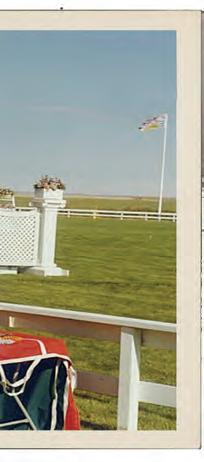
and Ron
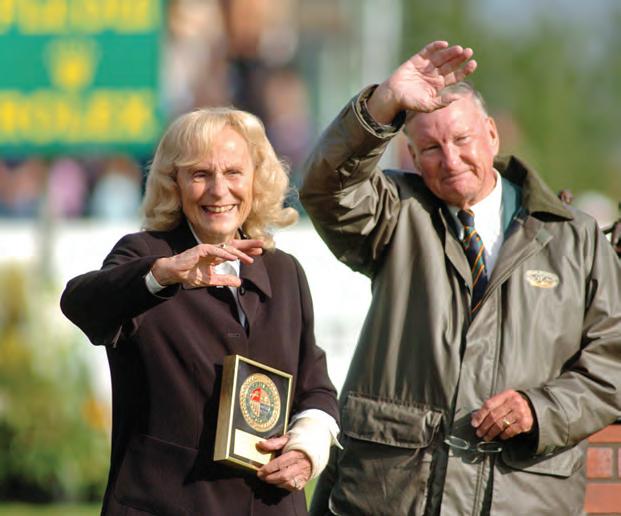
program. Kley developed reams of riders and horses for 40 years while winning more than 50 grand prix, including the Texaco Derby in 1984 with Spruce Meadows-bred and produced Sebastian.
Kley was also tasked with developing a breeding program and Spruce Meadows Hanoverian (German Warmblood) stallions have helped increase the quality of performance horses bred in Canada.

All horses bred at the venue are named with the SM prefix, and their quality is recognized throughout the industry today. Albert Kley passed away in 2016. Jonathan Asselin was also one of Spruce Meadows’ trainers, and became a member of Canada’s show jumping team, placing 15th at the 2000 Olympics. Asselin and Nancy Southern subsequently married and their son Ben
Asselin now operates Attaché Stables near Calgary. Ben began jumping at FEI levels at age 16 and has become a regular member of Canada’s show jumping team.
Today, British Columbia’s Brian Morton is Spruce Meadows’ Horse Program Professional. He trains and rides Spruce Meadows’ homebred horses in upper-level competitions while Andrew More is the Horse Program Manager.


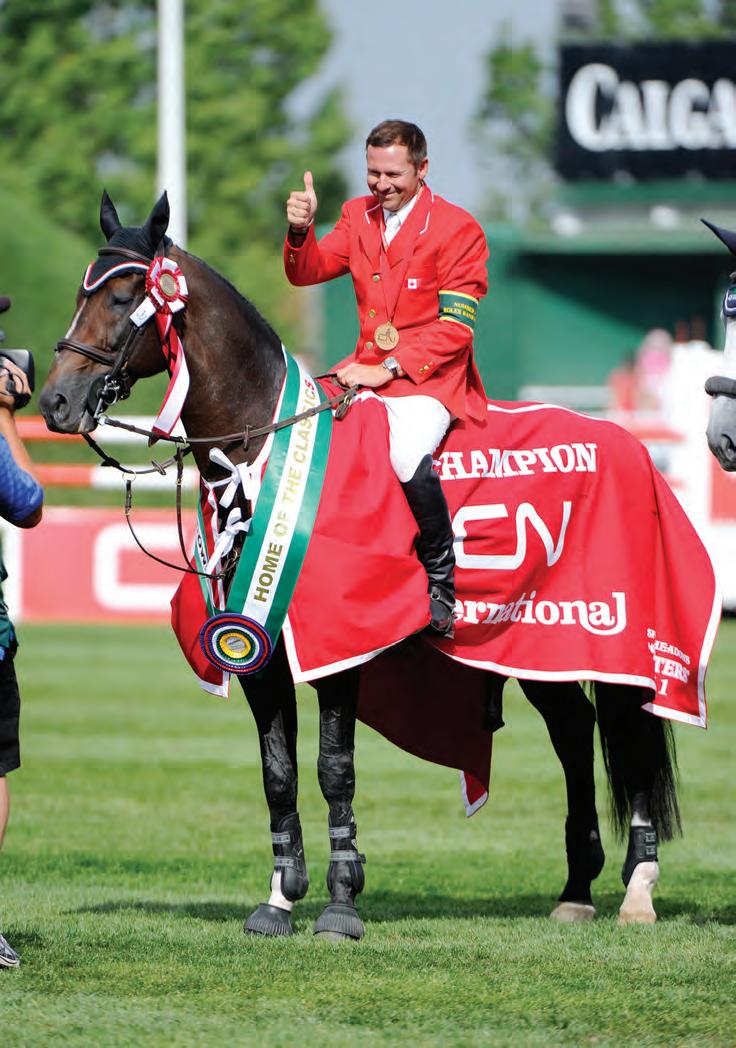

Spruce Meadows was situated adjacent to the growing city of Calgary, and Calgarians, now numbering 1.4 million, have become well-versed in show jumping lingo. Encouraging fans to attend competitions was imperative for sponsors to receive return on investment and to grow the facility into more than just a competition venue. So in 1983, Spruce Meadows held its inaugural equi-fair called Equitana North America, which drew shoppers and nonequestrians to its booths and demonstrations. In 1984, the first Breeds of the World exhibition brought different horse breeds to the venue and allowed spectators to learn about the merits of different breeds. In 1985, Prairie Dogs — a dog competition was introduced, along with a fireworksladen Evening of the Horse.
In 1990, the late Queen Elizabeth II attended Spruce Meadows and presented the inaugural Queen Elizabeth II Cup. Fast-forward to 1999 and the popular Name the Foal contest began whereby every year the public sends in their favourite names for three of the Spruce Meadows’ Hanoverian foals born that year. Those who submit the winning names are then invited to meet the foals in person later in the year.
In 2001, Spruce Meadows expanded their non-horsey offerings further, hosting the inaugural international Christmas Market, which is still going strong every year. In 2009, the Eyes on the Wetlands Education Program began, which brought school tours to the venue to learn about the environment and the horse.
Many of the displays at the venue involve horses. In a nod to their commitment to developing younger riders, Spruce Meadows hosted the FEI
June 5-8, 2025: Continental presented by Rolex
June 11-15, 2025: National presented by Rolex
June 26-29, 2025: Pan American presented by Rolex
July 1-6, 2025: North American September 3-7, 2025: Masters
A minimum of $5,000 in prize money will be offered for each competition in the summer and Masters tournament, even the 1.10 m level classes.
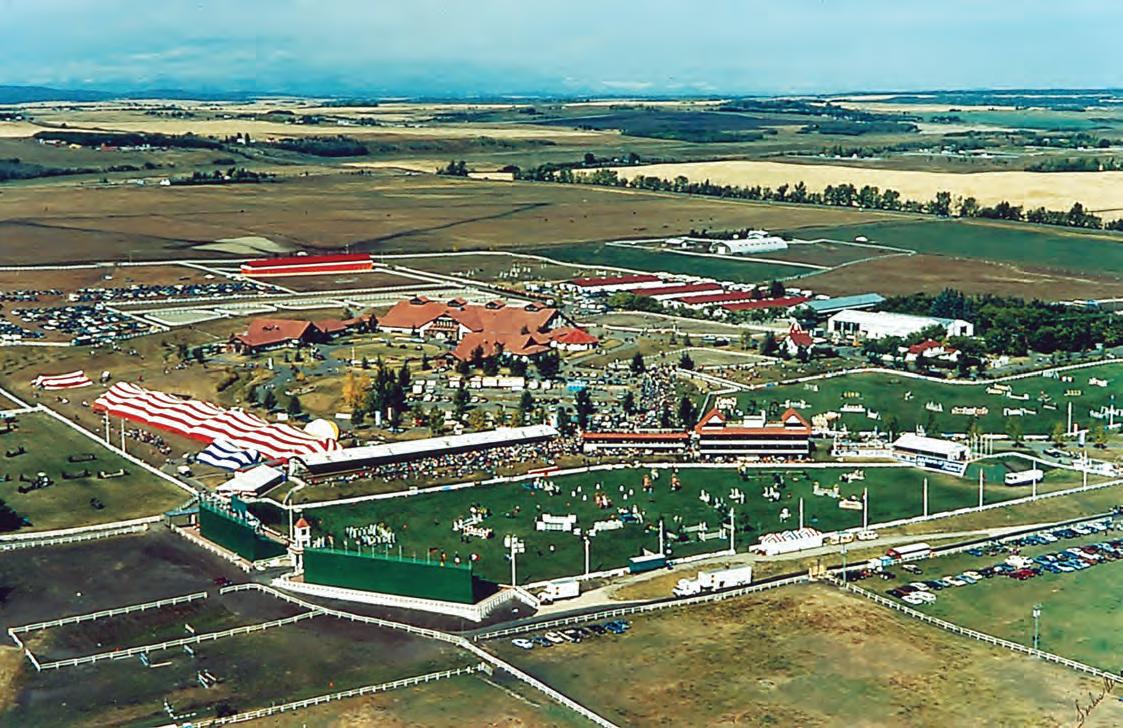
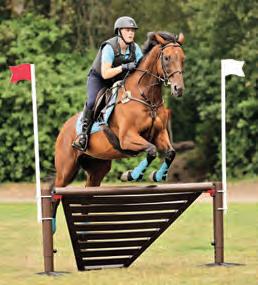
• Telescopic standards are stable and easy to use
• Feature an FEI-approved safety cup system
• Backed by an unrivalled 5-year guarantee
• Incredibly versatile and lightweight
• Make excellent training aids
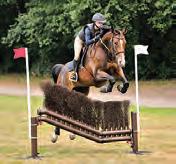

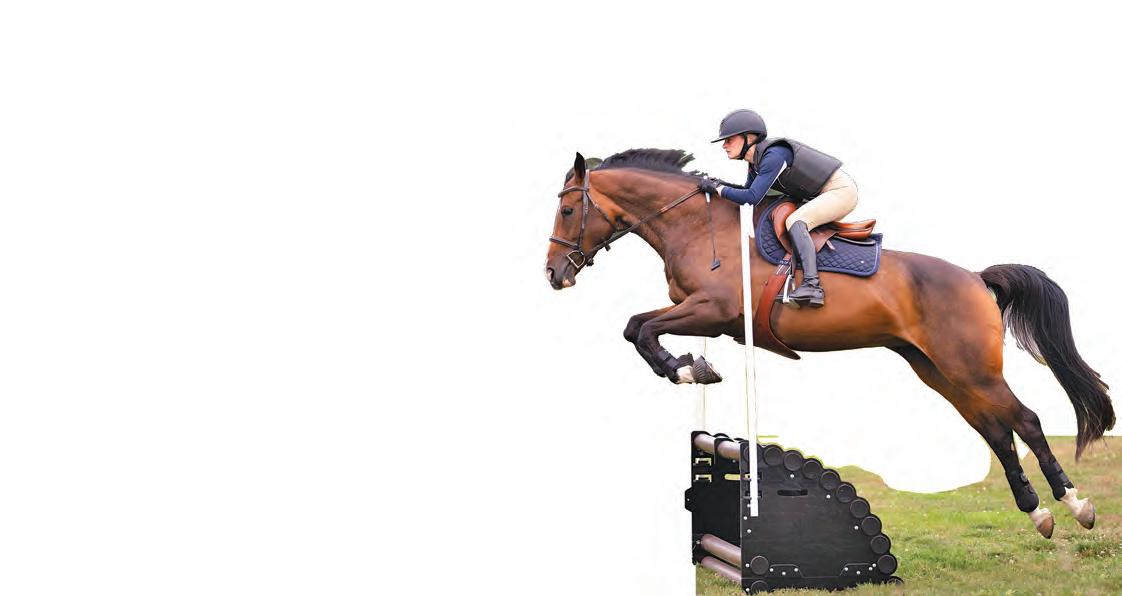





Children’s International Jumping Final in 2003 and 2006. In 2010, Germany’s Celle stallions performed at the Masters for the first time, while the RCMP Musical Ride entertained spectators in 2011. They have both performed in other years, too. In 2012, the ashes of Eric Lamaze’s great horse, Hickstead, were given to Spruce Meadows as his final resting place.
High stakes show jumping continued in 2013 when the Rolex Grand Slam of Show Jumping was announced and Canadian Pacific (CP) offered a $1.5 million purse for their International Grand Prix.
In 2015, Spruce Meadows launched it charitable Leg Up Foundation, which supports education, health, wellness, and amateur and grassroots sport. It also offers the former Eyes on the Wetlands education program to help students in grades four through six learn about ecosystems, how animals learn, and the environment. The program is offered at no cost to participating schools.
In 2017, Spruce Meadows continued entertaining, adding a
corn maze, concerts, and summer outdoor movie nights. In 2018, the venue added a Canadian Professional Soccer Team — Cavalry FC — to their lineup.
As Spruce Meadows has expanded their entertainment offerings, it has also become a hub around which like-minded horse people have built their own equestrian facilities. The area southwest of Calgary is now dotted with some of the top equestrian operations in the country. By following the motto “good friendship, good commerce and good sport,” the Southerns and their partners have built a facility that not only advances the aspirations and careers of Canadian and international riders but also offers high return for sponsors and family-style entertainment in a relaxed country setting.
Ron and Marg’s influence on Canadian show jumping has not gone unnoticed. In 2006, they were inducted into the Canadian Sports Hall of Fame for contributions to equestrian sport. Ron passed away in 2016, but this was just one honour that he received. Many others acknowledge his business acumen and
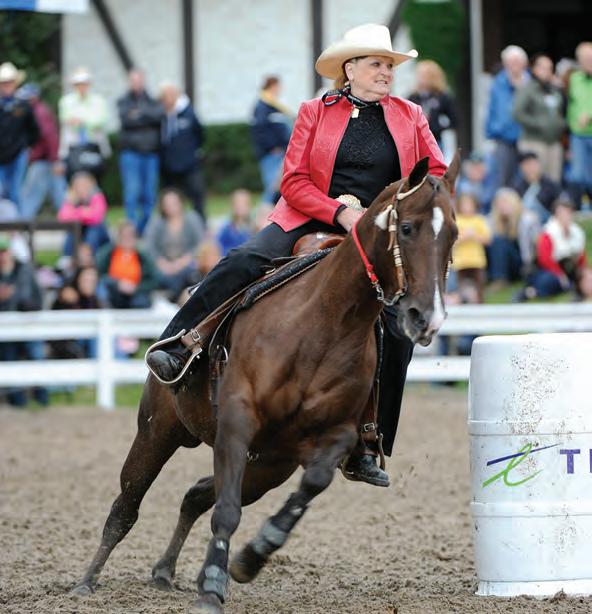
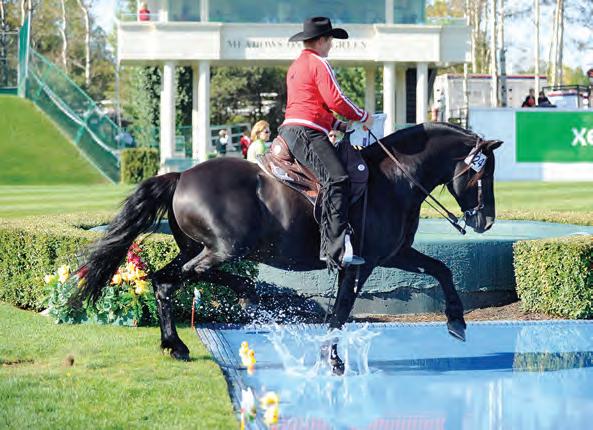

The fan-favorite Battle of the Breeds, a staple of the Masters in September for several years, featured breed-specific teams competing in disciplines including barrel racing, jumping, trail, and driving in a spirited and friendly competition.

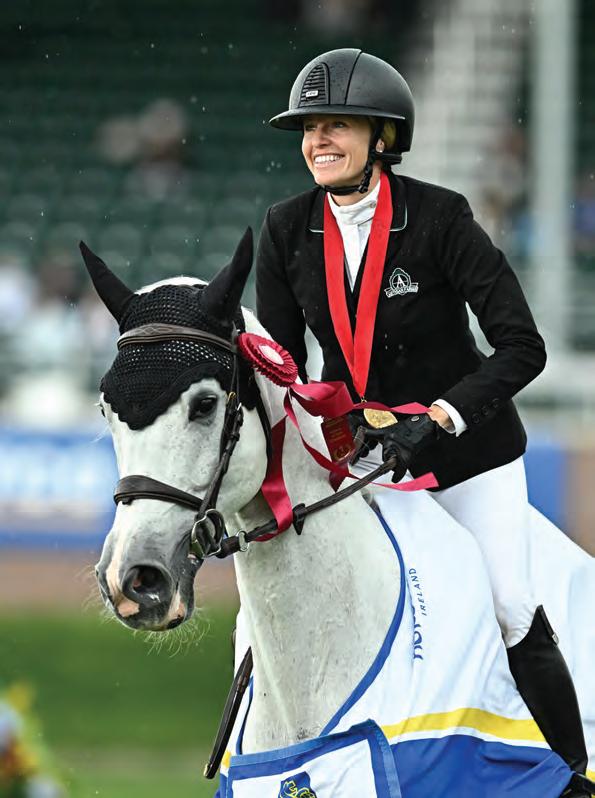
Tiffany Foster was named the top-ranked female show jumper in June 2024 when she won the RBC Grand Prix on Battlecry.


In a private ceremony, held at the McDougall Centre in Calgary, Alberta on February 23, 2023, Spruce Meadows cofounder Margaret Southern was presented the Queen Elizabeth II’s Platinum Jubilee Medal by the Lieutenant Governor of Alberta, Her Honour, the Honourable Salma Lakhani AOE, B.Sc., LLD (hon). This commemorative medal was created to mark the 70th anniversary of Her Majesty Queen Elizabeth II’s accession to the Throne as Queen of Canada. The Medal recipients come from a variety of professional backgrounds and have left a positive mark on their professions, communities, and provinces. Each has demonstrated exceptional qualities and outstanding service in their own field.
L-R: Nancy Southern (Chair & Chief Executive Officer, ATCO Ltd. & Canadian Utilities Ltd.); Lieutenant Governor of Alberta, Her Honour, the Honourable Salma Lakhani AOE, B.Sc., LLD (hon); Margaret Southern CC, LVO, AOE, B.Ed., LLD. (Co-Founder, Spruce Meadows); His Honour, Dr. Zaheer Lakhani; Linda SouthernHeathcott (President & CEO, Spruce Meadows).
"As a professional horse trainer, Dynamint Equine Leg & Muscle Rub is an important aspect of my program. Dynamint is a natural product that has a cooling effect, it calms tired, sore muscles and rejuvenates horses keeping them feeling their best. I use Dynamint on my horses and myself. The results I have experienced have not been matched by any other product in the market. For long hauls and after hard workouts Dynamint is the only product I use on horse's legs. If you are looking for a product that is safe on skin and delivers results, trust Dynamint Equine Leg & Muscle Rub. Your horse will thank you!"
Jill Barron
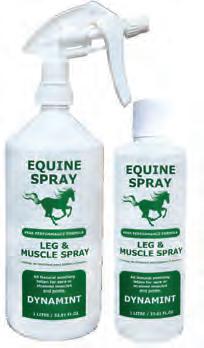

All natural soothing lotion for sore or strained muscles and joints.
Available in 1L spray bottle for easy and quick application to larger areas, or a 500ml rub bottle.
A soothing combination of natural essential oils in a gentle cream base. Specially formulated with natural ingredients to assist in the relief of leg, muscle and joint strain.
Purchase Online at HorseGearCanada.com (Health & Grooming)
Distributor: Canadian Centurion 1-800-361-3860
BC: Janian Imports • (604) 462-9238
E-Mail: intbiosys@shaw.ca

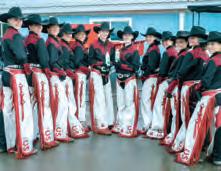
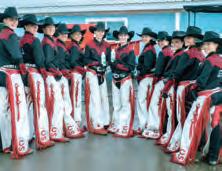
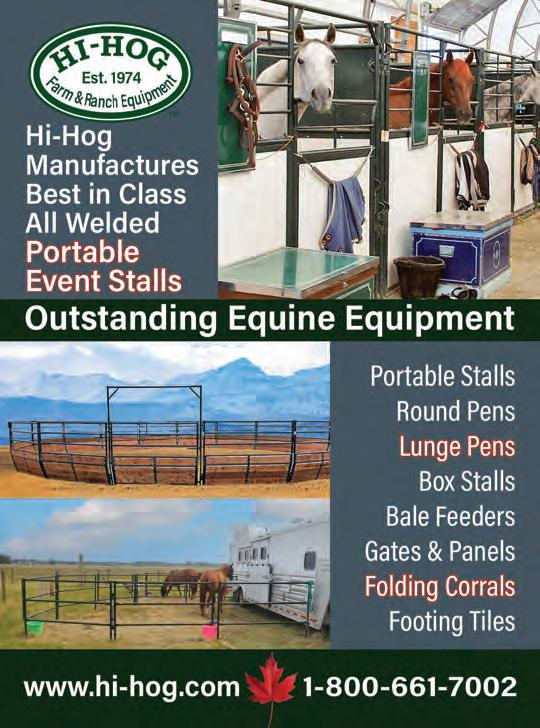
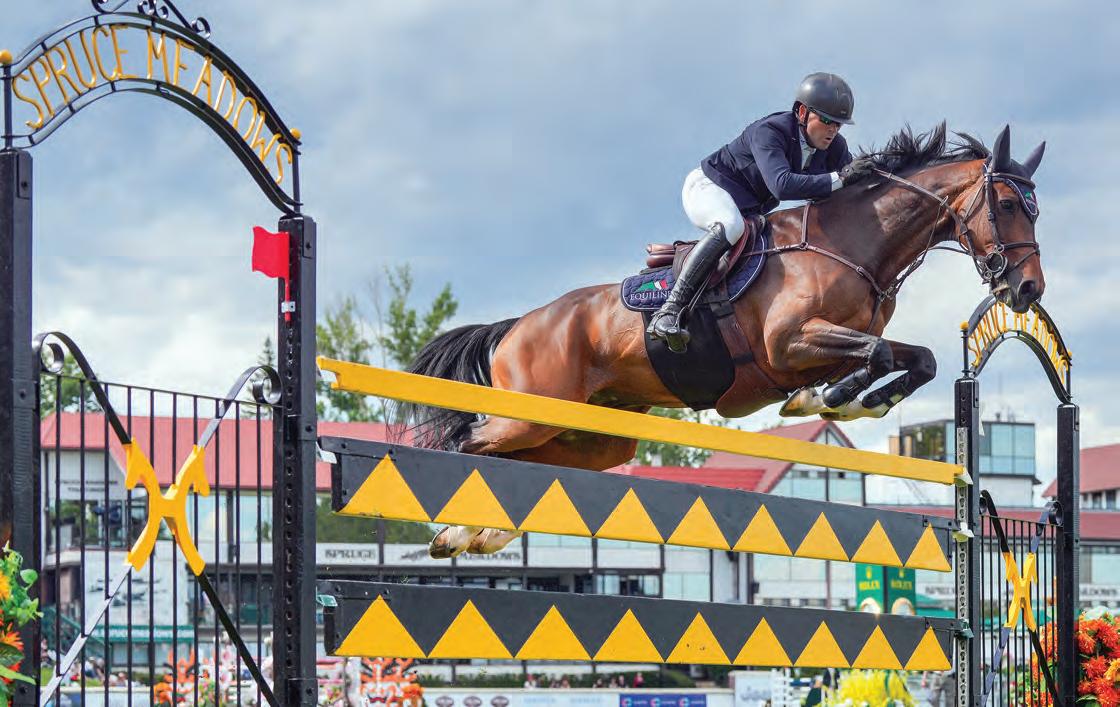
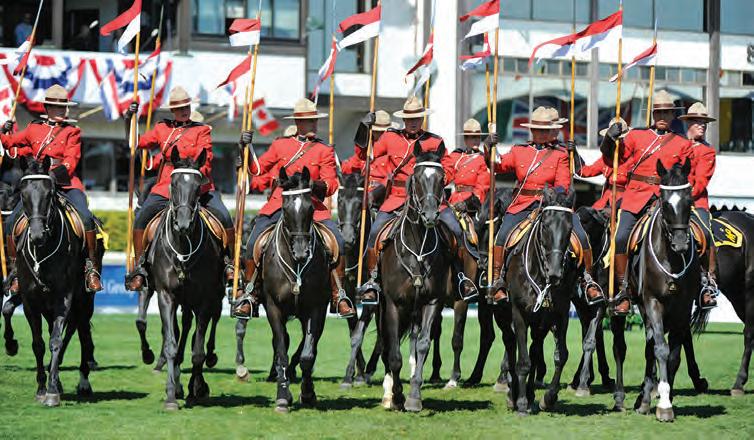

contributions to Canada’s financial and cultural development.
Meanwhile, Spruce Meadows is still going strong.
“For our 50th we’ll be celebrating all the people that have built Spruce Meadows,” says Southern-Heathcott.
“That includes our sponsors, athletes, fans, and media. We’ll be celebrating each of those groups and thanking them for what they’ve brought to Spruce Meadows. The continuation of this venue wouldn’t be possible without the support, hearts, and minds of so many people.
“Our anniversary is on April 13, 2025 so we’ll have a celebration that day,” Southern-Heathcott says. “We’ll have concerts with our tournaments, movie nights, maybe a superhero day, a big lighting ceremony for our Christmas

The Name the Foal Contest, launched in 1999, continues to enjoy huge popularity.
market, dinners for the athletes, karaoke, and lots of fun things for the fans to do.”
For 50 years, Spruce Meadows’ rolling fields have welcomed the world of show jumping to the Canadian west, and in doing so have helped develop some of Canada’s best athletes. Just as Ron and Marg Southern dared to imagine all those years ago. b
> Tania Millen is a frequent contributor to this magazine — read her bio on page 102.
Ron and Marg Southern enjoying the dream they dared to imagine all those years ago.
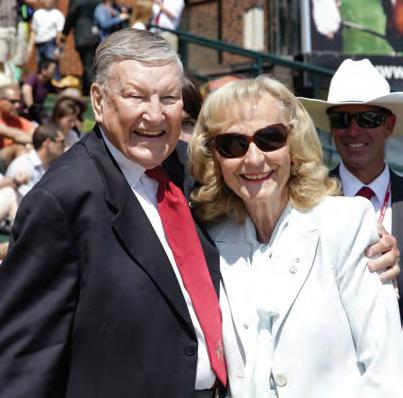




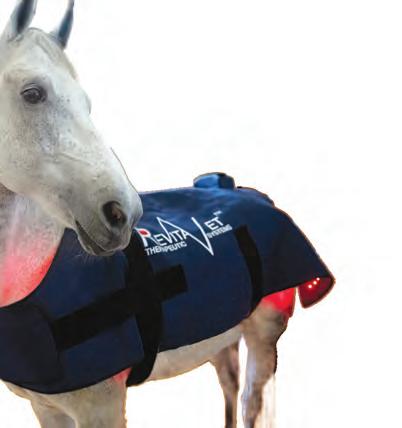




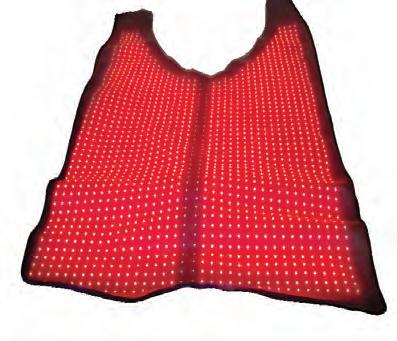


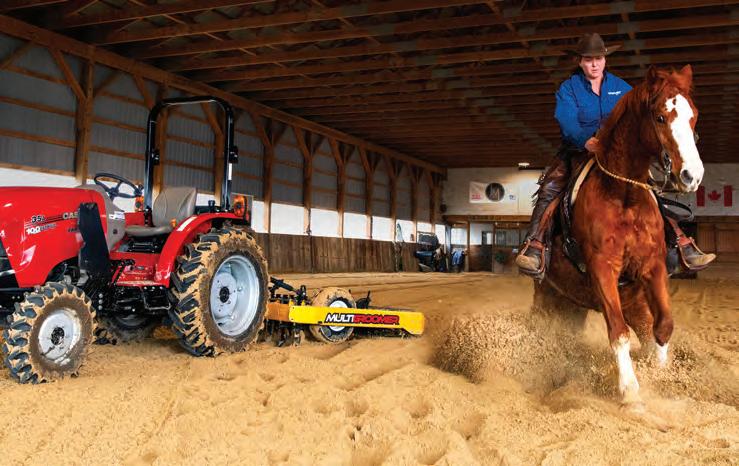
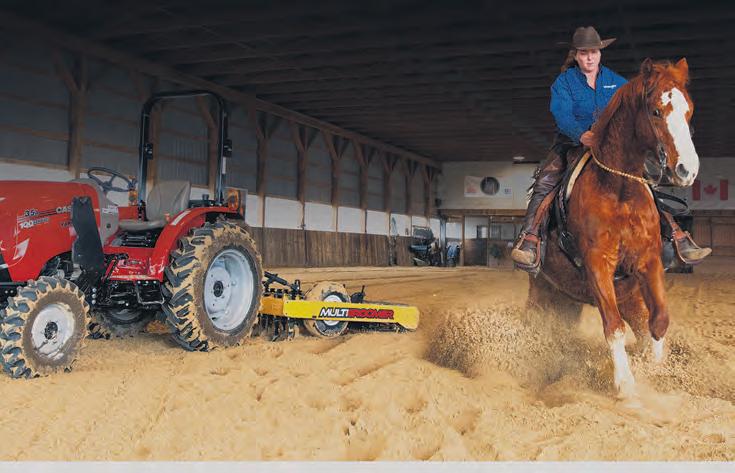
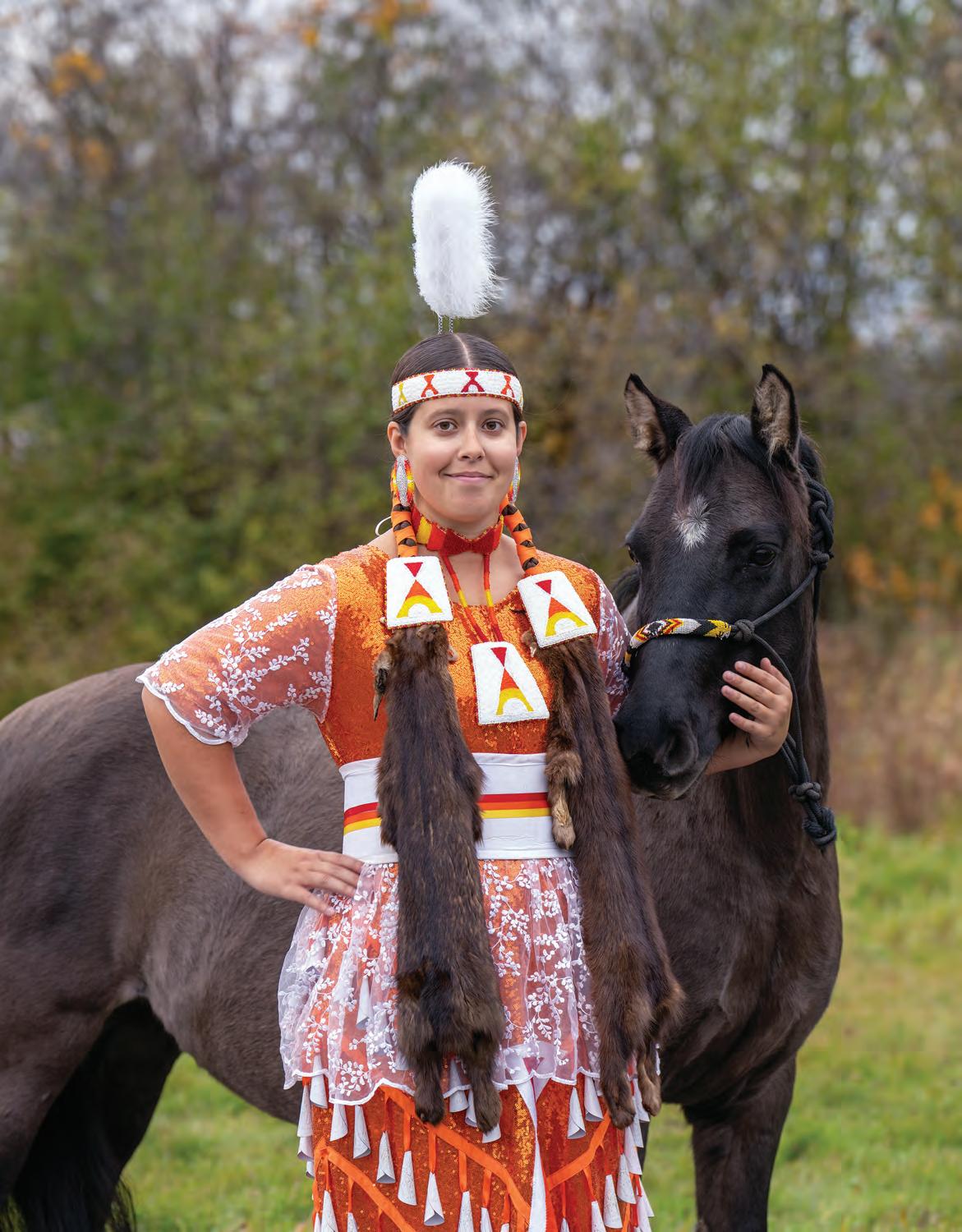
By Shawn Hamilton
The Lac La Croix Indigenous pony, named after the Lac La Croix First Nation, now the Gakijiwanong Anishinaabe Nation, primarily existed in northwestern Ontario and across the United States border into Minnesota. This unique pony breed, considered to be developed by the Indigenous Peoples, was used for winter transportation, running trap lines, hauling logs and ice, and pulling sleighs. As forest dwellers, the breed boasts strong hooves to endure the rocky terrain of the Canadian Shield; fuzzy ears to protect them from insects; and often a dorsal stripe down its back and zebra stripes on its legs.
The breed was well on its way to extinction in 1977 before a “pony heist” changed its destiny. Now with no more than 200 horses in Canada, found in Ontario, Manitoba, Saskatchewan, Alberta, and British Columbia, as well as Wisconsin and Minnesota in the US, the breed is considered critically endangered but making a comeback. The Ojibwe Horse Society maintains the breed registry of the horse which is officially registered as the Ojibwe Horse but commonly referred to as the Spirit Horse in honour of their connection to the spiritual past and ability to heal intergenerational trauma. Although small in size, the Ojibwe Horse’s history is full.
In the 1940s, a large herd of the Lac La Croix ponies on a reservation in Bois Forte in northern Minnesota was destroyed at the request of missionaries, who considered it inappropriate for the residential children in the area to witness horses breeding in nature. This resulted in the full extinction of the breed in the US, leaving only a small herd north of Lake Superior in the Lac La Croix First Nation region. The remaining herd in Canada was used in the winter for trapping and pulling; their work was
rewarded with food, shelter, and protection from wolves and other predators. Just before the ice melted, the ponies would be herded back to an island known as Pony Island to breed, foal out, and forage on their own.
For various reasons, including the use of snowmobiles to do winter work and the last remaining breeding stallion

Mukaday-Wagoosh (Black Fox), an eight-year-old Ojibwe gelding.
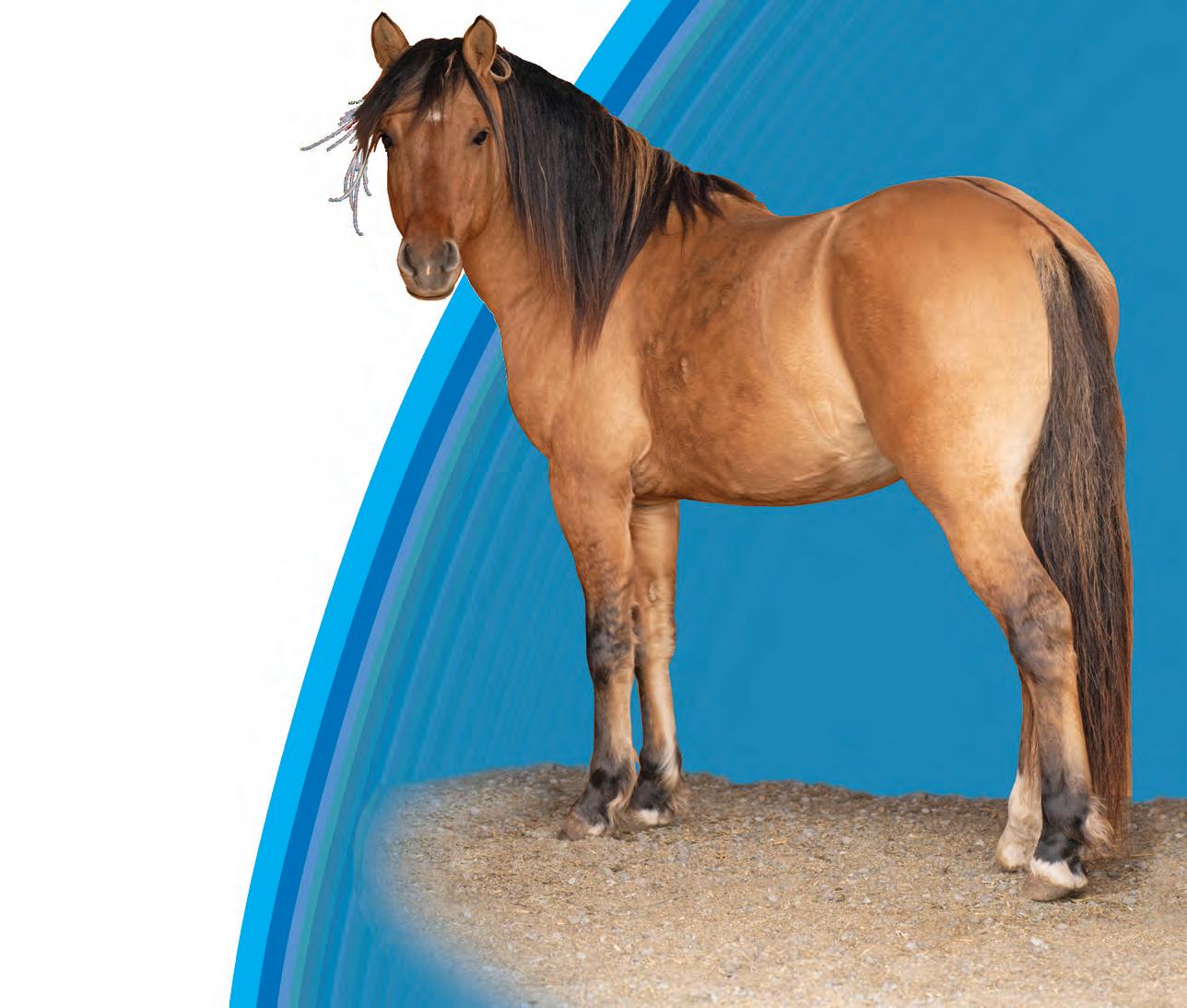
Migzi (Eagle), a four-year-old stallion, is an outstanding example of the Ojibwe breed. These sturdy, resilient horses stand 12 to 14.2 hands high and are known for being gentle and intelligent.


mistakenly shot by a hunter who thought it was a moose, the herd began to dwindle. With only four mares remaining in all of North America in 1977, Canadian Health officials felt they were pests and ordered them to be destroyed. When Lac La Croix native, Fred Isham, living in Minnesota at the time, got wind of this proposal he and his accomplices went to work to devise a plan to save the mares and ultimately the breed. With the island only accessible by air, snowmobile in winter, or boat in summer, they resorted to a rescue plan involving a Ford pickup pulling a 20-foot trailer over frozen waters, through narrow forest paths, and down snow-drifted roads to smuggle the mares back to Minnesota. Awardwinning Canadian children’s author Heather O’Connor co-wrote Runs with the Stars with Darcy Whitecrow, a caretaker of the breed, based on the return of the Ojibwe Horse. Heather shared an article with me written by John Murrell, published on February 20, 1977 in a Minnesota newspaper, titled The Last Round Up, which tells the story of the heist to bring the mares to safety with the aid of Wally Olsen, Bob Walker, Walter Saatela, and Omar Hilde, led by Fred
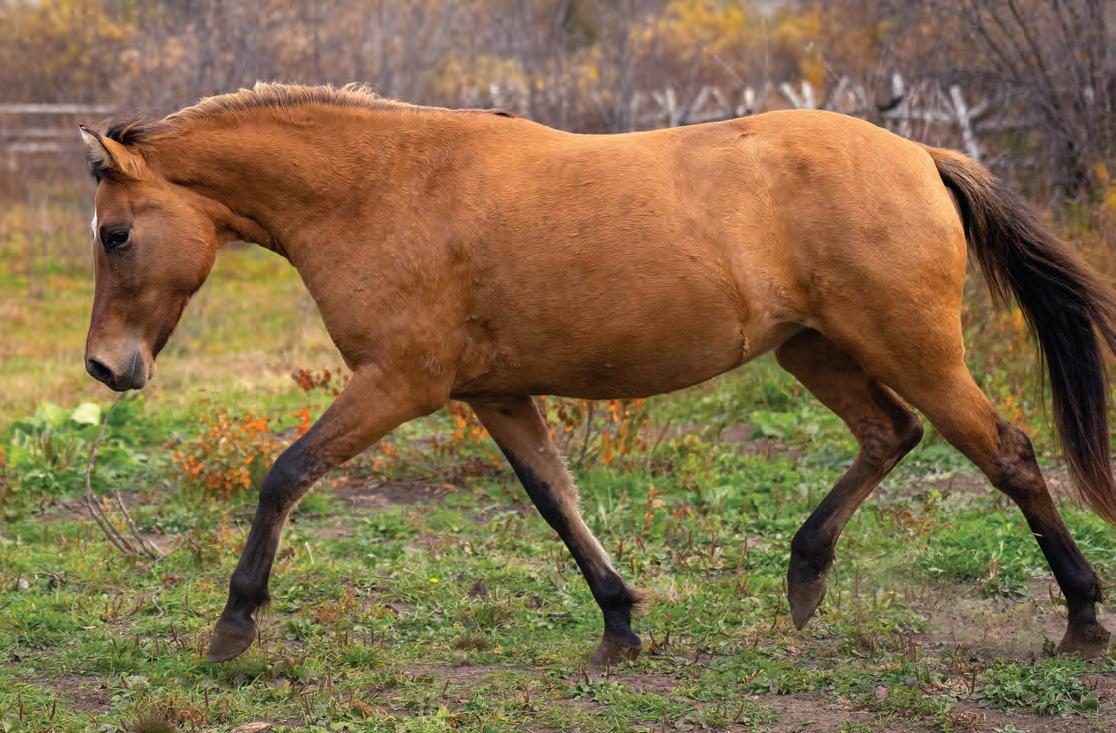
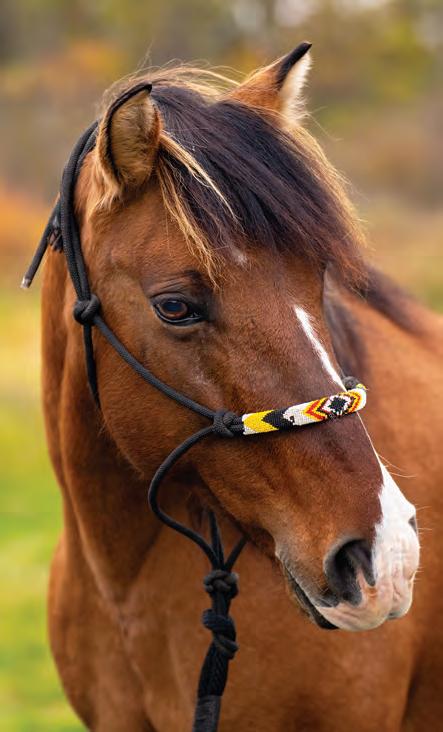
The
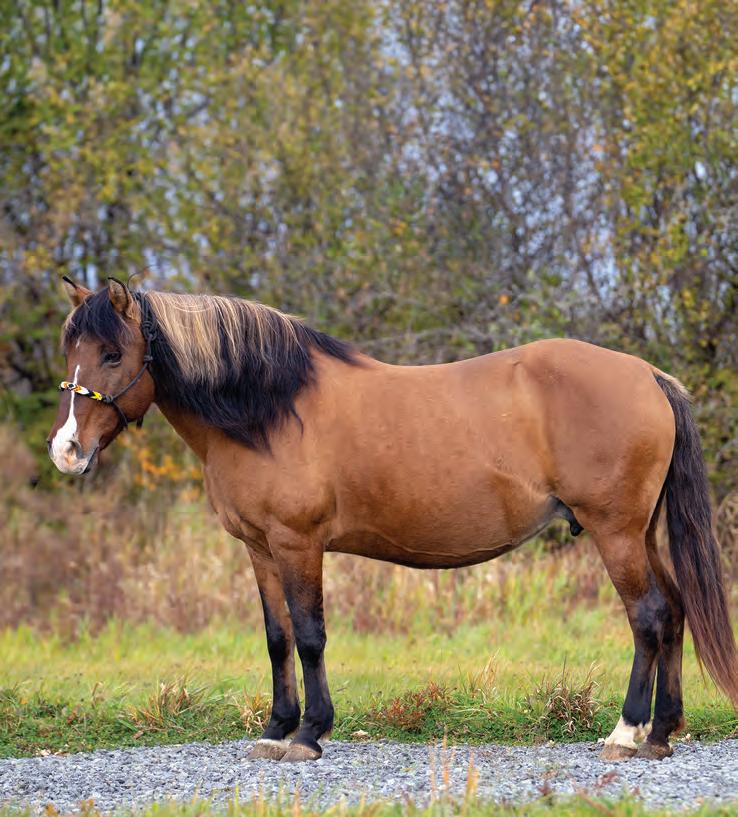


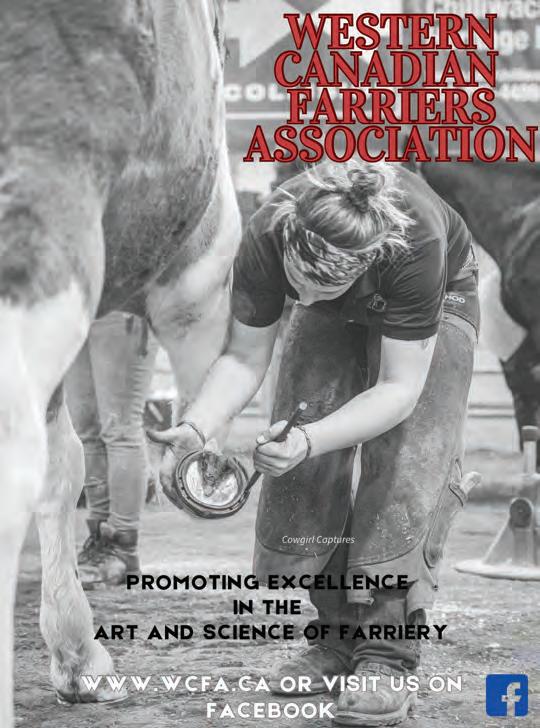
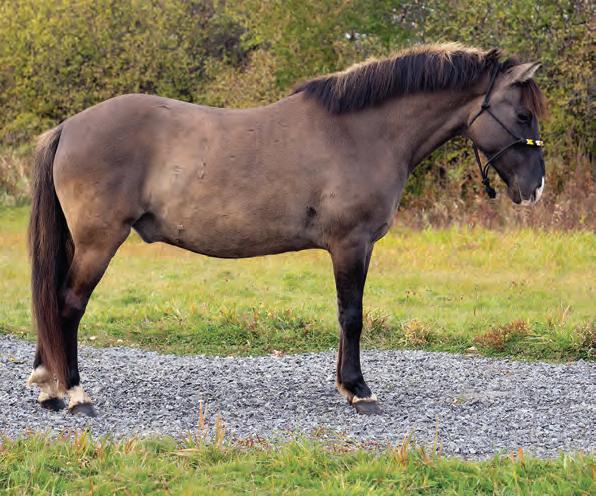
Isham, all of whom were elderly men at the time.
With the successful return of the mares to Saatela’s farm in Minnesota, the next question was how to preserve the breed. The two older mares were 25 and 30 years old, but the younger ones at 11 years old could be bred. The decision was made to use the Spanish Mustang, Smokey SMR 169, to attempt to bring the breed back from imminent extinction.
In 2024, after hearing of a newborn Ojibwe Horse in our nation’s capital, I found myself at Mādahòkì Farm in Nepean near

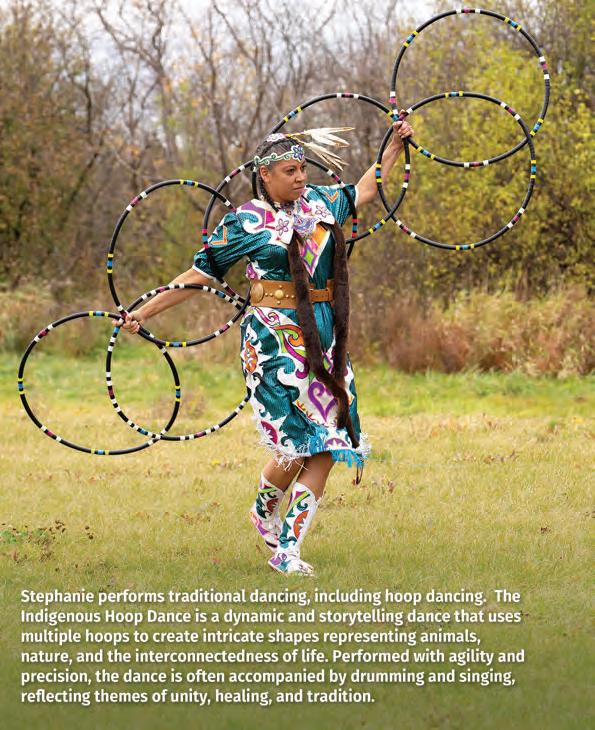
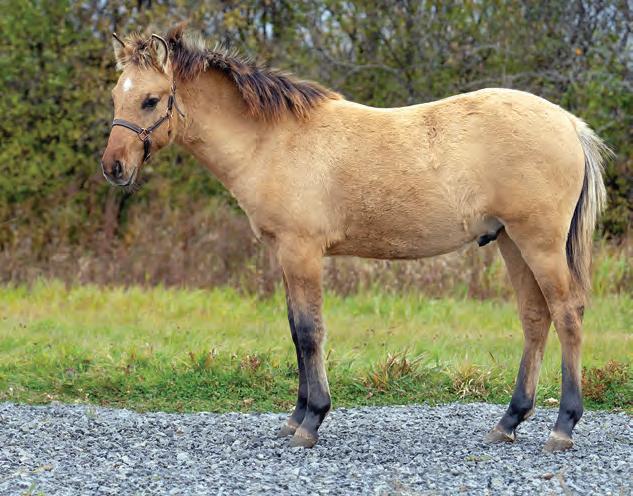
Ottawa, where I met Trina Mather-Simard, a key person behind the organization that brings Indigenous culture to the world through immersive education. I toured the facility, met some of the Indigenous dancers who help visitors learn about the traditions of the native ways, and had the opportunity to get close to the horses that make up their small Ojibwe Horse herd of 11.
Mather-Simard first heard about the Ojibwe Horse through an artist by the name of Rhonda Snow, whose art appeared in the National Arts Centres The Spirit Horse Returns production that
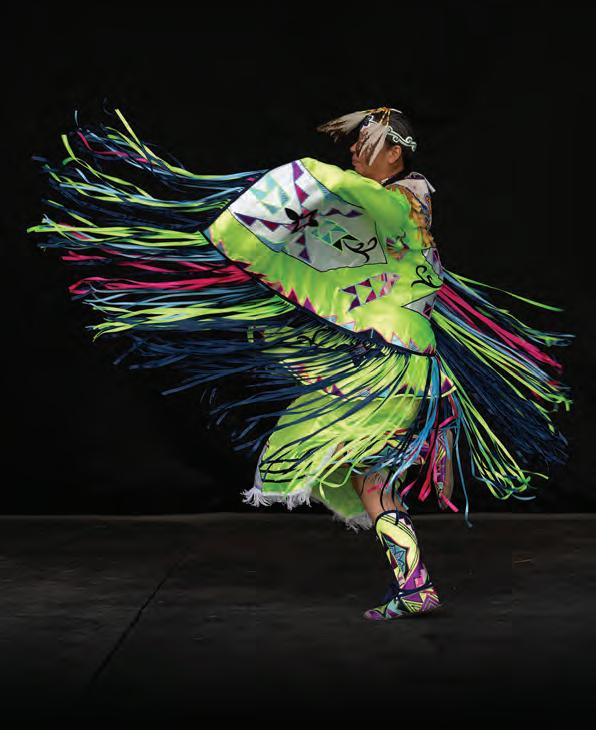
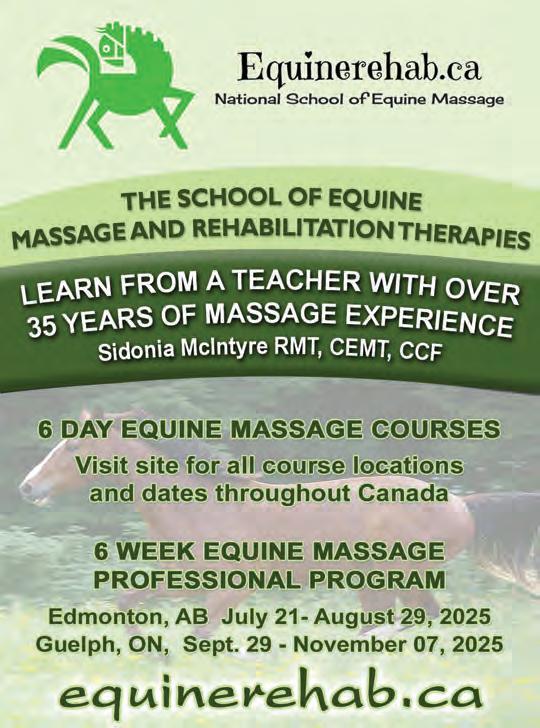
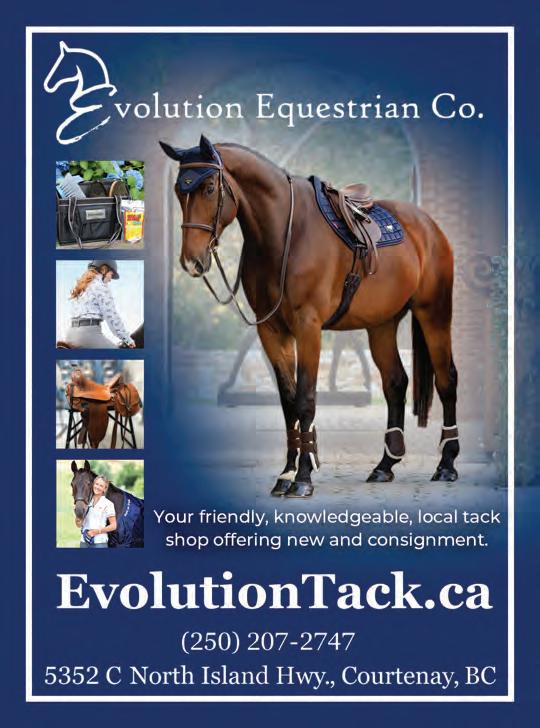

celebrated the legend of the Ojibwe Horse with a live orchestra and traditional native music.
Mather-Simard was running an Indigenous cultural centre on Victoria Island, located on the Ottawa River between Ottawa and Quebec, but after visiting the Ojibwe Horse herd at TJ stables, run by Terry Jenkins, she felt the rich history of the breed should be incorporated into her educational program. Needing more land to do this, she eventually secured a grant through The Federal Economic Development Agency for Southern Ontario to acquire a 25-year lease on a 164-acre farm, formerly Lonestar Ranch, in Ottawa’s Greenbelt region. Aptly named Mādahòkì, meaning “share the land,” the farm is dedicated to Indigenous experiences and allowing people to participate and learn about the

Tristan performs the Indigenous Grass Dance, a vibrant and energetic Powwow dance rooted in Plains traditions, characterized by fluid, sweeping movements that mimic the bending and swaying of grass. Dancers wear long, flowing fringes that represent prairie grass, and their steps, often linked to spiritual and warrior traditions, symbolize the preparation of sacred ground.

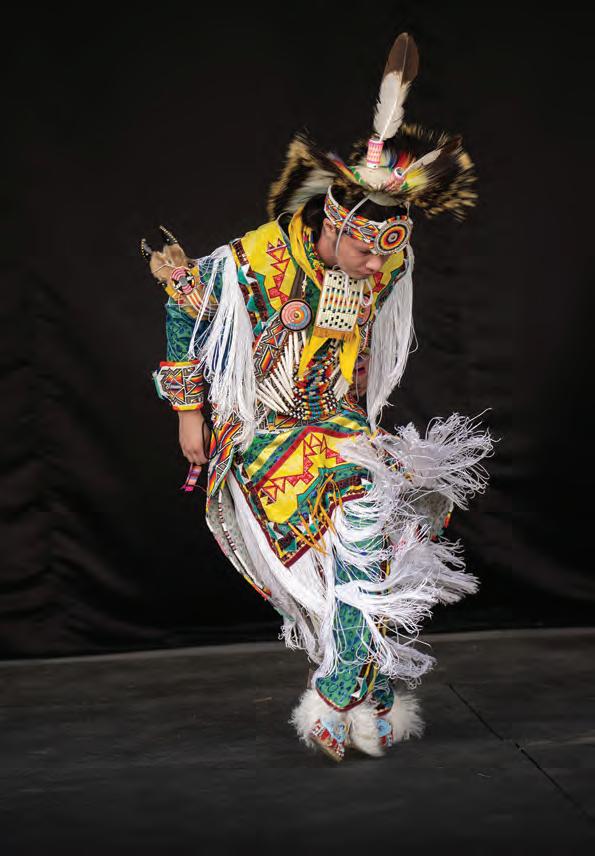
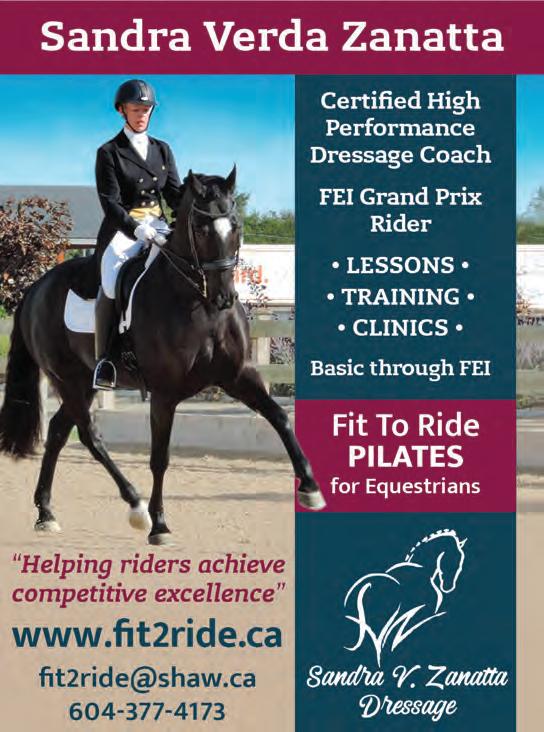
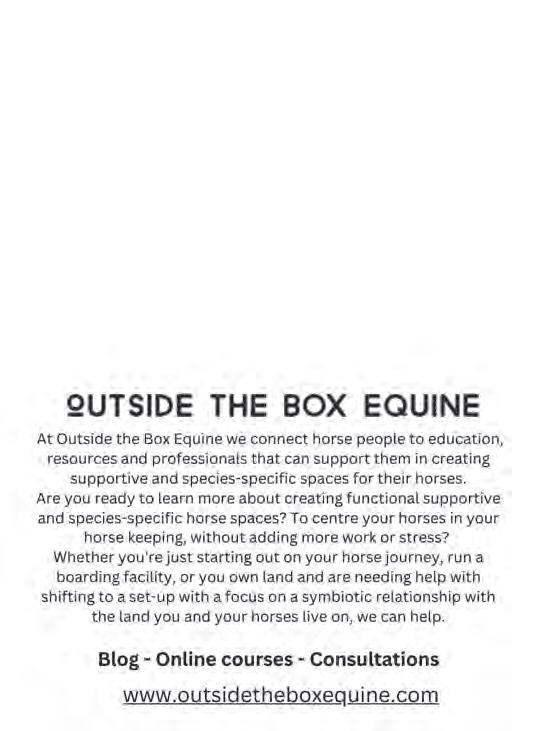
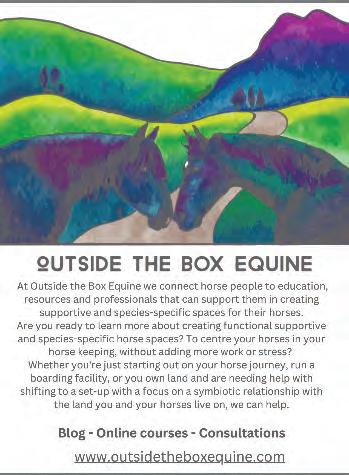
By Belle (Isabelle) Bailey
I’m from Pikwàkanagàn First Nation but reside in Ottawa where I attend school and work. I’m currently attending Carleton University, pursuing a Bachelor’s degree in Indigenous Studies. I’ve been with Mādahòkì Farm since April 2024 as a Cultural Ambassador. I enjoy beading, teaching cultural workshops, and dancing at Powwows.
The style I dance is called the Jingle Dress. The story comes from a young girl named Maggie White who was very ill. Her grandfather, who was worried about her, had dreams and visions about a beautiful dress that would heal her. With the community and her family’s help they created this dress for Maggie. At first, she was too sick to dance, so they carried her. By the end of the song, she was able to dance all by herself. The dress had cured her of her illness.
My dress is inspired by the Every Child Matters movement. It is a dedication not only to my family but to other Indigenous families and communities. The white jingles on my dress represent the children taken away to residential schools. I chose the colour white because it represents purity and innocence. The symbol I have on my dress and all my beadwork is the tipi in sunset colours. When I dance, I’m calling on the spirits of Indigenous children to go into the sunset home to the tipi where they feel safe, loved, and where they belong.

culture. Hosting the annual Summer Solstice Indigenous Festival, welcoming school groups, corporations, and the general public to experience native food, dance, art, and the horses, they have received well over 20,000 visitors to date.
In 2021, Mather-Simard purchased four geldings from TJ stables.
“They were very protective of the breed at the time, and in order to keep the bloodlines pure [they] would not sell any of the mares,” she says.
Two and a half years ago they purchased the mare Wishkossiwika (Sweetgrass) from TJ stables. She came to them already in foal with Cedar, who was the first Ojibwe Spirit Horse born on the property.
Securing two stud colts of the breed, they chose the one with the stronger genetic makeup MIGZI (Eagle) to be their stud and he is now four years old and ready to grow the herd.
Originally being forest dwellers, the native ponies are not used to grazing on rich grass so are easily prone to founder. Mather-Simard tells me that they cannot be turned out just to graze and are fed very grassy hay with no alfalfa using hay nets.
Mather-Simard’s goal is to play a small part in the support of the healthy revival of the breed and the reconnection to the Ojibwe Horse to the community.
“They are sacred animals, smart ponies, and are willing to please, making them versatile for various activities. Their gentleness and spirit make them perfect for equine assisted therapy,” she explains.
I am honoured to have learned about the history of these small but sturdy ponies. I now better understand their representation of the resilience of Indigenous communities, and their connection with nature as a reciprocal partnership. b
For more information visit:
Mādahòkì Farm > www.madahoki.ca
TJ Stables > www.tjstables.ca
Ojibwe Horse Society > www.ojibwehorse.ca
Rhonda Snow > www.rhondasnow.com
Heather O’Connor > www.heathermoconnor.com
The Spirit Horse Returns > www.ojibwehorse.ca/the-spirithorse-returns
> Shawn Hamilton is a frequent contributor to this magazine — read her bio on page 102.
with Scott Phillips of Amazing Horse Country
We often hear the term “dream horse” when riders are asked what they desire. But what do our horses want or need in their “dream human”?
Scott Phillips of Amazing Horse Country has spent years pioneering a style of horsemanship that connects people with horses. Passionate about sharing that knowledge with others, Scott was inspired to build an extensive and innovative retreat that nurtures communication and understanding for equestrians and their equine companions.
Always smiling, Scott states that it’s much easier for us to learn “horse” than it is to teach the horse “human.”
Scott typically asks his clients how horses communicate, and the answer is almost always: body language. As Scott is quick to point out, humans don’t have ears to move and tails to swish. Horses truly communicate on multiple levels that are fun to learn, and learning them will help empower your goals.
Specialising in helping horses and people cross that language barrier, Scott has helped build successful riding teams throughout Canada. It begins with learning about unique aspects of our horses that allow us to form enduring relationships and bonds of trust.
With a passion for travelling, Scott has enjoyed giving mobile clinics for years, facilitating many happy trails for his clients whether two- or four-legged. However, eventually all trails lead to home and Amazing Horse Country has found a permanent home in the gorgeous area of Alberta’s David Thompson Country. Here, Scott is thrilled to welcome equestrians to their horse haven where they can enjoy a getaway with their own horse, and where both people and horses can escape the everyday.
Amazing Horse Country Ranch boasts a newly built 85 x 200-foot indoor arena, classroom, a large outdoor arena, a stateof-the-art obstacle course, and miles of beautiful trails. Situated right off Crown land and minutes from Crimson Lake Provincial Park, Amazing Horse Country Ranch also hosts a bed-and breakfast if camping is not really your style.
Scott believes in a more exploratory approach to working with a horse than conventional horsemanship can provide. “Every


Scott
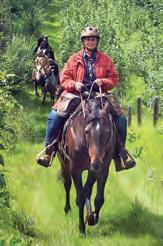
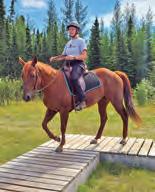
horse is a unique individual: how they relate to their environment, perceive leadership, their strengths, and struggles. A training program with a horse will always be successful when it is based on, and flexible enough to meet, the horse’s needs,” he explains.
Teaching a style of horsemanship that is grounded in practical application, Scott creates positive and enjoyable scenarios that foster connections between horses and riders. “If I could describe my job, it would probably be titled, ‘Equine Relationship Facilitator,’” he says Scott’s approach begins with determining who the horse is, and then tailoring a progressive learning opportunity for the individual horse and handler.
“I love to share how to work with horses this way,” Scott states enthusiastically, “It’s a commonsense path to success in whatever you’re pursuing with your horse. I keep the clinic sizes small, to really dial into what each horse-and-rider team requires to progress, and I like to work one-on-one with my teams. Our clinics are capped at between three and eight people, depending on the clinic type, to make this possible.”
Amazing Horse Country offers a variety of clinics that appeal to all walks of the industry. These include trail riding, obstacles, one-on-one horsemanship, liberty, and colt starting with a focus on outdoor riding, trails, and creative obstacles. There is an emphasis on allowing a horse and rider the time they need to learn and gain confidence

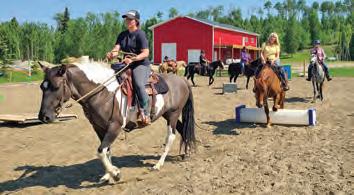
in a supportive and positive way.
As a multi-discipline equine destination for equestrians of all levels and goals, Amazing Horse Country caters to the needs of clients and their horses. It’s a venue of choice for building confidence, getting to know the horse, or working through any struggles clients might have.
Clients are skillfully and patiently guided as they dive into factual and functional knowledge of how horses think and how the horse’s body works. This cultivates the rider’s skills to communicate with clarity and consistency in a way that resonates with the horse’s natural instincts, fostering a serene and precise response from the horse. Empowering riders to master the language of their horses, Scott’s approach cultivates a dream duo: a horse and rider, united by trust, ready to meet any challenge as a team.
The Amazing Horse Country 2025 clinic schedule can be seen online at www.amazinghorsecountry.com/clinics. With plenty of clinics to choose from, Scott looks forward to helping equestrians of all levels achieve their goals with their equine partners. b
For more information, visit > www.AmazingHorseCountry.com

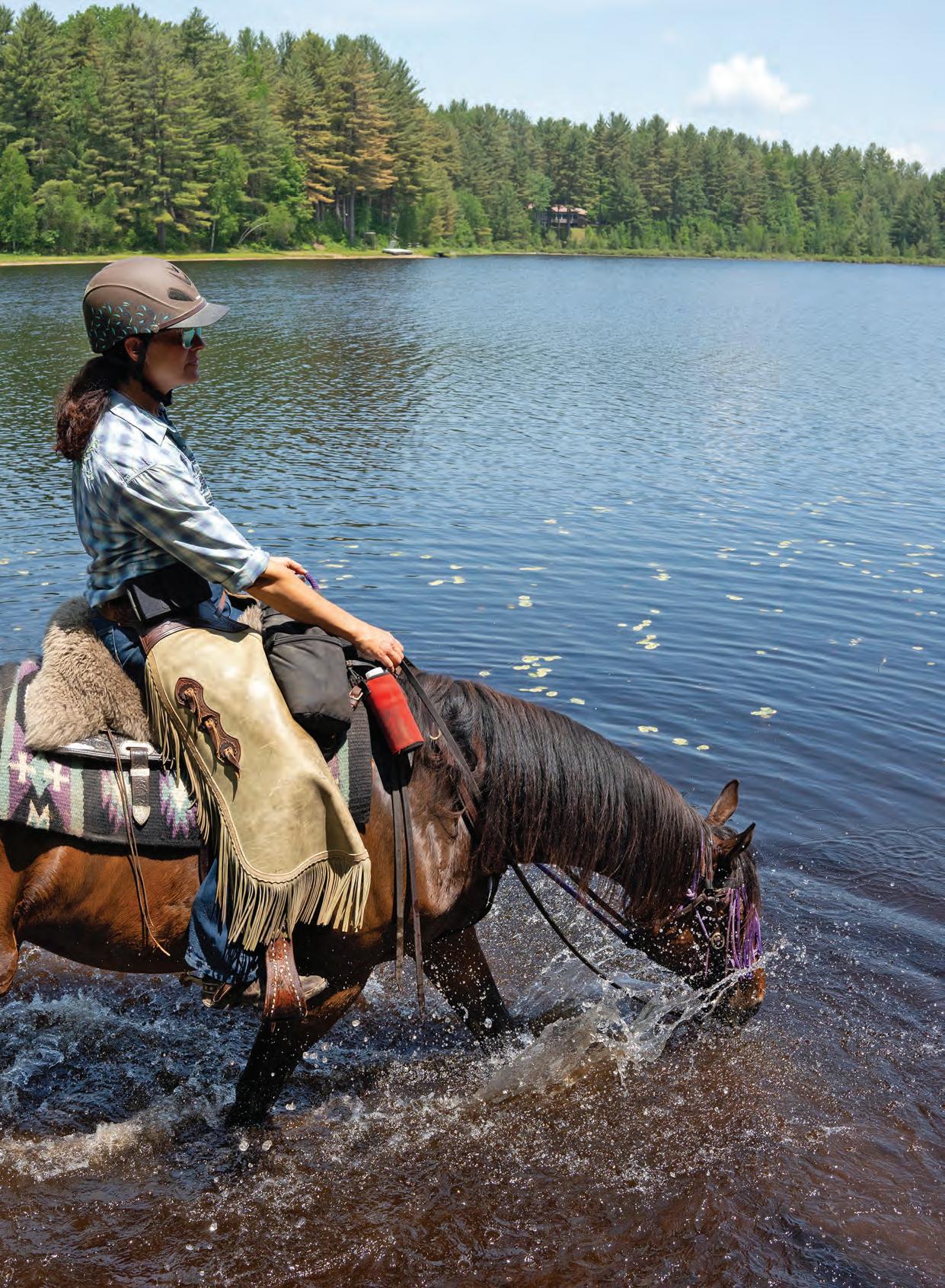
By Shawn Hamilton
I remember hearing my friends fondly recalling their horse camping trips at Otter Creek in the Adirondack Park Forest Preserve near Glenfield, New York, and feeling a surge of jealousy. With over 65 miles of trails ranging from novice to intermediate riding terrain, there was no shortage of stories about crossing high rivers, picnic-lunching with gorgeous vistas, and swimming in pristine lakes. Many of my friends had been going for years and knew the place like experts. I had the horse, but wasn’t in the tax bracket to afford even a small horse trailer, let alone the fancy living-quarters trailers they had.
Finally, I was able to purchase a used two-horse bumper pull trailer. I can still vividly remember the first time I loaded up my Paint mare, Bailey Girl, packed my two-man pup tent and some cooking supplies into the truck, and crossed the border into the United States to join my friends for a horse camping adventure at Otter Creek.
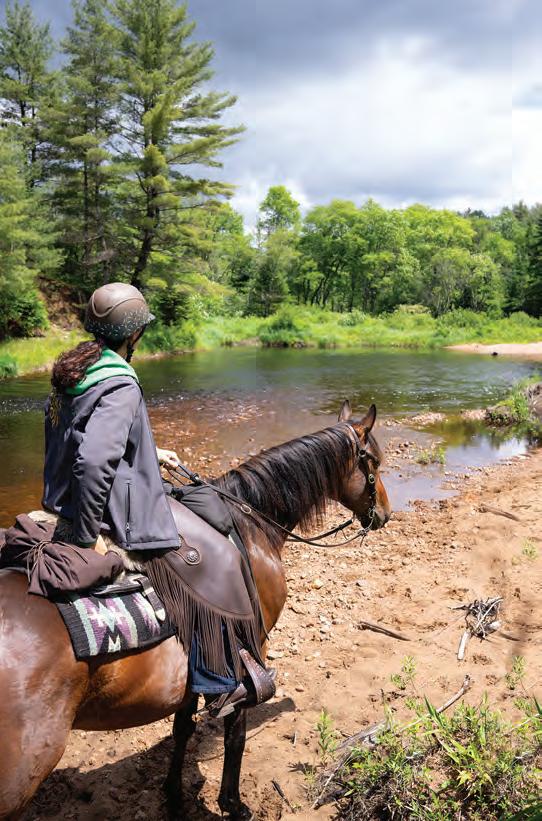

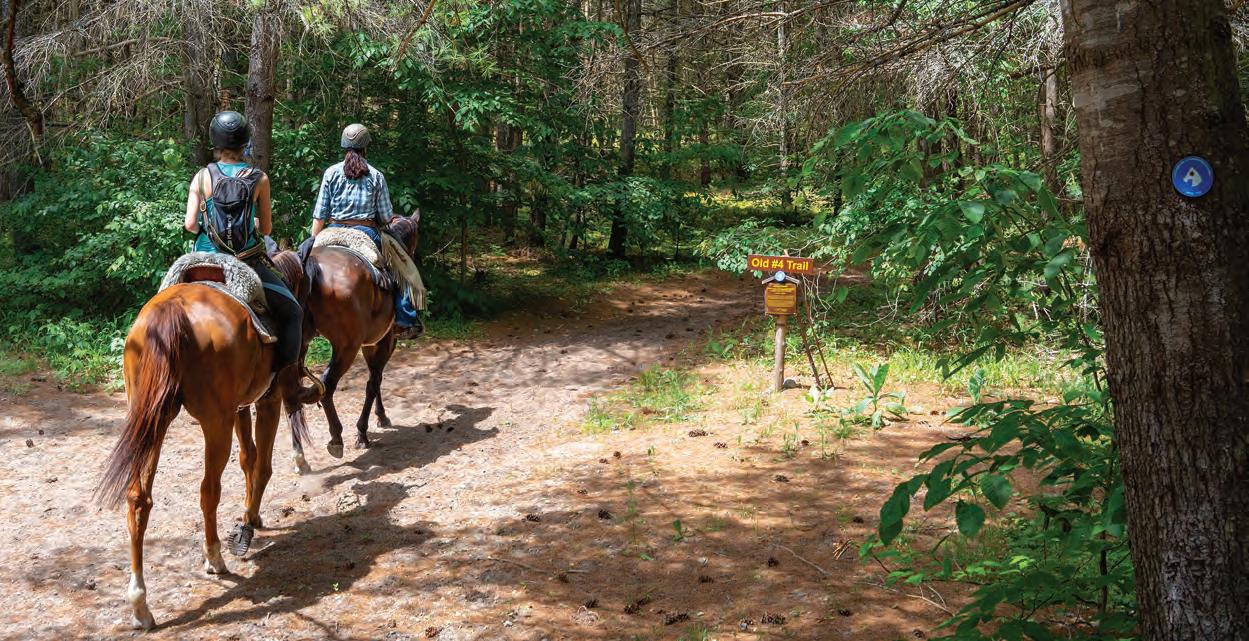
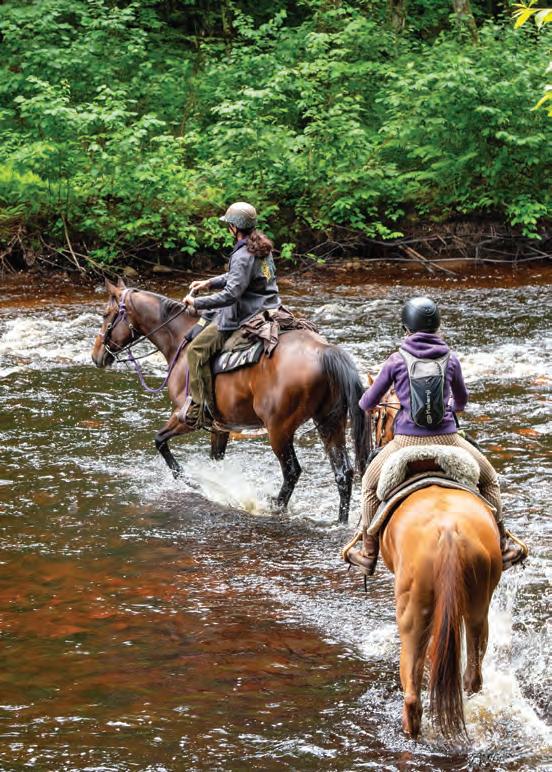
Like a little kid, I was so excited to pull into one of the three large assembly areas of the campground on Chase Lake Road, unload my mare, settle her into a covered standing stall, and set up my tent for a good night’s sleep before hitting the trails the next day. Memories of galloping though the sandy footing of Frost Pocket trail, picnicking on the shores of Payne Lake, and riding to Bucks, where we tied the horses to hitching posts and went in for a burger and beer, still bring a smile to my face. That was many years ago, and since then I upgraded to a livingquarters trailer, creating countless more memories of horse camping adventures.
It had been a long time since my last visit to Otter Creek, but this past summer my friend Anne invited me along to ride her precious Paint gelding, Baloo, for a week on the trails. The riding was just as wonderful as I remembered, but the range of accommodation available in the area has changed significantly. The free Otter Creek campground, still equipped with covered stalls, flush toilets, and cold running water remains unchanged. However, a few visionary women have since transformed the experience in a big way.
Starting in 2008, the development of Otter Creek Horse Camps has made trail riding at Otter Creek more comfortable and accessible to those without living-quarters trailers and camping equipment. With four cabins accommodating up to 17 people and 17 horses, riding at Otter Creek can now be enjoyed with modern comforts, as well as a fenced paddock featuring large box stalls for the horses.
Liz Hirschey, who lived in Turin not far from Otter Creek, has been riding there with her friend, Mary Misek, since the late 1980s. In February 2008, when she heard of a property within riding distance
Anne and Doriane follow the trail across a bridge and along a river.


to the Otter Creek trail system, she and Mary, along with Mary’s partner Will Hunt, snowshoed into the property with the realtor.
“It was used as a hunting camp so was not plowed in the winter,” Liz tells me. “It was a good structure and the neighbouring bunkhouse, which was also for sale, had more acreage, so I bought both.”
At the time there were no horsey people living in the area. Liz renovated the structure, which is now known as Abbey Lane, and used the location to stay in when she wanted to ride with her friends in Otter Creek. She also chose to renovate the bunkhouse, adding water, electricity, and a septic system, along with a spacious addition and horse stalls.
“My idea was to rent it out to people who like to do what I like to do,” she explains. “My initial business plan was very conservative, but I figured I could eventually recoup my costs.”
Liz didn’t want it to be basic. “I wanted it to be clean, comfortable, and fully equipped with pots, pans, coffee maker, etc., everything one needed to have a hassle-free stay for both horse and rider.”
In 2010, Liz met Karen Giroux, who had purchased a nearby property — now known as Roc-a-Hoo — where Anne and I stayed with our friend, Doriane. A lifelong rider since the age of six, Karen was living in Rochester and had many friends who frequently traveled to Otter Creek to ride.
Karen recalls her introduction to the area.
“I bought a book called Ride New York, and went to a bunch of places that it mentioned. When I arrived at Otter Creek, I threw the book away.”
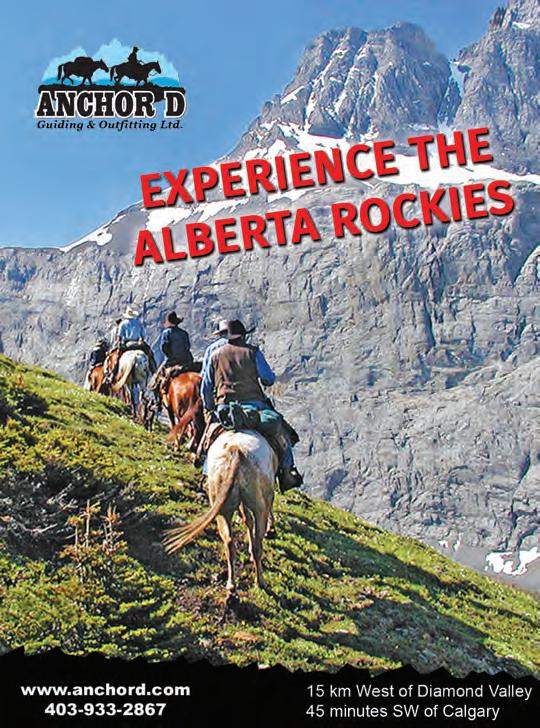







Karen and Liz decided to join forces and promote the rentals together. Liz started a website and a Facebook page, and attended trade shows to help promote the business. She kept acquiring
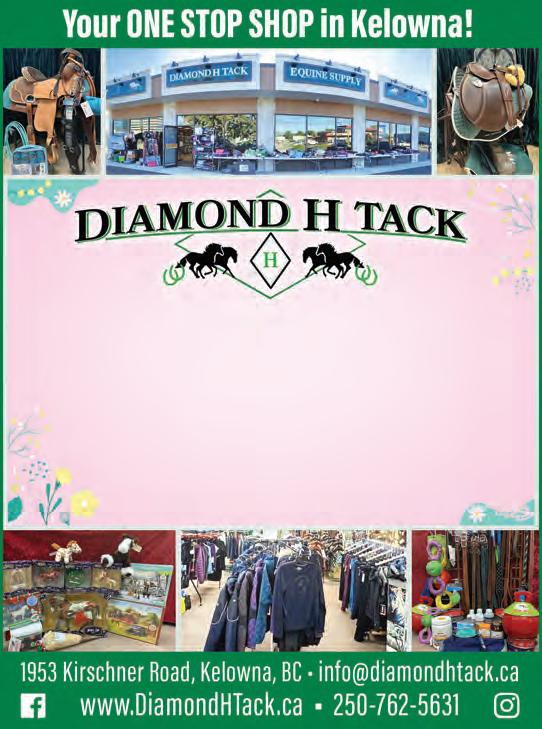



• No chemicals
• Cost-effective

BENEFITS:
• Environmentally friendly
• Safe around animals and people
• Fly parasites kill the developing flies before they hatch
“I can wholeheartedly recommend not only the bugs themselves as a very effective, environmentally-friendly part of a fly prevention strategy, but also Alan and as a very reliable and friendly source of predators.”

- Amanda J. Booth, DVM, M.VetSc, Dip. ACVIM
Don’t Wait! Start immediately at first sign of flies and reapply regularly through the fly season for optimal benefit.

biological fly control has been used effectively in barns and stables across Canada for 20+ years with excellent results!

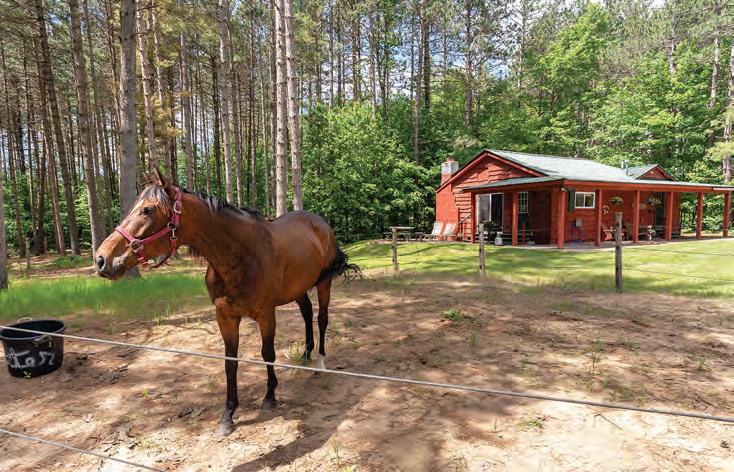

neighbouring properties, renovating them, and adding them to the roster.
Call for a free, no-obligation consult!
Suzanne Murray, Sales Manager suzanne.goodbugs@gmail.com 1-888-668-7264
196 Westwood Road, Nanaimo, BC
“After buying the first one, other neighbours would knock on the door to tell me they were not using their camp anymore and to ask if I would like to buy it,” she recalls.
emptied twice a week, and all the comforts of home including full kitchens, hot showers, and Wi-Fi.
“Ninety five percent of our clients are women aged 50 to 80 who ride for the day, then come back to the cabin to enjoy a glass of wine and watch their horse in the paddock,” she tells me. “Mostly everyone is in bed by 9:00 pm,” she laughs.
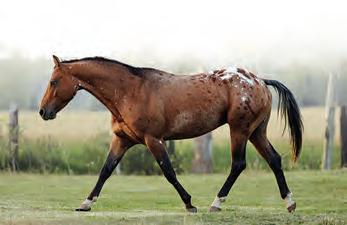

Liz purchased two more properties, and by 2019 had completed renovations on four properties, now called Abbey Lane, StayaBit, Dig It, and The Bunkhouse. In 2023, Karen sold Roc-a-Hoo to one of her clients, who decided to retain it for personal use. Liz and her husband are now the sole owners of Horse Camps at Otter Creek which consists of four cabins, all with safely fenced paddocks, covered stalls, wheelbarrows, muck piles which are
Mary still owns her property on Tractor Road, which she doesn’t rent out, and between the two of them, they own most of the property on that road — Liz with nearly 40 acres and Mary with just over 25.
The Otter Creek trail system is made up of state land — some is state forest, and some is wild forest with more restrictions. Originally taken over by the State of New York from private landowners in the early

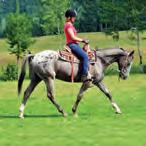

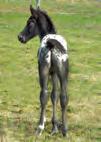


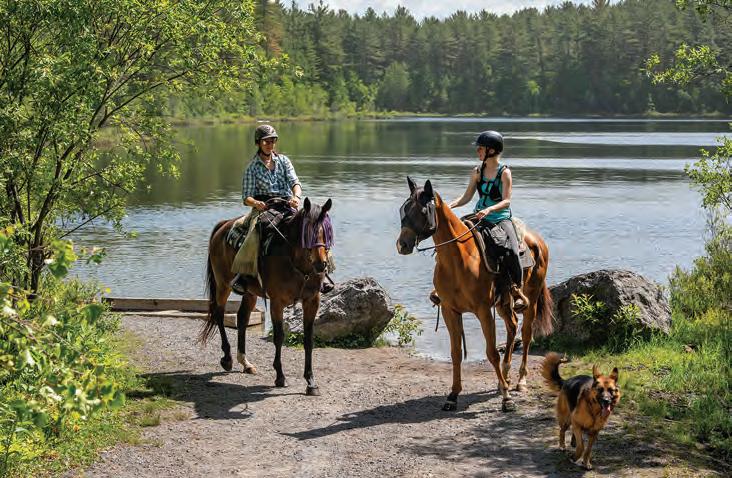
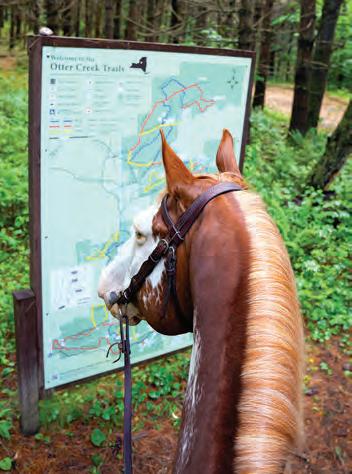
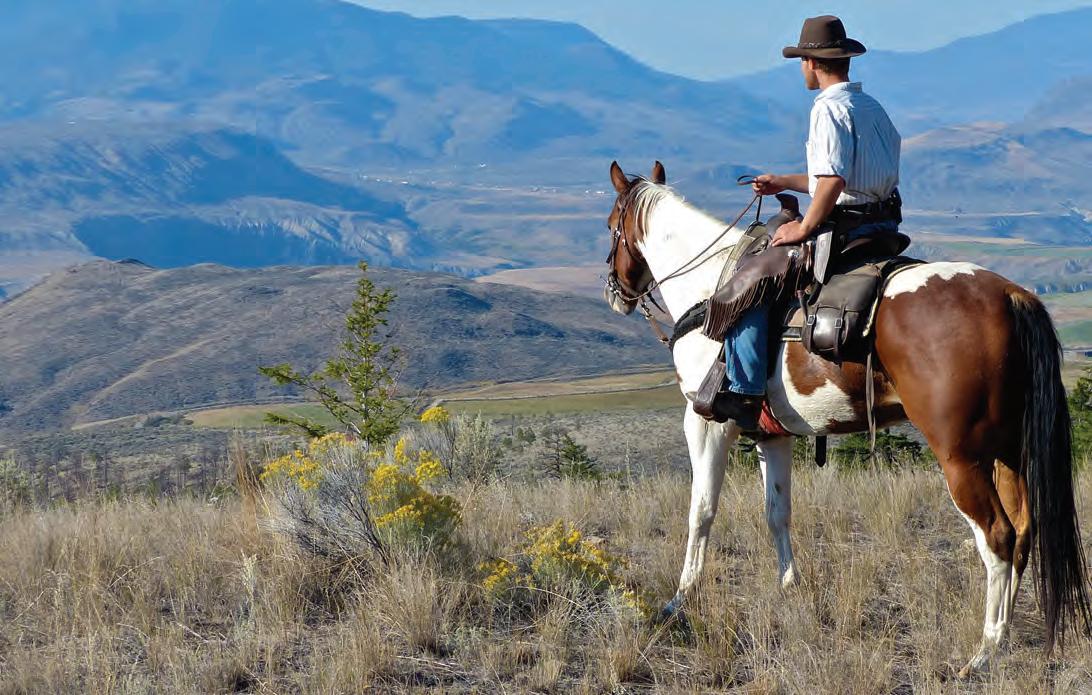

1900s, the area was heavily logged for hemlock, the bark rich in tannic acid used for curing leather and furs. Logs were sent down the Black River to the Erie Canal. The area is now managed by the New York State Department of Environmental Conservation (DEC), which unfortunately does not have the budget to maintain the trails.
This is where Friends of Otter Creek steps in. With approximately 15 members, this volunteer group helps maintain the trails, starting the season with a cleanup day in early May.
The Friends of Otter Creek have an agreement with the DEC, allowing them to determine what needs to be done to the trails before applying for approval. Fundraising efforts include selling maps they designed and printed, selling t-shirts, and hosting their annual Fun Ride fundraiser, which takes place on the first Saturday after Labour Day weekend in September. Lunch is provided and the 100 tickets sell out each year. On the 35th anniversary of Otter Creek last year they raised $5,600. In addition, the North County Draft Horse Association has provided their services of four teams to drag in logs used to make raised trail sections through boggy areas. “On the Icicle trail the horses were up to their knees in mud,” says Liz.
Otter Creek opens their season in late April when riders, mostly from Maine and Massachusetts, come to ride on the dry, sandy footing. “Once the snow is gone most of the trails dry quickly,” Liz explains, “so riders flock in from areas that tend to have muddy trails at that time of the year.”
Otter Creek is the prime destination for horse riding and camping in the northeast, attracting visitors from as far away as


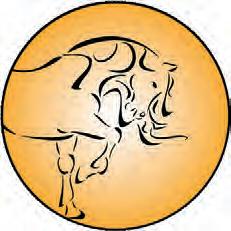
May 8-11 St. Andrews, MB
May 29-June 1.... Campbellton, NL
June 5-8 Kentville, NS
June 12-15 Port Lorne, NS
June 19-22 ......... South Freeman, PE
June 26-29 Anagance, NB
July 10-13 Bocabec, NB
July 17-20 .......... Prince William Parish, NB
July 24-27 Ste-Anne, NB
August 7-10 Kawartha Lakes, ON
August 21-24 Laird, ON
August 28-31 Aberdeen, SK

•
•
• Change your address?
•
• Ask a question?
www.horsejournals.com 1-800-299-3799 • (250) 655-8883




ADVERTISING: sales@horsejournals.com
EDITORIAL, GENERAL INQUIRIES: editor@horsejournals.com
SUBSCRIPTIONS: subscriptions@horsejournals.com OR www.horsejournals.com
NEWS, SHOW REPORTS: news@horsejournals.com
PHONE (ALL DEPTS): 1-800-299-3799 • (250) 655-8883
MAIL: 10148 Bowerbank Road, Sidney, BC, V8L 3T9

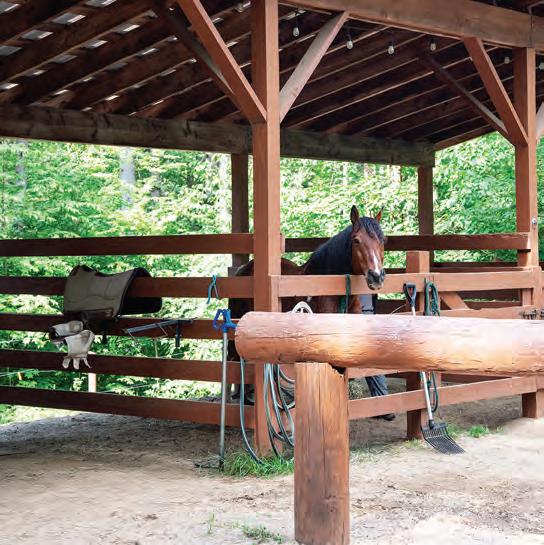
Pennsylvania, Maryland, Vermont, Connecticut, Massachusetts, and Maine. The Canadian clientele has begun to grow again after dropping off during the pandemic.
The assembly area, where the free camping is, does not open until mid-May and stays open until mid-October, which is a week or two before rifle-hunting season opens. Typically, Horse Camps at Otter Creek closes the cabins for the winter around the third Saturday in October.
The new owner of Roc-a-Hoo made it available to Anne, Doriane and me for one last stay, and during our amazing six days there we covered just under 120 km of trails. We enjoyed long canters on the sandy footing of Frost Pocket, watered the horses at Payne Lake, picnicked overlooking Burnt Creek, and spotted a deer on the Outlaw Trail. Our longest day, which spanned 27 kilometers over five hours, included a stop at Evies Pond and lunch at Little Otter Lake, followed by an awesome canter on Confusion Flats.
Each day we returned to untack and hose down the horses, then sipped wine at the picnic table while watching the horses roll before grazing in the paddock. Surprisingly, most nights we too were in bed by 9:00 pm.
The trip brought back old memories and created wonderful new ones. For six unforgettable days, we rode winding trails with friends, laughing under the sun, cantering along sandy paths, surrounded by the peaceful sounds of nature. A comment in the guest book at Roc-a-Hoo caught my attention, and I couldn’t have said it better myself: “Love this place and all it has to offer. I wouldn’t want to visit any other way.” b
Horse Camps at Otter Creek
> www.horsecampsatottercreek.com
The Friends of Otter Creek
> www.friendsofottercreekhorsetrails.com
More information about the Otter Creek Horse Trail System
> www.nyshc.org/trail.php?tid=1
(Photos are by Clix Photography.)
> Shawn Hamilton is a frequent contributor to this magazine — read her bio on page 102.
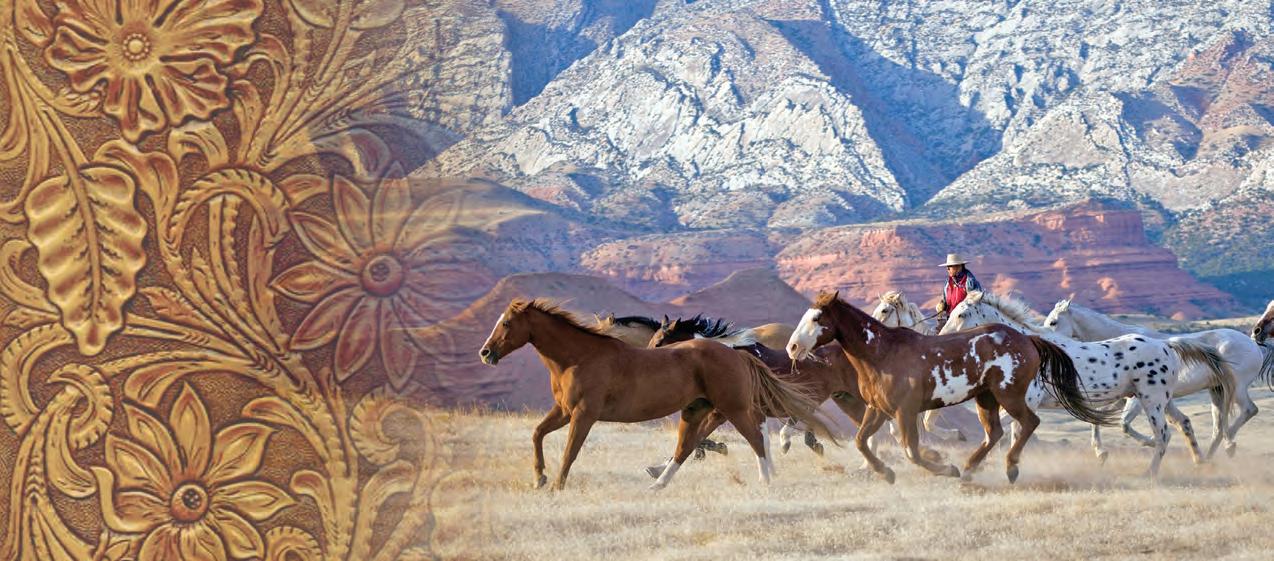




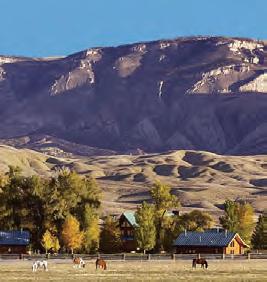

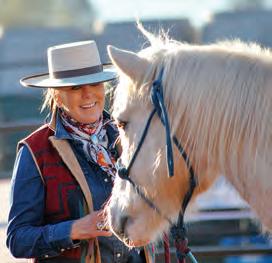





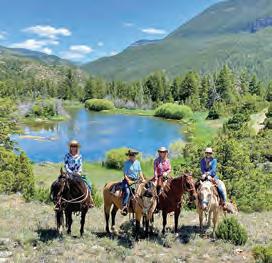
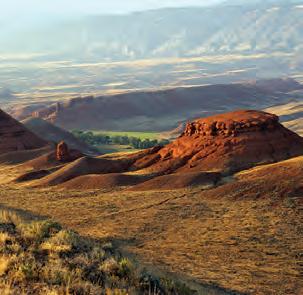

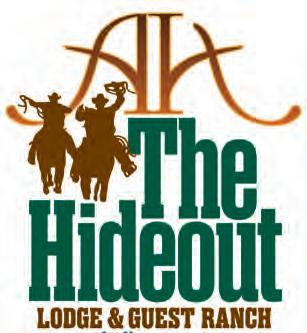

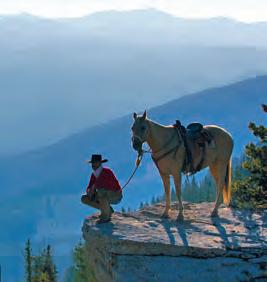



By Jacqueline Louie
The greatness of a nation and its moral progress can be judged by the way its animals are treated. —
Calgarian Karen Allen began volunteering at Bear Valley Rescue in Sundre, Alberta, a decade ago, to help heal after her horse Mac, a 34-year-old Connemara, passed away.
“It was healing to be with like-minded people who understood that the beauty, majesty, and true value of a horse was so much greater than the sum of what they could help us accomplish,” Allen says. “The thing that kept me going back was meeting these horses, seeing their beauty, and hearing their stories.”

volunteer program
MAHATMA GANDHI
Not long after Allen started volunteering at Bear Valley, the horse rescue took in a Thoroughbred mare and former racehorse named Walk Away Rene. Once quite successful, when she was no longer able to race she had been used as a broodmare and changed hands multiple times, says Allen. Somehow, Walk Away Rene ended up in Alberta. By now she was in her early 20s, had recently lost a foal, tried out unsuccessfully as a nurse mare, and was then abandoned at a vet clinic. That’s
when Bear Valley Rescue president Kathy Bartley got the call.
Walk Away Rene “was the saddest, most depressed creature you can ever imagine,” Allen recounts. “This magnificent racehorse, after all those years of being used up, was skin and bone.”
They couldn’t get the mare to eat despite several visits from the vet. The following week, Allen made a special mash of sweet carrots and bran and took it out to her. “She sniffed it, then turned her back and her head drooped down,” Allen says. “For me, the floodgates just opened. I sat down in the pasture crying and apologizing to her for the human race and what had been done to her. I told
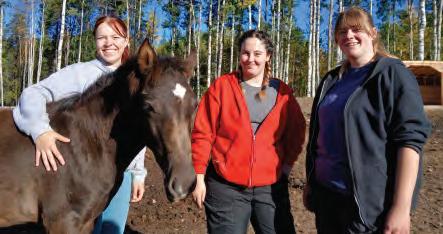
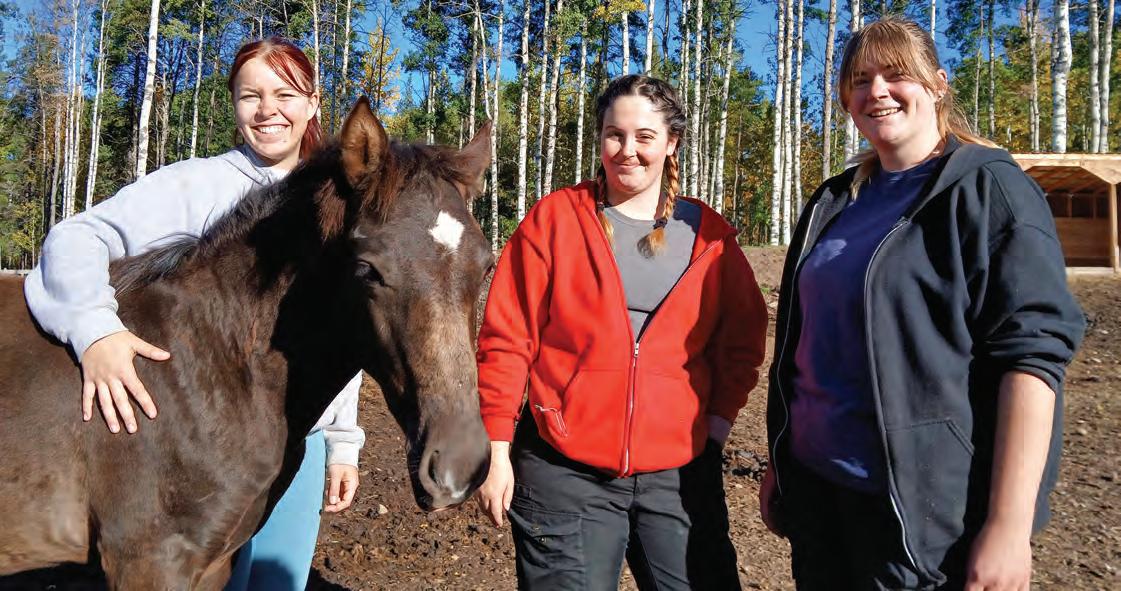




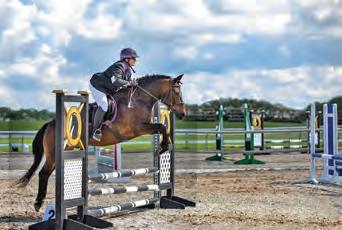
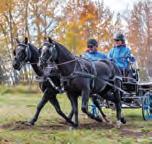








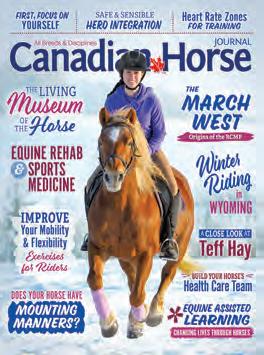

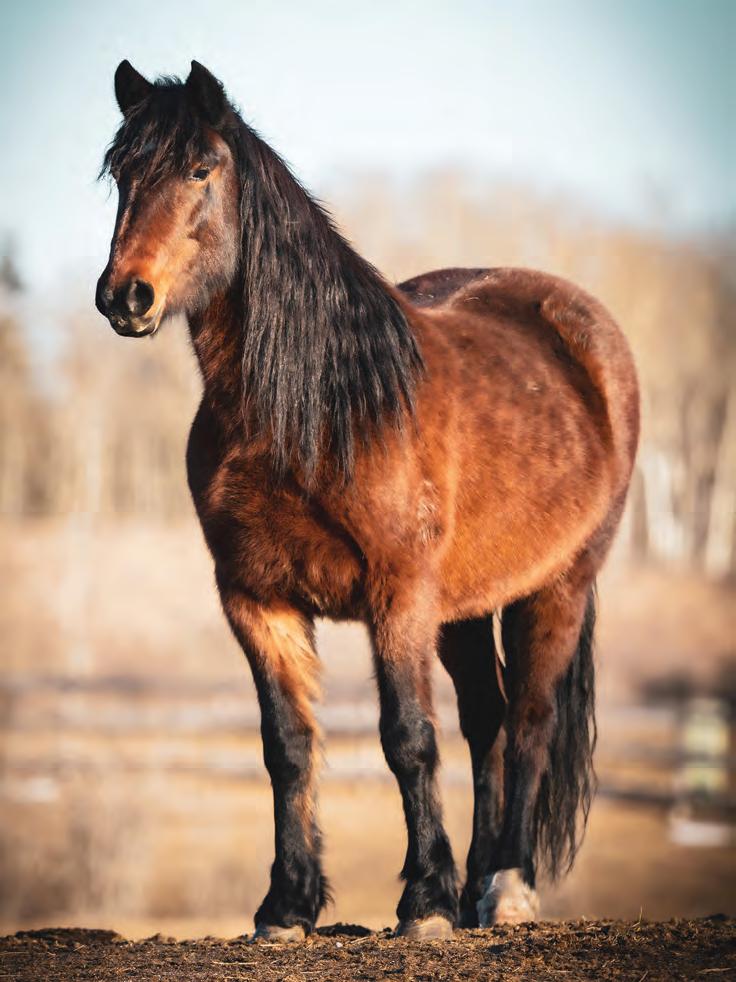
her how beautiful and magnificent she was, how she didn’t deserve what had happened to her.
“She turned around and walked over to me, dropped her head and her lips were quivering. Then she raised her head and put it over my shoulder. We just shared that beautiful moment… to me, that was living proof that we can connect with horses on a deeper level.”
Eventually, Bartley figured out what was going on with Walk Away Rene. Among other issues, the mare had a huge worm load. “She was also very depressed. She had lost her foal, was farmed out to another place for her milk, then dumped at a vet’s office. She was not wanted. They feel those things,” Allen says.
After Bear Valley restored Walk Away Rene to health, she was transferred to a foster home where she received the care and love she deserved. “Such a beautiful soul that I will always carry in my heart.” The story of Walk Away Rene and other rescued horses is on the Bear Valley Rescue website.
Since becoming a registered charity in 2005, Bear Valley Rescue — a horse rescue and animal welfare organization — has found homes for nearly 1,500 horses. Mike and Kathy Bartley started Bear Valley Rescue in 2003 on 16 hectares in the foothills northwest of Calgary. The couple went to a horse auction and decided to take action.
“We started finding them homes, got some more in, and it took off,” Kathy says.
At any given time, the rescue cares for more than 150 horses, with another 50 to 60 at foster homes across central Alberta. Many horses come from auctions or are owner-surrendered. Bear Valley takes in a range of horses, from elders to orphans just days old. They recently lost their most senior horse at age 42. Bear Valley rescues mares, geldings, and stallions. They’ve had just about every breed including Akhal-Teke, a rare breed from Turkmenistan; American Cream Draft, a rare American draft breed characterized by its cream or “gold champagne” coat colour; and racehorses that have won hundreds of thousands of dollars in prize money. A few years ago, 30 ponies came in at once. Bear Valley also takes unhandled horses, although now they can only take unhandled horses that are younger and easier to train.
“We try to help them the best we can, even if it means laying them to rest. That’s why we have a lot of permanent residents. We take in horses that have
nowhere else to go, or are in no condition to go anywhere else,” Kathy says.
Sending horses to slaughter can be an “easy out” for some breeders and horse owners, according to Kathy. Horse meat is exported from Canada to countries in Europe, Asia, and South America for human consumption, while live horses are exported from Canada to Japan where raw horse meat is considered a delicacy. Kathy emphasizes that it’s important for horse owners to consider what would happen to their animal if they could no longer care for it. “You see it all the time with dogs and cats,” she says. “Somebody
dies, and their relatives don’t want to look after it. Because a horse can live to be 30 or more, you have to consider what happens after you pass away. It’s harder to rehome a horse than a dog or a cat — there’s a narrower base of people who can take an animal like that in.”
Because horses can live such a long time, it’s possible they could be sold many times over the course of a lifetime. “It’s not the right horse, someone gets in over their head, they can’t afford the horse, the horse is not sound, their daughter is not interested in having a horse any more… There are a million reasons the average


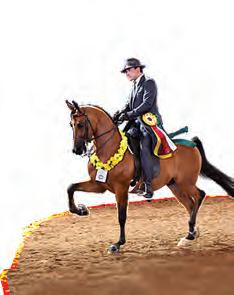

horse changes hands seven to eight times in a lifetime.”
Calgarian Linda Somers, 76, has been volunteering for Bear Valley for nearly two decades. She’s done everything, including groundwork, educational programs, tours, media and public outreach, as well as fundraising for a wide variety of projects.
She says when Kathy sees an animal needing help, it doesn’t matter if it’s old, young, or in need of vet care. “She sees the soul of an animal needing help, and she’s going to help it,” Somers says.
“This is from the bottom of my heart. I have always considered volunteering at Bear Valley [to be] a privilege. When I get to Bear Valley, I see a place of absolute love for the animals. The care those animals get, the attention — I see it as a privilege to enter that kind of world. My passion is to help animals, and at Bear Valley I have the opportunity to help horses without having to own one. I help wherever I can, and I’m thrilled to support them. It’s just the best.
us. What happens to them?”
To adopt a horse from Bear Valley, a potential owner must have some horse knowledge, because many rescued horses come with health or temperament issues or need training. “A lot of times people who love horses call and want to get their first horse, but a lot of the ones we have are not really suitable for a first-time horse owner,” Kathy says.
Calgarian Leane Ingram, a longtime Bear Valley volunteer, adopted the Belgian-Quarter Horse named Maggie from Bear Valley more than five years ago. Now about 23 years old, Maggie was surrendered into Bear Valley’s care after her previous owner could no longer care for her. Ingram, who grew up riding horses, instantly fell in love with Maggie’s picture when it was posted on the Bear Valley Facebook page.




“They are so kind,” Somers says of the Bartleys. She describes shopping for petunias with Kathy once. Somers bought big, beautiful petunias, while Kathy’s petunias were the saddest-looking Somers had ever seen. Somers asked Kathy why she bought half-dead petunias; Kathy replied that those were the ones that needed her the most.
“The need is huge, and I’d like people to think about what happens to a horse when it is no longer useful to people as a tool. These are all horses that have served
“She’s one of the best things in my life,” says Ingram, who goes trail riding with Maggie in the foothills west of Calgary. “She’s taught me so much about myself, about patience. She has made me a better person. If I’m having a bad day, she will nuzzle her head into me as if to say: It’s going to be okay. She’s brought me so much joy. She just makes things better and every worry goes away when I’m with her.”
Ingram believes it’s incredibly important to keep these rescue horses in mind. The reward for both you and the horse is beyond words, she says — witnessing their journey from where they started to where they are now imparts an unparalleled sense of accomplishment. Seeing them thrive in their new homes, happy and healthy, is
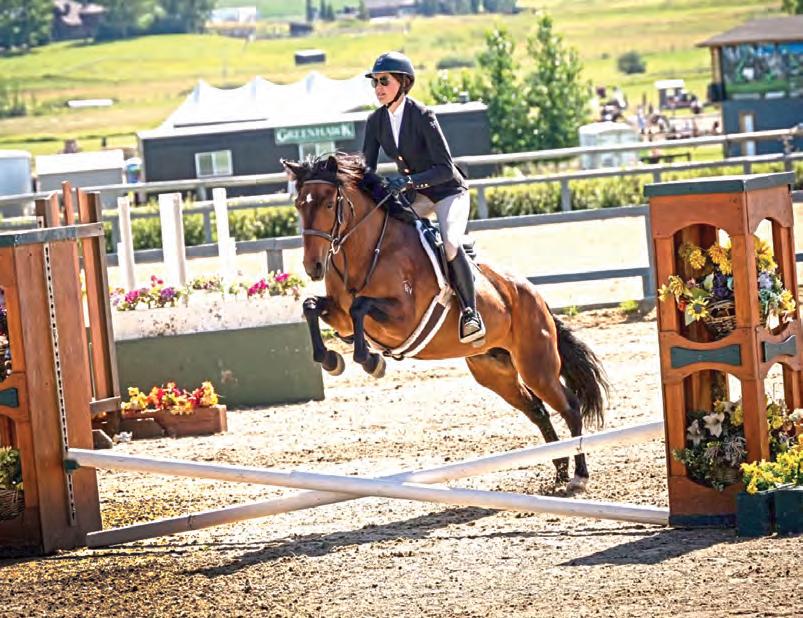
truly the greatest reward.
“I’m thankful to Kathy and Mike for allowing me to bring Maggie into my family. Without them, it would never have happened.”
Volunteer Leanne van der Merwe, 21, from Cochrane, adopted seven-year-old mare Tampa (renamed Ivy) from Bear Valley in 2023. Van der Merwe and her mother have volunteered at Bear Valley for several years including helping to fundraise. They believe Ivy is an Alberta wild horse. Bear Valley saved her from being sold for meat, and when the family saw a picture of the 14-hand mare they immediately fell in love.
Leanne started Ivy under saddle, with help from southern Alberta-based cowboy Kent Williamson, who worked with Ivy and Leanne for a couple of months. This past summer, Leanne took Ivy to her first show. “She is so incredibly smart. When we first got her, she was very fearful. It’s really incredible to see her come out of her shell.”
Leanne emphasizes that she will never sell a horse again because of what she knows could happen. In 2020, she sold a horse that ended up in a bad situation and she wasn’t able to save him.
“I blamed myself for a long time, but I
know it’s not my fault. I did a lot to make sure it was a suitable home and it’s just unfortunate,” she says. “They’re not just a horse — they’re your partner. They become your best friend.”
With Ivy, “it’s absolutely been healing for me to give a different horse a good chance at a good life in a forever home. That’s what I love about Bear Valley. That’s why we’ve supported them for so many years. They just want to give these horses the chance at life that they deserve.”
Bear Valley is committed to rescuing slaughter-bound horses and raising awareness of their plight. Entirely volunteer-run, the rescue relies on passionate individuals for fundraising, public outreach, horse fostering, and countless other efforts.
Allen is currently Bear Valley’s international volunteer coordinator. She began volunteering after she lost Mac, a horse she had ridden and shown since he was 12. Allen retired Mac from dressage when he was 21; she spent the next 13 years hanging out with him in his pasture, and learning about him in a completely different way.
“What I learned more than anything is that I could have this really great relationship with my horse without
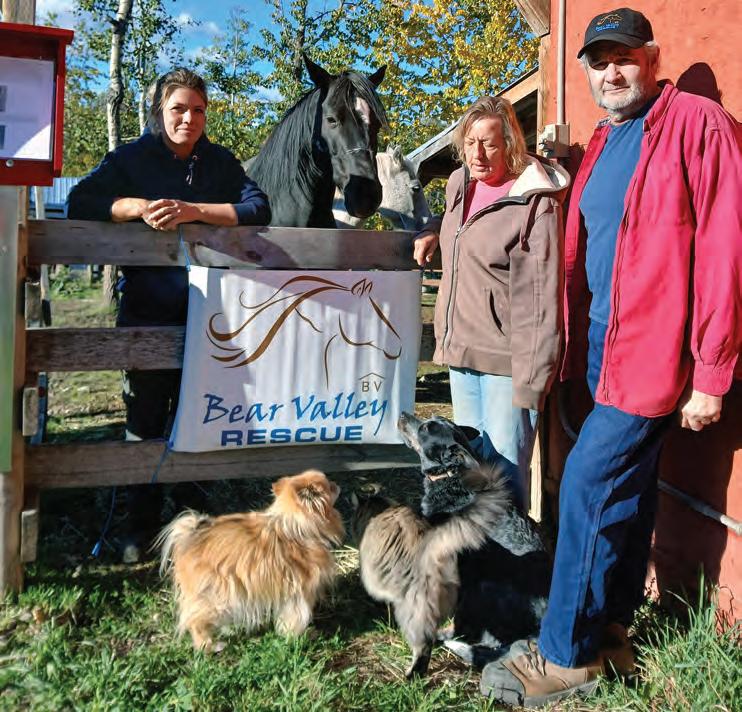
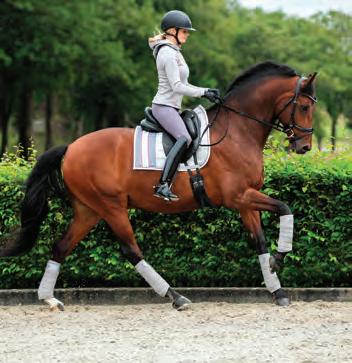




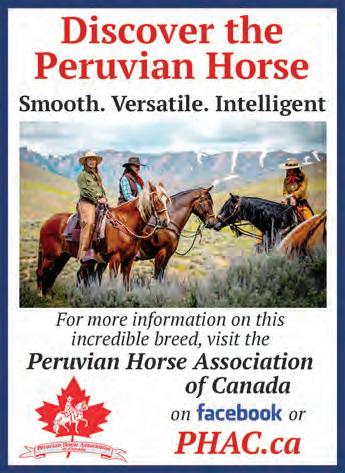
riding him.” She recounts witnessing firsthand the profound bonds horses share — they form friendships, experience deep emotions, and feel joy, sadness, anger, and even depression. They grieve deeply when they lose a pasture mate, whether it’s due to relocation or passing away.
“I started to think about the fact that we use horses like tools; they become expendable when they aren’t useful to us anymore. We don’t think about the fact that they are sentient beings with deep feelings. We need to start thinking about what a horse can bring to us. They’re such mirrors of our emotions, deeply sensitive animals. They’re creatures of flight, so they’re very, very aware of the slightest movement, the slightest change in mood or direction.
“I learned so much, not just about horses but also about myself in those years sharing space in the pasture with Mac. It was a gift, and I felt a great need to give something back. That’s when I found Bear Valley.”
To say it’s a lot of work to operate Bear Valley is an understatement. Because of Bear Valley’s remote location, it isn’t easy to attract volunteers. Allen used to drive


to Bear Valley from Calgary on Saturdays to feed horses, clean buckets and paddocks, and do all the regular chores. “That’s what led me to develop this program. I would be there on Saturday, but when I left there was so much work still to be done and only Mike and Kathy to do it from Sunday through Friday,” she explains. “I felt they really needed more feet on the ground and more support. For two people and the number of horses they have out there, the workload is just astronomical. There were times they were going 24/7 when an emergency came in.”
About six years ago Allen and another volunteer began exploring the possibility of setting up an international volunteer program. “Once we threw it out there, we started to get some bites and we haven’t looked back.”
Bear Valley’s international volunteer program allows visitors from abroad to stay at a ranch in Canada while also providing critical support for the rescue. Most volunteers are between the ages of 18 and 40 and come from Germany, France, Australia, New Zealand, Great Britain, Belgium, and Japan. Three volunteers stay on site, usually for two to
three months at a time, to help with the day-to-day running of Bear Valley, feeding and caring for the horses, fixing fences, doing maintenance, and other tasks.
Bear Valley brings in international volunteers through a variety of streams including Natucate in Germany, Worldwide Opportunities on Organic Farms (WWOOF), and direct contact. While the international volunteer program is still young, it’s going well, and some volunteers have returned because they had such a positive experience the first time. The on-site volunteer program is open to volunteers from abroad and from Canada.
Part of their mission, in addition to having assistance with the daily chores and workload, is education and raising awareness of the magnitude of the problem of discarded horses. They end up slaughterbound unless someone intervenes.
On-site volunteers learn a lot in many ways.
“I had always wanted to come to Canada. This was the perfect opportunity,” says volunteer Julia Roth, 19, from Germany. “I also like that you get to see parts of another country and not in a touristy way. I think this whole program will leave me
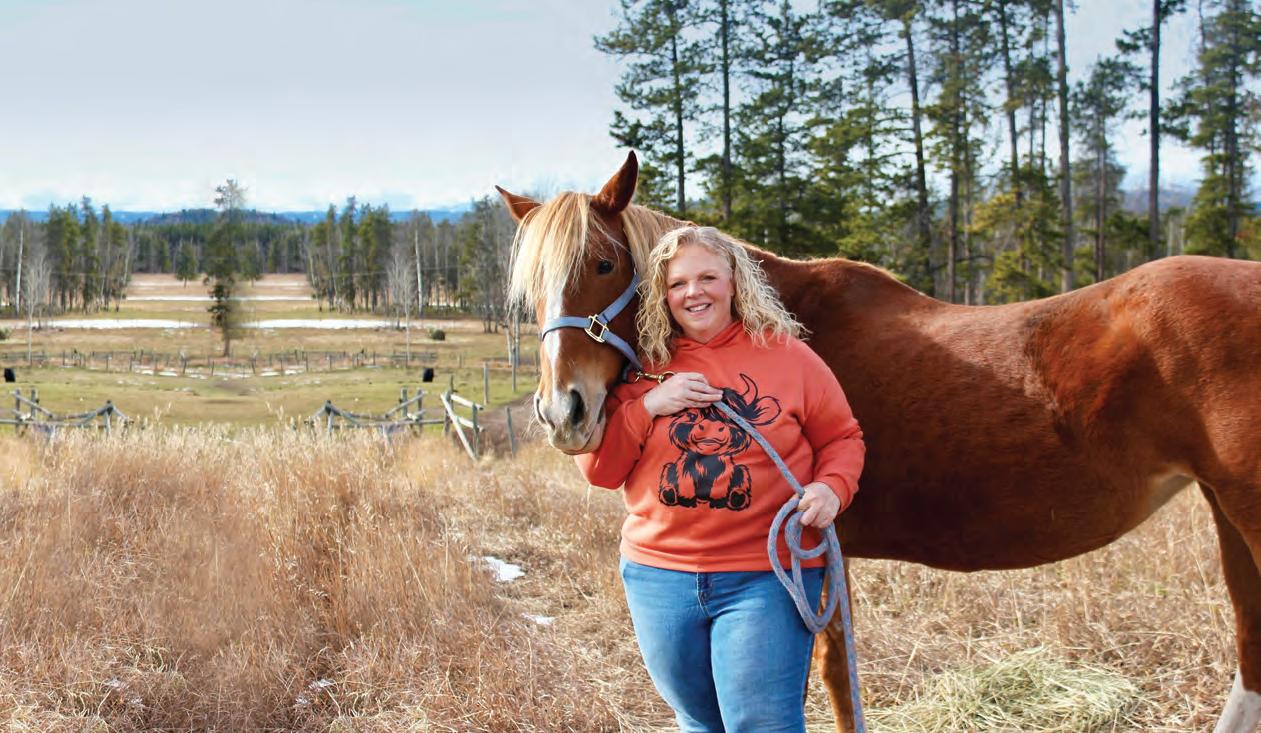
with wider experience and a more open mind towards meeting new people.”
“I love working with horses,” says Janika Neumann, 25, from Germany. She first came to volunteer a couple of years ago and returned this past fall. “It’s really fun. It’s different every day. And you get to know the horses more as individuals — you actually get to know them in their normal lives.”
Volunteer Kyanna Gilks, 24, from Nova Scotia enjoys “always learning more about horses.”
Bear Valley general manager Astrid Cibron-Bartley first came to Bear Valley in 2019 from France as a summer volunteer and is now the Bartleys’ daughter-in-law.
Cibron-Bartley finds it incredibly rewarding to see horses that arrived at the rescue in poor condition or fearful of humans gradually open up, regain trust, and improve in health, sometimes even reaching the point where they can be adopted out into loving homes.
If a volunteer is not super interested in horses but has other interests, such as carpentry or construction, they can be very helpful as there is always maintenance work to be done. Cibron-Bartley says Bear Valley has had lots of people
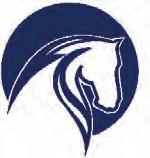
without horse experience and most ended up staying longer than expected.
As an animal welfare organization, Bear Valley Rescue requires considerable resources to operate. For many years, the Bartleys put a lot of their own money into the rescue. Now, the rescue runs solely on grants and donations. Bear Valley fundraises year-round and engages in public outreach, such as attending markets, to help raise the more than $500,000 needed annually to care for the horses.
You can help the rescue in a variety of ways. A lifetime membership in Bear Valley Rescue Society is $25, resident horses can be sponsored, and donations of used tack, money, or gifts-in-kind are welcomed. Hay for the horses is their largest single expense. It also helps just to “spread the word about the good work they’re doing,” says Somers.
Horses available for adoption are listed on the Bear Valley Rescue website. There are also older and special needs horses, suitable as companion animals only, that need fostering.
For more information about Bear Valley Rescue, contact Kathy Bartley at bearvalleyab@aol.com or 403-637-2708.
Manitoba Horse Council (MHC) is a not-for-profit organization representing individual members and clubs involved in equine activity in Manitoba. As the recognized governing body for equestrian sport in the province, MHC provides support, leadership, and resources to develop athletes and protect the interests of Manitoba’s equestrian enthusiasts.
By bringing together the province’s horse people and giving them a much-needed voice, MHC helps to ensure that activities with horses continue to be accessible to horse people and remain part of Canadian society.
Join MHC and show your support for their programs and services, which provide many benefits to members including educational opportunities, programs for equestrians of all ages, funding options, insurance, and a wealth of other resources.
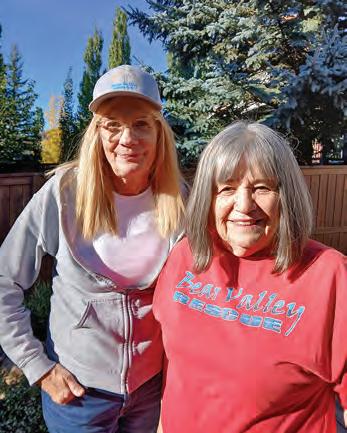
> www.bearvalleyab.org
> www.facebook.com/bearvalleyab
> www.natucate.com/en
> www.wwoof.net
> Jacqueline Louie is a frequent contributor to this magazine — read her bio on page 102




There are FIVE Mondays this March (which sounds like a bummer) but that means we have FIVE great webinars coming your way. Join us at 7 pm PST each Monday in March. Registration is now open! Register once for all five webinars; if you need to miss a week or are only interested in a few, it’s not a problem (but we will still email you the link). These sessions are only available live at this time, so mark your calendars! This event is free for HCBC members but preregistration is required. Non-members can register for $100 plus tax.
March 3 — Dr. David Paton: Some Do’s and Don’ts That Might Save Your Horse’s Life
March 10 — Dr. Steve Chiasson: Acupuncture Treatment for Horses
March 17 — Dr. Michelle Husulak: Equine Parasites, Best Practices for Treatment and Prevention
March 24 — Dr. Erin Pinnell: Thermoregulation in Horses: Blanketing and Clipping in Context to your Environment
March 31 — Debra Cornish: Helmets & Safety Vests, An Overview of Innovation and Industry Standards
View the speaker bios and registration information here: www.hcbc.ca/newsevents/webinars
Save the date! The 55+ BC Games are headed to Nanaimo!
Venue: Beban Park, 2300 Bowen Road, Nanaimo, BC
The 55+ Games will be held September 9-13, 2025 and will see 25 sports and activities offered for the 2500+ anticipated participants.
The 55+ BC Games are an important part of the BC sport system and the largest annual multi-sport gathering event in the province. The Games offer the opportunity to celebrate sport and active living with other participants from across the province and experience the hospitality of the host city.
Each year, the Games attract approximately 2,500 participants and require over 1,200 volunteers to stage and deliver the Games in the host community.
Participant registration for the Nanaimo 2025 55+ BC Games is scheduled to begin on March 1, 2025.
If you are interested in helping to bring the Games to Nanaimo as a volunteer, please visit
the Volunteer Information page at www.55plusbcgames.org/nanaimo
Equestrian competition will be held at Beban Park, Nanaimo.
Stay tuned for exciting information on the plans for major upgrades to the equestrian facility at Beban Park.
Disciplines included in the 2025 55+ Games:
• Dressage/Western Dressage
• Driving Trials
• Working Equitation
• Working Hunter
Jodie Moore is a carded judge with APHA, PTHA, ASHA, WRHA, EXCA and HCBC, and an APHA Professional Horseman. This is Jodie’s 40th year in the industry, and she and her clients have amassed world and national championships and high point all-arounds on the Paint, Pinto, Quarter Horse, Appaloosa, and Arabian circuits. Jodie runs her training and coaching business Freedom Farms Livestock out of Langley, BC along with her partner, TJ Bews and son Matthew, who also work in the movie horse business.
Date: March 22-23, 2025
Location: Coast Prince George Hotel, 770 Brunswick Street, Prince George, BC (lunch and snacks provided.)
Cost: 100.00
Registration closes March 18, 2025. www.hcbc.online/EventReg
HCBC’s Annual Awards honour outstanding achievement within BC’s equine community. These awards acknowledge those who stand out from the
OFFICE HOURS: Monday to Friday, 8:30 am to 4:30 pm
OFFICE ADDRESS: 27336 Fraser Highway, Aldergrove, BC, V4W 3N5
PHONE: 604-856-4304
FAX: 604-856-4302
TOLL-FREE: 1-800-345-8055
WEBSITE: www.hcbc.ca
BY JOCELYN ADAMS PLASMAN
crowd and have made a positive impact on the equestrian community.
Congratulations to the worthy recipients of the Horse Council BC’s 2024 Awards! We received many outstanding nominations this year, so thank you to all who nominated someone and CONGRATULATIONS TO OUR WINNERS!
2024 Coach of the Year
Elizabeth (Lizzie) Gringas
2024 Bob James Volunteer of the Year
Avery Wilkinson
2024 Sherman Olson Lifetime Achievement
Award – Bonnie Kennedy
After much deliberation and consideration, Horse Council BC, in consultation with the BC Games Society, has made the difficult decision to withdraw from the BC Summer Games. This decision comes in response to the rising costs associated with attending the Games, a continued erosion in our provincial sport funding, a lack of cost-feasible venues within the Games site regions, no national support for the Games system (Equestrian Canada does not participate in the Canada Summer Games), and ongoing challenges within our community to meet the Games’ participant and volunteer requirements.
We deeply value our partnership with the BC Games Society and have thoroughly enjoyed our time spent with the Games. The working relationship with Games staff has been exemplary, and we are immensely grateful for the efforts and collaboration experienced in past events.
We would also like to take this opportunity to thank all the participants and volunteers who have made our past participation in the Games so memorable. Thank you for your commitment to the sport and the Games program.
View the full statement at www.hcbc.ca
EXECUTIVE DIRECTOR: administration@hcbc.ca
AGRICULTURE & INDUSTRY: industry@hcbc.ca
MEMBERSHIP: membership@hcbc.ca
COACHING & EDUCATION: coaching@hcbc.ca
MARKETING & COMMUNICATIONS: communication@hcbc.ca
RECREATION & TRAILS: recreation@hcbc.ca
COMPETITION: competition@hcbc.ca
COMMUNITY DEVELOPMENT: development@hcbc.ca
HCBC BOOKSTORE: bookstore@hcbc.ca
FINANCE & GRANT FUNDING: finance@hcbc.ca
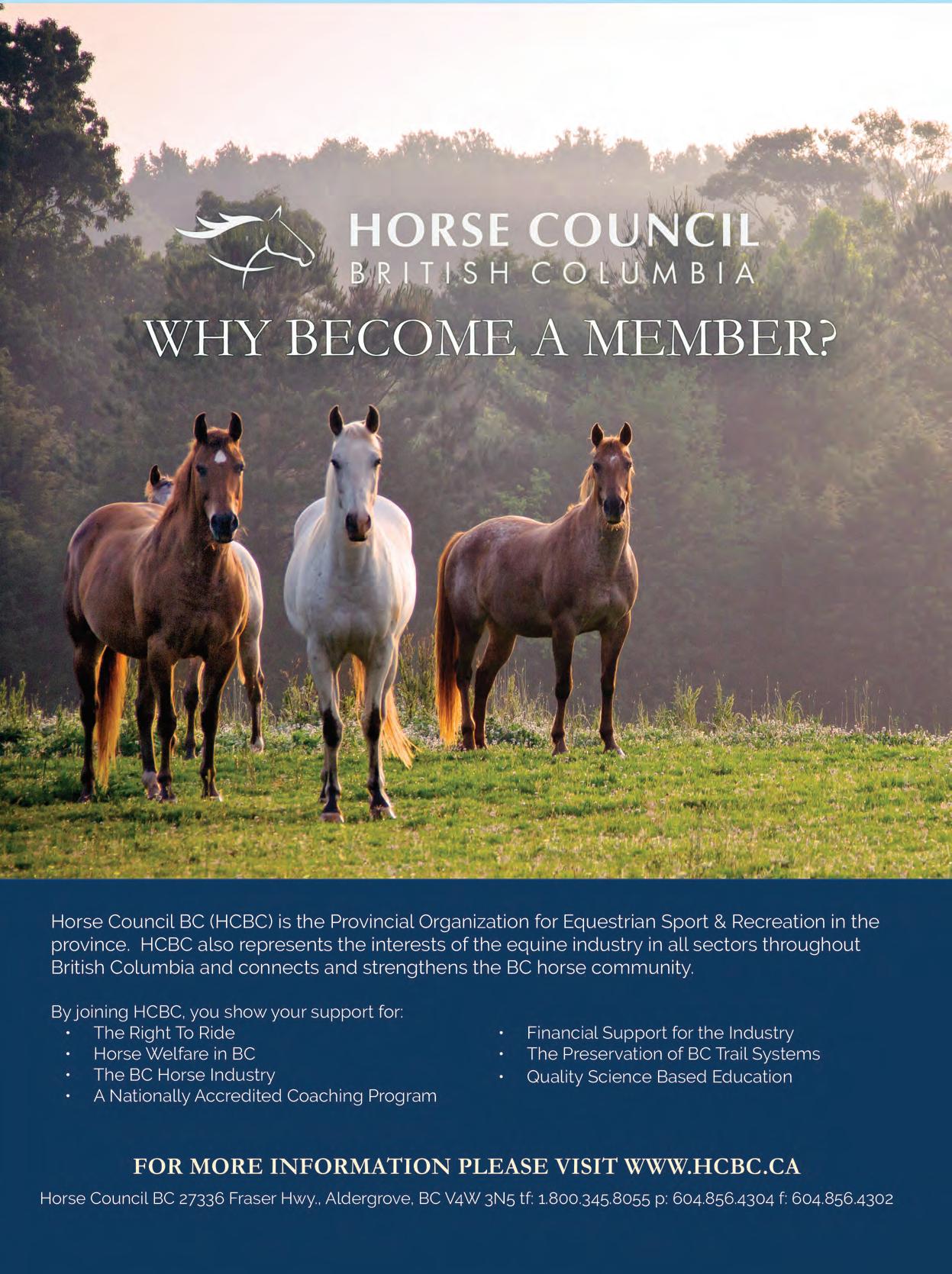

By Andrea D. Gow, M.Cl.Sc
Building communication skills is the first step toward helping children and adults with special needs develop their full potential... if that first step is on horseback, so much the better! Supporting communication skills allows everyone to “get their message across.”
Three areas of my life came together and led me to Sunrise Therapeutic Riding & Learning Centre (Sunrise), to CanTRA, and to the opportunity to volunteer as a consulting speech language pathologist (SLP): • My passion for interacting with people with special needs. I have a cousin with Down syndrome who has been a very important part
of my life.
• My work as a speech-language pathologist (SLP). Although I am now retired, I have worked with preschool and school age children and adults in community, hospital, and educational settings over the last 38 years.
• My love of horses. I rode Western as a teenager and got back in the saddle, an English saddle this time, in my 50s!
As a consulting SLP volunteer, I have been able to provide information about communication strategies to support the fabulous work of our therapeutic riding instructors. One of the main
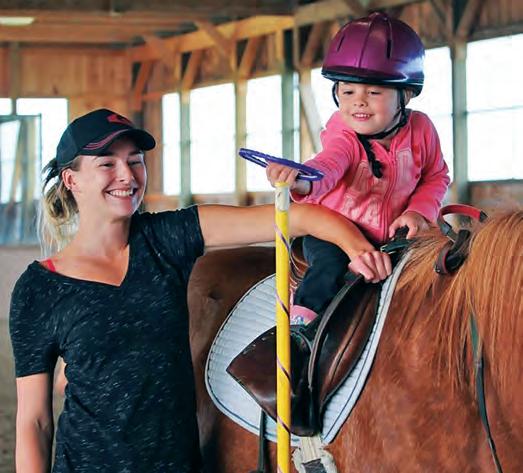

differences between a therapeutic riding program and a traditional clinical setting is that the farm offers “greener pastures” for communication. Motivation and engagement are found at the barn! Horses are fun! Riding is fun!
General language facilitation strategies are used to keep communication flowing in the riding arena. For example, it is important to use the rider’s name and use cue words such as Look, Listen, Prepare, etc., and to be animated. There are many visual distractions that would not be present in a clinical setting. However, the rider’s connection with the horse and the empowerment felt by “holding the reins” produces an engaging and productive learning situation. This creates the best environment possible for communicating with the rider. Riders
want to be there to participate, learn, and communicate!
Some riders use augmentative and alternative communication (AAC) to communicate. AAC is a combination of techniques and tools used to communicate a message when speech is not sufficient to meet the communicator’s needs. AAC supports expressive, receptive, and social communication skills. It is not the intent or scope of this article to review AAC. It is a fascinating, everchanging, and very individualized area of speech and language pathology.
The information in this article is just the “tip of the iceberg” — or should I say “tip of the haystack” — when it comes to supporting communication skills in the therapeutic riding arena. b
> Andrea D. Gow, M. Cl. Sc., is registered as a non-practising member of the College of Audiologists and Speech-Language Pathologists of Ontario, (CASLPO) and is a CanTRA member.
Photos courtesy of CanTRA, shared from CanTRA accredited therapeutic riding program sessions.
For more information or to find a centre near you please contact our Head Office at ctra@golden.net. Follow us on Facebook @Cantra.ACET and visit > www.Cantra.ca or donate at > www.CanadaHelps.org.
By Laurie Haughton, Chair, CQHA Media, Marketing & Communications Committee
The Canadian Quarter Horse Association (CQHA) has long been a cornerstone of Canada’s equestrian community, dedicated to promoting and supporting the American Quarter Horse breed across the nation. Through a variety of programs and events, the CQHA fosters a sense of unity and excellence among breeders, riders, and enthusiasts.
In 2024, Canadian riders showcased their exceptional talents at the AQHA Level 1 Championships. At the East Level 1 Championship, held from April 22-28 at the World Equestrian Center in Wilmington, Ohio, Lynn M. McLean from Ellershouse, Nova Scotia earned the High Point NSBA Rookie Amateur title with her 2018 gelding, Only One More Drink. Additionally, Kamyl Mathieu of Sainte-Victoire-de-Sorel, Quebec secured the Champion title in L1 Amateur Reining with Spookismatic, a 2012 gelding.
On the western front, the AQHA West Level 1 Championships held in May, 2024 saw remarkable performances by Canadian participants. Shelby L. Devet from Lacombe, Alberta achieved the Level 1 Amateur All-Around Champion title with her Canadian-bred mare, No Doubt Chex Me Out. Karen Bishop of Saskatoon, Saskatchewan became the Champion in L1 Amateur Hunt
Seat Equitation with her 2017 gelding, Jerry Lee Lopin. In addition, Caitlyn C. Malyk from Clive, Alberta earned the Champion title in L1 Amateur Performance Halter Geldings with her Canadian-bred gelding, Willy Southern.
In the AQHA racing world, Had To Be Ivory set a new track record for 110 yards at Ajax Downs on the closing day (October 31) of the 2024 Quarter Horse season. The nine-year-old gelding exploded from the gate at the rail post and surged ahead, crossing the finish one-andone-half lengths in front of his rivals. With a sizzling time of 6.761 seconds, he broke the five-year record set by Carneros of 6.770 seconds. While the world record for this distance, 6.660 seconds, was set in Mexico City in 2022 by Divas First Anita, Had To Be Ivory’s remarkable performance marked the fastest time for this distance ever recorded in Canada and the USA. This achievement was especially surprising as it was the first time Ivory had competed at the 110-yard distance, making his recordbreaking run even more impressive. With 29 career
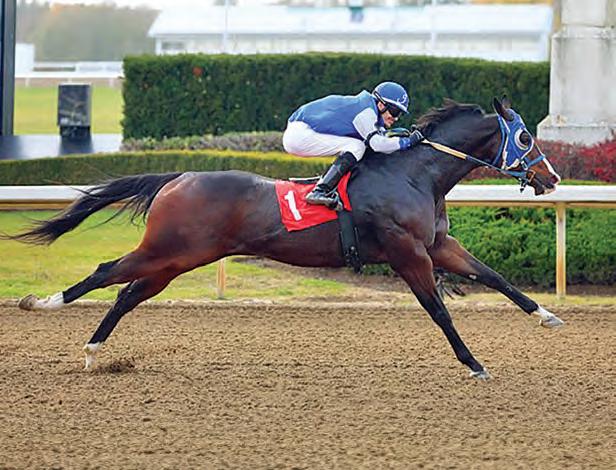
wins out of 39 starts and lifetime earnings of $365,726 CAD, Ivory stands as the winningest horse in Canadian Quarter Horse Racing history. The CQHA also takes pride in recognizing outstanding achievements within the community. The winners of each award are honoured through the association’s website and social media platforms and are presented with a custom Canadian-made silver trophy buckle.
Canadian Bred Horse of the Year: Had To Be Ivory, Ontario bred and owned
Trainer of the Year: Deserie Bitz of Alberta
Youth of the Year: Emily Furth of British Columbia
Amateur of the Year: Shelby Devet of Alberta
Racehorse Breeder of the Year: Stojan Quarter Horses of Alberta
Ranch Horse Breeder of the Year: Donald Sobey, of Nova Scotia
Performance Horse Breeder
of the Year: Cory Seebach and Dr. Candice Hall of British Columbia
As we reflect on the accomplishments of 2024, the CQHA extends heartfelt congratulations to all the award winners and participants who have demonstrated dedication, skill, and passion in their pursuits. Your achievements not only highlight individual excellence but also contribute to the rich tapestry of Canada’s Quarter Horse heritage.
Looking ahead, the CQHA remains committed to supporting and celebrating the endeavours of its members. With a continued focus on fostering community, promoting education, and encouraging participation, the association eagerly anticipates the milestones and successes that 2025 will undoubtedly bring.
To stay informed about upcoming events, programs, and news, members and enthusiasts are encouraged to visit the CQHA’s official website at www.cqha.ca Together, we will continue to uphold the legacy and advance the future of the Canadian Quarter Horse community. b
For more information about the Canadian Quarter Horse Association please visit > www.CQHA.ca or email > info@cqha.ca. Follow us on Facebook and Instagram @cndquarterhorseassoc, and on X @CndQuarterHorse.
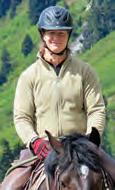
Tania Millen
Tania Millen is an awardwinning freelance writer and author with a Master’s in Journalism and a BSc in Environmental Science. She’s written four books, including Go Horse Camping and Pack’em Up, Ride’em Out: Classic Horse Pack Trips in BC and Alberta. A former 3-day event rider, she now enjoys mountain pack trips. www.TaniaMillen.com

“Is it me or my horse?”
Horse show judge, coach, trainer, and specialist in equine behaviour, Lindsay Grice helps riders solve their “horse puzzles,” sharing keys from the science and research of how horses think and learn. She holds judging certifications in multiple disciplines — Western, hunter/jumper, dressage and obstacle events. Lindsay has taught classes and seminars in Equitation Science for provincial equine associations, therapeutic riding facilities, and courses offered by the University of Guelph. She regularly conducts clinics for horse clubs and private farms. www.LindsayGriceRidingCoach.com
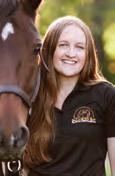
Madeline Boast is an independent equine nutritionist based in Ontario. Upon completing her Bachelor’s Degree in Equine Management and Master’s Degree in Equine Nutrition, she launched Balanced Bay, a full service and independent equine nutrition consulting company. Through Balanced Bay she works with horses across North America, from competing Thoroughbreds to companion ponies and everything in between. Her primary focus is to create optimal and personalized forage-based nutrition plans as well as educate horse owners on equine nutrition. www.balancedbay.ca

Shawn Hamilton
Shawn Hamilton is a freelance equine photojournalist based in Ontario. She has operated Clix Photography since 1984, offering a full range of photography services for editorial and commercial use from health to Olympic sports. Her photography can be found on the covers and inside numerous magazines in Canada and the US, including Canadian Horse Journal. Shawn has co-authored four non-fiction children’s books published by Scholastic Canada. Her written articles specialize in equestrian travel. www.ClixPhoto.com

Alexa Linton is known for lighting up her world with her infectious personality, bold facilitation style, and often irreverent, tongue-incheek writing, and for her menagerie of a therapeutic practice. The latter combines her degree in Kinesiology, diploma in Osteopathy Manual Practice, and over a decade of training in BodyTalk and animal communication. From over 14 years of working with horses as an Equine Sport Therapist, and helping thousands of animals and people, Alexa has developed a therapeutic style that is intuitive and highly collaborative. She is the co-founder of the Cowgirl Re-union, the creator of the Whole Horse Apprenticeship and Podcast, and author of Death Sucks: A Straight-Up Guide to Navigating Your Pet’s Final Transition. She resides in the Cowichan Valley, unceded territory of the Cowichan and Coast Salish Peoples, on Vancouver Island, BC, with her horses Diva and Raven, dogs Reilly and Solo, and cat Parker.
www.AlexaLinton.com
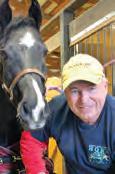
Dean Sinclair
Dean Sinclair has been active in the field of farriery in British Columbia and Alberta for over 45 years as a working farrier, teacher, mentor, and competitor. After obtaining his certificate in Farrier Science at Olds College in Alberta in 1979, Dean returned to BC’s Okanagan Valley where he started a mixed practice out of Kelowna. In 2000, Dean returned to Olds College as the Coordinator and Head Instructor of the Farrier Science program, a position he held for 14 years. Today Dean continues to hone his craft, shoeing horses part-time in Vernon, BC and is enjoying semi-retirement with his wife Michelle at their home on Okanagan Lake.
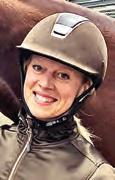
Sandra is a Licensed High Performance Dressage Coach, FEI grand prix rider, Equestrian Canada Coach Developer/Evaluator, and Certified Pilates Instructor. She has over 25 years of experience working with riders of all levels to improve position and overall effectiveness in the saddle. Sandra has extensive experience coaching internationally and conducts clinics and workshops in dressage, rider cross-training, and instructor development. Sandra operates her dressage training business SVZ Dressage and Fit To Ride (F2R) Pilates for Equestrians in Langley, BC. She is currently working towards her Master’s degree in High Performance Coaching and Technical Leadership at the University of British Columbia. www.fit2ride.ca

Annika McGivern is a Mental Performance Consultant who grew up as a Three-Day-Event rider in British Columbia. Her passion for eventing took her to Ireland, Australia, and America as a working student to world class riders, where she developed a keen interest in the psychological side of sport and performance. Annika has a BA in Psychology, an MSc in Sport and Exercise Psychology, and seven years experience as a certified Equestrian Canada Competition Coach. Annika works with athletes and coaches, in person and online, to help them find enjoyment and satisfaction in their sport through achieving their best possible results and outcomes. www.annikamcgivern.com

Monique Noble is an awardwinning Alberta-based photographer whose talent behind the lens developed with old school film and dark room technology, which naturally progressed into digital single-lens reflex cameras and the digital lightroom. Monique’s photojournalistic style, coupled with her love of horses and the written word, led to a flourishing freelance writing career, which allows her to wander mountains with her horses, travel, and compete at national and international reining competitions all while working wherever her computer plugs in. www.facebook.com/starizonimages
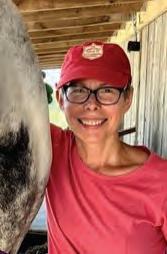
Li Robbins is a freelance writer and former CBC producer whose work has appeared in the Globe and Mail, the Toronto Star, Horse Sport and Horse Canada, among other publications. A hunter-jumper rider in her youth, Li has become a dedicated “re-rider,” thanks to her young half-Arab half-Paint mare, Pippin. www.lirobbins.ca
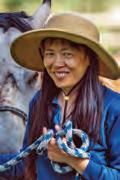
Jacqueline Louie is a Calgarybased freelance writer and editor, and a member of the Travel Media Association of Canada, the Canadian Freelance Guild, and the International Association of Business Communicators. She won a 2022 Travel Media Association of Canada Certificate of Excellence for Second Place for Best Indigenous Tourism Experience Story. Jacqueline has taken the Painted Warriors Horseback Riding Backcountry Bootcamp (Levels 1 and 2) and is inspired to learn more. Currently, she is taking bareback riding lessons at Eagle Feather Riding west of Calgary. Jacquelinelouie.ca

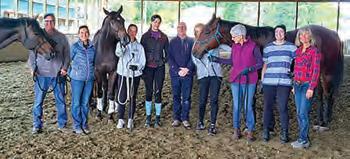

Do




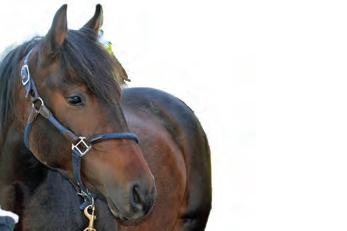
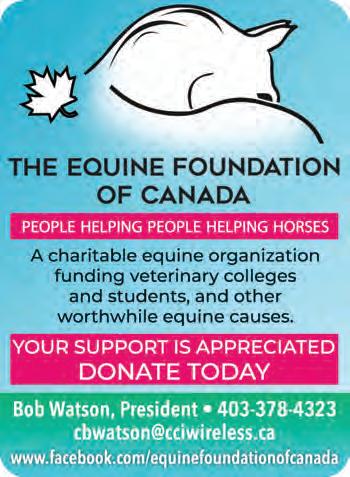


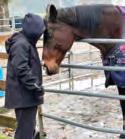







Northern Dancer was an extraordinary horse who captured Canada’s spirit and inspired immense national pride.
Born on May 27, 1961, at E.P. Taylor’s Windfields Farm in Oshawa, Ontario, Northern Dancer was initially underestimated. He was the first foal of Natalma, sired by Native Dancer, and part of the first foal crop of Nearctic. Despite his pedigree, the late-season colt, officially aged January 1 like all Thoroughbreds in the Northern Hemisphere, was younger and smaller than most of his peers. Standing just 14.2 hands as a yearling, his unruly nature and small stature led to a failure to meet his $25,000 reserve price at auction — a setback that would later prove to be a blessing.
By maturity, Northern Dancer had grown to 15.1 hands, with powerful hindquarters, agility, and exceptional speed. Over two years of racing, Northern Dancer won 14 of his 18 starts, including nine major stakes victories, and never finished worse than third.
In 1963, as a two-year-old, Northern Dancer silenced critics who mocked him
as the “little Canadian horse” by winning seven of nine races and earning the Canadian Juvenile Championship. His legendary status was cemented the following year, though not without its challenges. Preparing for the Flamingo Stakes in early 1964, jockey Bobby Ussery disobeyed trainer Horatio Luro’s instruction not to use the whip. The colt finished third, but the experience left him shaken, requiring two weeks of patient retraining to rebuild his confidence.
Northern Dancer’s turning point came on February 24, 1964, in an exhibition race at Hialeah Park, Florida. With legendary jockey Bill Shoemaker aboard, his gentle and masterful touch restored the colt’s trust and spirit, leading to a decisive seven-length victory.
On May 2, 1964, Northern Dancer made history as the first Canadian-bred, Canadian-owned horse to win the Kentucky Derby. From post position seven, he stormed to victory in a recordbreaking two-minute dash under jockey Bill Hartack, captivating the racing world. Two weeks later, he secured the
Northern Dancer, with Bill Hartack up.
Preakness Stakes, followed by a triumph in the Queen’s Plate, which would be his final race. A bowed tendon in July during a workout at Belmont Park ended his racing career. At the time of his retirement from racing, he had earned over $580,000, a Canadian-bred record, and held titles including US Champion Three-Year-Old Colt, Canadian Horse of the Year, and Canadian Athlete of the Year. To this day, Northern Dancer is the only horse to win both the Kentucky Derby and the Queen’s Plate.
Like his sire Nearctic and grandsire Nearco, Northern Dancer had a fiery temperament and a dominant personality. While some called for him to be gelded, Taylor’s decision to keep him intact reshaped the future of Thoroughbred breeding. From 1965 to 1990, Northern Dancer became the most influential sire of modern Thoroughbreds, producing 146 stakes winners and revolutionizing bloodlines worldwide. His stud fees soared to $1 million, and by 2000, his influence was unmatched. His descendants, known for their balance and acceleration, dominated the pedigrees of champions across North America and Europe. Up to 70 percent of Thoroughbred horses can be traced back to him. Yet, Northern Dancer covered only about 40 mares a year, unlike today’s stallions that service hundreds.
Windfield’s broodmare barn foreman John Sparkman described him as, “the biggest little horse I ever met, both in body and personality.” He was, “the master of all he surveyed, and you had best never forget it.”
Beyond racing, Northern Dancer became a national icon. Immortalized in Muriel Lennox’s Northern Dancer: The Legend and His Legacy, he was the first non-human inducted into Canada’s Sports Hall of Fame and was also honoured in the United States Horse Racing Hall of Fame.
Northern Dancer passed away from colic on November 16, 1990, at age 29. His body was returned to Windfields Farm, where his extraordinary journey began. This small yet mighty horse, whose heart and spirit transcended his size, remains one of the greatest Thoroughbreds in history — a legend whose legacy continues to inspire generations. b



ADVANCED CARE FOR ORTHOPEDIC INJURIES, POWERED BY THE HORSE'S OWN BODY.
ADVANCED CARE FOR ORTHOPEDIC INJURIES, POWERED BY THE HORSE'S OWN BODY.

THREE ADVANCED DEVICES THAT USE A
THREE ADVANCED DEVICES THAT USE A HORSE'S OWN BLOOD OR BONE MARROW FOR HEALING.
With these devices, you can help reduce inflammation and pain associated with osteoarthritis, heal wounds, repair soft tissue injuries, repair fractures and more.1, 2, 3
With these devices, you can help reduce inflammation and pain associated with osteoarthritis, heal wounds, repair soft tissue injuries, repair fractures and more.1, 2, 3
Platelet Concentration Kit
Platelet Concentration Kit
Consistently maximizes platelet recovery and concentration regardless of hematocrit.
Consistently maximizes platelet recovery and concentration regardless of hematocrit.
Autologous Protein Solution System
Autologous Protein Solution System
Produces concentrated solution of cells, platelets, growth factors and anti-inflammatory cytokines.
Produces concentrated solution of cells, platelets, growth factors and anti-inflammatory cytokines.
Bone Marrow Aspirate Kit
Bone Marrow Aspirate Kit
Creates a rich source of mesenchymal stem cells and other progenitor cells.
Creates a rich source of mesenchymal stem cells and other progenitor cells.
STALL OR HORSE SIDE
